-
Posts
162 -
Joined
-
Last visited
Content Type
Profiles
Forums
Gallery
Events
Posts posted by xodar461
-
-
Welfack and Ken, thanks for the advice. I did a test by placing a plank between the rails covering the base and there was no interference with the wheel as it rolled freely down the track, so I'll forgo any spacer for the inner planks (the white plank seen in photo above) and have the boards go right up to the rail. I will post some in progress photos when I get to that part.
Jeff
- Jack12477, Old Collingwood, Canute and 2 others
-
 5
5
-
These photos were taken from a log on the SW forum and shows how the rails go on the planks. On the outside of the rail, the boards cover part of the rail base almost up to the rail. On the inner part a plank is used as a spacer to allow for the wheel flanges. I'm building a flatcar that will be incorporated into the diorama, so I'll see if there is enough clearance for the wheel flange if boards cover the rail base on both sides. It seems to me that if only half of the base is covered, the rail would be unstable. And a dock / platform like this does not seem to be an optimal location for spikes. I'll see if I get any answers from the SW forum.
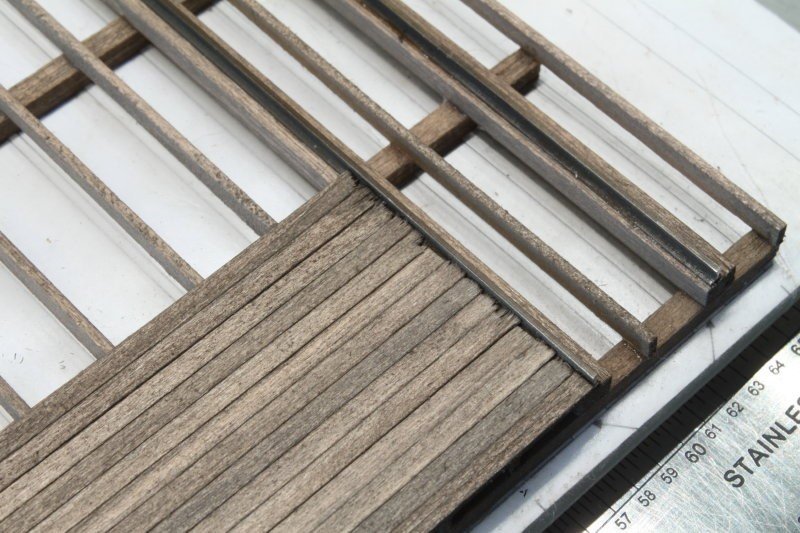
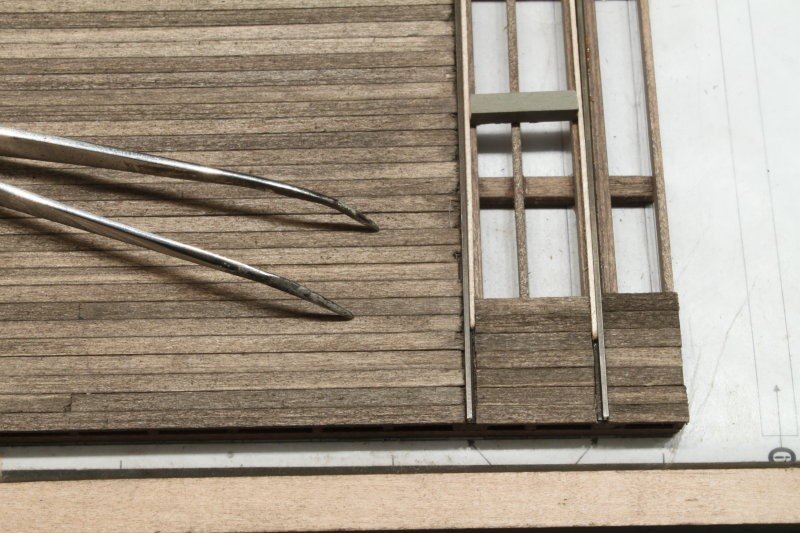
jeff
-
Thanks for the replies. Welfack, when I copied and pasted the post from the Sierra West Forum, initially the URL was seen and not the photos. I think you got to the post before I edited it as now the photos are visible. As far as where the planking ends at the rail, if it stops at the edge of the rail, then I would assume that you would then need spikes to hold the track down like you would have with RR ties. None of the build logs on the SW forum mention this. Re: comment by Canute, I was not implying to remove any of the rail base, but rather should the wood planking cover the flange part of the base up to the rail itself. The multiple planks would server to keep the rail anchored and obviate the need for spikes. I am not sure the wheel flanges would go low enough the hit the wood. I have a rail flatcar that will be part of the diorama so I may test this out.
Jeff
- Old Collingwood, Egilman, Canute and 3 others
-
 6
6
-
Greetings!
Work continues with the docks.
Template C has the right, left and derrick docks and the sales porch, all done simultaneously. Here is some early progress.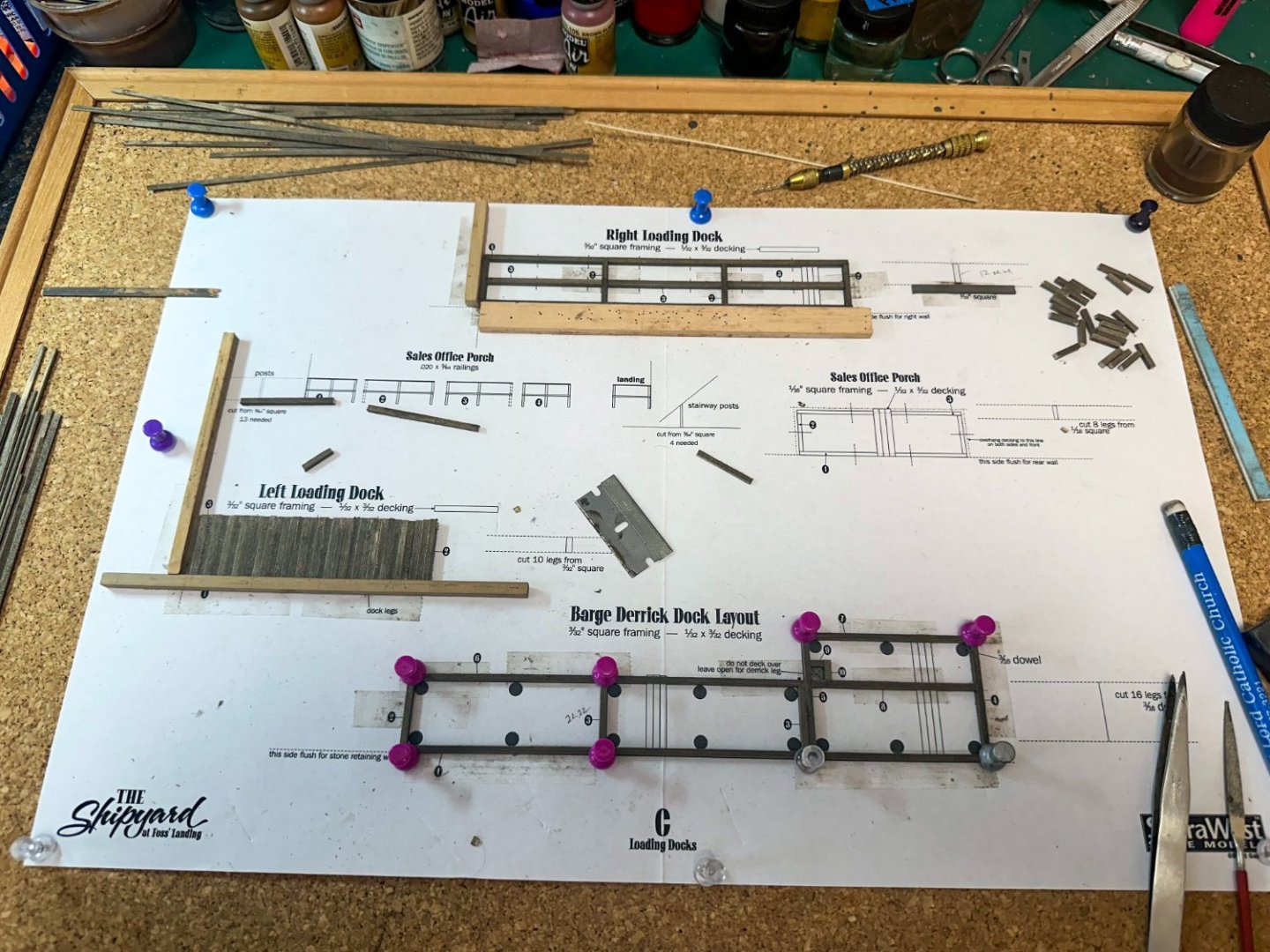
The completed docks below. Instructions are very clear cut. Fine ballast was used to create the barnacles on the supports that will be underwater. One variation from the instructions - I decided to paint the skirting speckled white. I found that on many porches, this part was white. I'll probably make the railing white to match. This will be similar to the stairs and railing of Foss Landing.
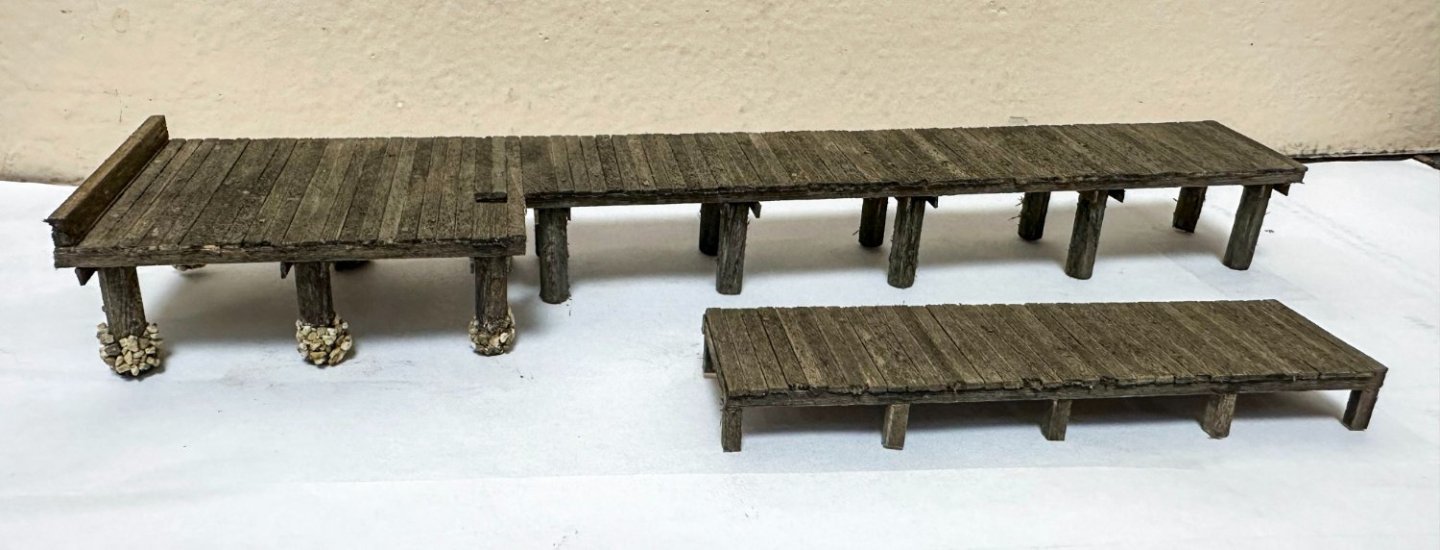
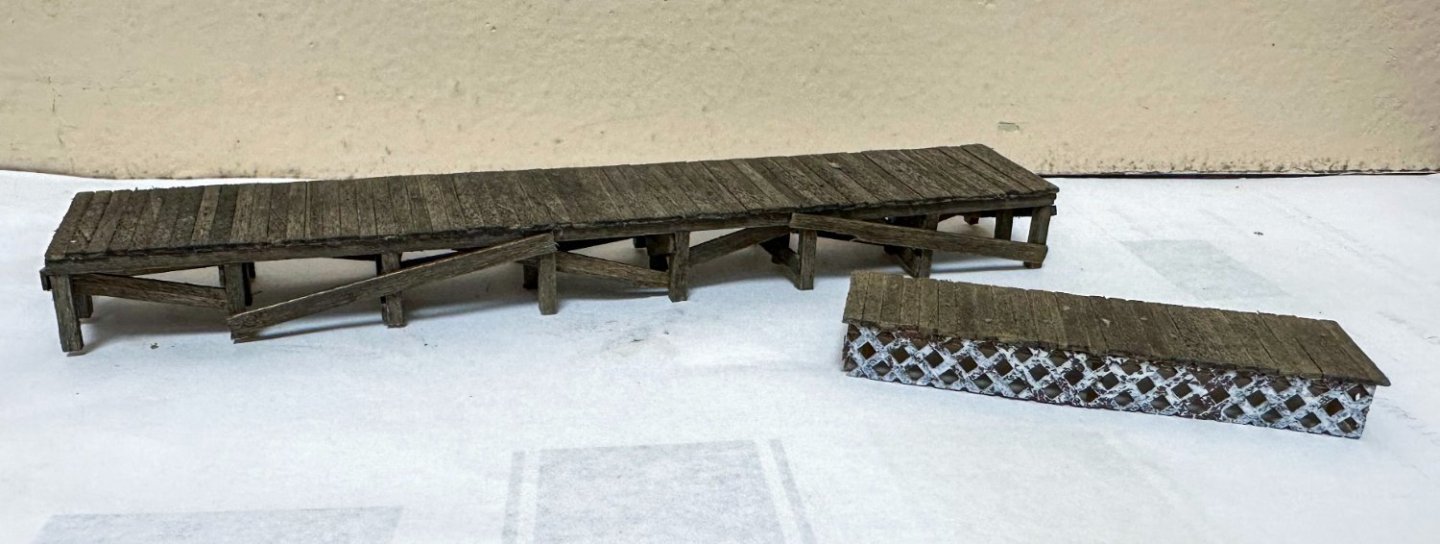
Note that on the derrick dock, I made the height of the "barnacles" less as the dock went inland as the water level would be lower.
Now onto the main dock. Here is some preliminary work.
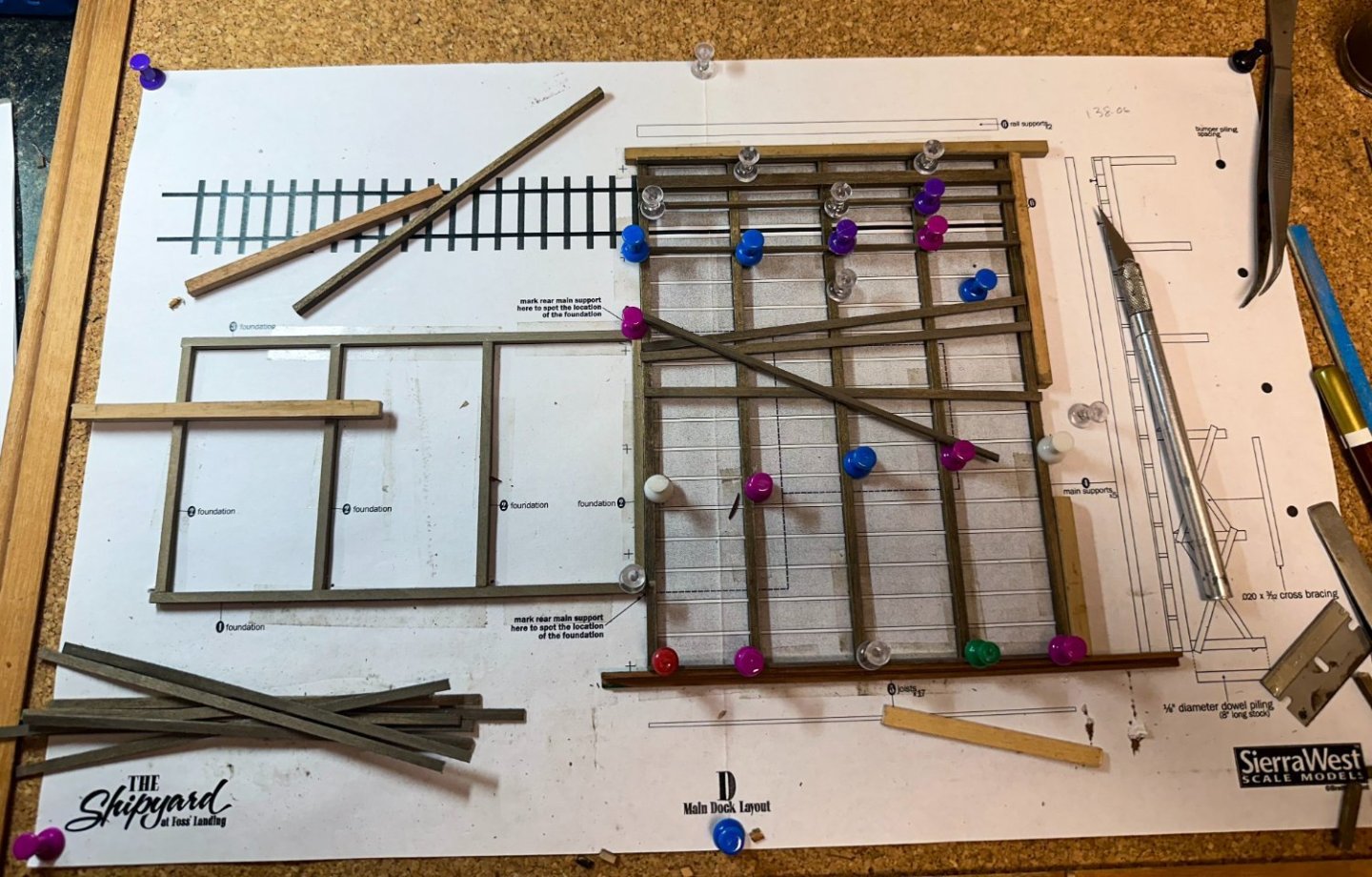
I have a question for the any RR enthusiasts out there (not sure there are many here at MSW) - for the rails that are on the dock, where should I terminate the deck planking - at the blue line or red one? I can't seem to find many photos of this online and the pic in other build logs are too low resolution.
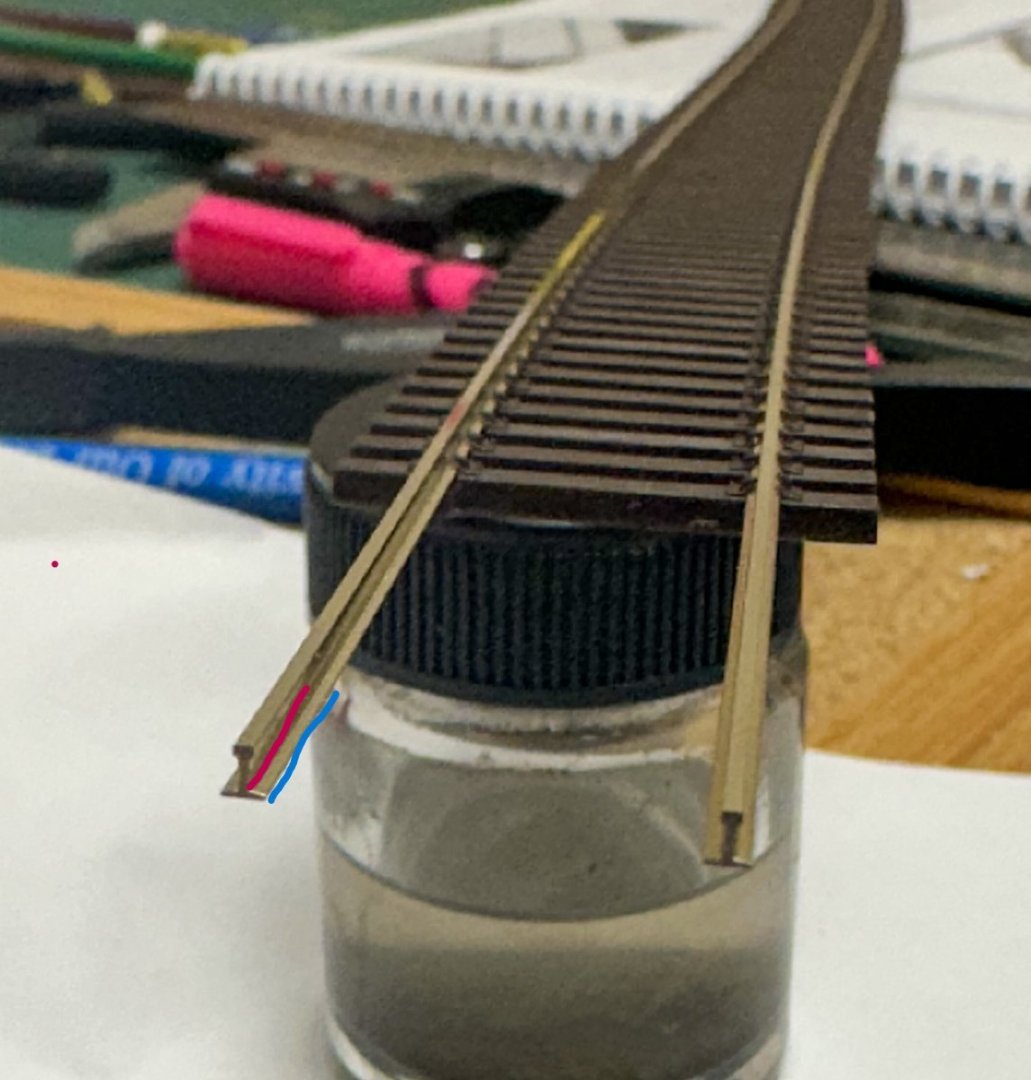
As always, thanks for the kind comments and thanks in advance for any help on my questions.Jeff
- mtaylor, Egilman, FriedClams and 2 others
-
 5
5
-
Greetings!
The office has been attached to the main building and the pitch and pine tar tank and platform were completed and glued to the warehouse roof. A small hole was drilled in the roof top accommodate the pipe.
Here is the structure thus far. First, a few close ups of the tank and platform...
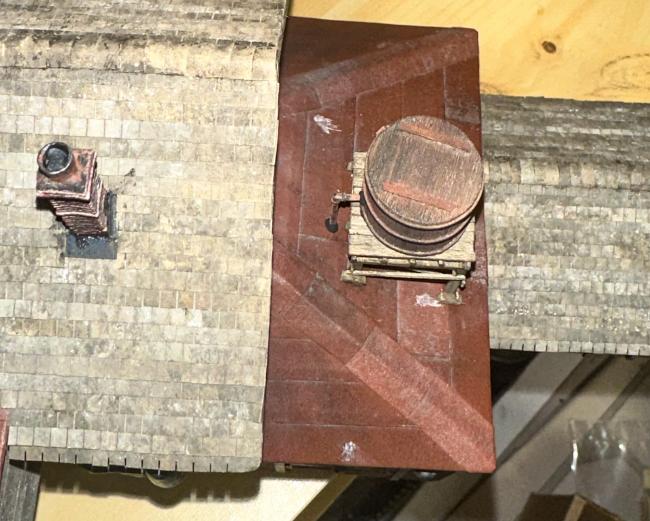
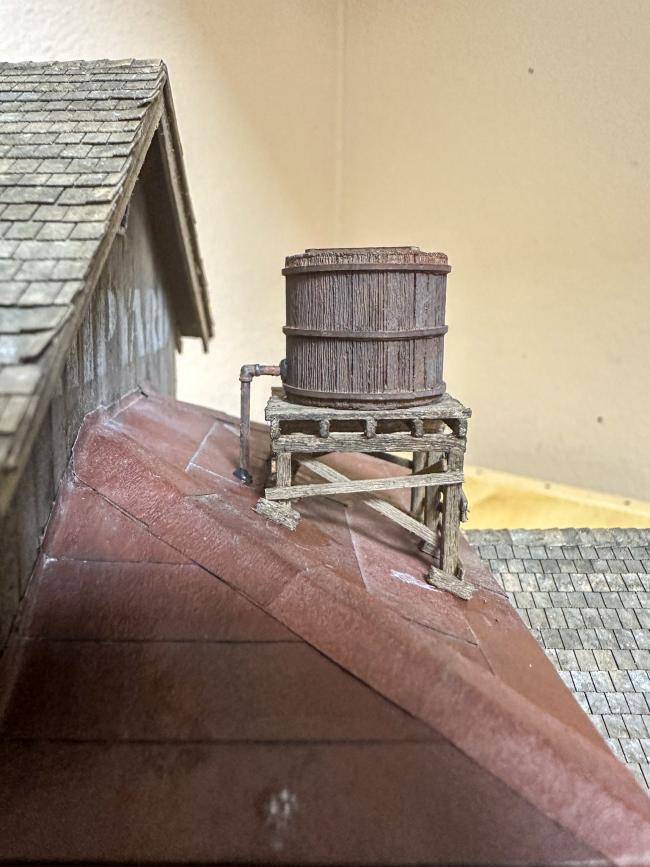
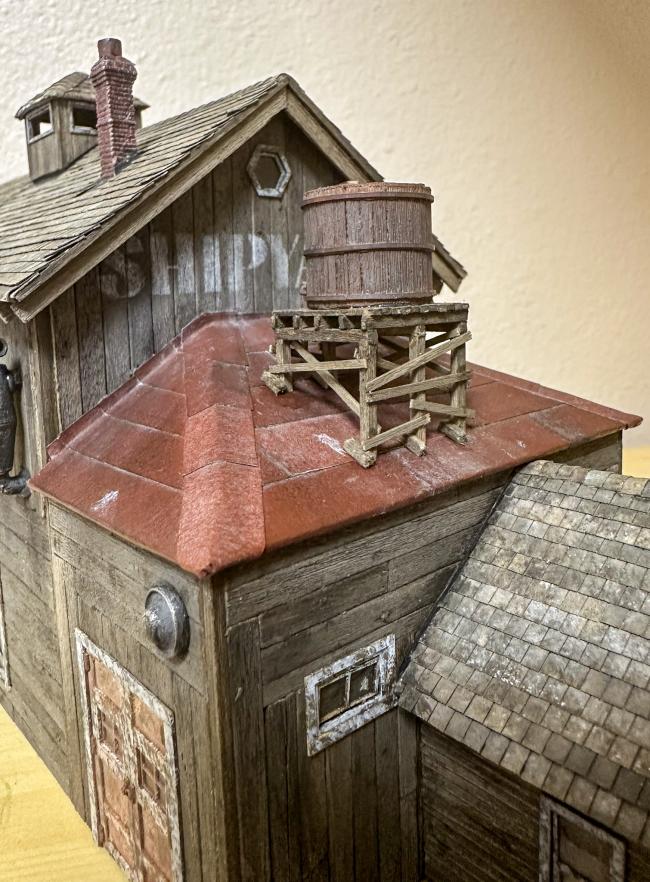
...and the main building.
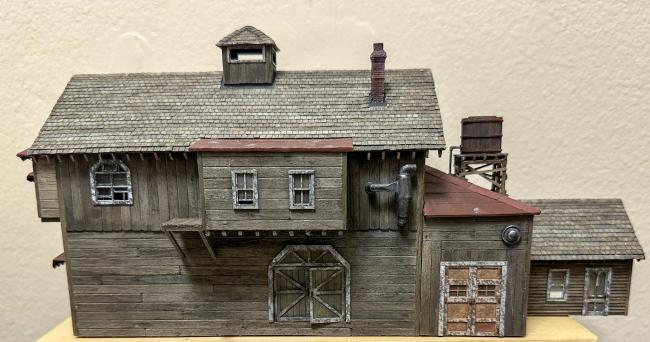
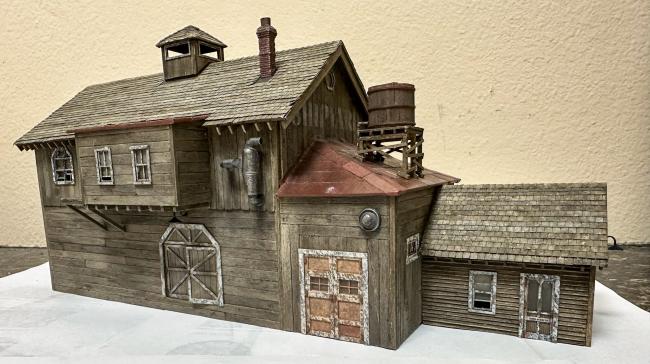
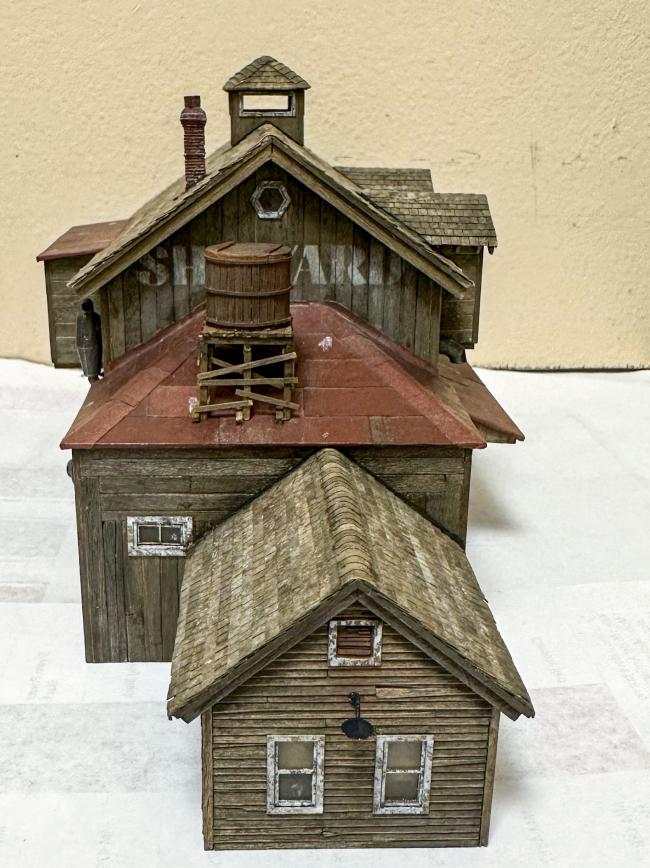
Several stacks are being prepared to glue onto the roofs. Then onward.
Jeff -
Greetings!
Work continues on the main building. The attached warehouse is complete. Not much extra to add from the instructions though I did add some beams behind the metal doors for some support. See photo below, upper right. I had to salvage some scraps from the wood pile to complete the walls.
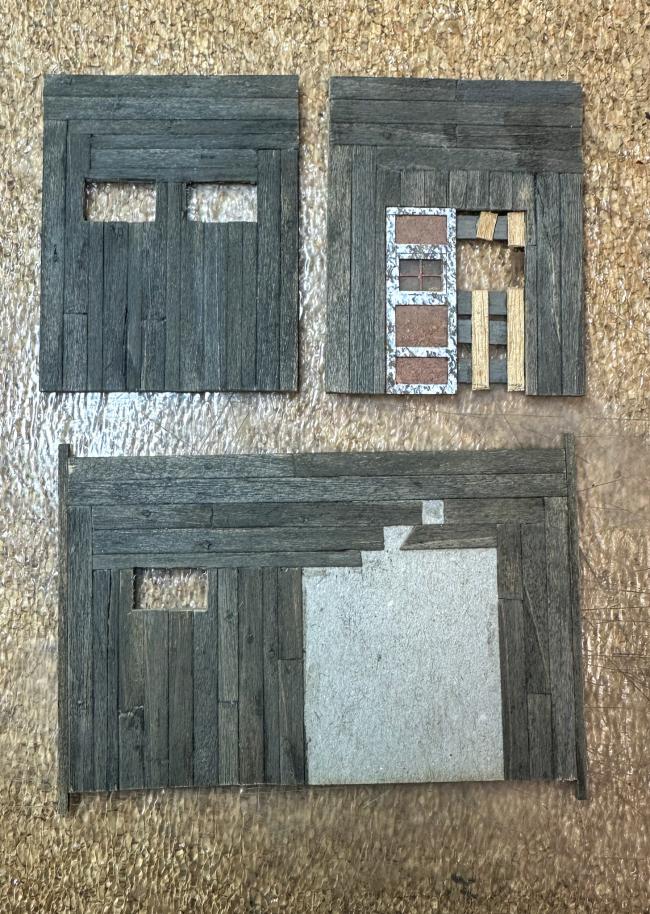
Here is the competed wall and doors.
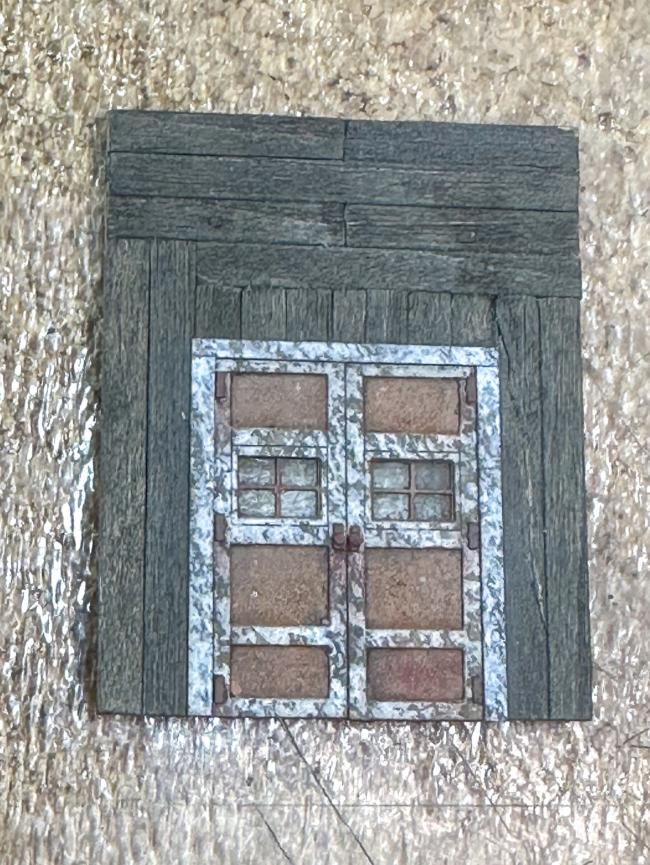
The roof goes on much like the awnings on the main building. Here are some photos of the warehouse attached to the main structure. One LED was added to the interior of this section.
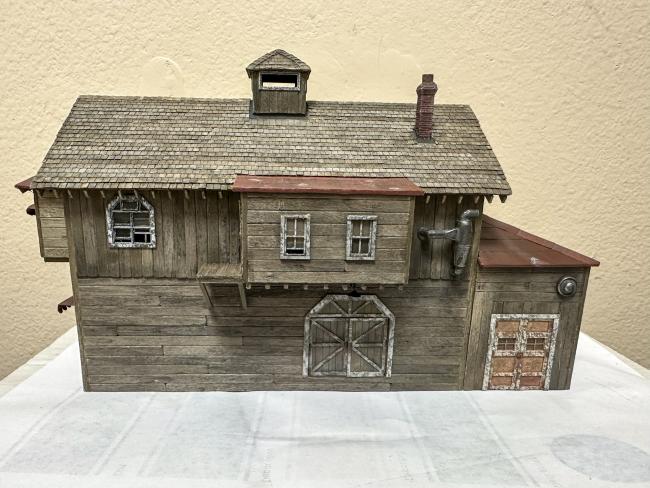
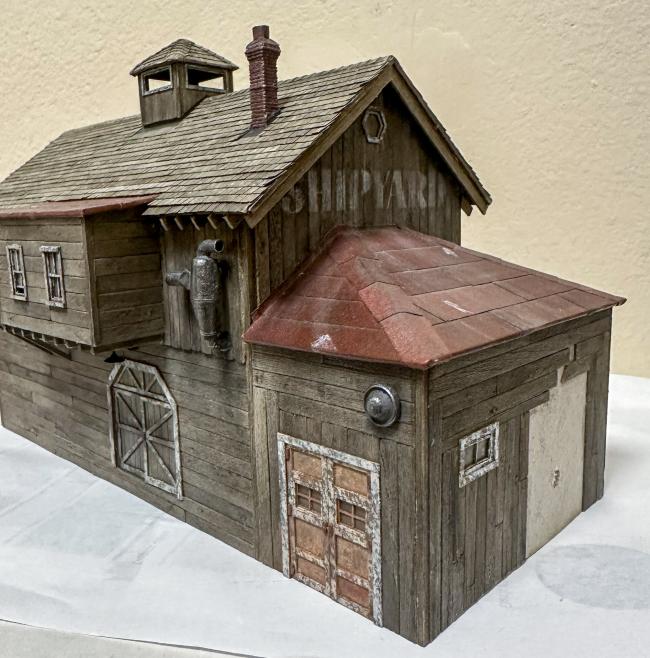
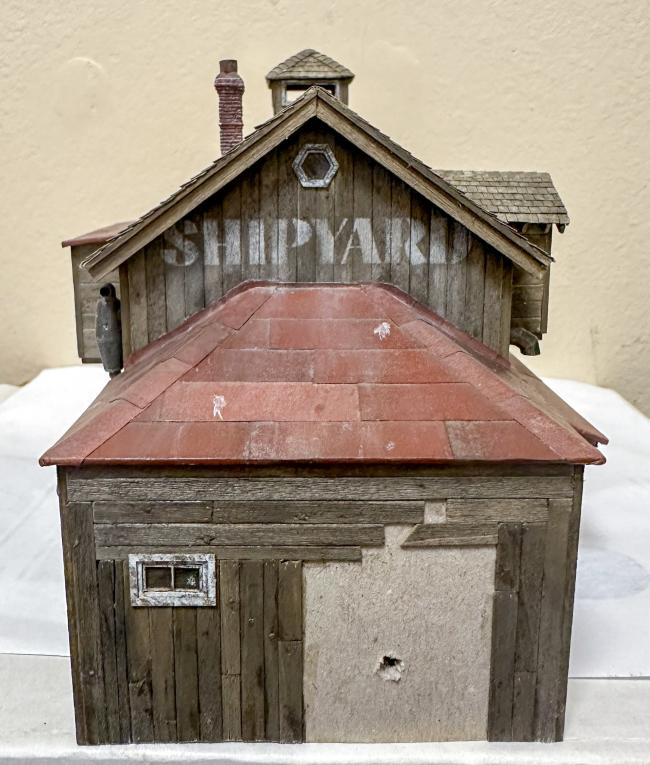
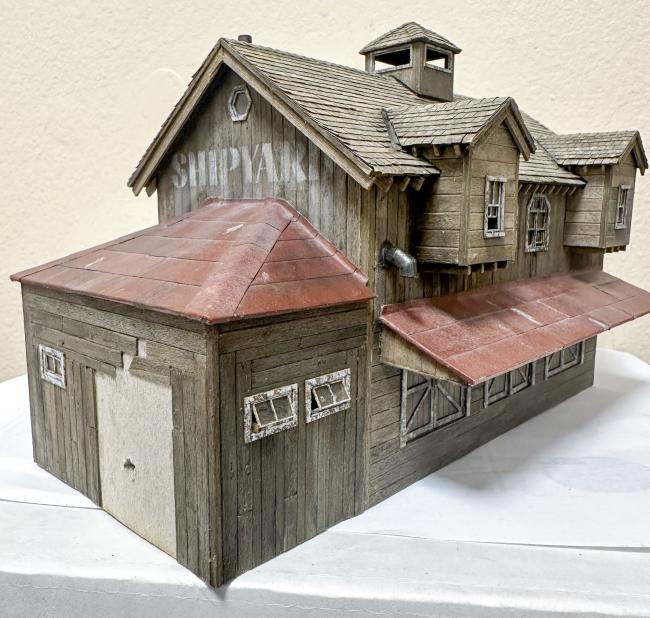
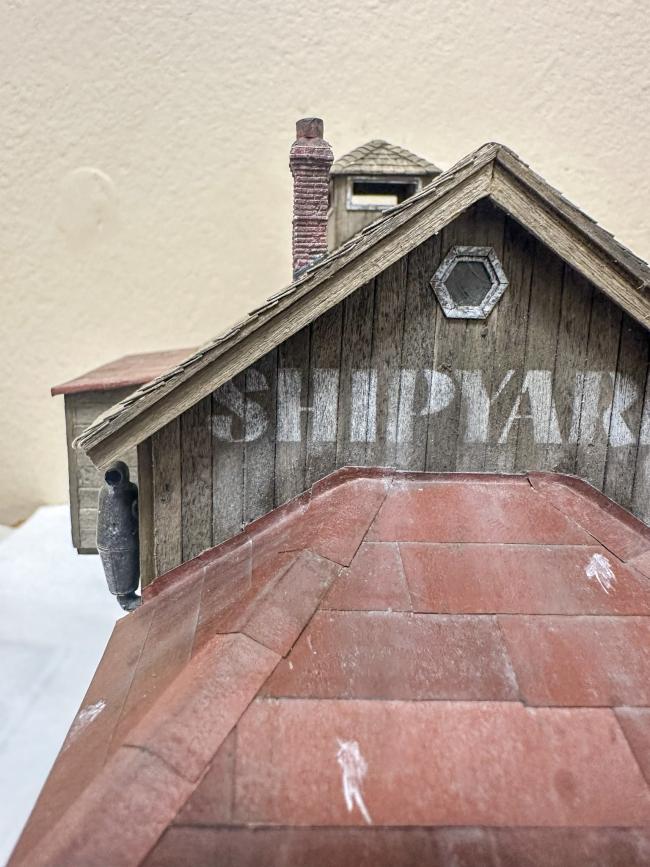
Excuse the simulated bird poop on the warehouse roof!
The Yardmaster office is next. The clapboard siding was fun to build and if you look closely, there are boards that are split, chipped and a few that have part of the board missing.
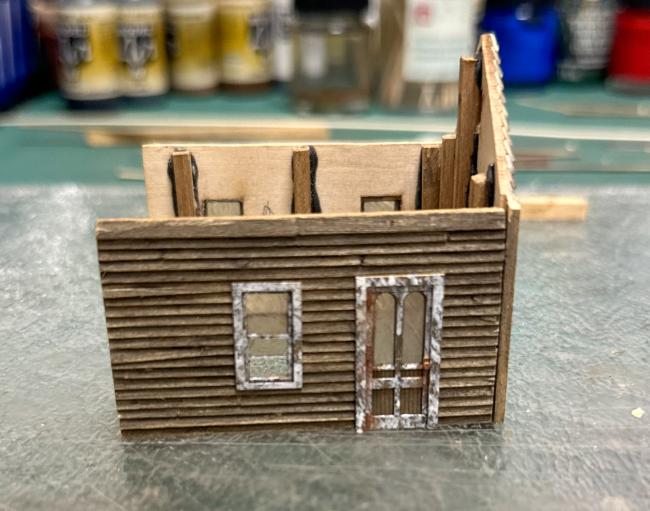
Roof is almost complete in these photos.
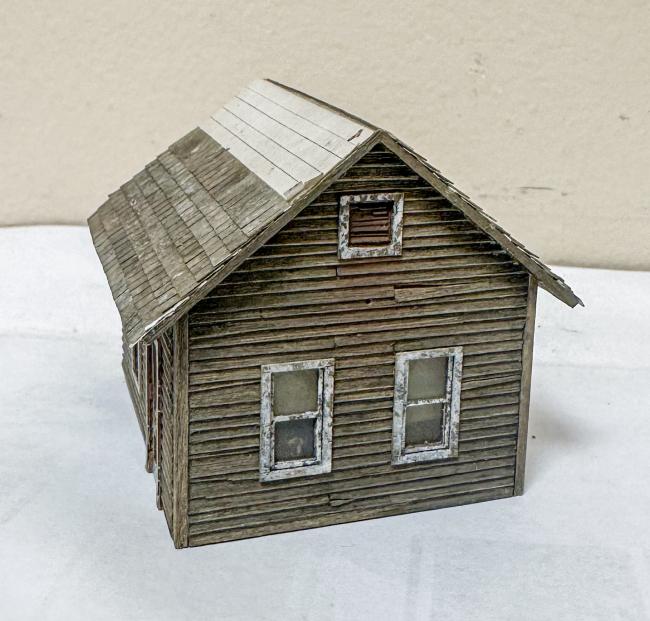
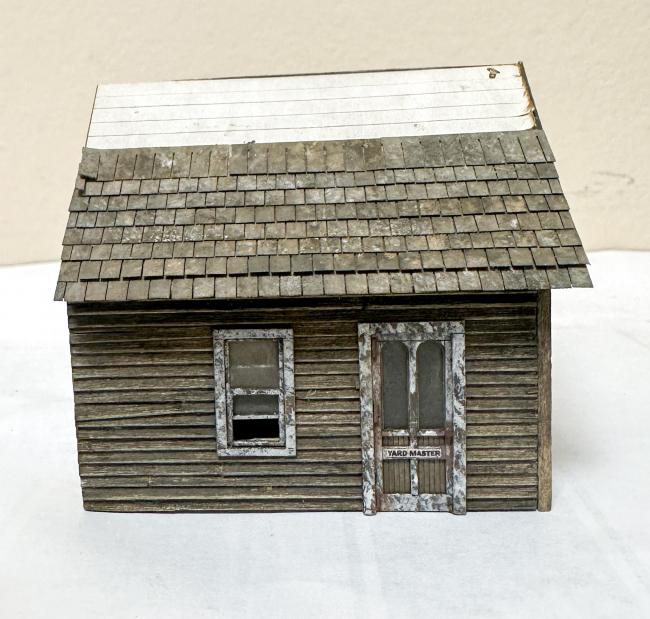
The office will have one gooseneck light on the gabled side and one LED inside. Once glued to the main structure, it's onto the items located on the roof.
Jeff -
Greetings!It's time for the roof and shingles. A long beam is first glued between the end walls to give the cardboard base some support. I decided to add some vertical beams for additional support.
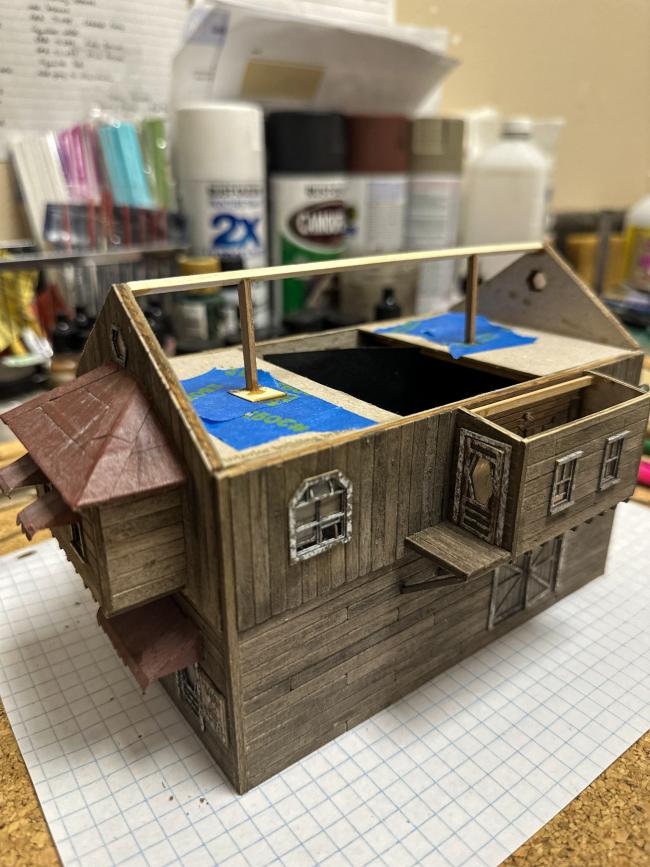
Once the roof is glued in place and some strips are added to roof ends, it time to begin with the shingles. But first, the dormers are glued in place. As the first 11 rows are broken up by the dormers, it was important to correctly place the shingles between the dormers so that when full length strips are placed beginning row 12, the offset from row to row will be consistent. I first placed 3 rows on the left, then placed a full length on row 5. Rows 1,3,5 will have full width shingles on the end. The pencil line (blue circle) marks the edge of a shingle that was used to line up row one. The same process was used to line up row one on right side of the roof.
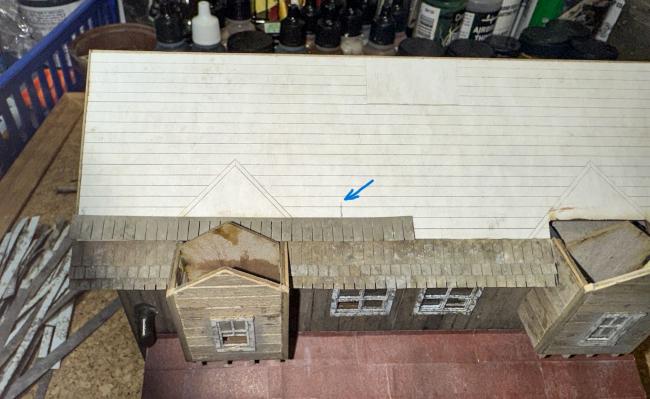
I may have been overthinking this but last thing I wanted was to get to full length strips and have the shingles misaligned. After row 3, the dormer roofs are added, then flashing added to dormer - roof interface and then more shingles. Grant's log has some nice photos of this process so I won't repeat here. Here are some photos of the progress.
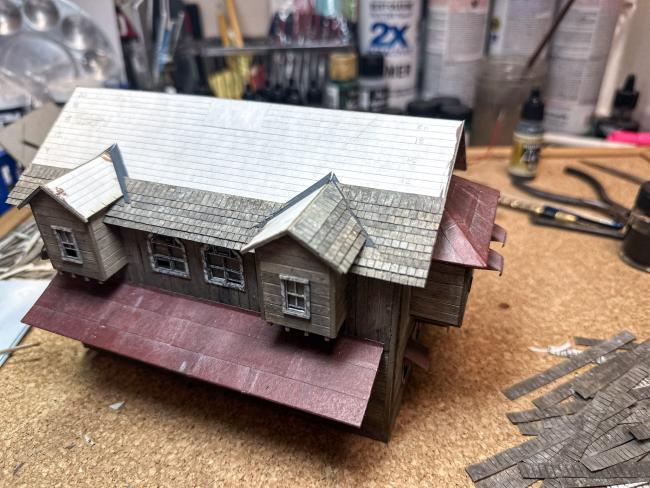
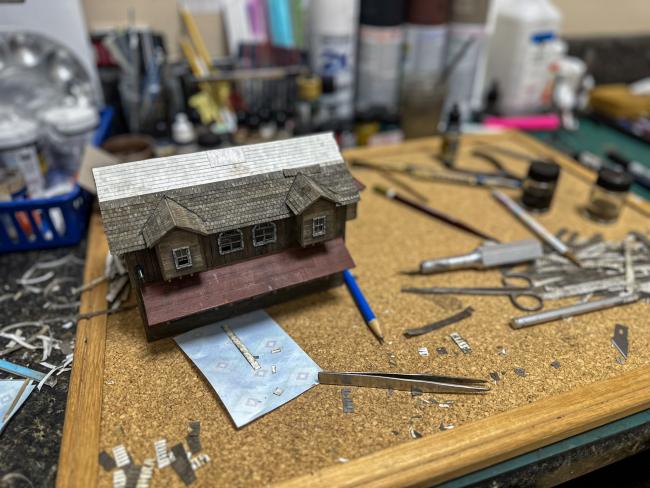
A small triangle has to be cut out of the shingle strip on row 12 to accommodate the peak of the dormer roof. This took a few tries to get it right (one loose strip can be seen in the photo above. After row 12, it was pretty straight forward up to the cupola. As 2 strips were a bit too short to cover the length of the roof, filler pieces had to be used. To keep the offset consistent, on occasion a very slight amount had to be removed from an end shingle here and there. Once up to the cupola, shingling was paused to construct the cupola. The walls are lined with strip-wood, window frames painted and placed, and the wall glued together. Trim is added to the base to accommodate the black paper flashing. The instructions called for the trim at the base to be a 0.02 in strip (0.5 mm). I felt this was a bit small to run the flashing onto the trim, so I doubled it to 1mm. The cupola is then glued to the roof and shingling completed. The cupola roof is completed in much the same way as the other roofs. The same process was used for the other side. Here is the completed roof of on the side with the dormers.
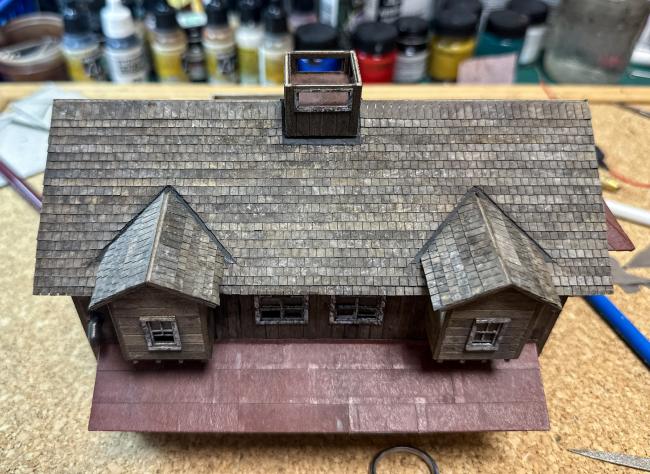
Once the roof is complete, rafters are added - full length at the ends of the main and dormer roofs, extensions elsewhere. Here is the roof complete.
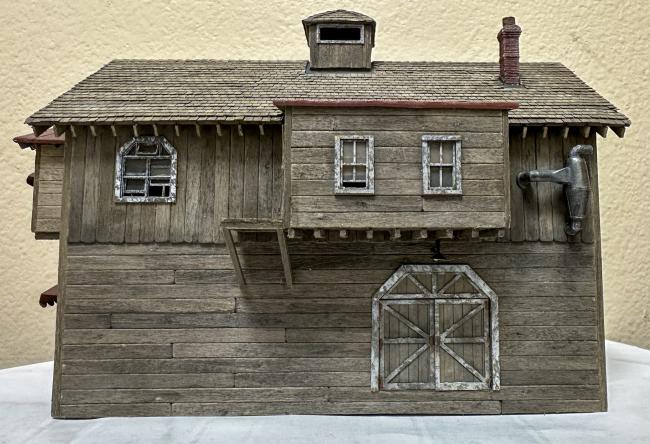
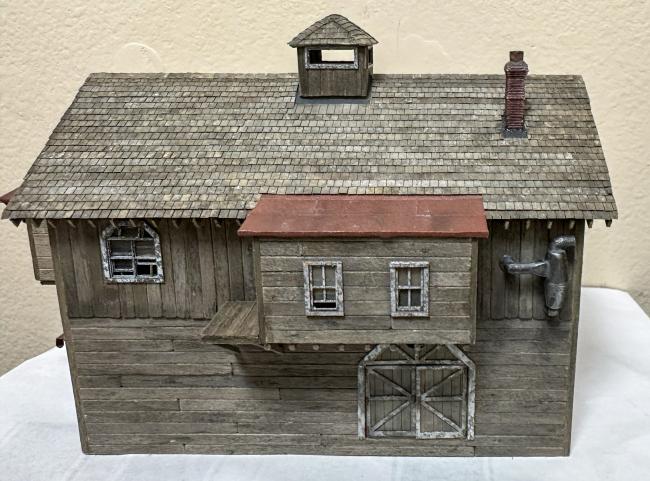
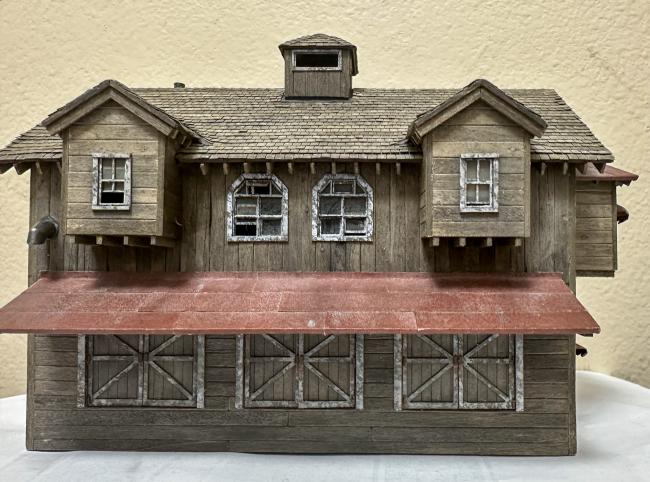
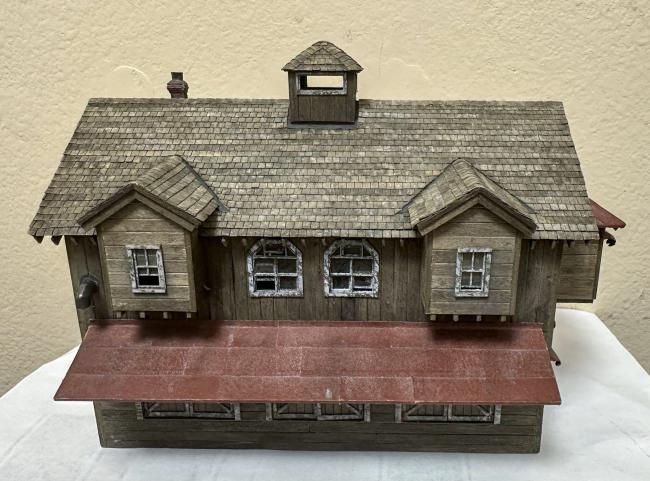
I decided to paint and place the chimney at this stage as I was eager to see how it looked. I may do some weathering of the roof below the chimney to represent soot.
Also, the capping shingles used were cut from the paper border of the shingle sheet, ~4.4 mm in width. Instructions called for using single shingles for this process but I though they looked too small. Here's a photo with both for comparison.
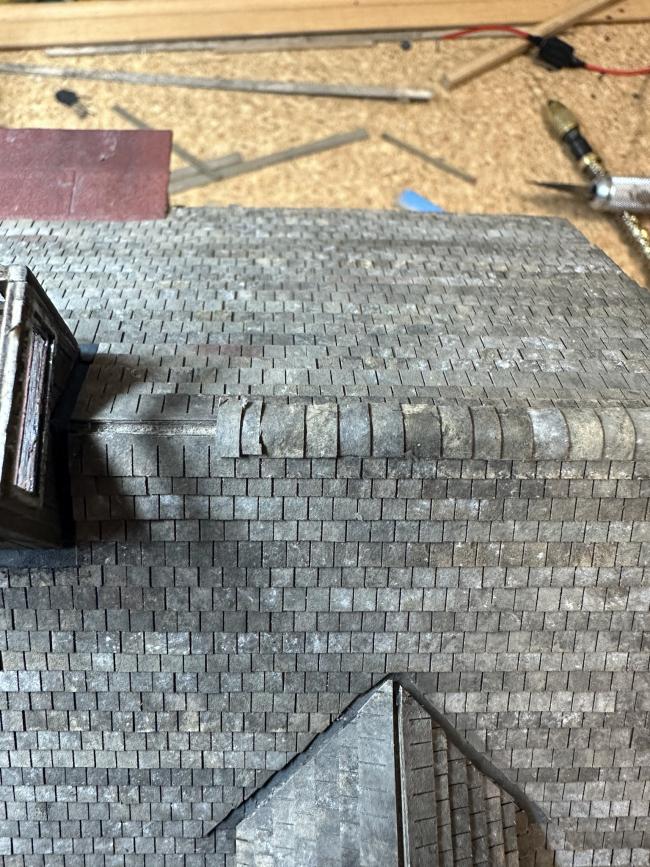
And lastly, before the roof was placed, LEDs were placed, one each in the large dormers,, 2 in the main building and a swan neck over one of the freight doors. The dirty windows and shades limit views of the inside.
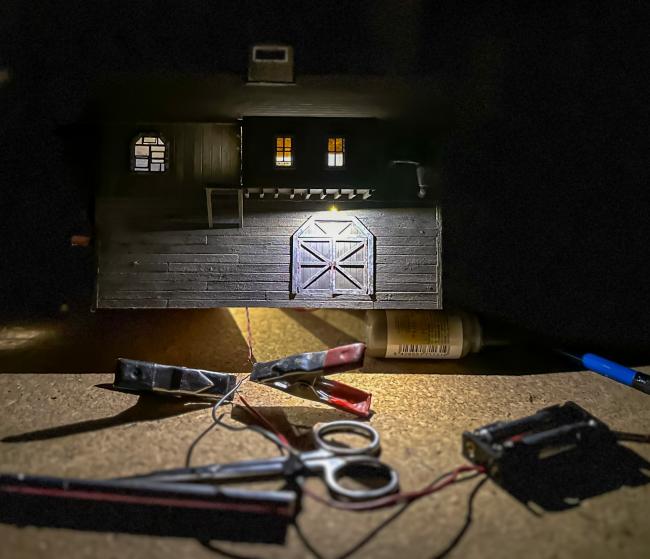 On deck, the warehouse building.Jeff
On deck, the warehouse building.Jeff -
Greetings!
Right wall and front stenciled wall now complete. I was not entirely happy with the cardboard awning supplied with the kit, so I decided to replace it with a wooden one using boards from prior ship models. I used the cardboard awning as a template to mark the tar paper lines on the new awning (pencil lines can be seen on the top photo). Marking for the supports and the middle were also marked. One side was stained, the other will be tarped.
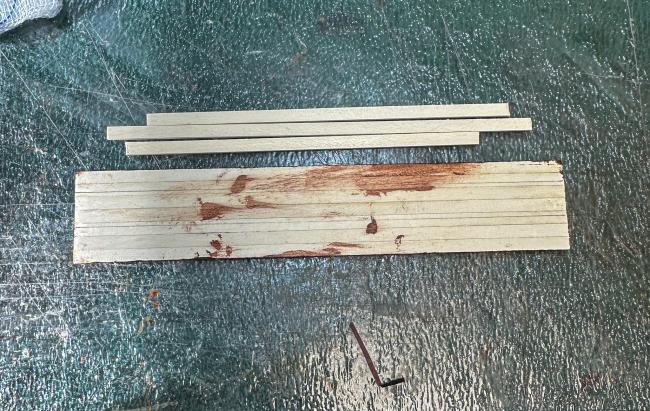
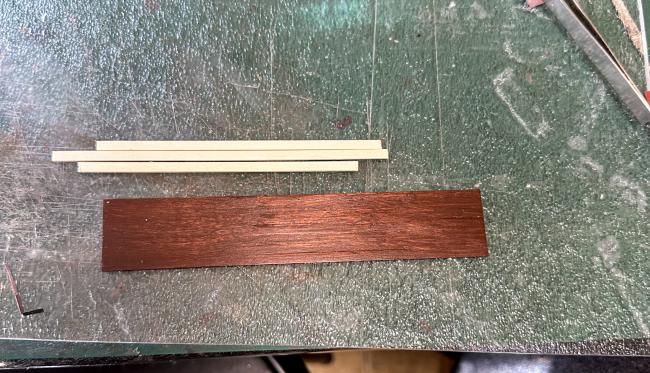
Final wall:
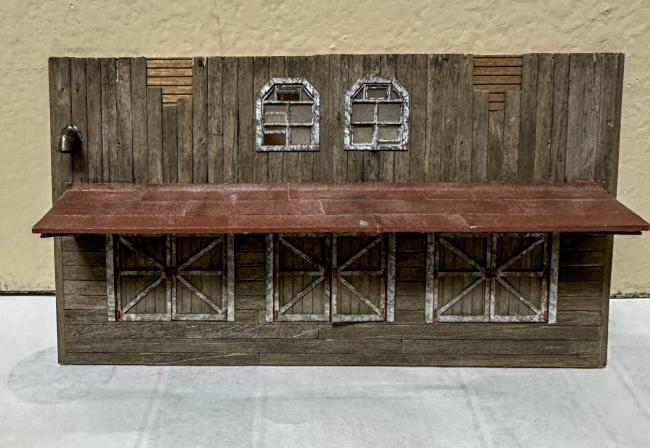
Here is the front wall with the Shipyard stencil.
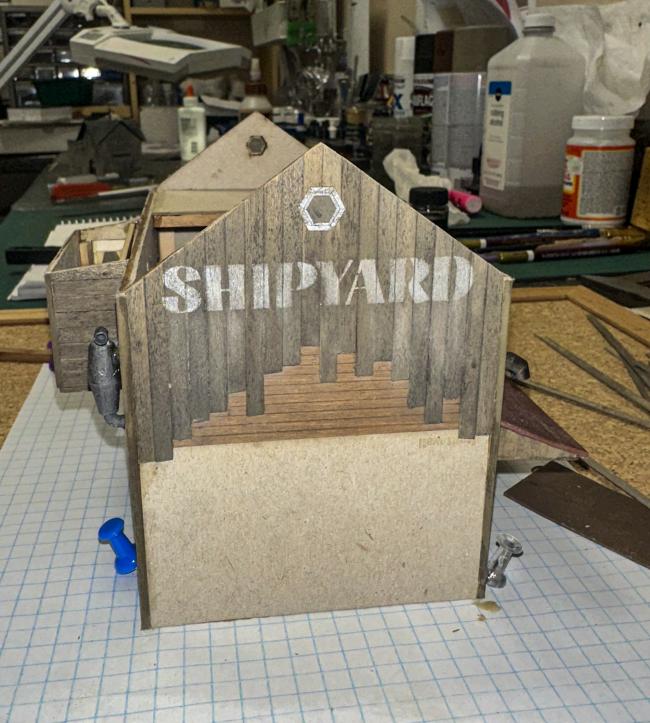
Gluing the walls together is next. The rear and side wall were glued together first, using a metal right angle to keep things lined up. I then glued on the front wall, using graph paper to line up the walls as well as the supplied internal cardboard supports and several square beams (each beam was the same length measured to .01 mm). This makes the structure quite solid. Note in the second photo the missing awning on the rear wall, knocked off during the gluing process. It was easy enough to repair but illustrates how delicate some areas are.
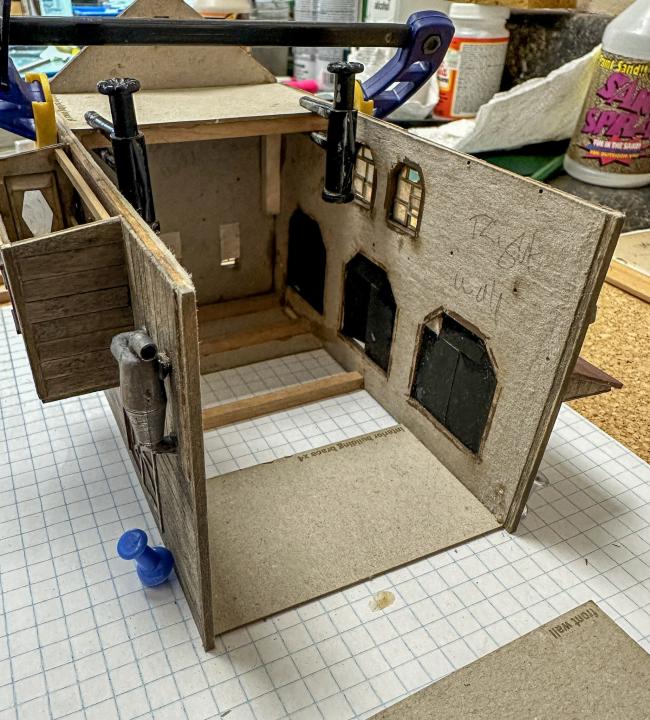
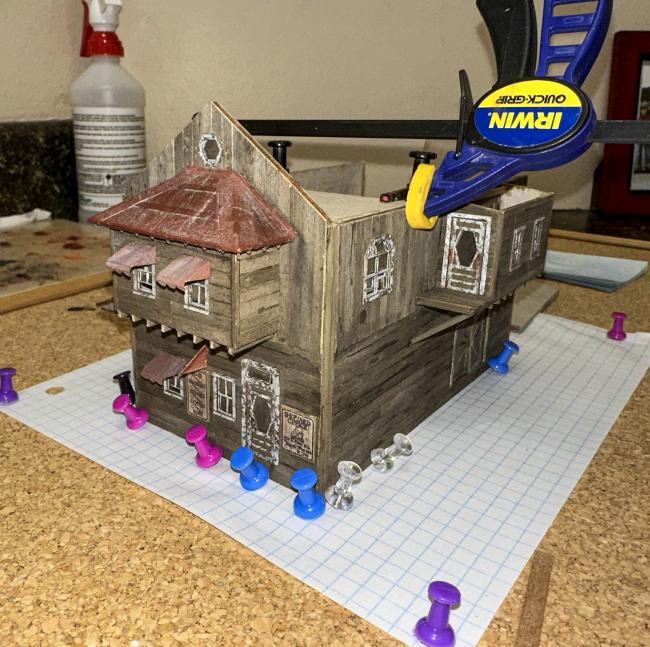
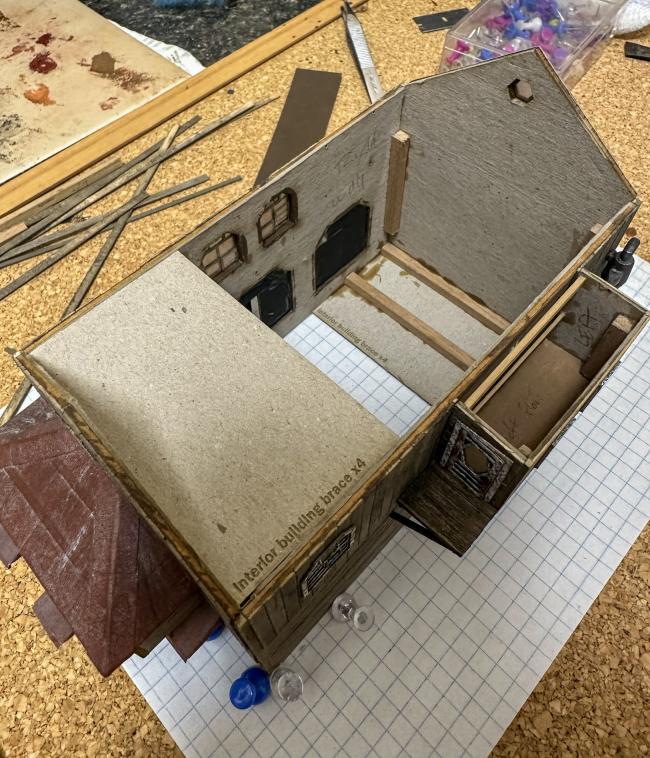
I have decided to add some lighting to the diorama. I plan to put some LEDs in all the main buildings of both Foss Landing and the Shipyard, pendant LEDs in the saw shed, goose neck lights over some of the doors and hopefully some streetlights. I even found some small LEDs to simulate a fire in an open oil drum! So, while waiting for the LEDs to arrive for the main building, I decided to build a billboard for the flat roof of the Foss Landing Launch Co. not sure what sign I will put on the billboard but here's what I came up with using some ideas I found online.
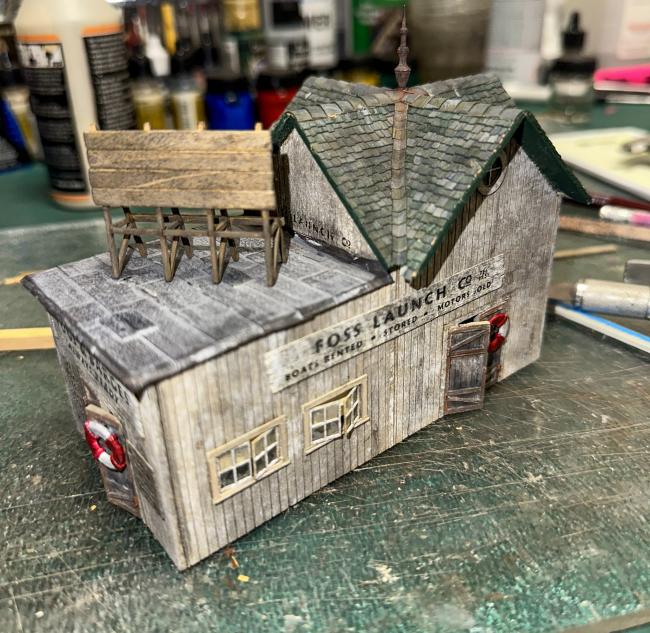
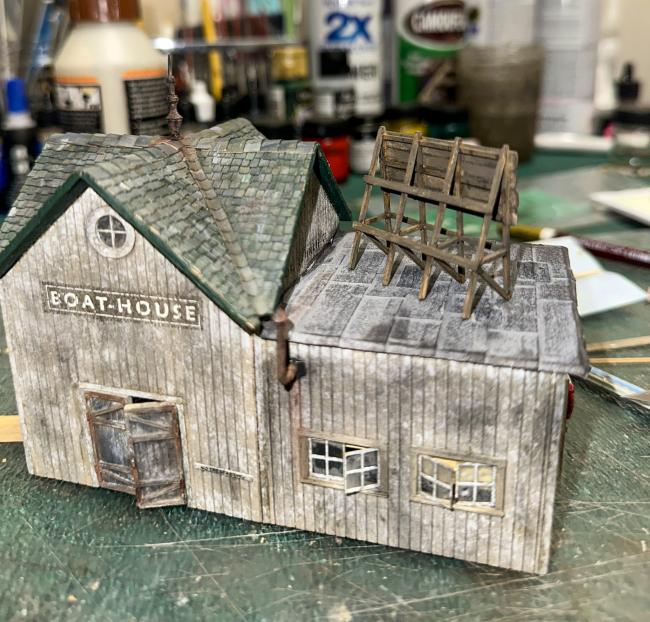
Jeff -
Greetings!
Rear wall construction now complete. No significant issues encountered. As noted in Grant's log, the rafters were a bit long when cut out using the template. It was easy enough to fix though. Regarding the signs, the instructions mention that several copies are supplied on a single sheet. I had just one copy on a template sheet. I made a few copies before working on them. Glad I did as the first try was not acceptable. The awnings were a bit delicate - too much bending of the side pieces or the scalloped edges and they would come off. Each one was stiffened with a light coating of white glue after they were bent in place. First photo shows the larger awning placed using 2 wood spacers to ensure it was centered in the correct position (sharp eyes will see that one spacer was turned the wrong way when I took the photo). Next 2 show the finished rear wall.
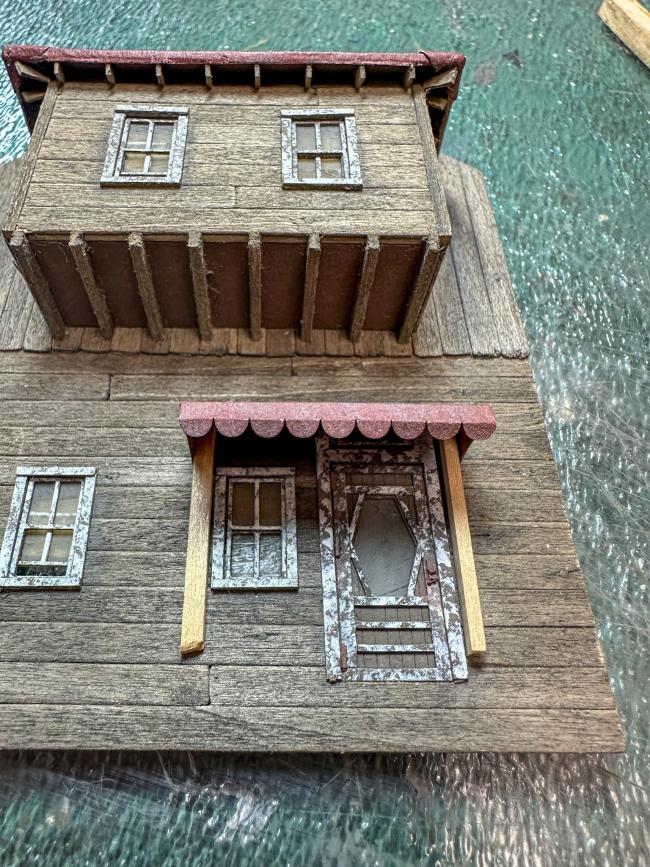
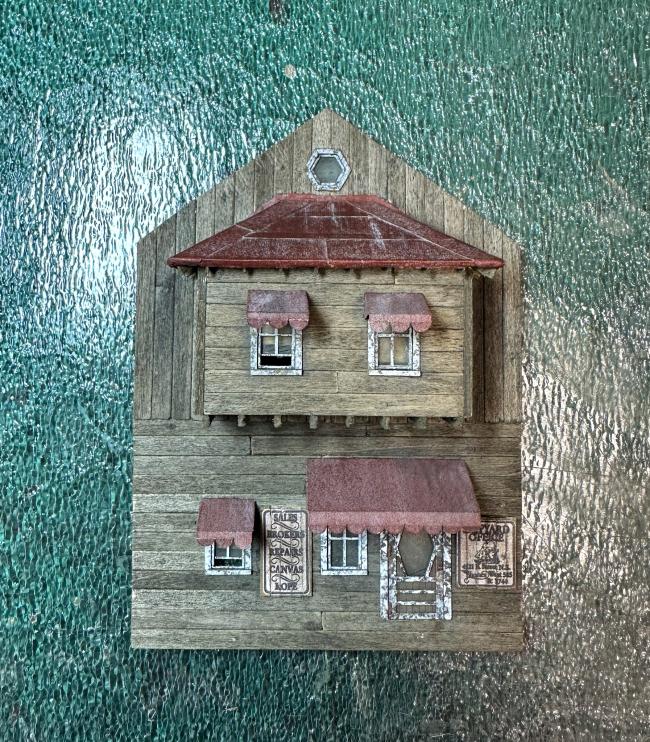
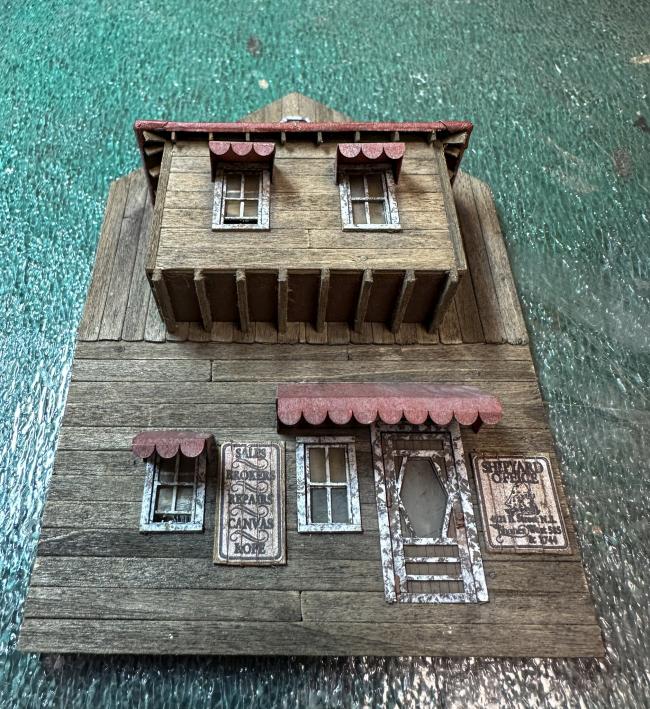
The left wall was much easier as only the dormer, landing and sawdust collector had to be fixed to the wall. Having the pre-drilled holes to locate the correct position of the dormers made this quite easy. Template seen below aided in construction of the landing.
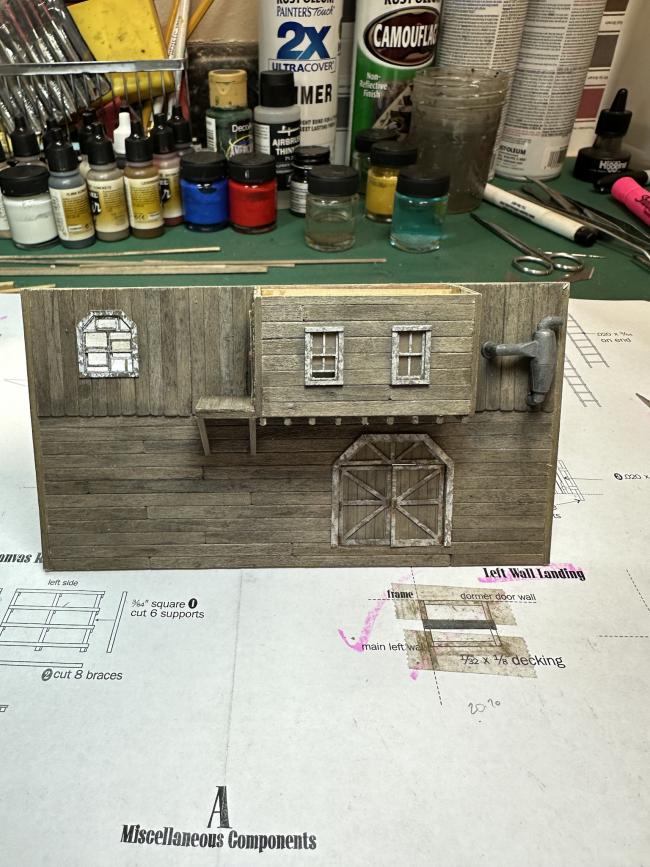
One question I have about the sawdust collector (seen below on the right of the wall). I gather that it is a vacuum that collects sawdust from the shop, however, wouldn't there be a hose or tube at the open end (see red circle below photo) that would lead to a barrel or container to collect the sawdust? Otherwise, sawdust would spray all over the place. Unfortunately, I have not been unable to find any similar contraption on the internet. I am thinking of making some sort of tube that would lead down to an oversized barrel. Any thoughts?
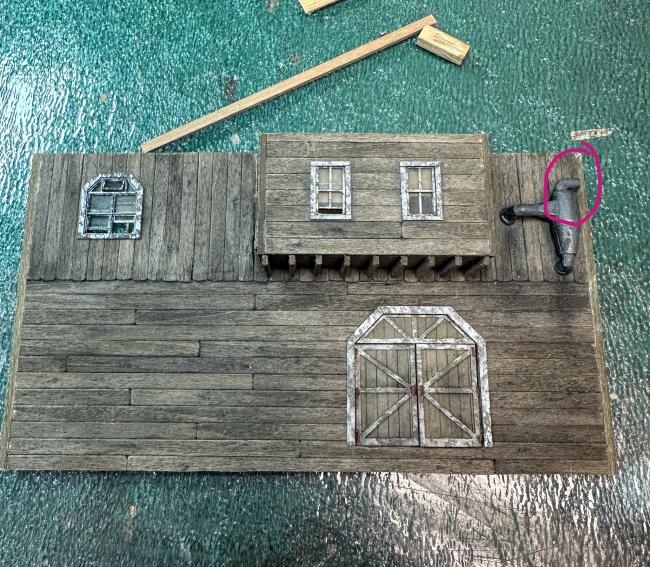
Next post I will show the stenciled wall and right wall.
JeffLeave a Comment
-
Greetings!
Work continues with the dormers. Construction was pretty straight forward. As I've stated before, I won't go into all the details as the log by grant covers this quite well. I did add some beams across the back to add some rigidity to the structure.
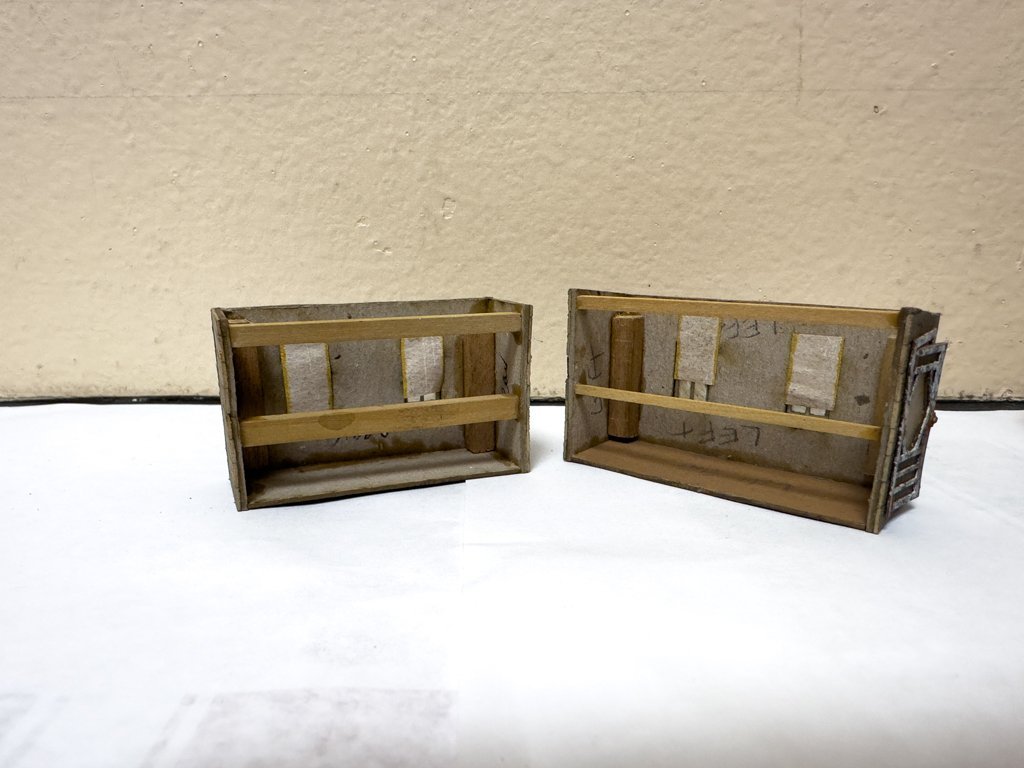
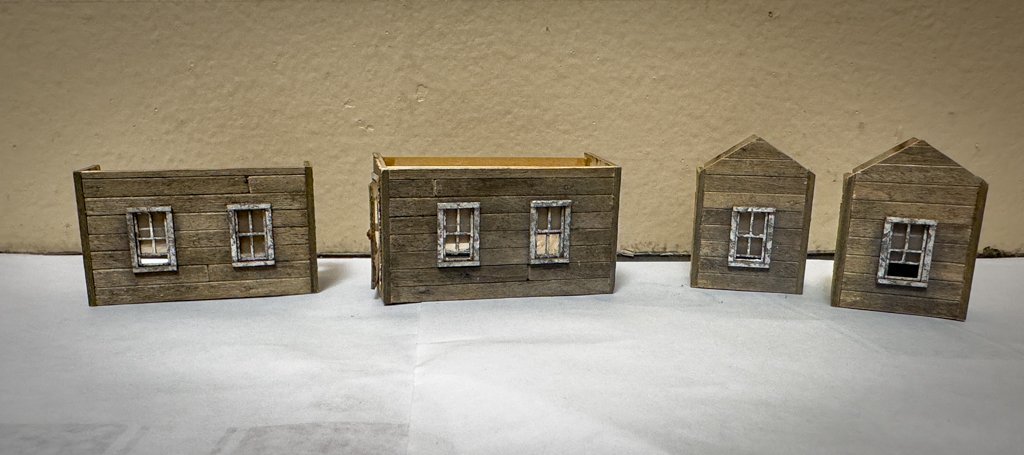
The flashing on the right wall dormer sides is to be removed, painted then glued back, flush with the back of the wall. To give this delicate piece a larger surface for the glue, I first glued a piece of paper to the back of the side wall then glued the flashing into its space.
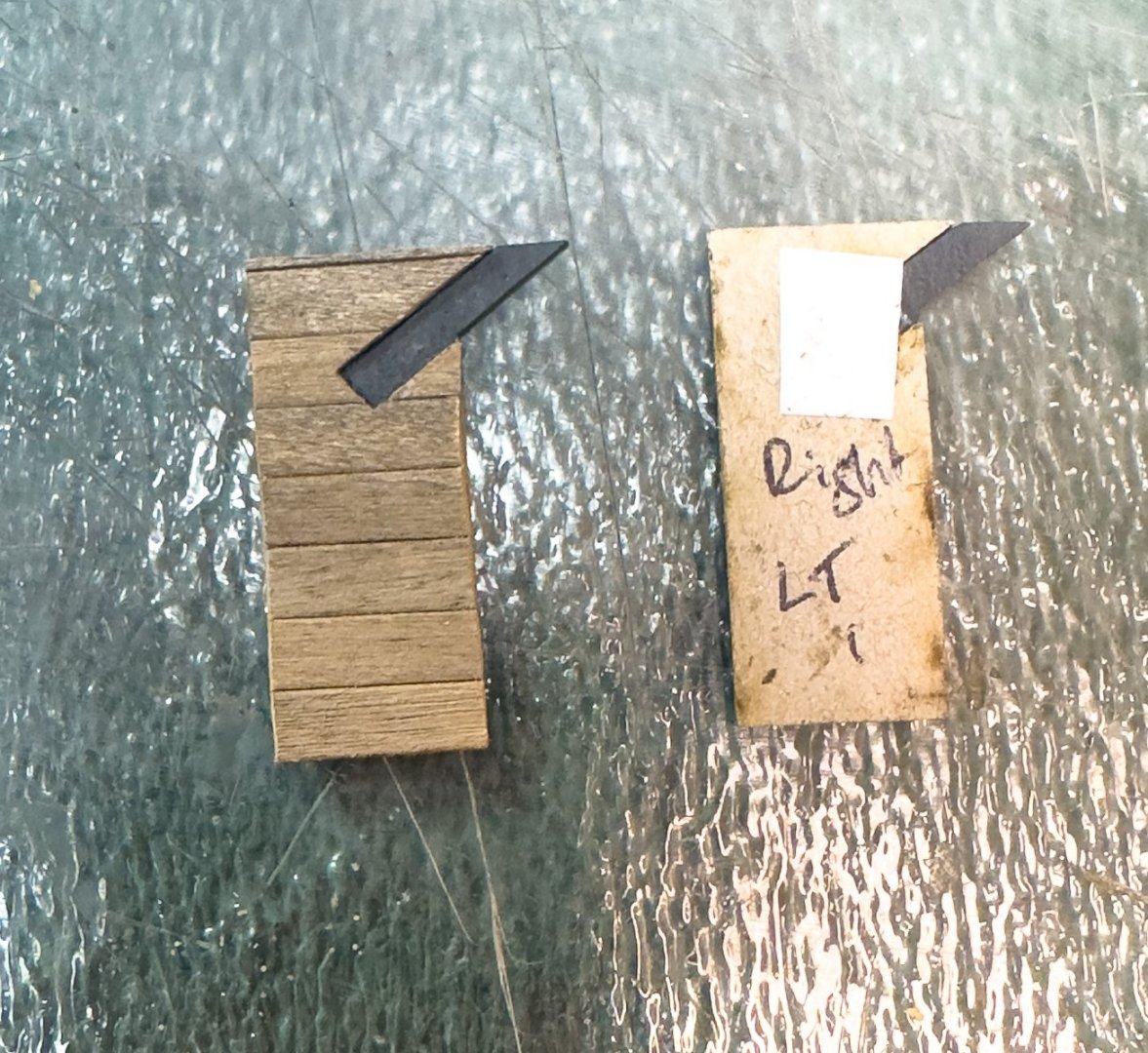
I also noticed that when the dormers are placed onto the left and rear walls, the lower part of the scribed inner wall is visible.
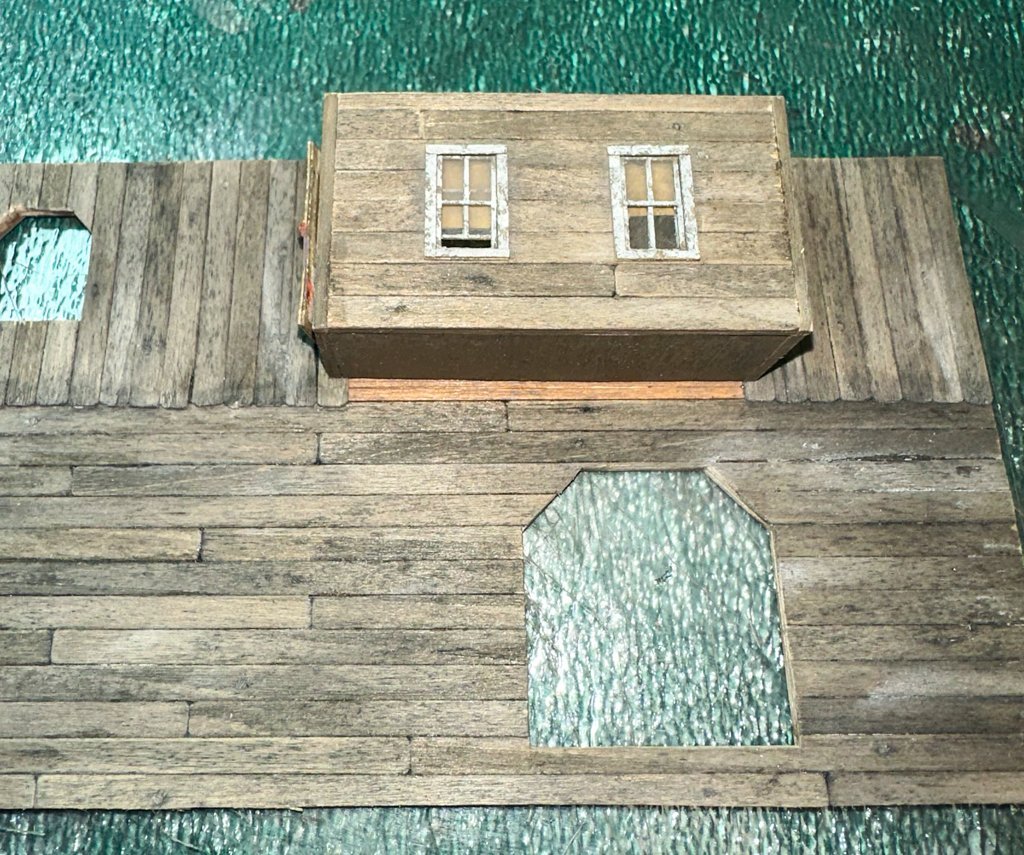
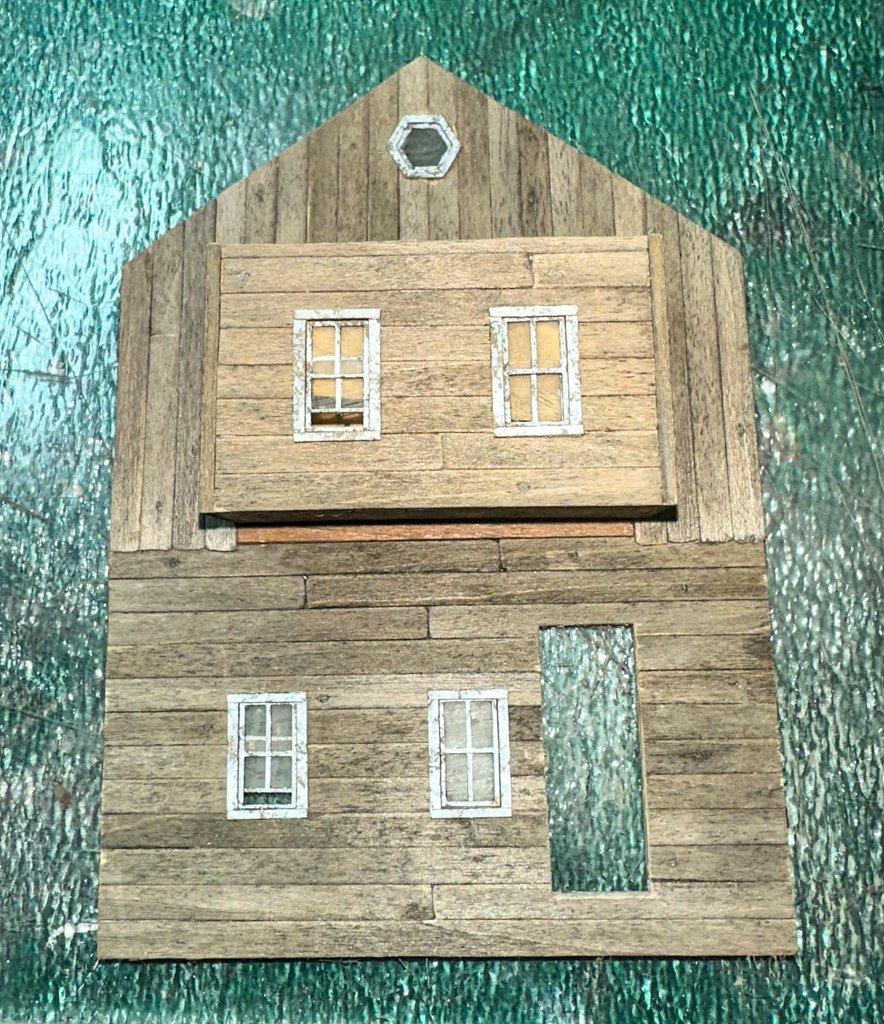
I did not like this look so it was covered with the same planks used for the walls.
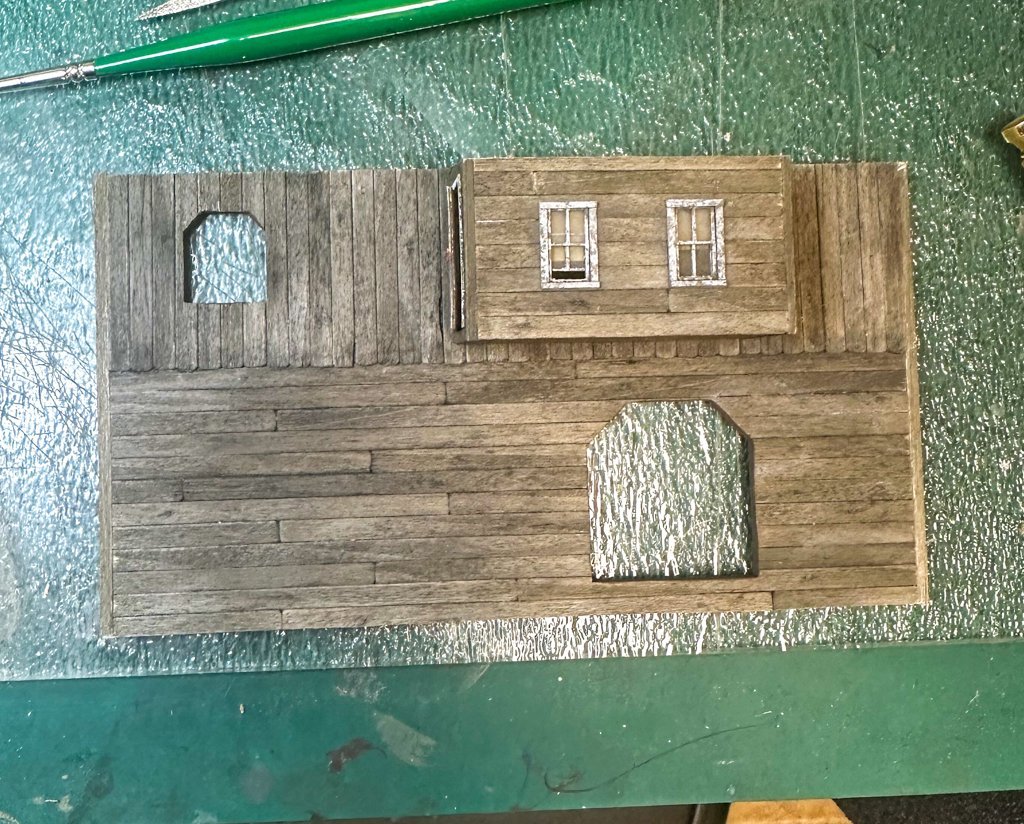
I think this looks better. BTW, the white of the window frames still looks a bit stark as I have not yet toned them down with some grey chalk.Completing the doors and windows that go on the walls was a breeze thanks to the kit's construction methods. Here is a photo of the freight doors.
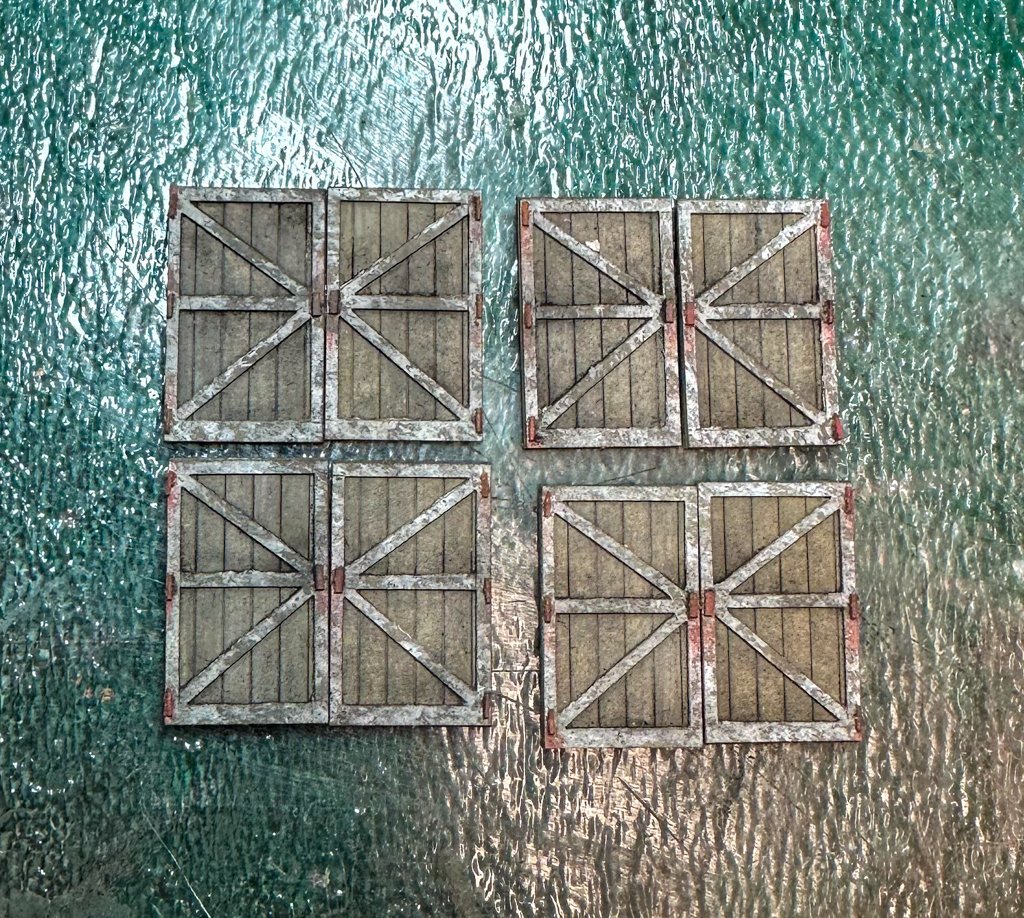
And before applying the "SHIPYARD" stencil, I did a practice run on some scrap wood. here is the result.
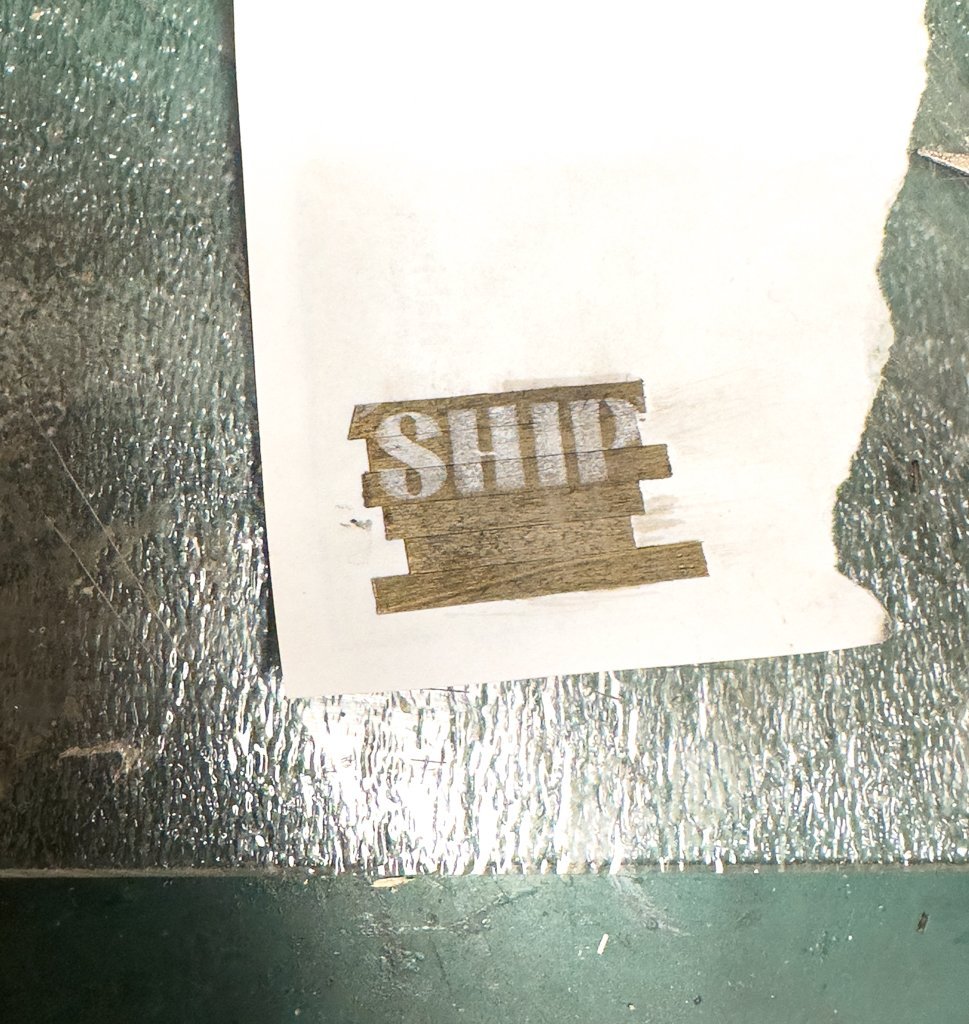
And finally, my thoughts on adding nail holes to simulate where the boards are nailed to the underlying beams, which is an option given during construction. I've reading many of the comments on the SW forum, I decided to place small "holes" only where 2 boards butt. In researching what kind of nails are used on wood siding, I came up with a nail size of 8d. This has a nail head size of 9/32 inch. At HO scale, converting to metric, this is ~ 0.08 mm, which is the approximate diameter of a human hair. The smallest nail indent I could make, even with the finest sewing needle, is 0.2-0.3 mm (this translates to a 1 inch nail head). I did some nail holes on the Foss landing building and looking at them now, they are barely visible after the building has been finished, and only from very close up. And if we are looking at the model at a distance of 1 foot, this would translate to 87 feet - how visible would nail holes be at that distance. So with all this in mind, I decided to forgo the nail hole rows. Similar discussions can be found on this forum on the use of treenails on deck and hull planking, especially at scales less than 1:48. after a few more steps the walls will be glued together and the building will begin to take shape.jeff
- mtaylor, FriedClams, ERS Rich and 9 others
-
 12
12
-
Greetings. now on to The Shipyard at Foss Landing. A fellow member, gjdale has created a build log on this kit so I'll not spend time replicating what he has done. His build log is an excellent reference for anyone wishing to tackle this kit.
Unlike the Foss landing buildings, the structures of the Shipyard are built up from wood strips. Each strip has to be stained, weathers and glued in place. The Sierra West forum has some great tutorials on how to do this. The strips are then glued to a thick cardboard backing to create the walls
Here's a photo of some of the main building wood strips. Chalk (Rembrandt 408.3) and alcohol applied after some texture using a wire brush. I plan to do some of the more advanced wood work as described such as edge sanding, splits, knots. bottom of boards wear and tear, etc.) as I place the boards on the walls. This will also keep things from getting too repetitive.
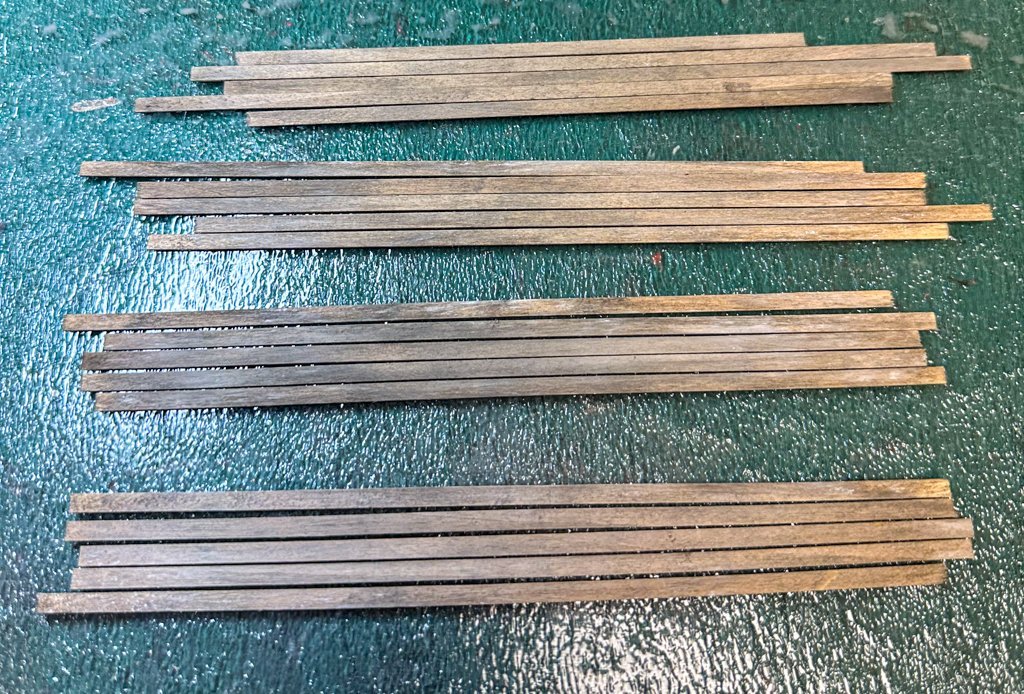
With the initial wood chalked, it's time to start the walls of the main building. Quite a difference in construction compared to Foss Landing. First a little background on how I laid the boards. First consideration - how long should each plank be? A single plank across the full face of the left or right walls would be are 156 mm across, equivalent to 44 ft at full scale - much too long for a single board. With a little research, I found that typical lengths for wood housing planks are 12 ft (HO 42 mm). Longer lengths offered would be 16 ft (56 mm), 20 ft (70 mm), 25 ft (87 mm). Not sure if this would translate to a building such as this but I decided to go with it. I felt that 42 mm was a bit small so the longer lengths were used. Any space on the wall that was at scale 10-12 ft or less would not have any butt joints in my opinion. With this in mind, here is the left wall with the planks laid out but not glued. Per my previous post, full length planks were initially treated with chalk. Once cut to size, they were finished in a manner described using tutorials on the Sierra West forum. Damage to boards such as splits, cracks, etc. were kept to a minimum. To quote the instructions, "this is a working shipyard and repairs would be made quickly..." Below, the boards have been cut to size, weathered and laid out on the wall template.
Notice the solitary plank sitting on the scribed area. It has a visible grain that does not take chalk or AI stain very well. Several of the full-length boards have areas such as this so one has to be vigilant that none find their way onto the wall. It was interesting to note that the visibility depends on the orientation of the board as well.
So once the boards are laid out, each was marked on the reverse side with a sharpie. The number on dots indicate which row it goes to.
For the second floor boards, using my rule from above, no butt joints were added as the length was 38 mm (full scale 10.8 ft). I also added some chips and gouges to a few of these boards, figuring they would end up a bit more weathered than the first floor, but nothing too severe.
Final result:
Dormers are next.
Jeff
-
Greetings,
Here we are at the last part of Foss Landing, the barrels and oil drums and rowboats. The rowboats will be upside down scattered around the diorama so no need for the interior detail work. I have a few larger HO scale rowboats that will be more complete
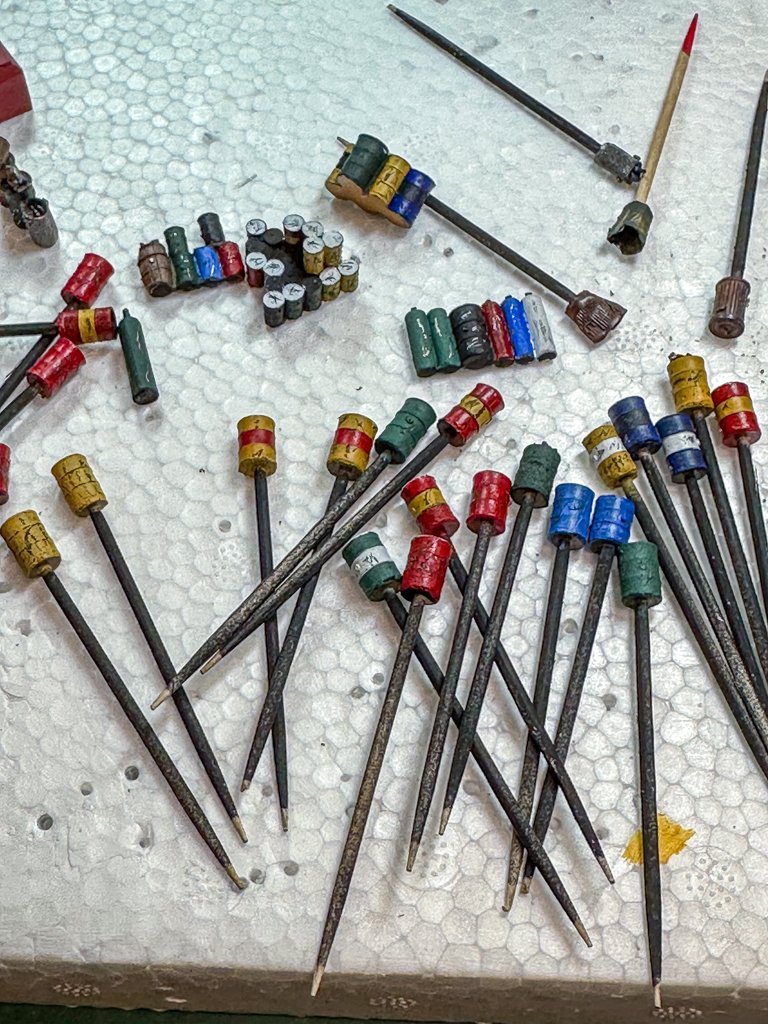
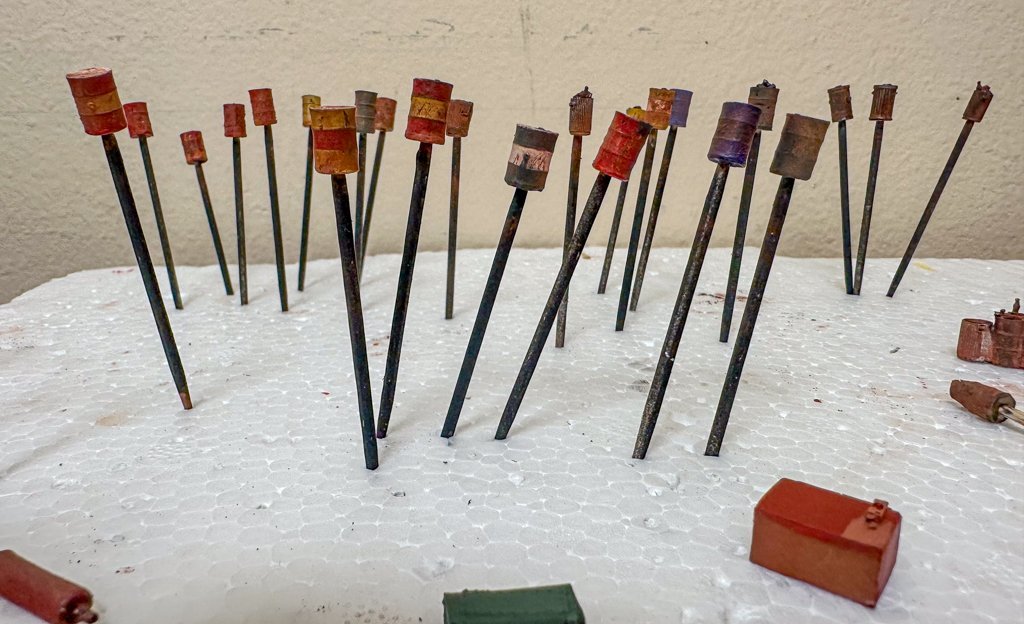
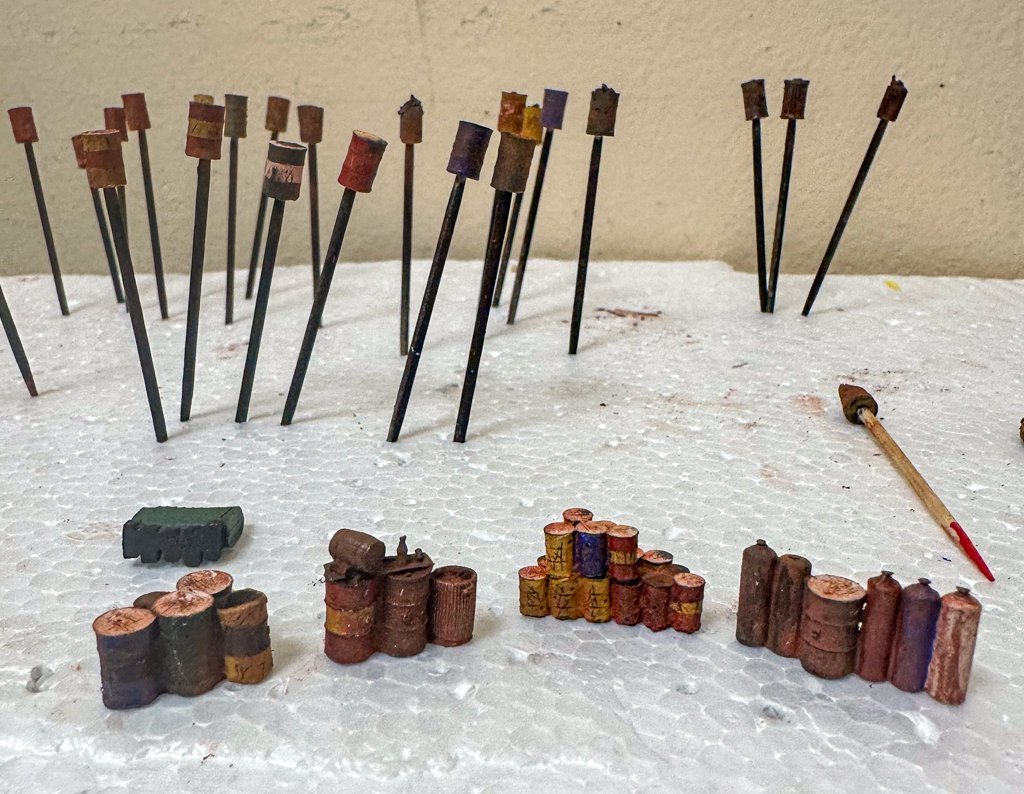
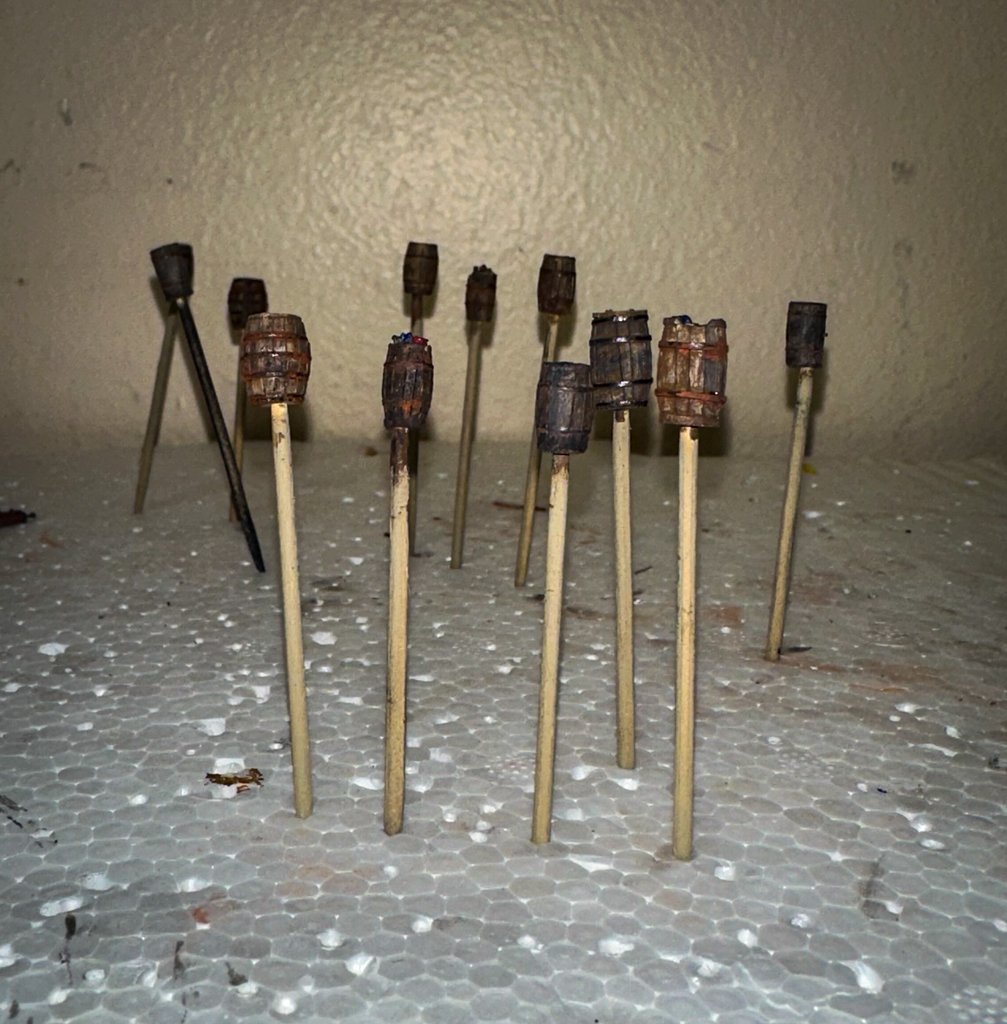
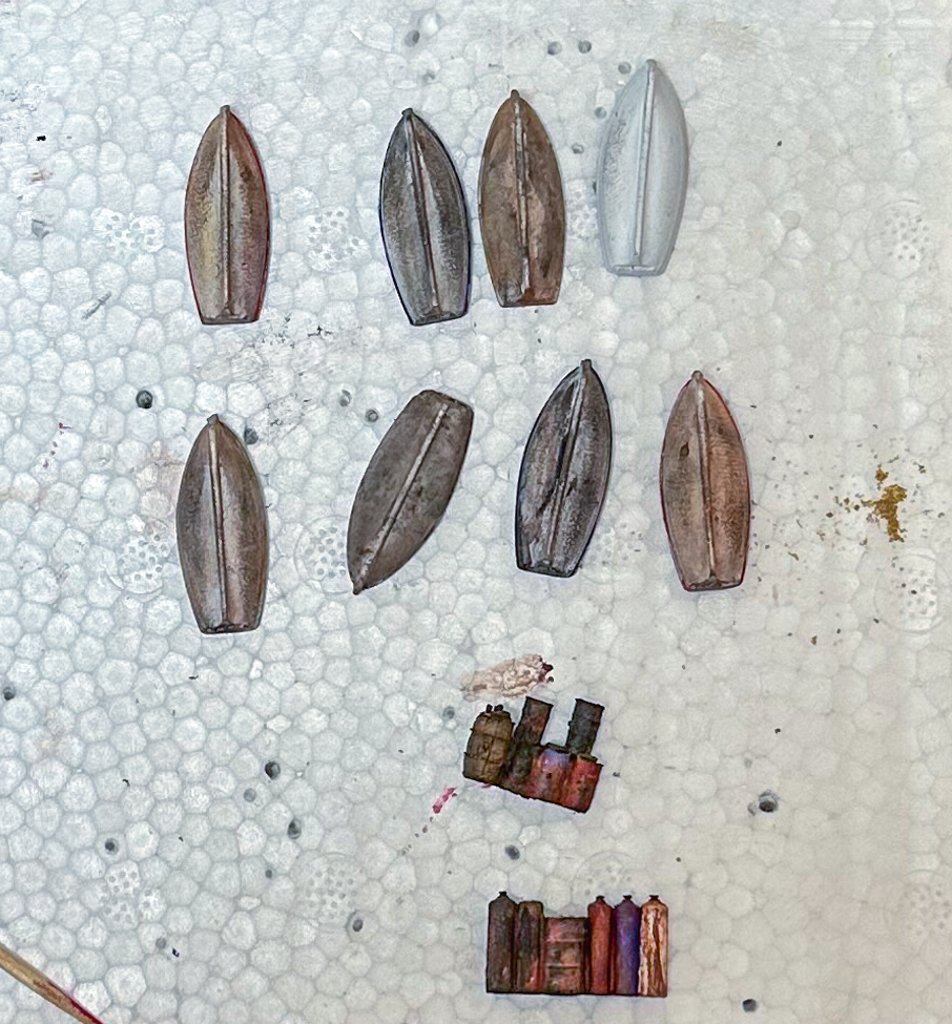
Below is the small scale. I found a photo of a scale face and shrunk it down (a lot!) and glued it to the front of the scale.
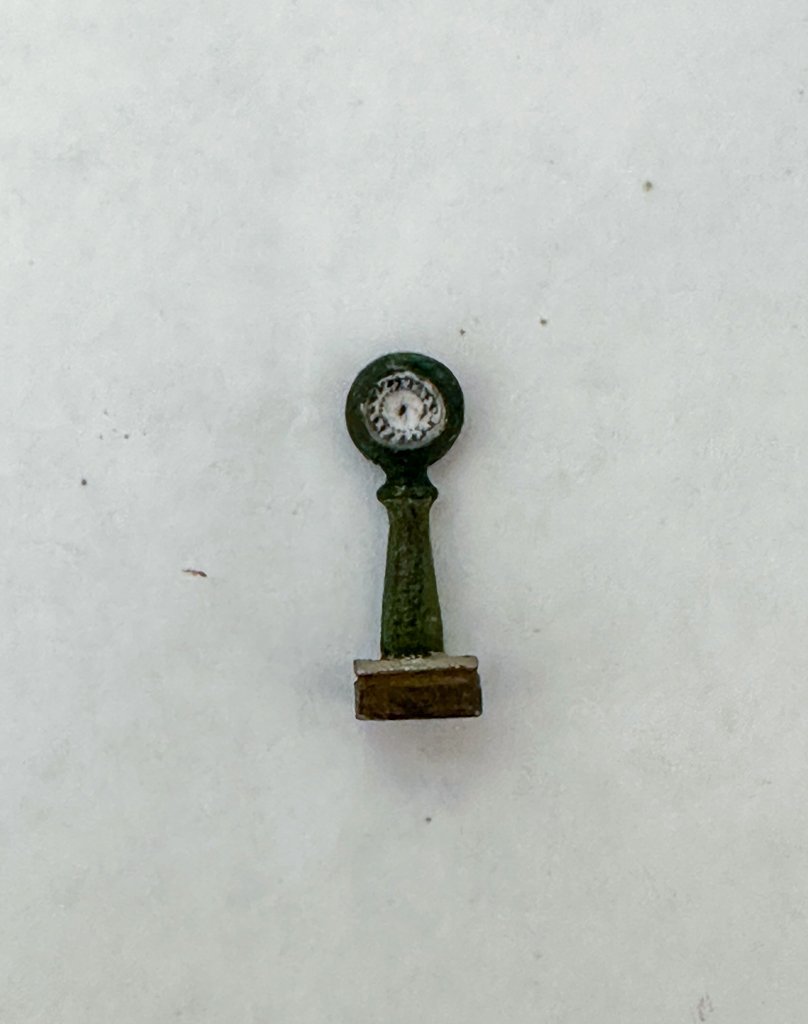
This completes the structures and castings of Foss Landing. Constructions will soon start on The Shipyard at Foss Landing. Looking forward to this - a larger, more detailed building.
Shout-out to to folks on the Sierra West forum for their wonderful tutorials.
Jeff
-
Greetings!
It has been a while since my last post but work proceeds on Foss Landing. I have completed the Addison and here are a few photos. Construction is quite similar to the Jewel so there is no need to repeat. As with the Jewel, I chose to rig with scale blocks and rope, using turnbuckles for the standing rigging. The arrows on the photo below were for a brief tutorial on rigging that can be found on the Sierra West forum.
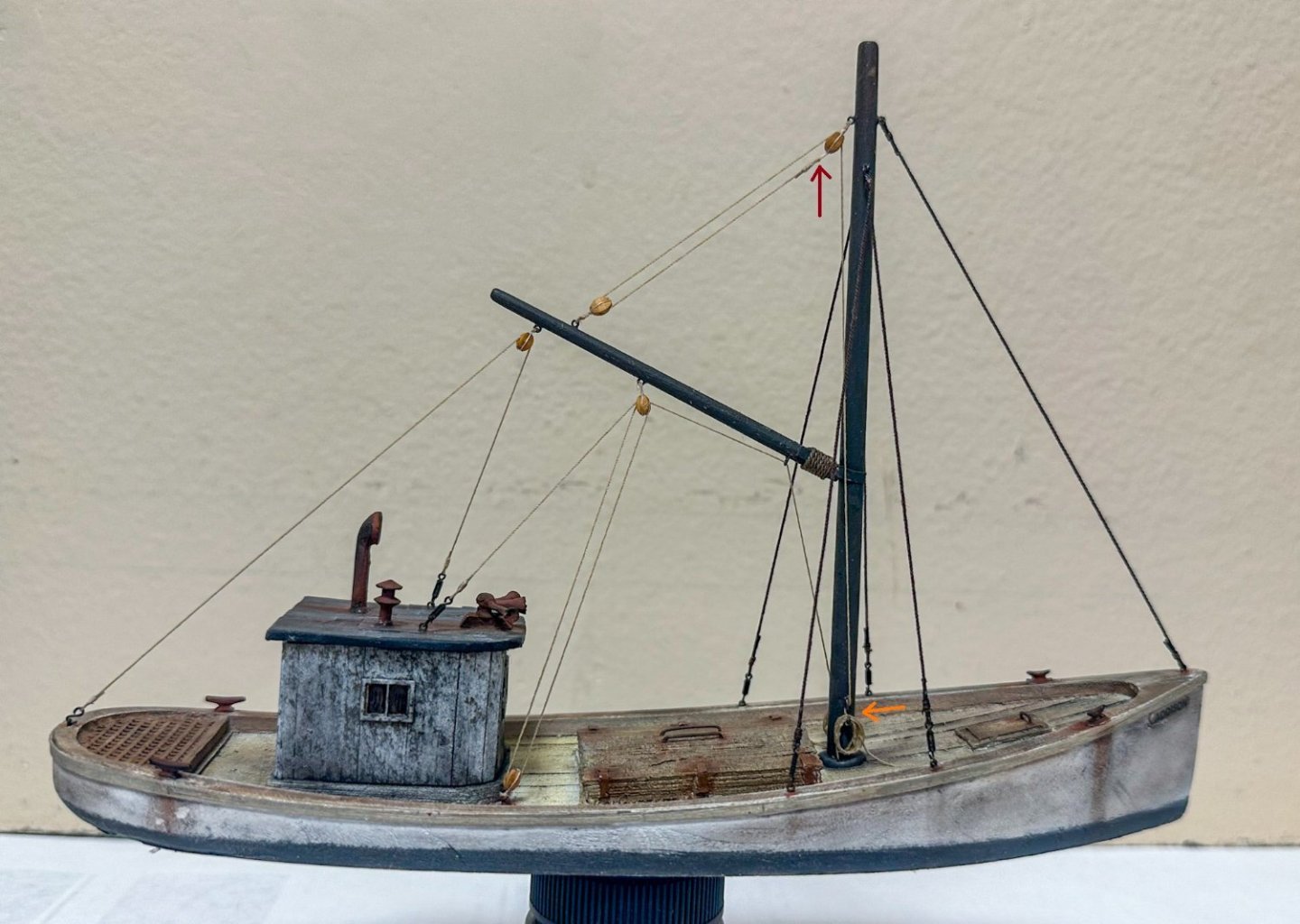
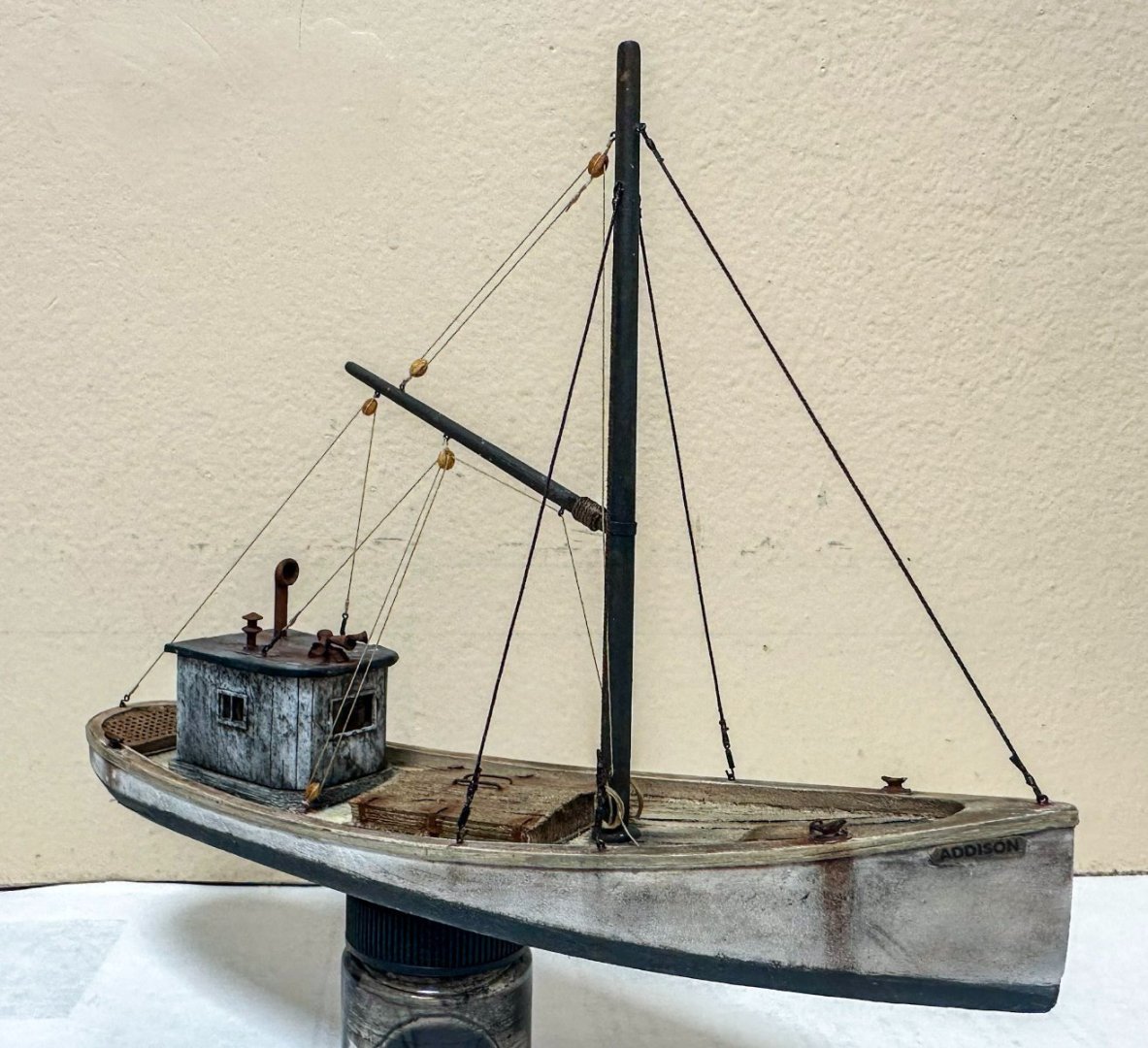
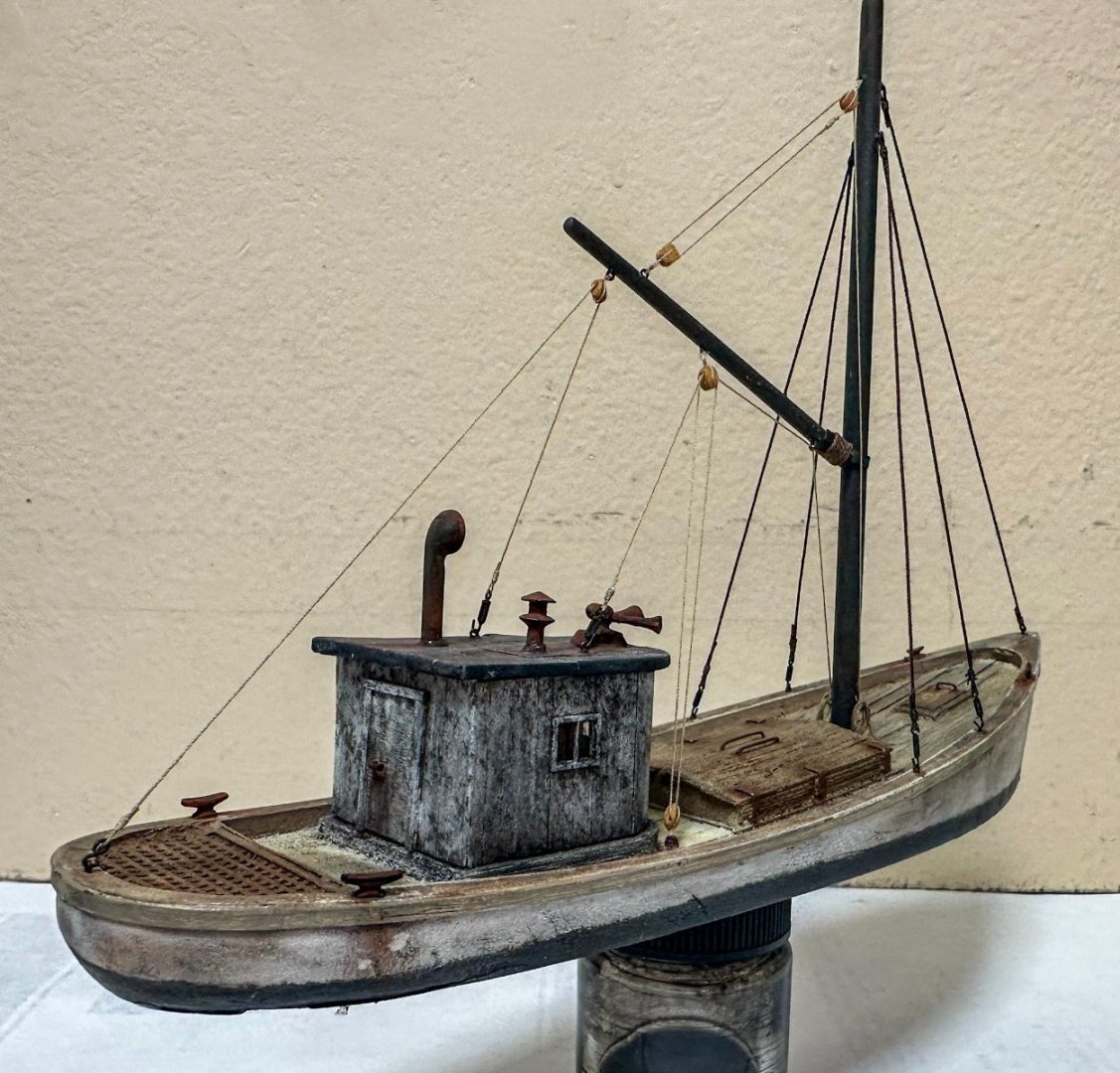
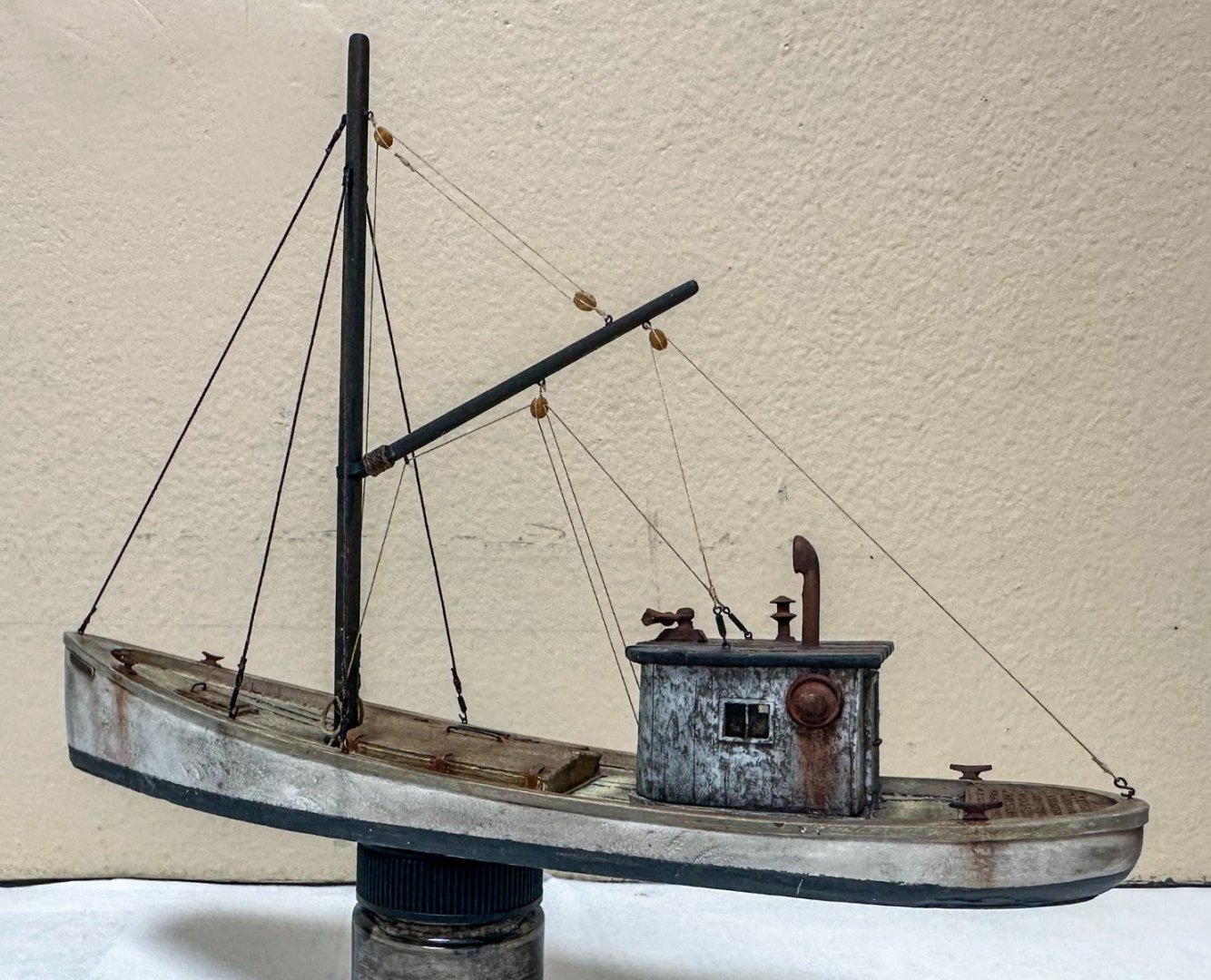
I will probably add some more details like netting, spare rope and barrels at a later time.
This completes the structures of Foss Landing. Here are some photos of them all laid out like in the diorama.

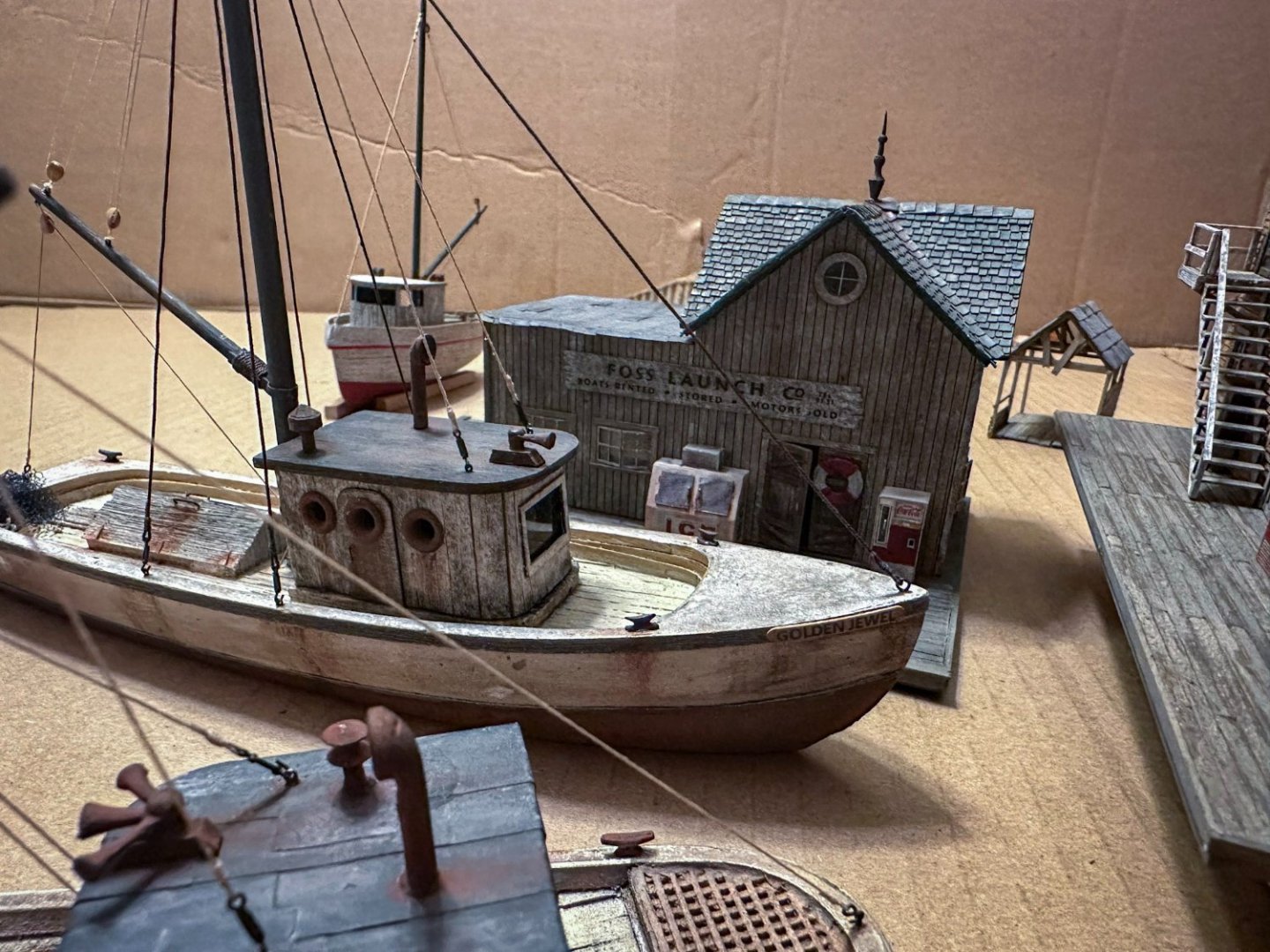
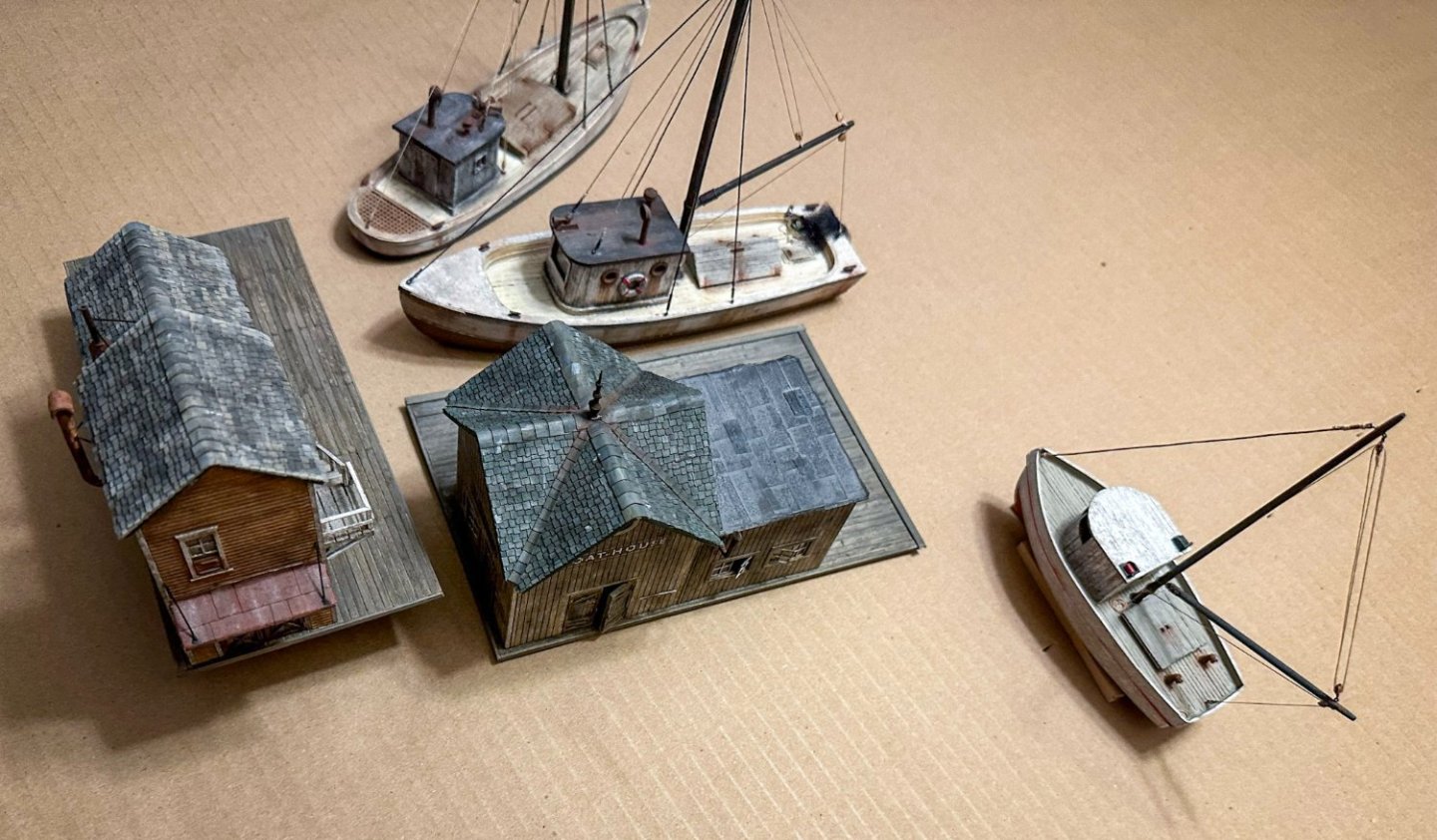
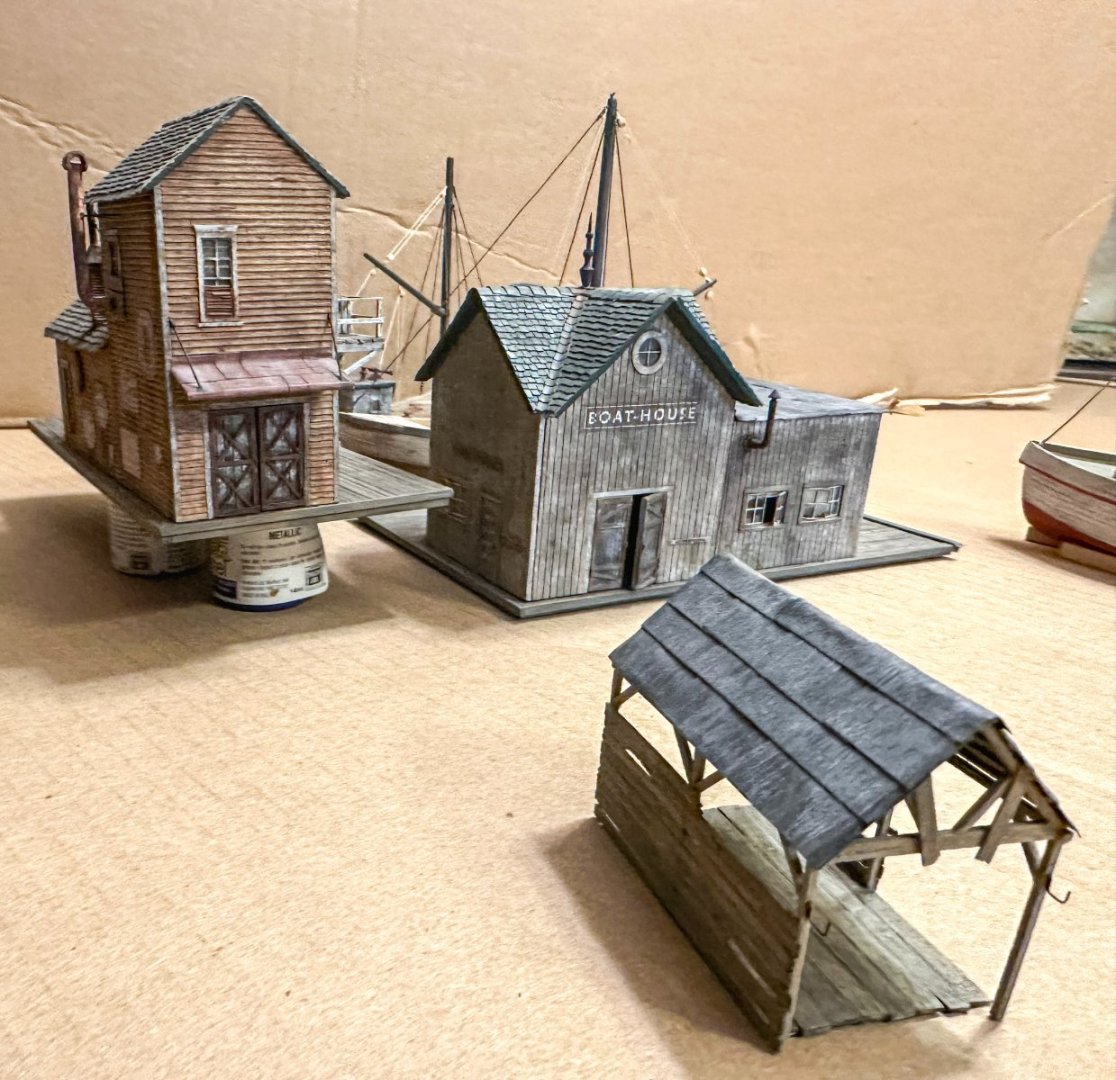
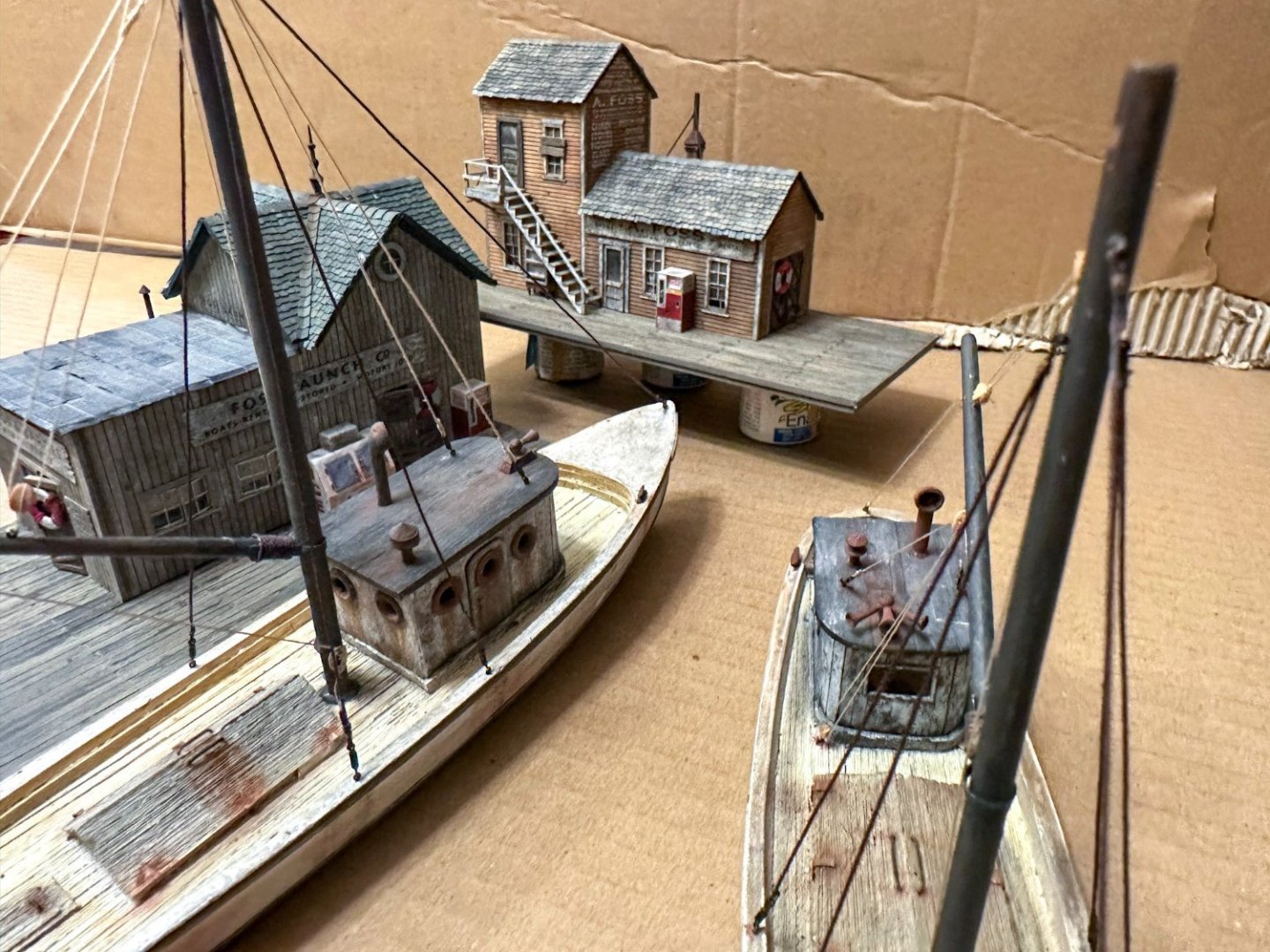
And here is a photo of some HO scale add-ons that can be seen in the photos above.
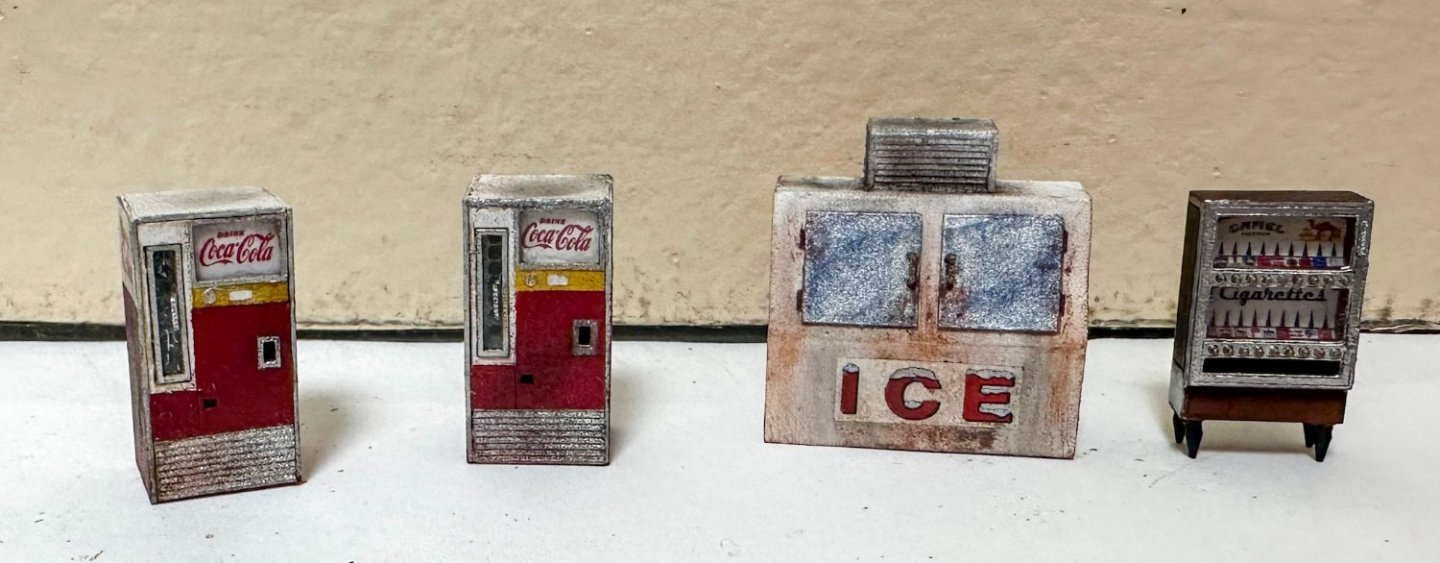
Next up: finishing the barrels, oil drums and trash cans, then onto the Shipyard.
Jeff -
Greetings!
Seems I forgot to do my last post for this fine kit. Well, here it is. Several pics of the completed ship and 2 with it in the case. The ship was 4 cm too tall to fit in the back of my SUV so I had to rent a panel truck to get it to my office.
Thanks for following along with my build log and be sure to check out "Foss Landing and the Shipyard at Foss Landing" in the Non-ship build section of shore leave.
Jeff
-
Greetings!
Thanks for the kind comments.
Here are some photos of my rigging for the Jewel. While the basic layout is similar to the kit plans, I used ropes from my ship modelling (Syren) rather than those supplied. I did not want to tie the ropes directly to the eyebolts (exception here is the rope leading from the mast to the bow. Rather, I wanted to use turnbuckles. In researching similar such ships, I found that this was a reasonable way to attach the ropes. I tried making them from a small wooden dowel but was not feasible given the small scale. Luckily, I found a place online to get them.
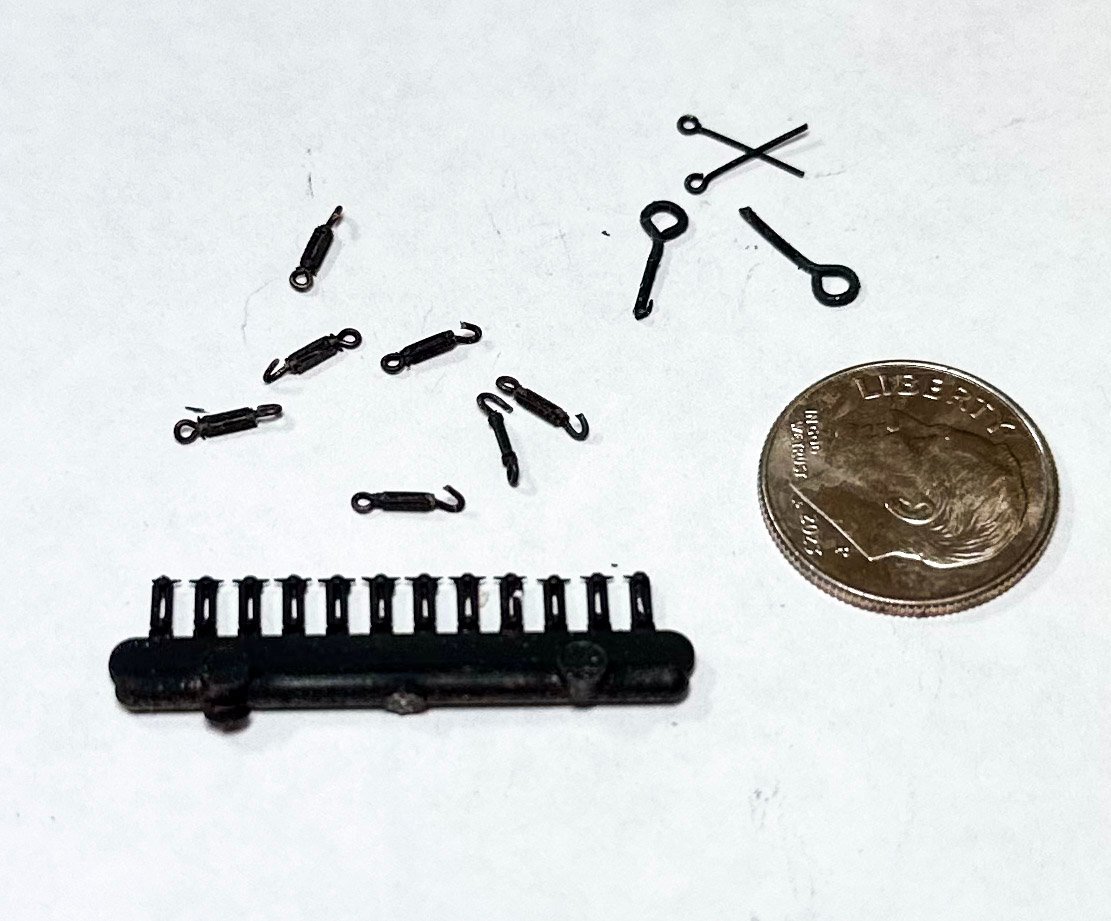
A small eyebolt was threaded through the central opening to give the final result. The kit supplied eyebolts can also be seen in the above photo. The kit had a unique way to simulate blocks, but as in the ship under repair (see a few posts earlier), I decided to use real blocks and rigging that seemed to make sense after looking at fishing vessels online. Final touch included a bunched-up fishing net at the stern (leftover hammock netting from a prior build). Here are a few photos to show the results.
And to finish it off, a small bird can be seen landing on the mast.
And one final item. I found an online Canadian company that has many unique HO scale mini kits. Some were pretty cool and I could not resist. Here is one example, an old- time cigarette machine, placed under the steps of the Clam and Oyster building.
I'll show some of the other items as I complete them. Next up is the Addison.
Jeff
-
Greetings!
On to the Jewel. When I bought Foss landing, there was an option to purchase 2 waterline boats to go with the Foss diorama, the Jewel and the Addison. Up first is the Jewel. The waterline molded boat is pretty good with regard to detail. I first used a white primer for the base layer. Below the lower wale was painted red, above left white. The decks were painted off white. here is a photo at this stage:
The deckhouse is built using a template with the boards weathered and painted as described previously, then glued directly onto the paper template. This next photo shows the process with the portholes supplied. They were a variety of colors with a gloss finish. 3 are in their original state, 3 have been "roughed up" and painted grimy black.
This next one is the aft wall before painting, and the portholes with "rust."
Portholes now installed. I painted the roof a speckled white like the walls and then realized that it should have been black. Easy enough to fix and it can be seen on later photos.
The walls were then glued to the appropriate place on the boat. Rather than try to glue the whole thing at once, I first glued just the forward wall with epoxy. When that set, I bent the walls around the former on the deck to achieve the final structure. Because the walls are pretty flimsy, some wood was added to the perimeter at the top to give more gluing area for the roof. The front window is installed around this step too. Instructions call for the plastic to be fogged using DioSol, however, I decided to go with a clearer window as I could not imaging running a boat with windows that were too foggy.
The rear wall is then glued on when complete. I thought the deckhouse looked too empty, especially with the clear "glass" in place. So, prior to putting the roof on, I decided to try to make a ships wheel using some spare ship modelling parts.
The rings are small mast hoops; wood strips cut from 0.5 x 5 mm strip to 0.5 x 1 mm. The central hub is a rough 3 mm circle of styrene.
Here is the result. Looks ok, considering it will be inside the deckhouse. I made one for the Addison as well.
And here's what it looks like inside the deckhouse.
Once the roof is installed, the horn, some sort of ?smokestack and ?vent are installed. Weathering and rust applied to ship. The hardware for the rigging has been installed as well. This includes several eyebolts, 4 cleats and door / hatch handles. Unfortunately, I somehow lost the cleats that came with the kit. Luckily, I had some spares from a prior model that were close enough in size, so I used 2 of these that were slightly larger aft, and 2 from the Addison will be used forward. I also used smaller eyebolts as I felt the ones in the kit were a bit too large for the HO scale (full size would translate to a 10-inch eyebolt). And finally, the name was changed to "Golden Jewel." When researching ships of this size, the name is often on some sort of wooden or metal plaque attached to the hull. I reduced and printed a very small name and glued it to a thin wood strip, then glued this to the hull.
Next post will be the rigging.
Jeff
- king derelict, gjdale, mtaylor and 14 others
-
 17
17
-
Greetings!
here are some photos of the last main item of Foss landing, the boat and its accompanying items, the saw horse(s) and ladder. These items were constructed using the template supplied. The plans call for one sawhorse but I had enough planks to build 2. They are quite delicate so spare wood was used to provide support.
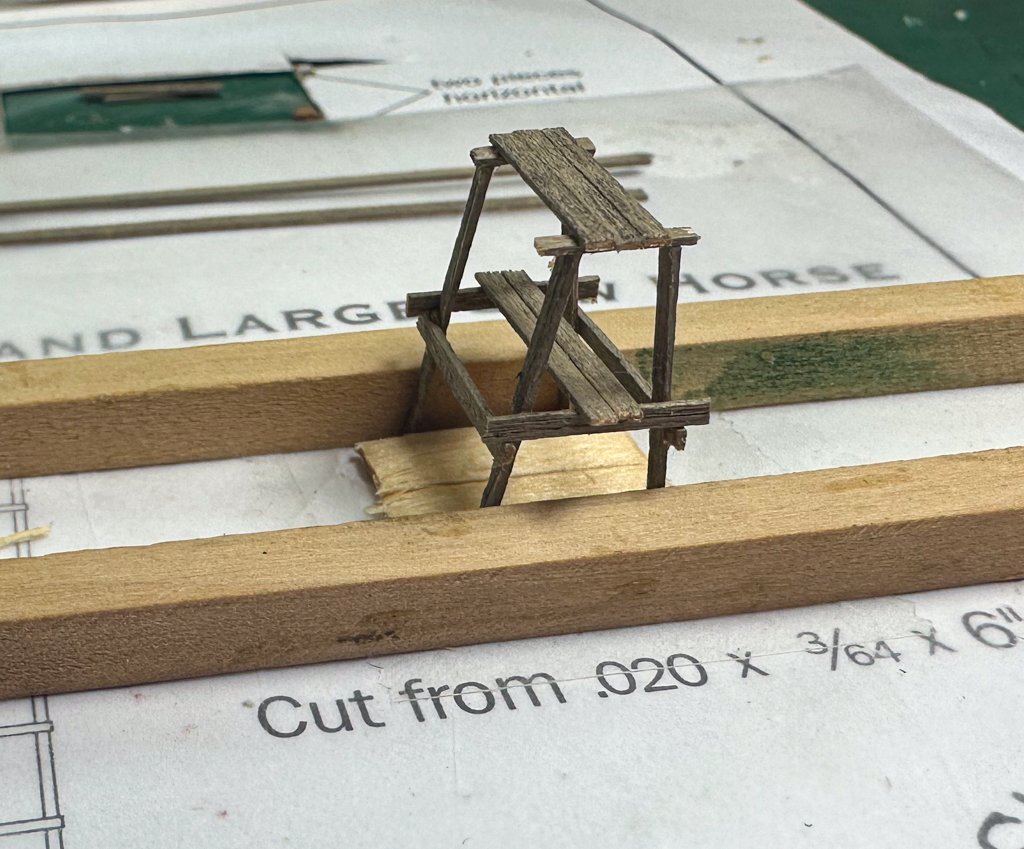

I decided to install the mast however I took things a bit further and added a gaff and associated rigging. Normally these would likely lead to a cleat on the mast. not having any of the correct scale, I used a small eye bolt fashioned into a hook and coiled the rope onto the hook. A stay was added leading from the mast to the bow, secured to an eye bolt on the deck. A 3mm double block was used for the gaff lift. A single sheaved block was used for the line on the underside of the gaff, secured to the deck with a hook, again fashioned from an eye bolt. I was able to work out this simplified rigging from some photos of similar boats found on the internet. I also added red and green running lights to the roof. I may add some more details such as a smoke stack, but for now, this is enough. Here's a few photos:

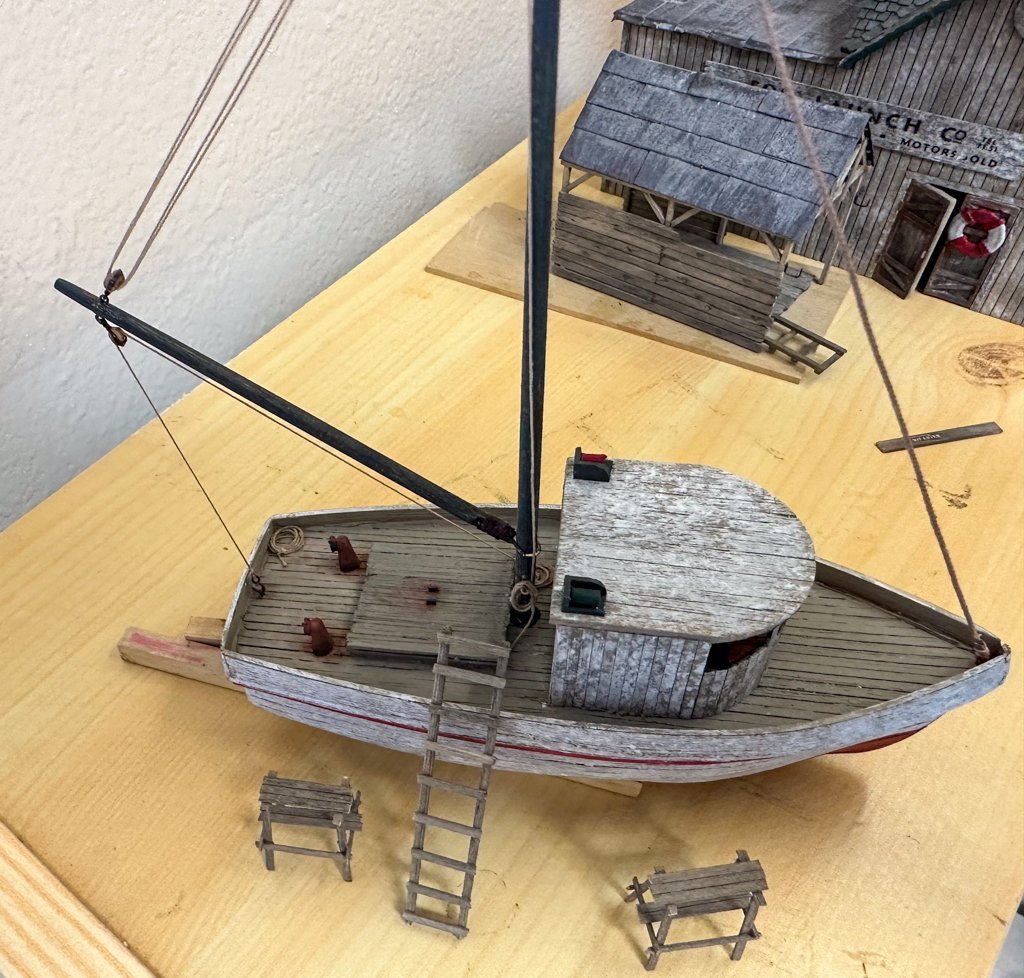
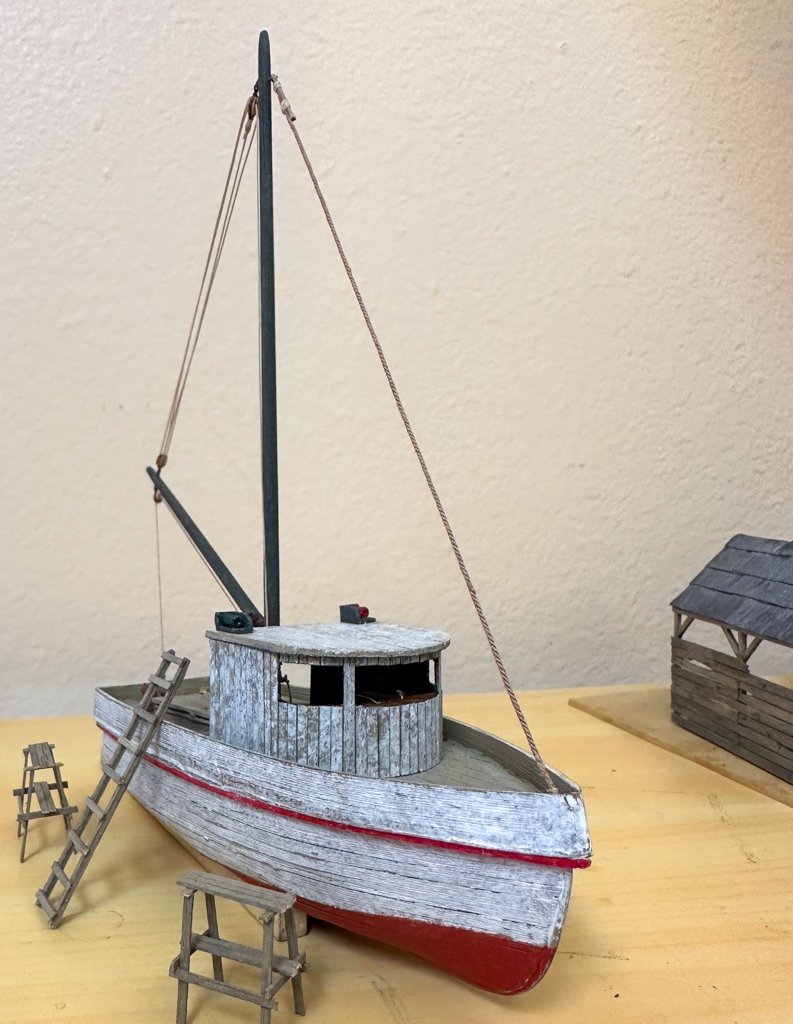
And finally, Foss Landing, "on the shelf."
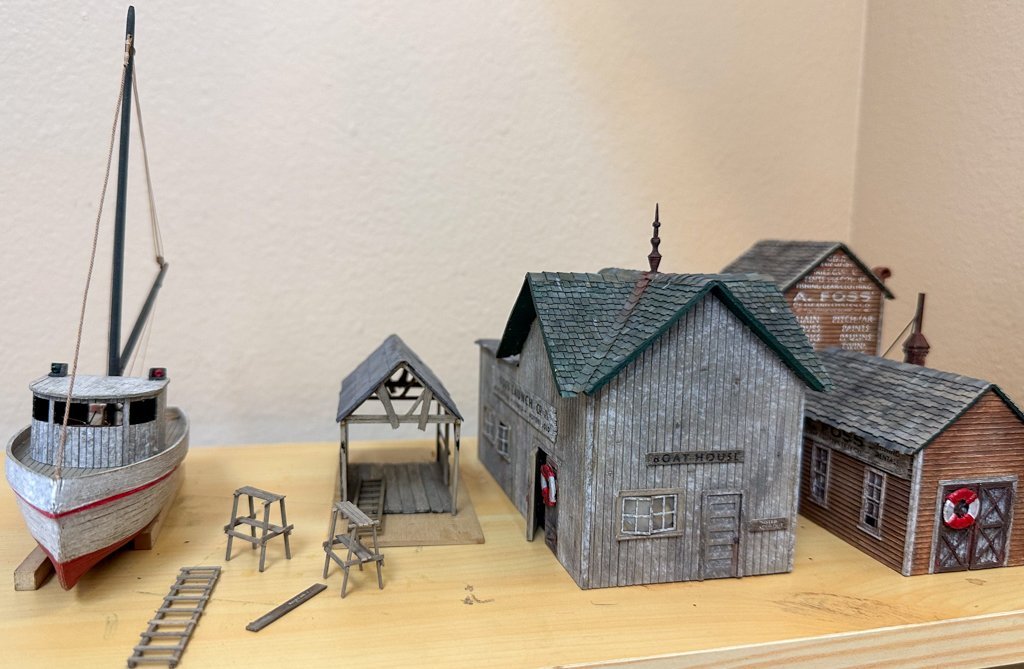
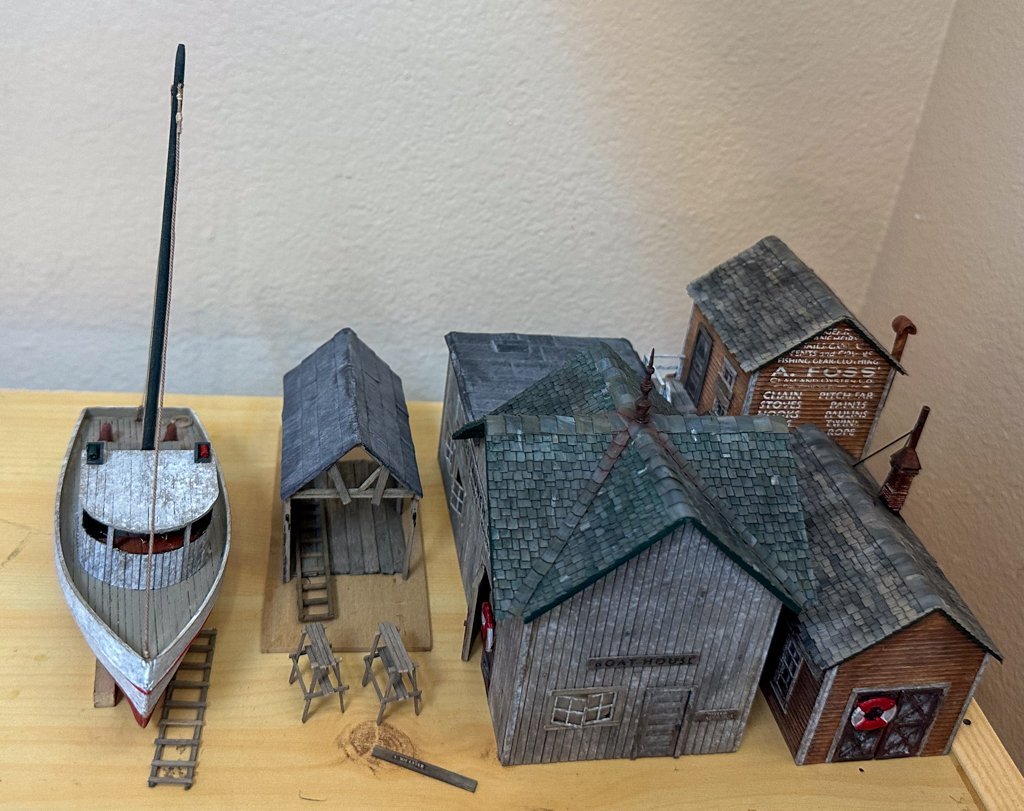
Next up, the Jewel and Addison, 2 waterline kits that will be at the dock in the completed diorama. I plan to modify the rigging for this boat too, using blocks and rope.
Jeff
-
Greetings!
Thanks for the kind comments. The new docks are complete. I decided to make a new Oyster Co dock so it would be a closer match the the re-done Launch Co dock. The templates were used for both. Here is the Lauch Co dock, re-done and kit supplied.
And here are a few photos of the docks and their respective buildings.
Next up is the fishing boat. This comes in 2 parts that have to be glued together. The deck is slightly larger than the lower hull. I decided to glue a small board here to simulate trim after the painting of the boat - below the waterline is red, above is stippled white. The trim was then painted red. I plan to use some chalk to tone down the bright red, maybe add some barnacles as well.
The boat cabin and roof are made using template. The wood is glued onto the template to give the cabin a firm backing.
The cabin sections were cut out with a new blade (very important to use a new one as the instructions state). The sections above the cabin windows were pretty flimsy even with the paper backing.
Once the cabin was glued in place, a 0.5 x 2 mm board was glued to the upper edge of the cabin (arrows in photo below)
The cabin roof was modified somewhat by adding planking. Rather than using the original template sheet for the roof, I made a copy and used that, just in case I did not like the finished roof. Once it was finished, I did a test fit and found out my copy was not exactly 1:1 - the roof was too small by 1-2 mm. Rather than fiddle with my copier, I just used the template supplied. The spare roof was used to make the counter in the cabin as can be seen in the photos below.
A few "benches" were added to the cabin walls. As this boat is undergoing a refit and refinishing, loose wires were added to the cabin counter as of course any electronics were pulled prior to the refit. A few support beams were added to the structure and this is where I am currently.
One interesting note. The instructions call for a mast to be placed in a hole located between the cabin and the hatch. As you can see in the photos above, there is no opening for the mast. It would be simple enough to drill one but not sure if I want to.
The ladder and sawhorses will be made next. I may then start on the 2 boats that complement the kit, Jewel and Addison.
Jeff
-
Greetings!
As I complete the new dock, here is work on the rowboat shed. It is a rather delicate structure. The templates supplied with the kit were essential in construction. The template was fixed to my cutting mat with double sided tape and was then covered with wax paper to allow the wood to be glued without messing up the template. First photo shows the start of the 3 roof trusses and the walls. Scrap wood used to keep the wall studs lined up.
.thumb.jpg.e18dc4189866942e5d313e53268ad9a1.jpg)
A little further along the side boards for the walls have been aged and applied. The front wall was to only have the rowboat brace, but I added a few boards at the bottom. Spacers used for ladder to keep distance between the side rails constant.
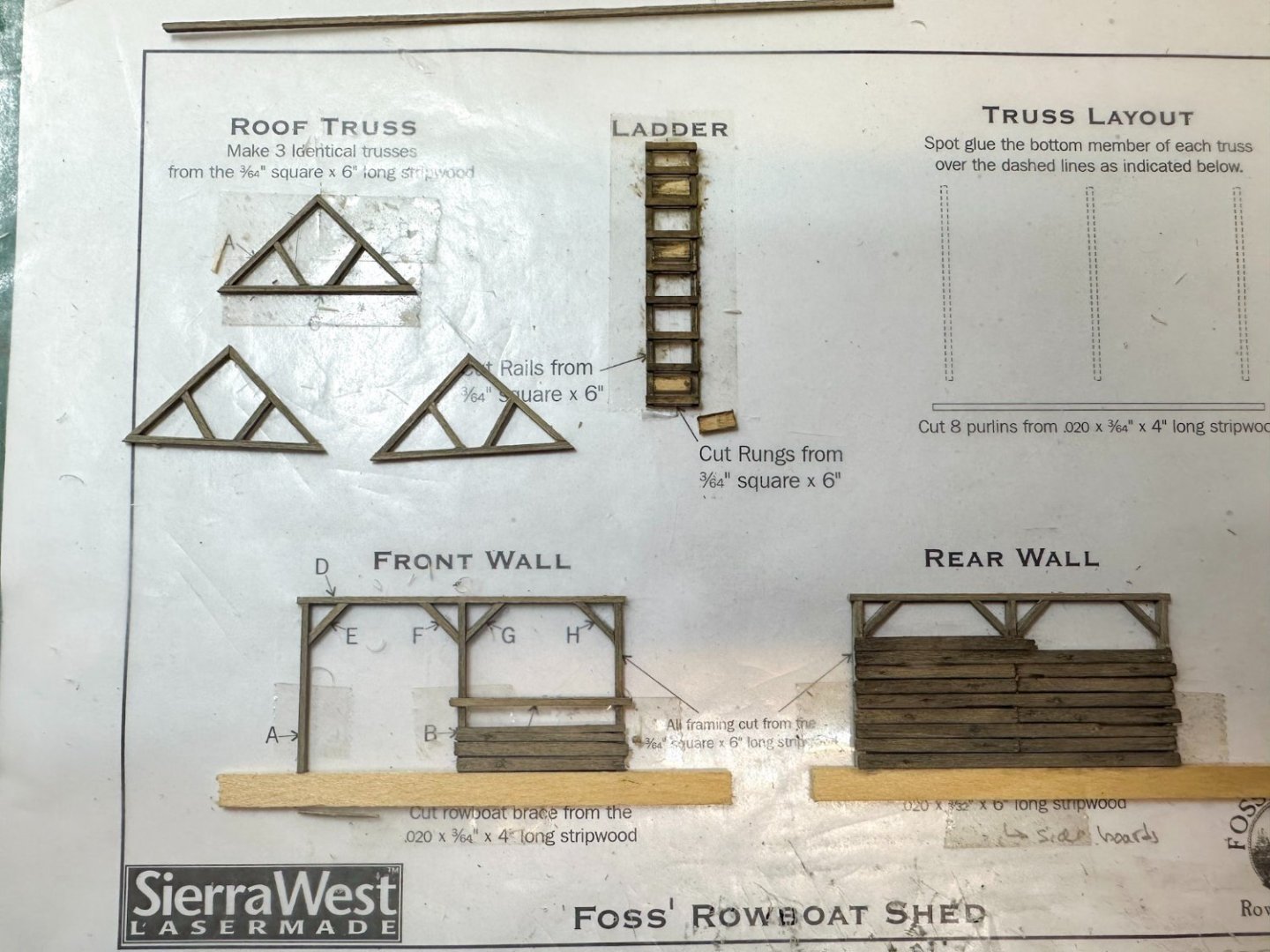
The floorboards were then weathered and glued together. Small slots were cut to accommodate the wall studs and 2 cross braces were added to connect the walls. The trusses at each end sit on these braces with the third one midway. This photo shows most of that.
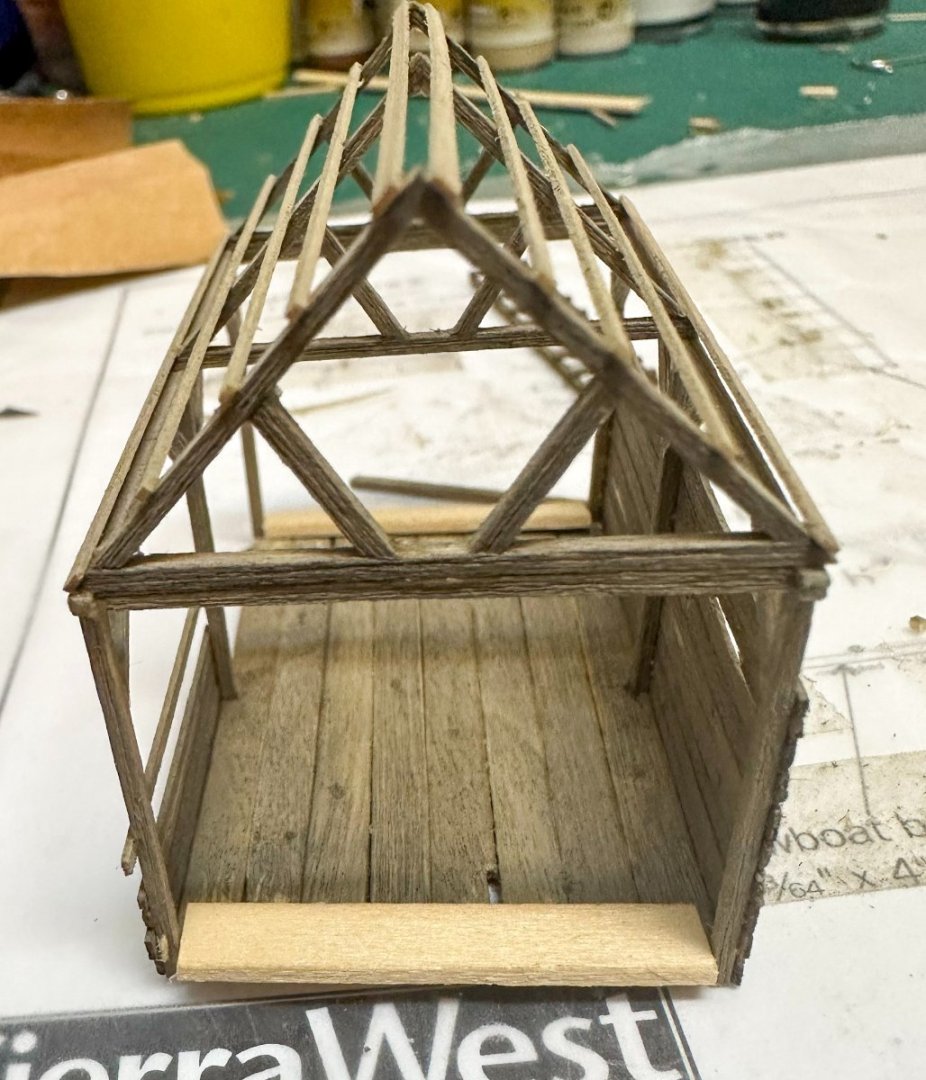
Here is a close up of the rear wall:
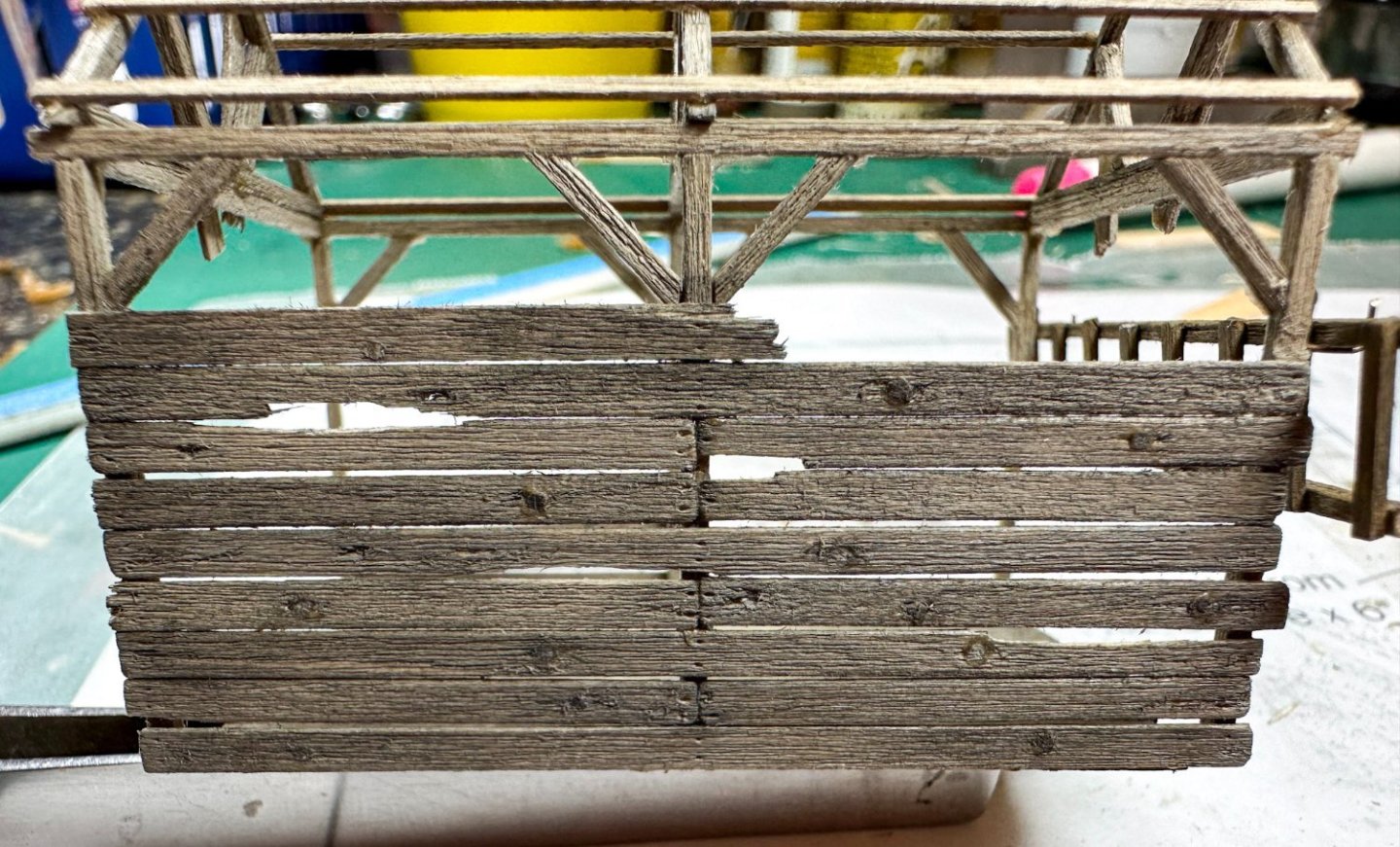
Beams to support the tarpaper roof are added next. I used a slightly wider beam for the lower and upper most beams.
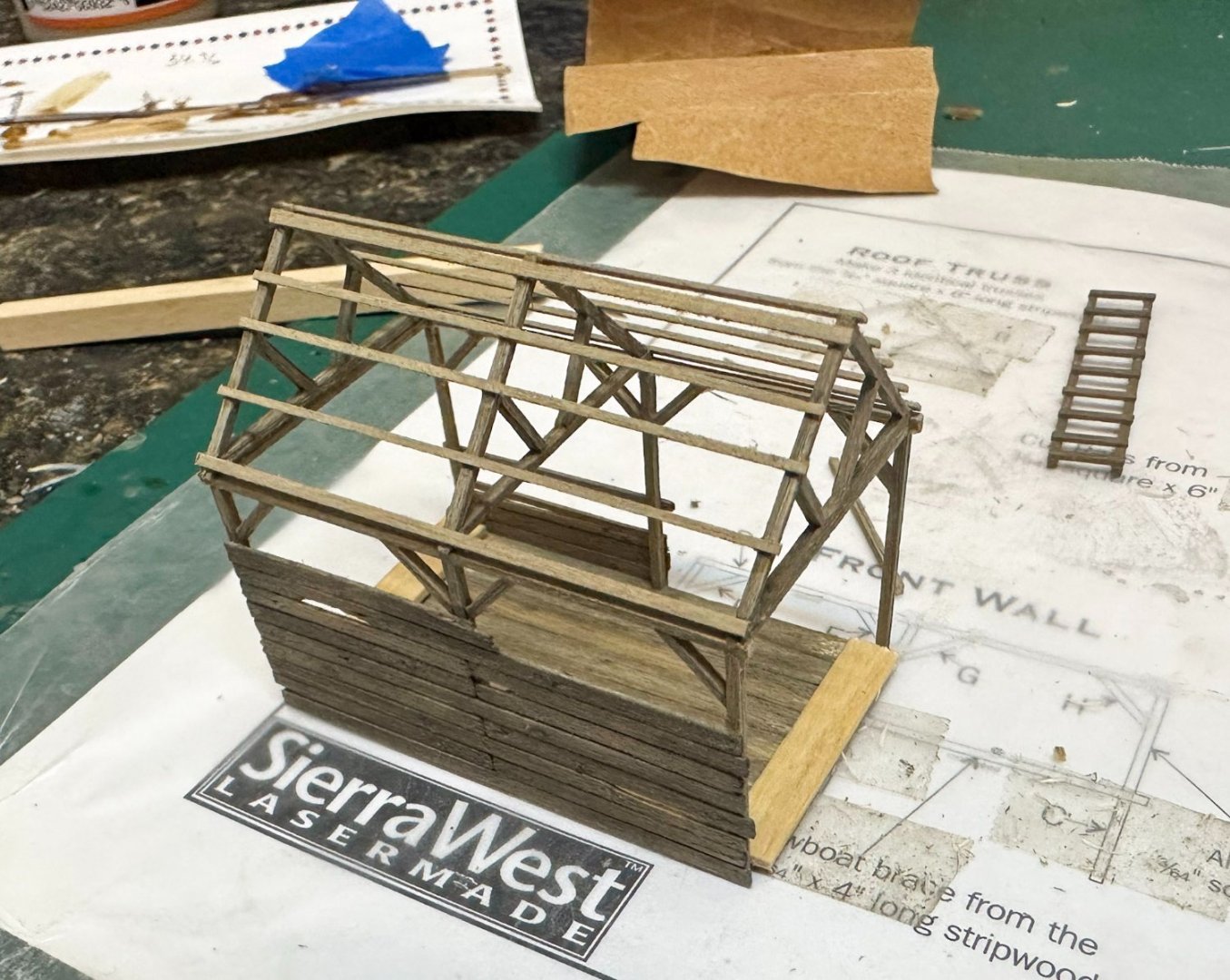
The tarpaper is prepared as described for the roof of the Launch Co. A few hooks are fashioned from the small brass rod supplied and glued to the studs. Some scrap boards are glued to the end trusses for support. Final result:
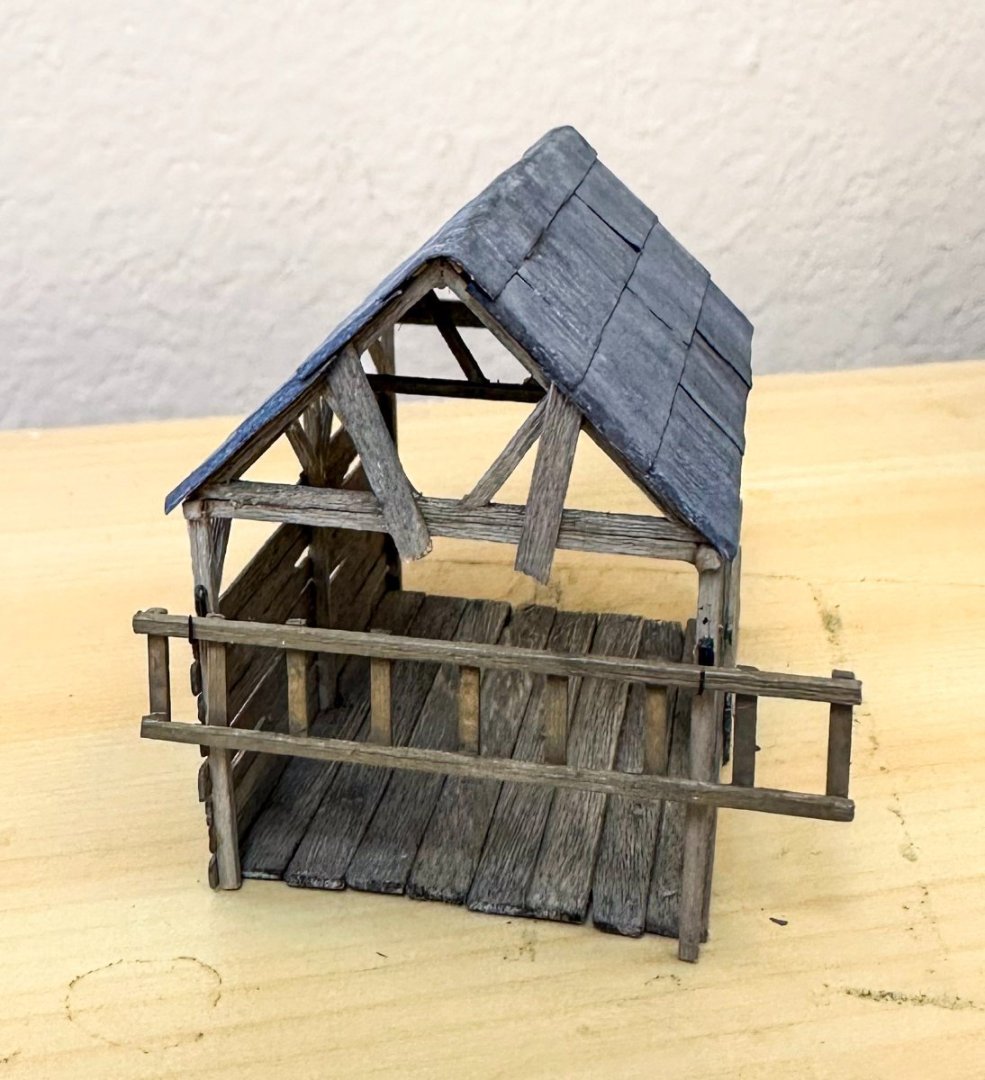
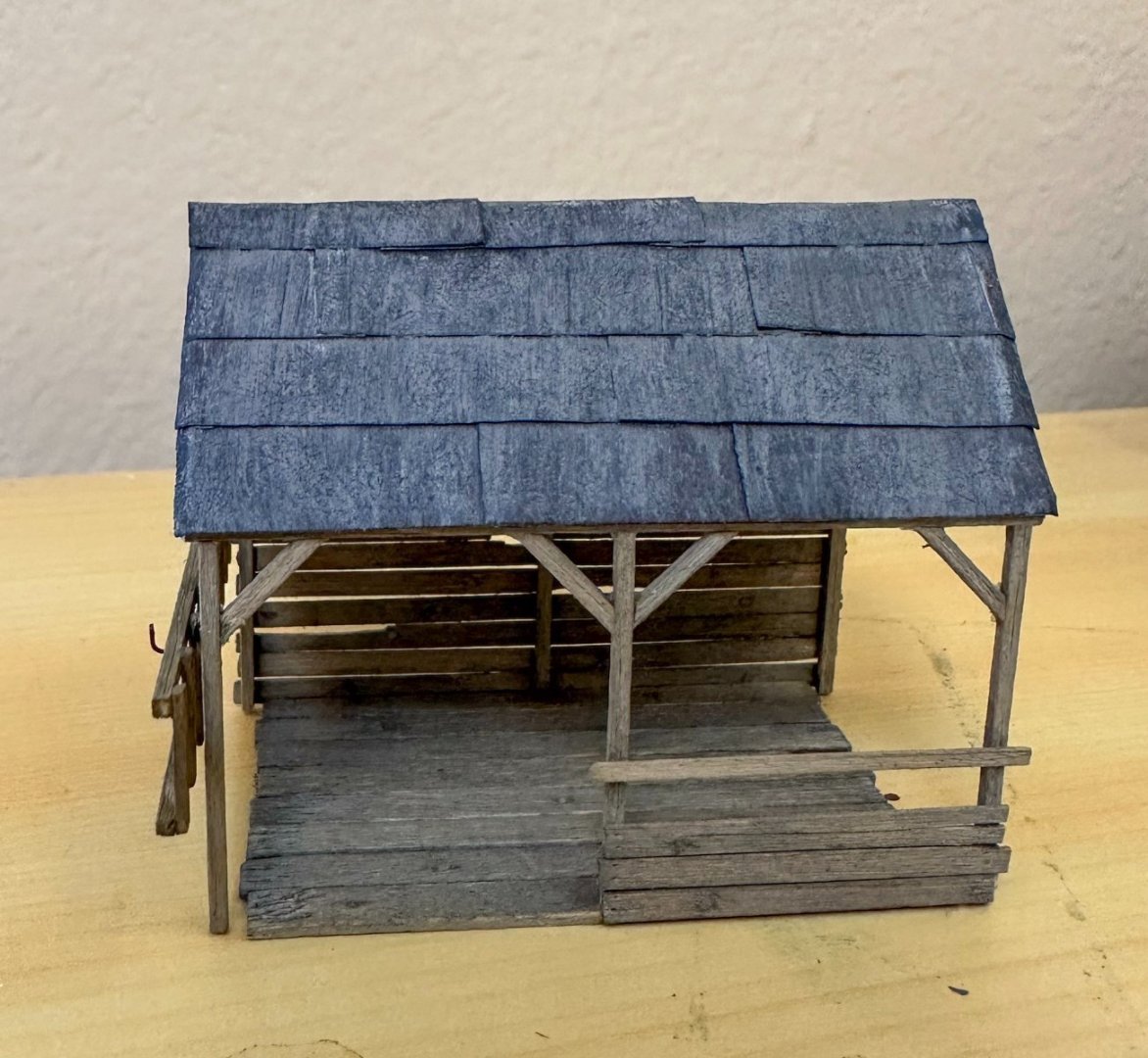
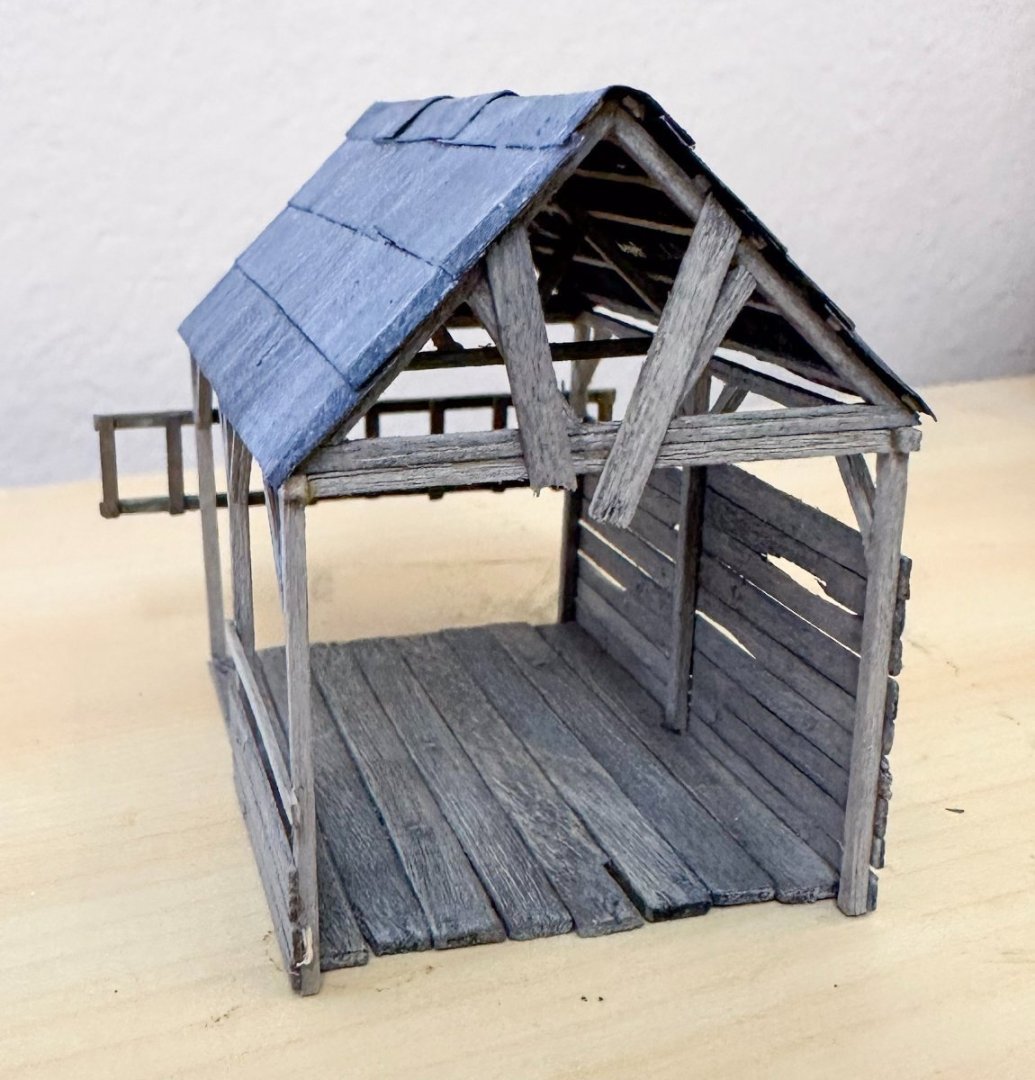
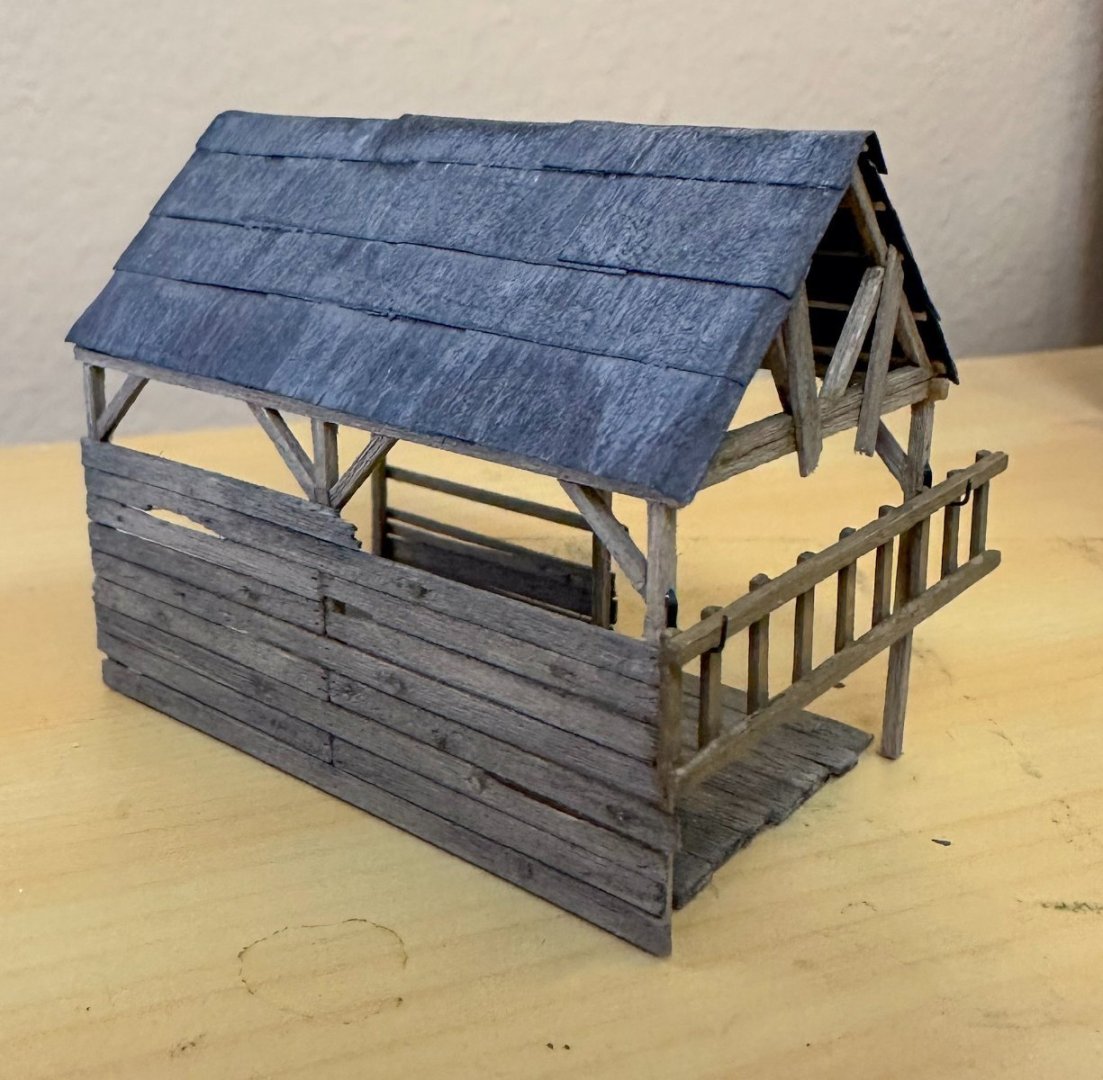
The new dock for the Launch Co will soon be completed. I've also decided to redo the Oyster Co dock and will show this as well.
Jeff
- gjdale, mtaylor, Knocklouder and 7 others
-
 10
10
-
Greetings!
Thanks for all the wonderful comments. This has been an enjoyable kit thus far.
Now onto the large dock. This is similar to the dock that the Oyster Co. sits on thought it is much bigger and comes in 2 parts. The 2 sections were glued together and then square stripwood was glued along the perimeter and the same was used for the cross beams. After I applied some chalk followed by AI, (similar to what I did with the other dock), this one developed some serious warping. I used gorilla glue and instructions called for epoxy. The problem likely came about from the alcohol leaching through the dock and loosening the glue on the beams. This was the result:
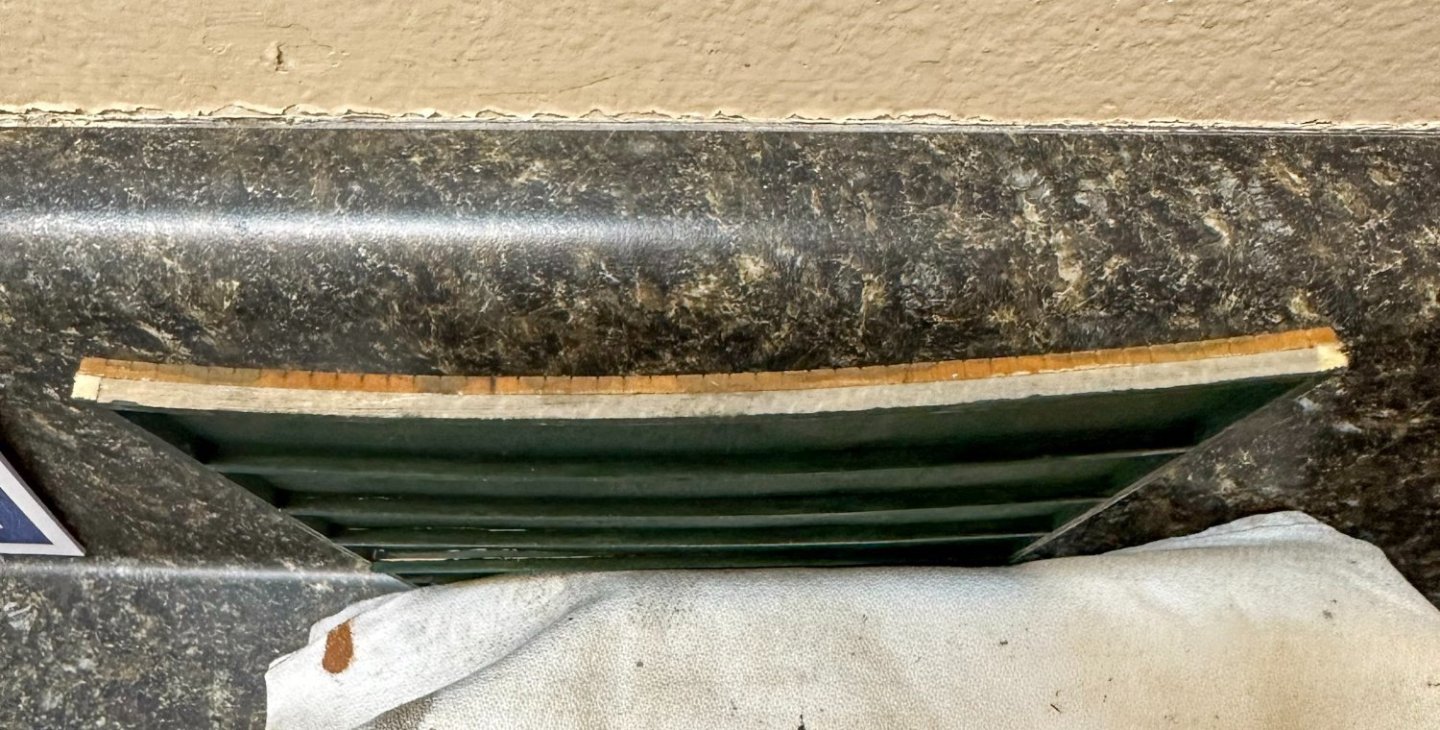
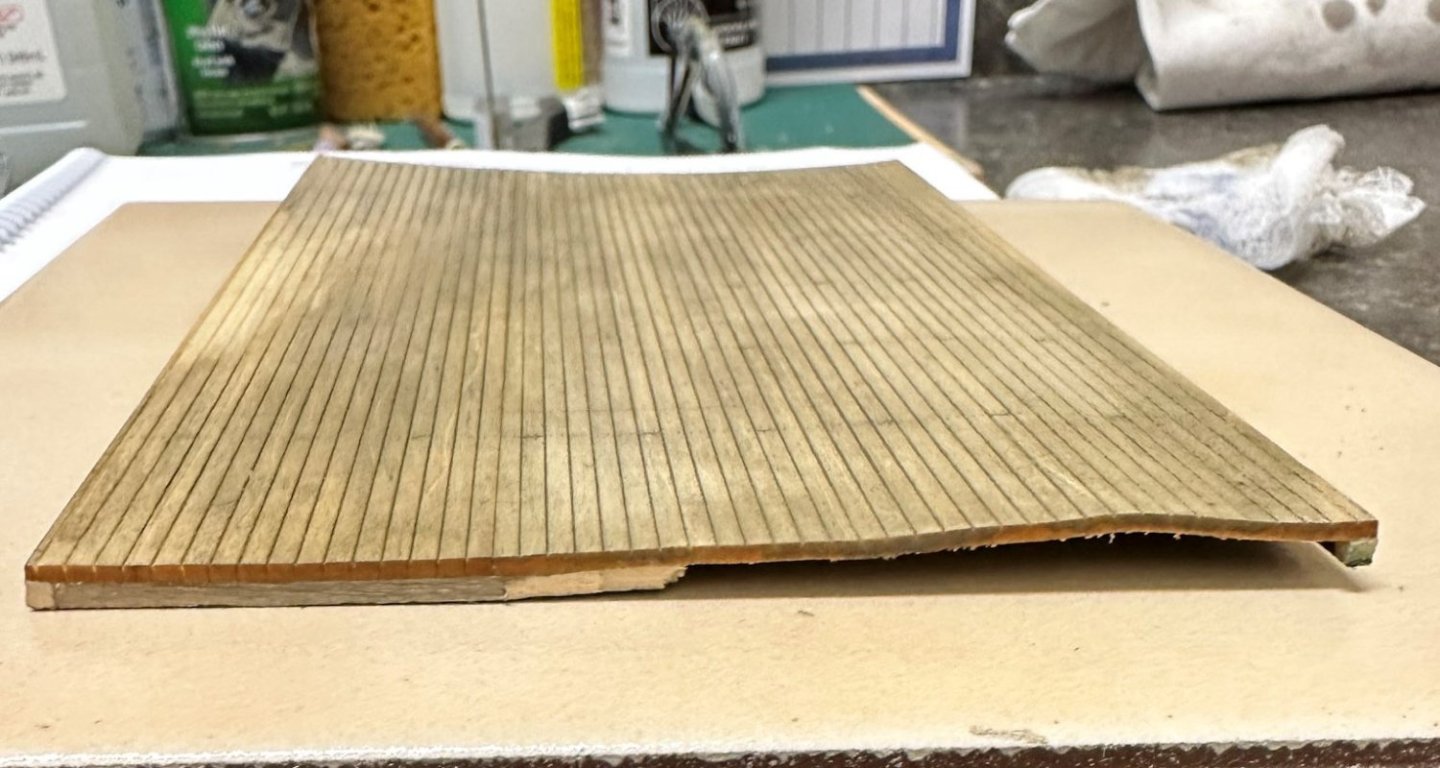
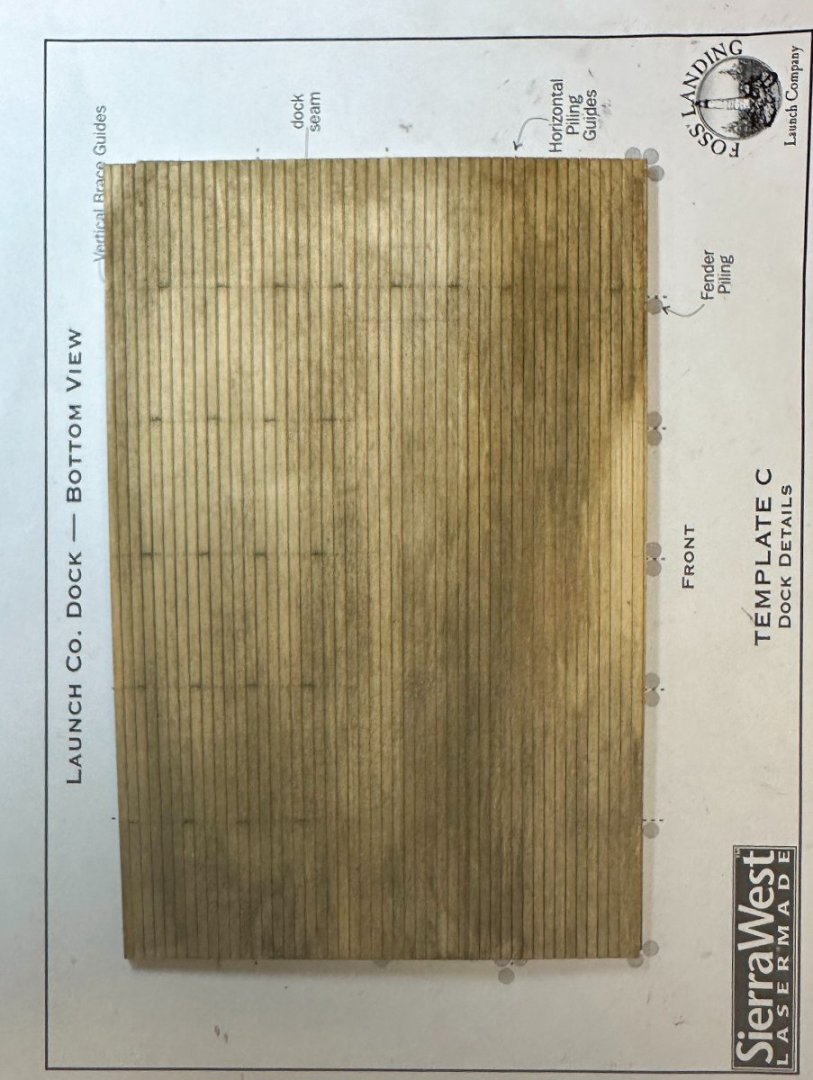
The same method was used to build the smaller dock for the Oyster Co building without issues. And having built multiple ships, I am always reluctant to use epoxy on wood-to-wood bonds - never know when you have to de-bond something. But lesson learned - use what is recommended in the kit instructions!
I thought there was no point in trying to salvage that, so, time to make a dock. Using leftover wood from prior ship models, the underside of the dock was made with 3x2 mm walnut. The template was a big help. The boards are made from 1/16 x 3/32 basswood and weathered following techniques described on the Sierra West Forum. Here are photos of work in progress:
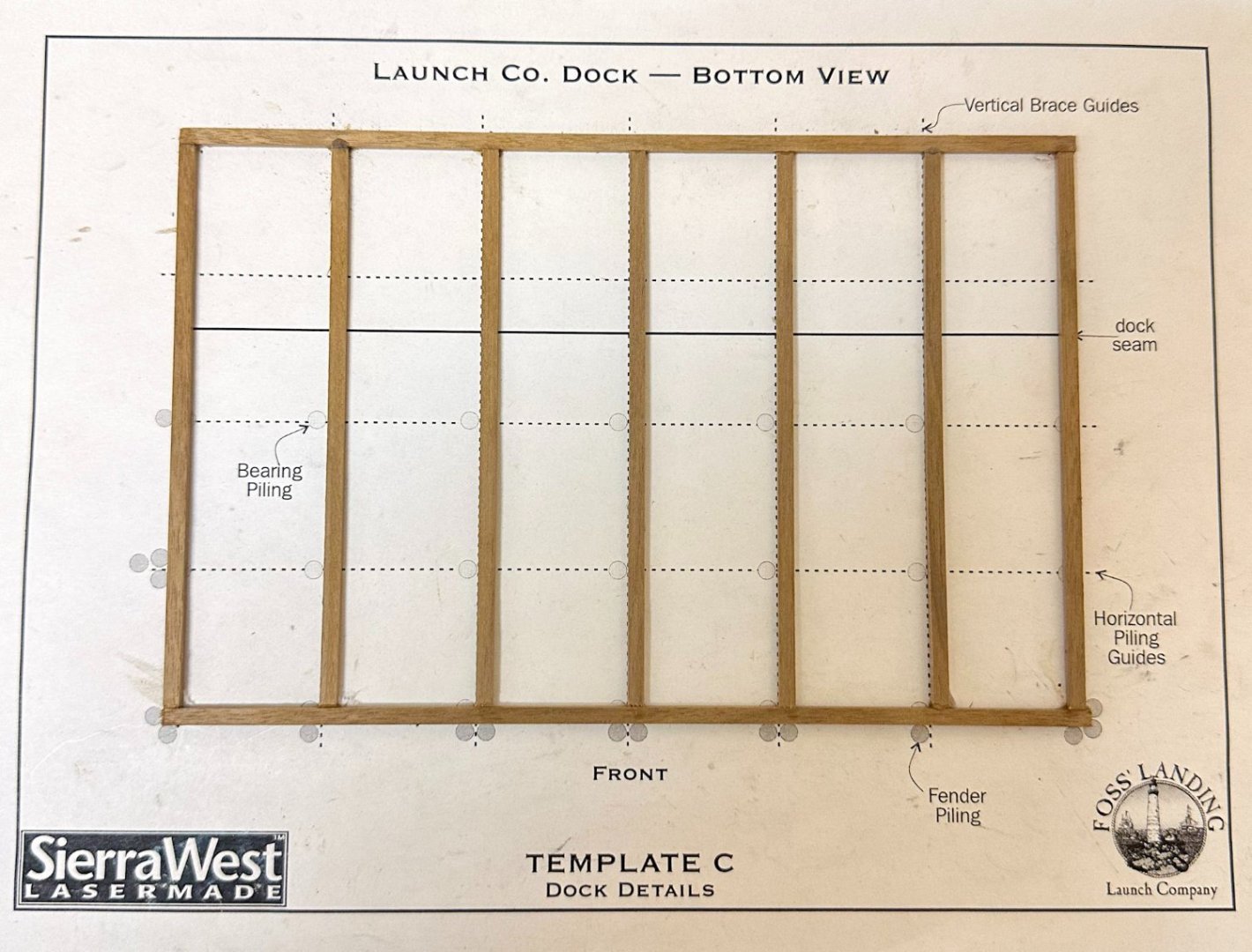
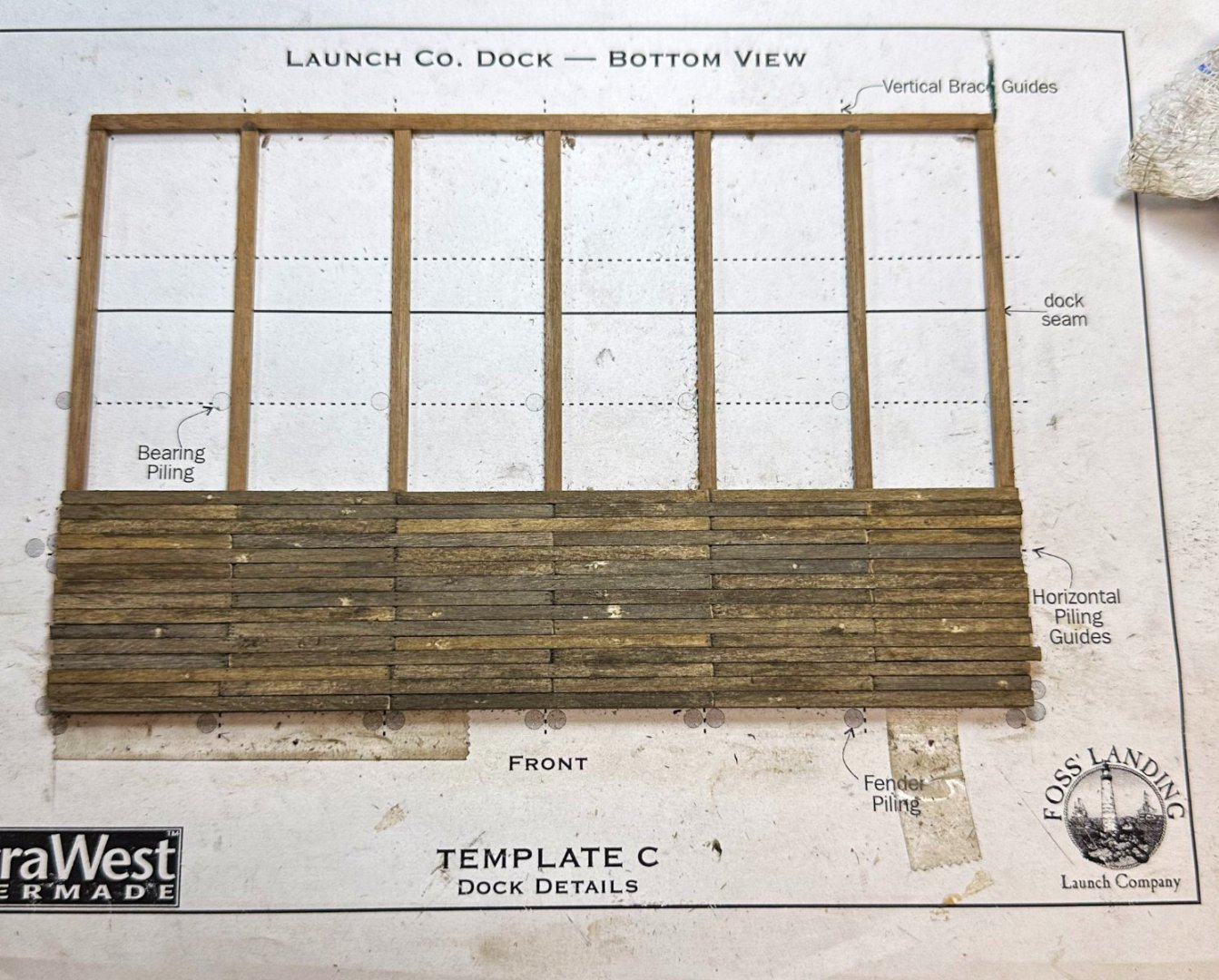
The boards are not yet completely finished with the weathering process. This will be done when all are in place. If I like the result, I may do the Oyster Co dock in a similar fashion. Here's what The Oyster Co building and dock look like now.
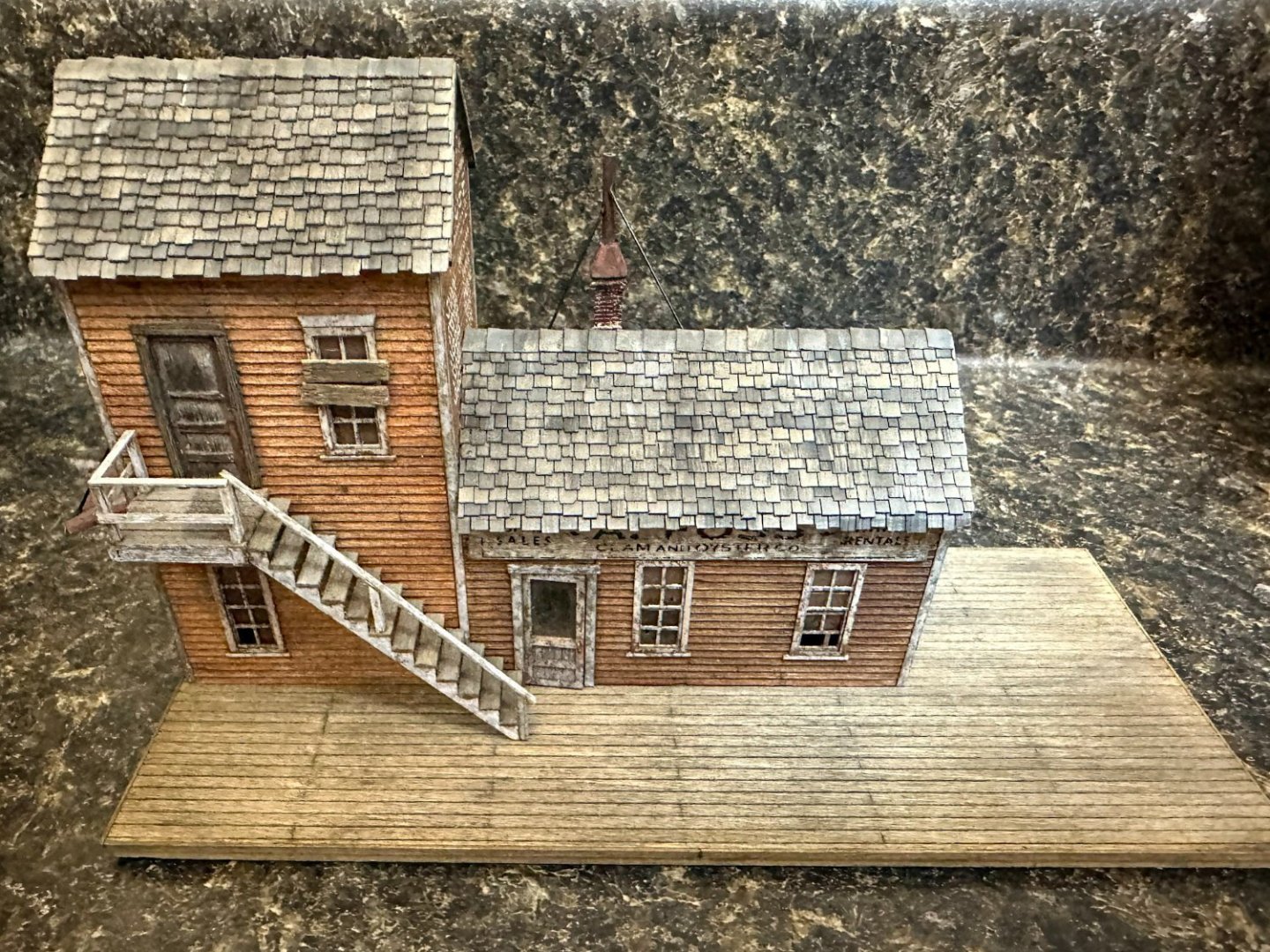
Concurrent with building the dock, I have been working on the rowboat shed. I'll post those pictures in my next update as well as the completed Launch Co dock.Jeff
- Canute, gjdale, FriedClams and 3 others
-
 6
6
-
Greetings!
Time to do the roof for the Launch Co. The shingles are similar to those of the Oyster Co thought they are given a green base and black, grey, off white are used to give the variation. The roof comes in 2 parts: the main section has the peak running the length of the building and is glued to the middle and right walls; there are 2 "wings" that are glued to the front and back walls.
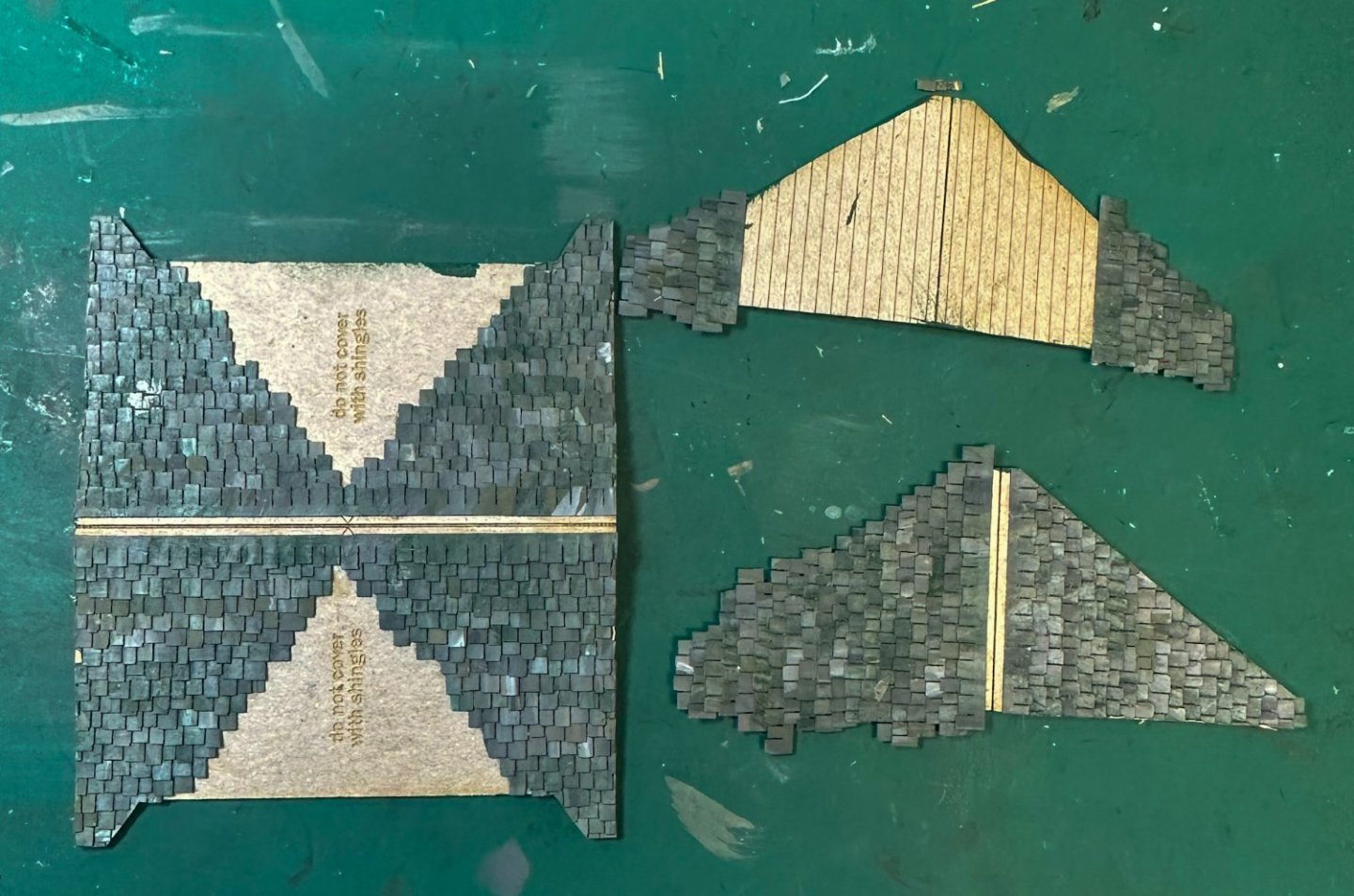
The process of laying the shingles down is the same as the Oyster Co except there are areas on the main roof that are left bare as they will be covered by the wings. Here is the roof with all sections shingled and glued on.
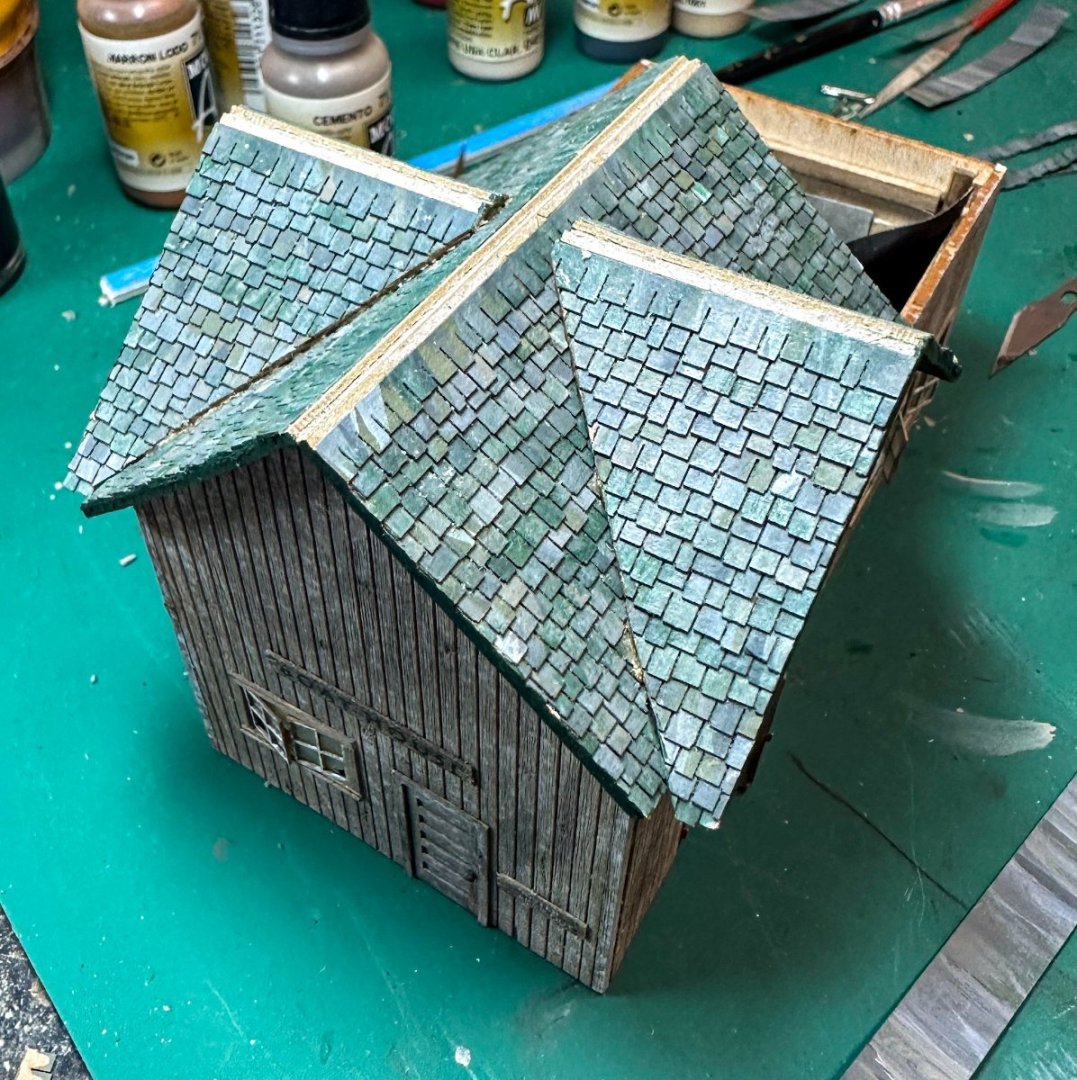
Next, the shingles need to be placed on the valleys. Instructions call for a single long strip that comes from the sheet the shingles were on. I chose to cut small shingles and apply individually. I think it gives a better look.
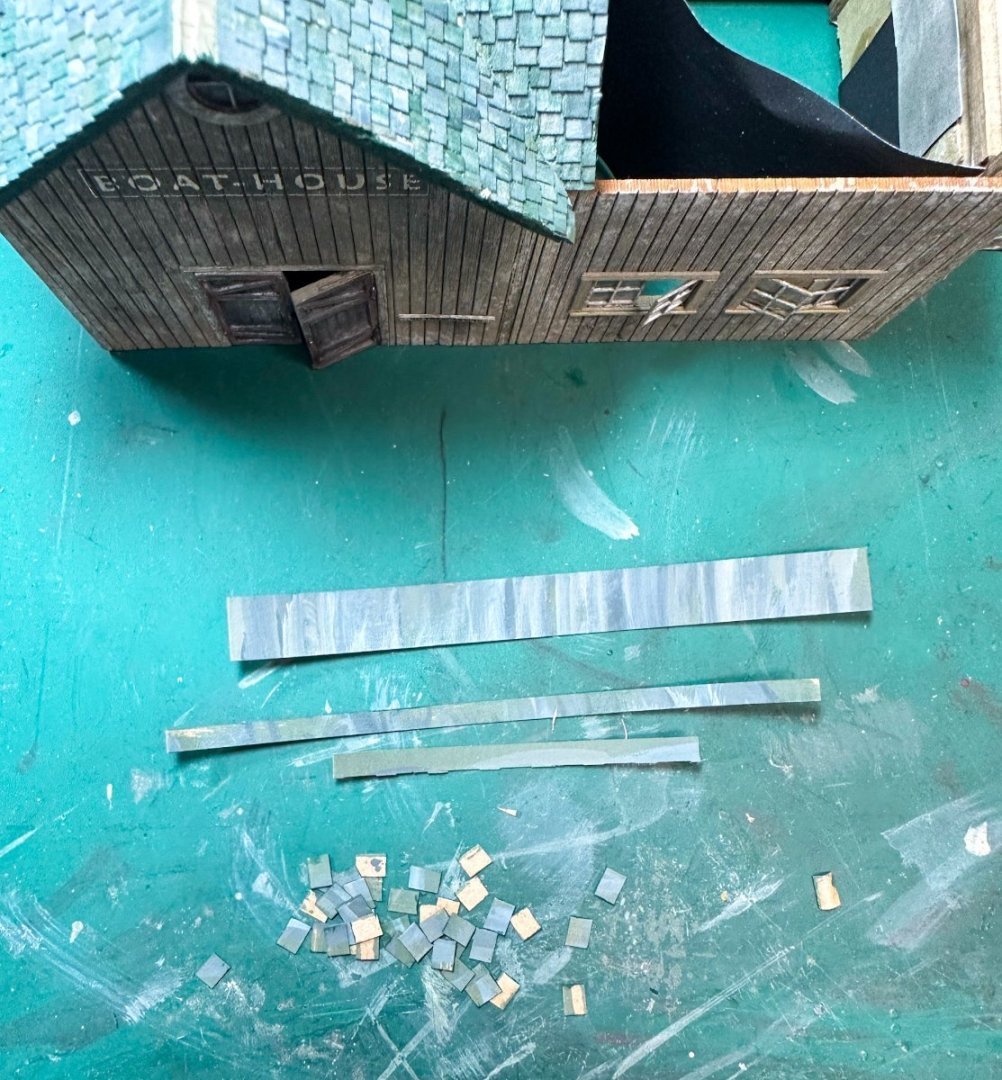
The peaks were done in the same fashion. Final result:
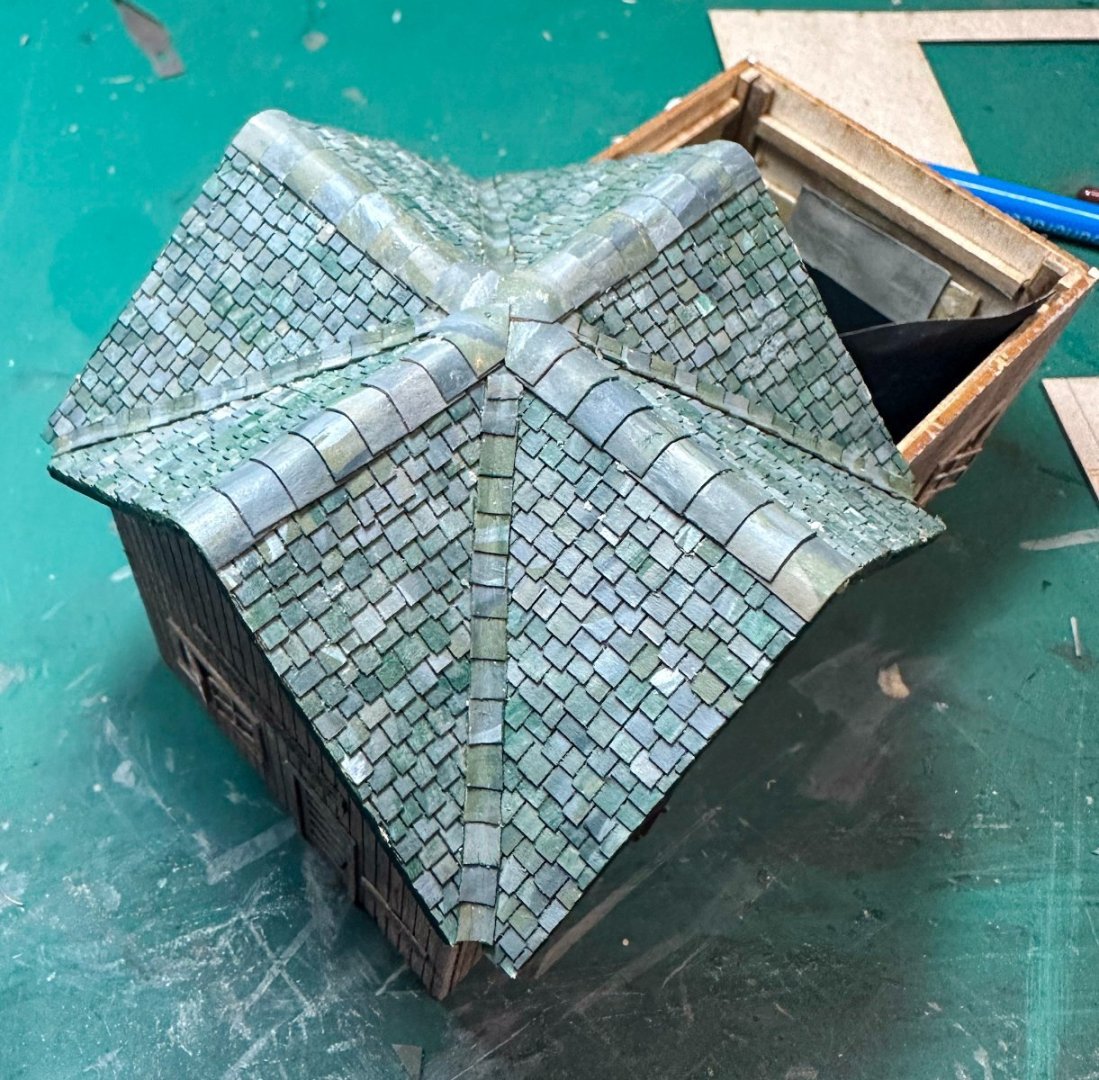
The flat roof comes next. This will be covered in tarpaper. A problem I noted was the width was too short.
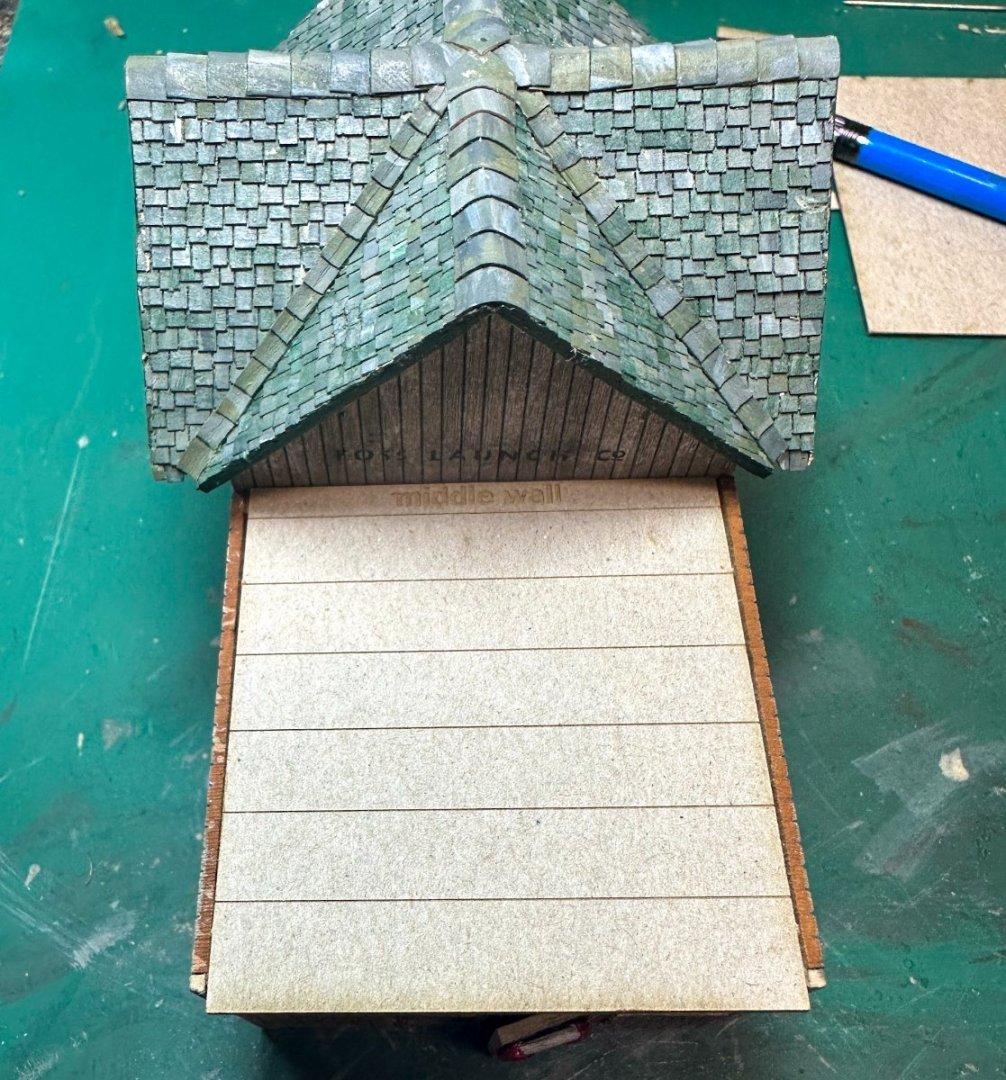
This was an easy fix - 1.5 mm wood plank was glued to each side to make up the difference. The "tarpaper" is applied much like the canvas awning on the Oyster Co. I went with a more traditional tarred roof that has been significantly faded by the sun. I also added a few patches to cover "leaks." Once the roof is glued on, a small stove pipe is added to the rear low wall and a finial is added to the peak of the green roof. A few more finishing touches of dirt and grime were added to the roof as well as some rundown from the stovepipe and finial to complete the structure. A few white blotches of "bird poop" were added to the green roof as well.
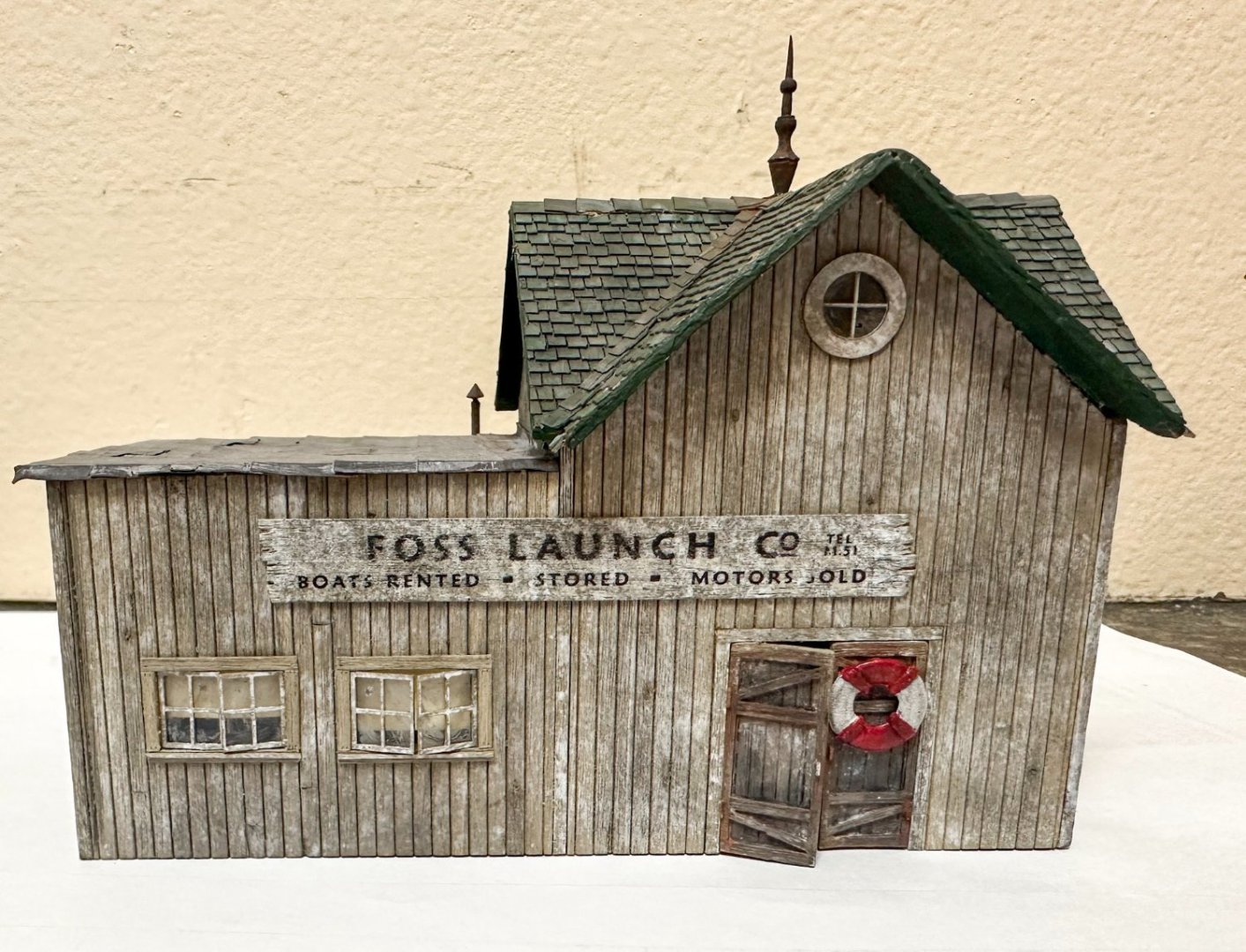
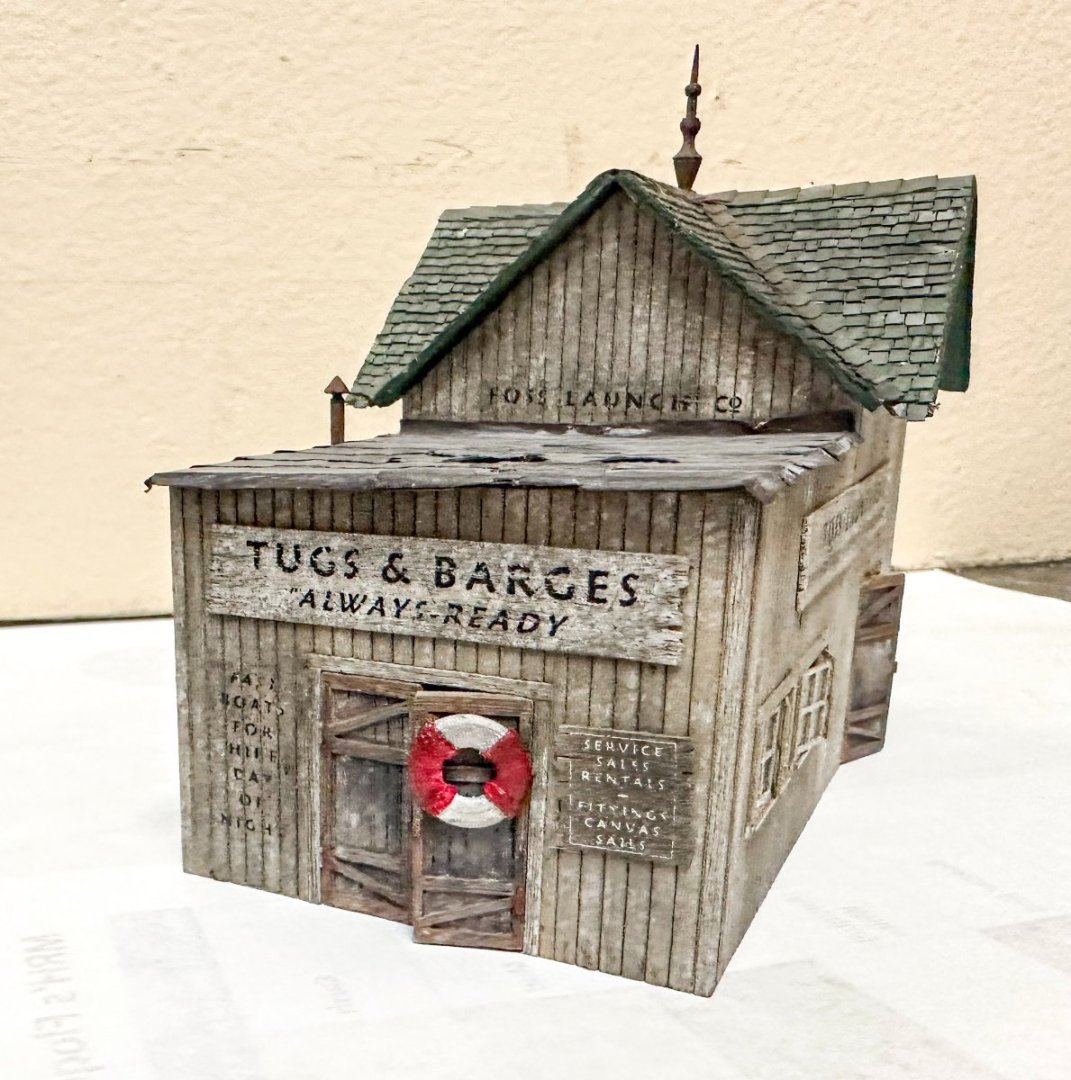
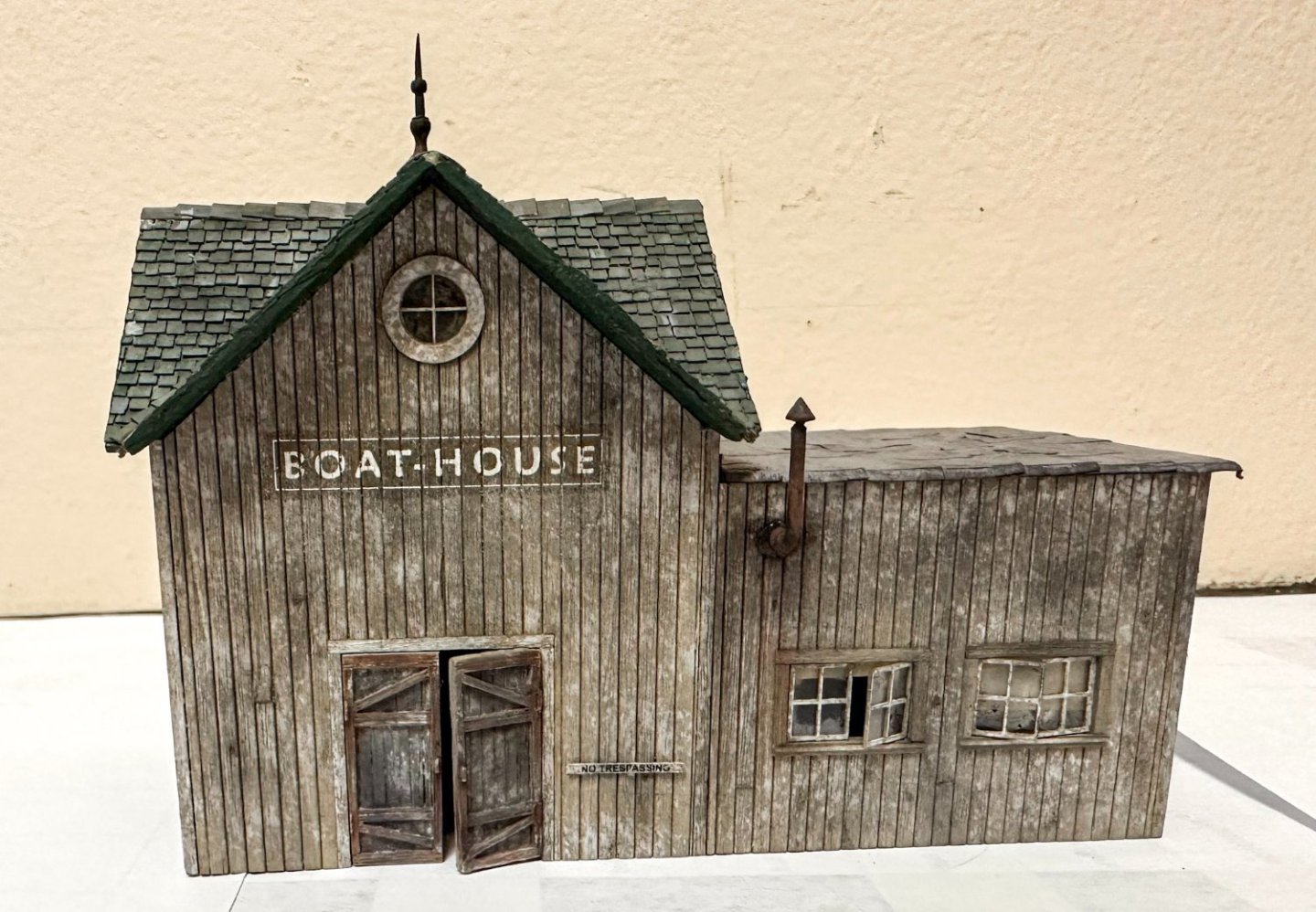

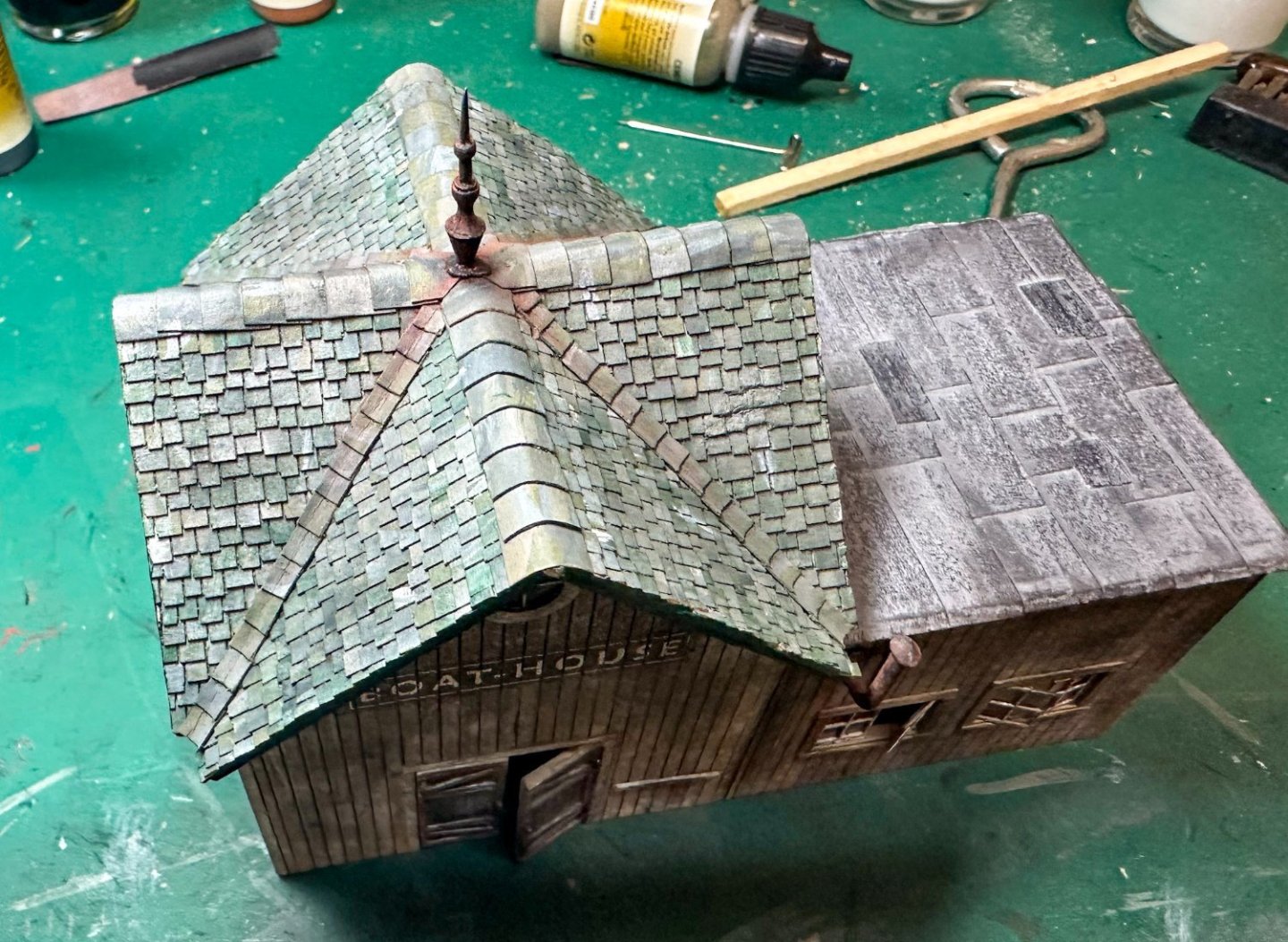
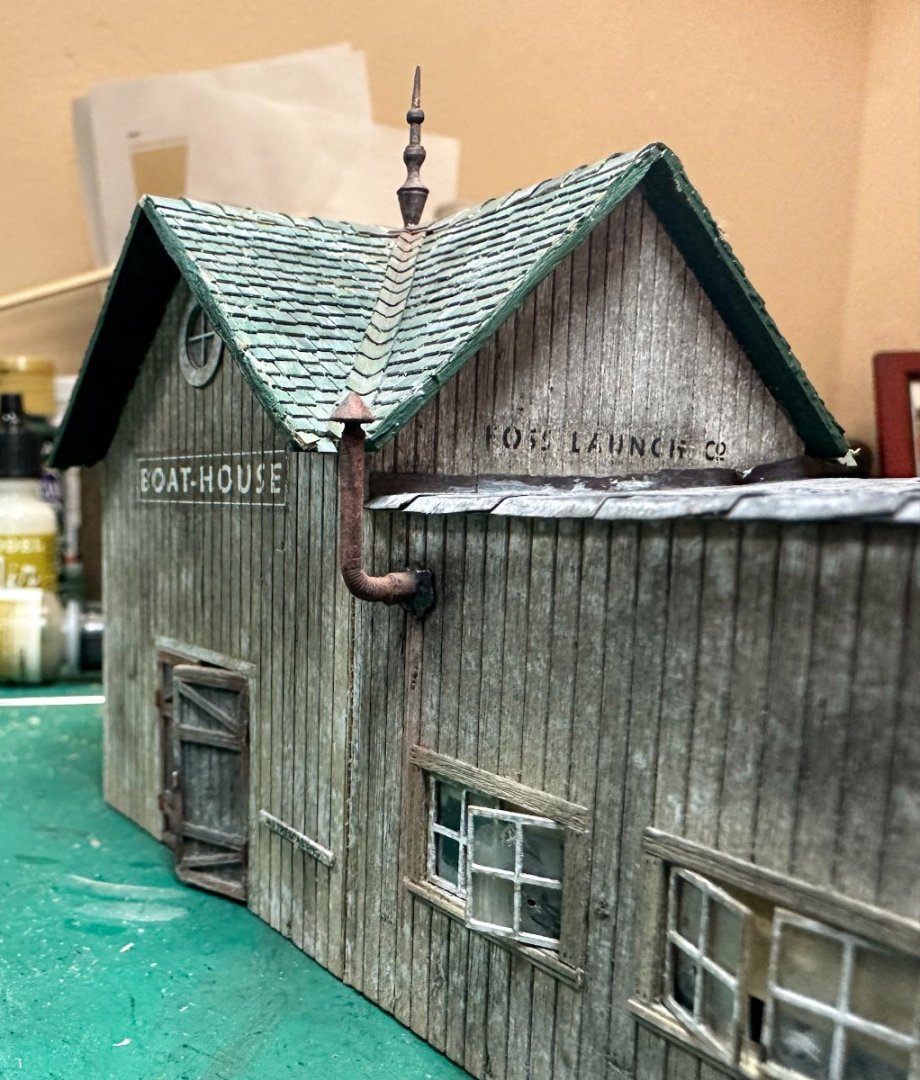
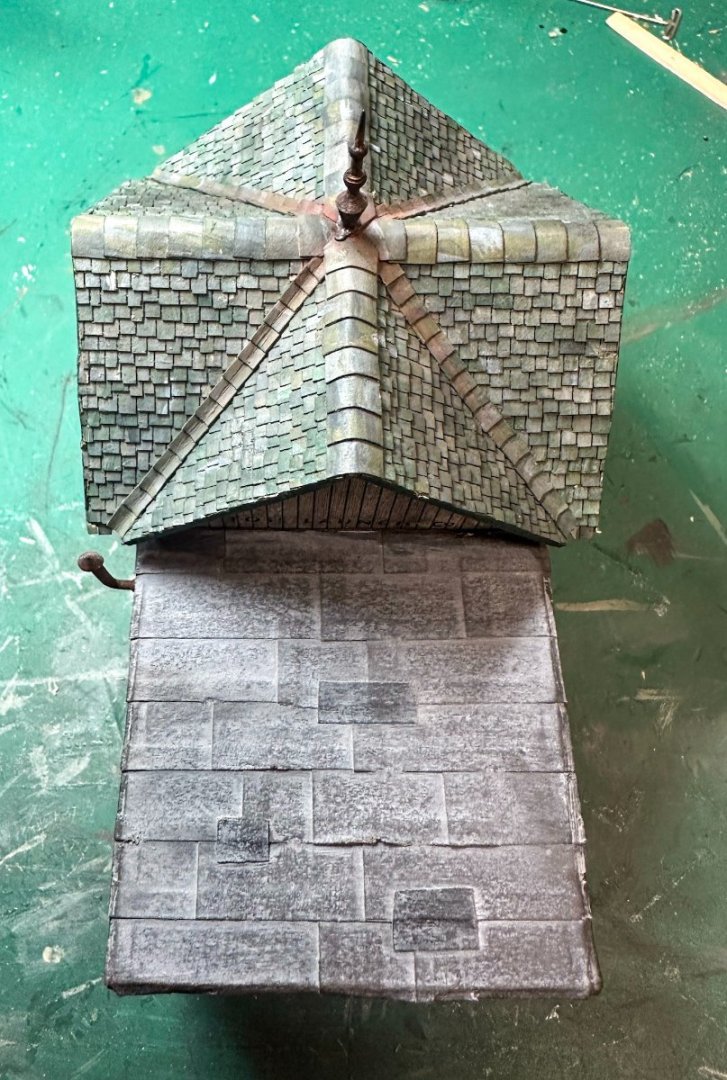
The large dock for the Launch Co is next.
Jeff- hof00, gjdale, king derelict and 9 others
-
 12
12
-
Greetings!
Constructions resumes after a 2-week trip to Japan. After the Clam and Oyster Co building is complete, the basic wharf deck it sits on is constructed. The wharf is a single piece that is laser cut to simulate planks. two different sized planks are used to trim the edges (wire brushed and stained first). A template is provided to locate the center lines of the future pilings and the wharf braces. once the braces are glued, the underside is painted green and the topside is weathered. Instructions called for Floquil concrete - i used a variety of chalks and some AI. Here is a photo of the Clam and Oyster Co on the dock.
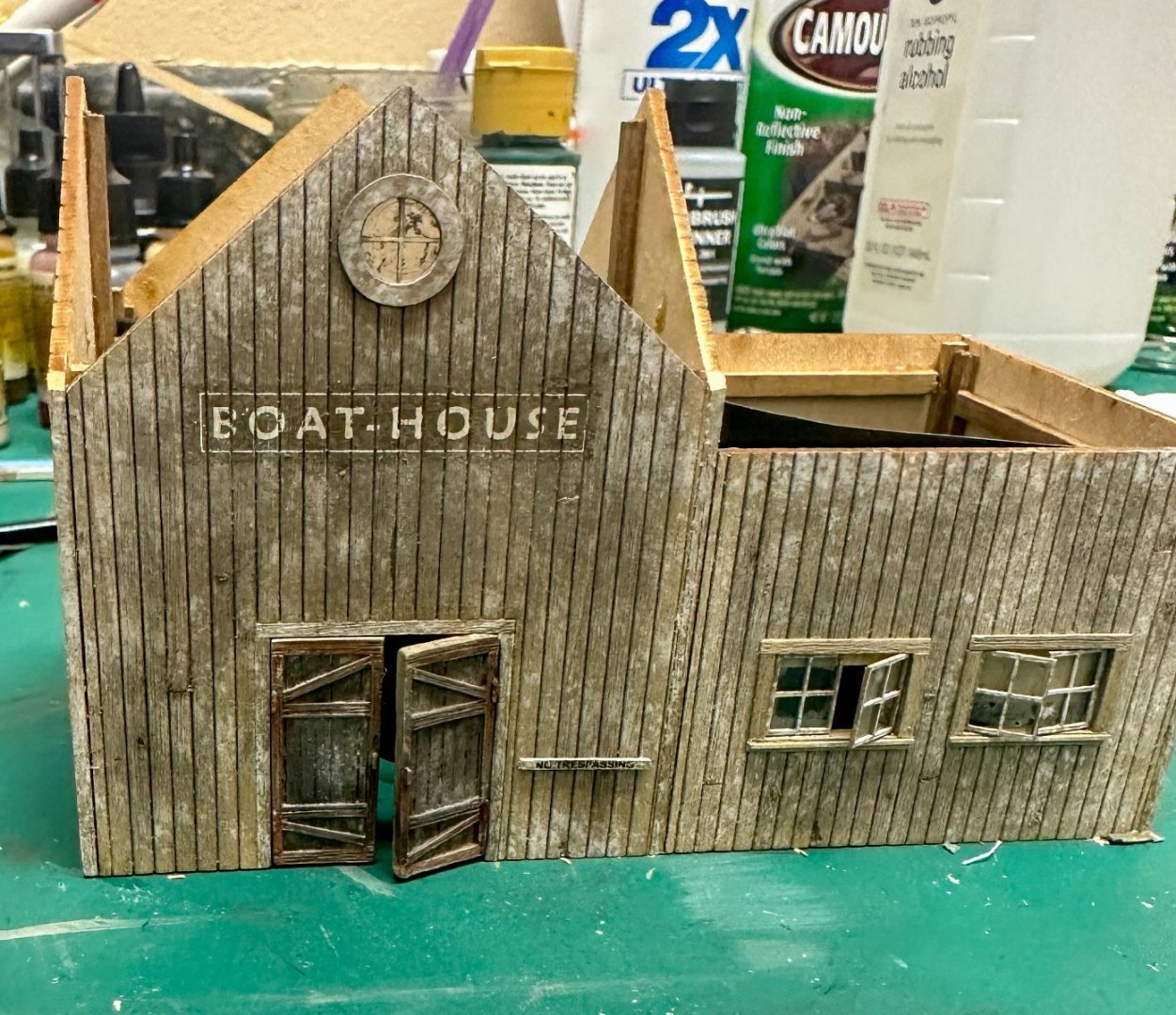
Next is the diorama base. As I am combining 2 kits this will be left for later as I plan to complete all the buildings and other structures first.
So onto the Foss Launch Co. First up is some advance prep such as was described with the previous building. No need to repeat that. The siding on this building is vertical vs horizontal as on the Oyster Co. These were detailed in a similar fashion. One interesting note is that no internal bracing was described for these walls so I decided to make some with leftover strip wood from prior ship models. These must be carefully placed so the wall will go together seamlessly when the trim is added to the edges of several of the walls. Here is the final result of the bracing:
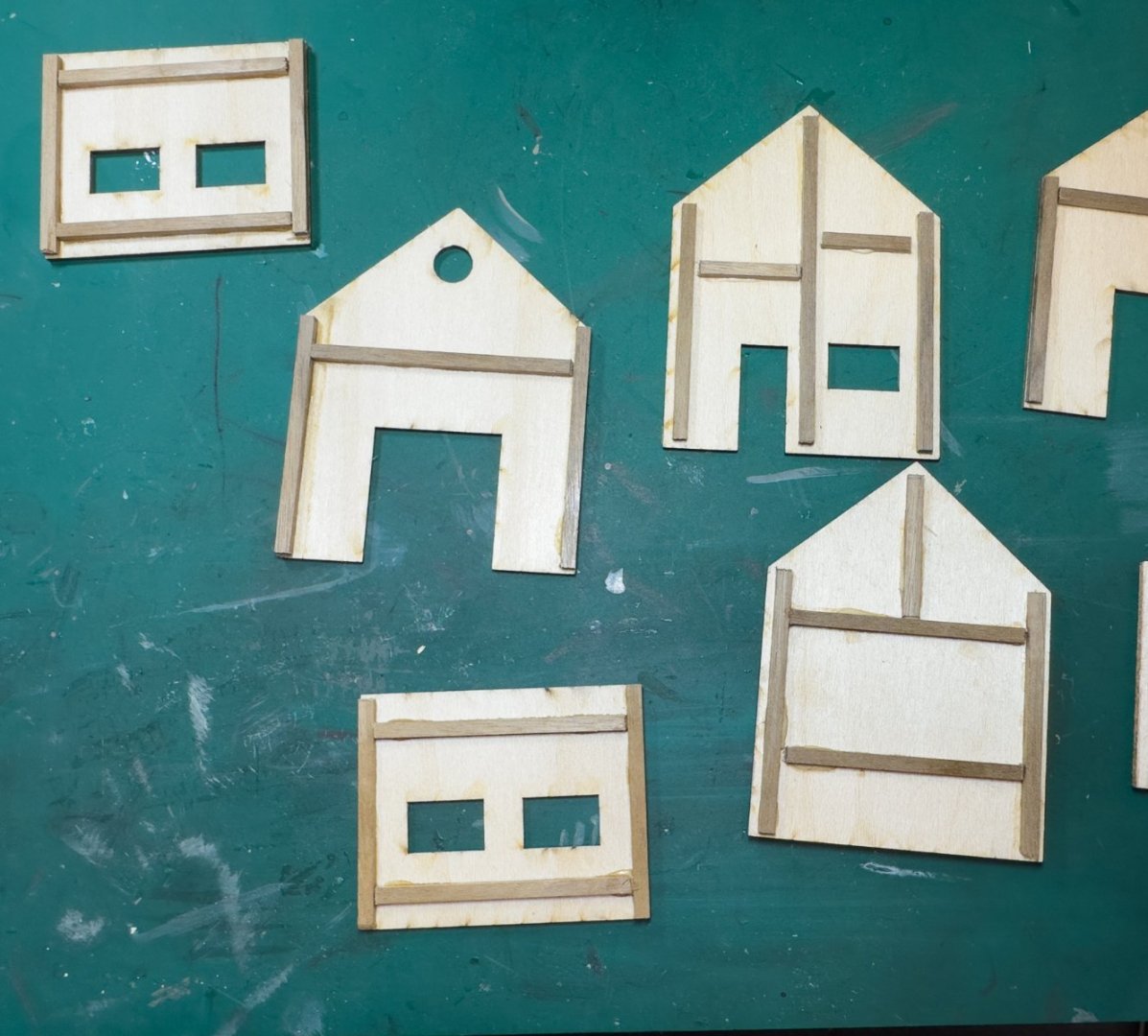
The walls are then weathered and I added some random knots. Again, rather than using paint, I used a variety of chalks and AI followed by a very light amount of white to simulate old white paint mostly weathered away to get to this:
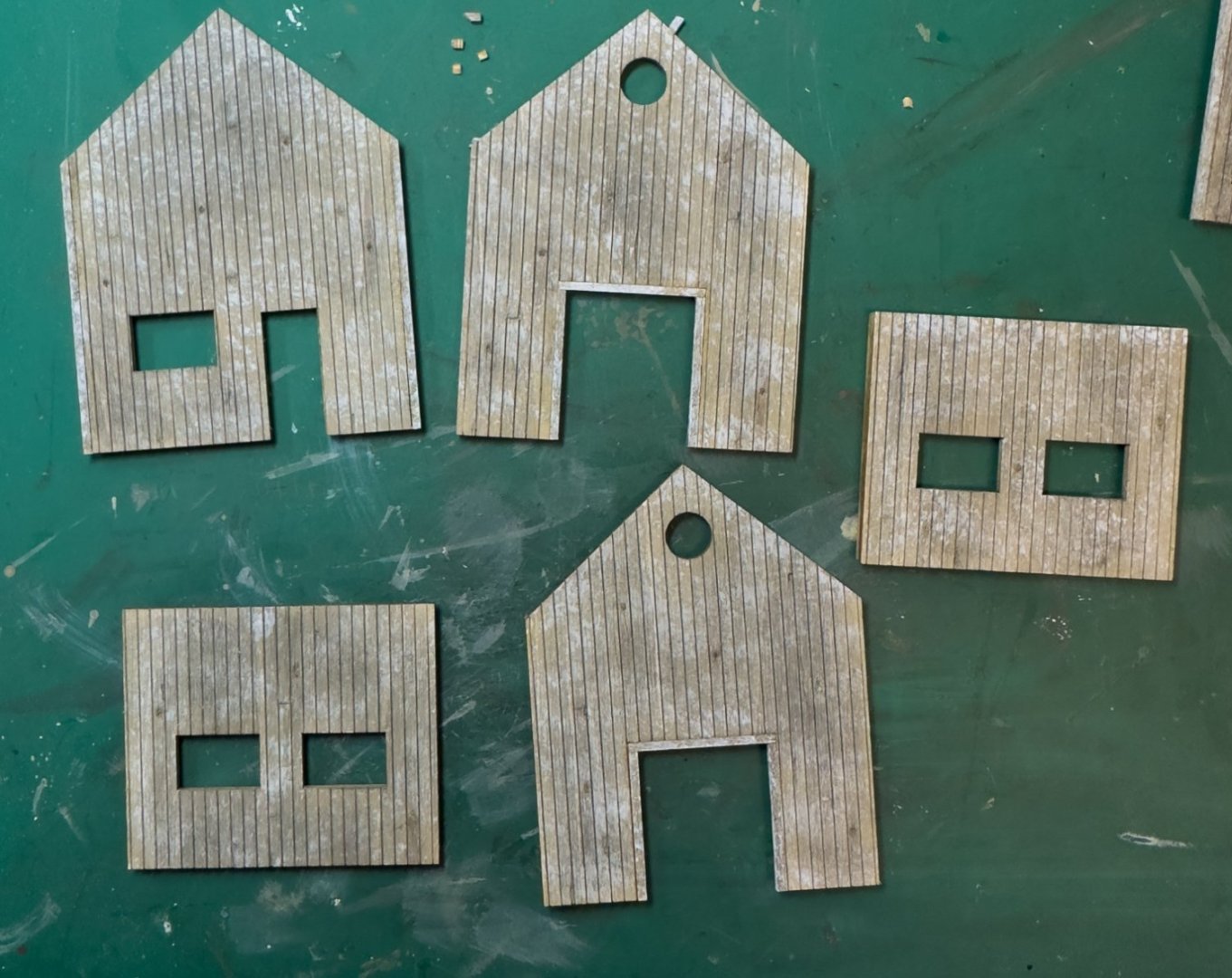
Some trim can be seen lining the freight doors. After the walls are trimmed, the signing is done more dry rub decals. I was worried about this given the age of the decals and difficulty with some of them on the Oyster Co. After doing some research, I decided to give Elmer’s spray adhesive a try as I was not entirely satisfied with the double-sided tape described earlier. I think with larger signs the tape would be quite visible. I first tried this on a small "posted Keep Out" decal. These small decals from the Oyster Co building did not work with a variety of methods I tried earlier and there are plenty more of these small decals. Here is the result:
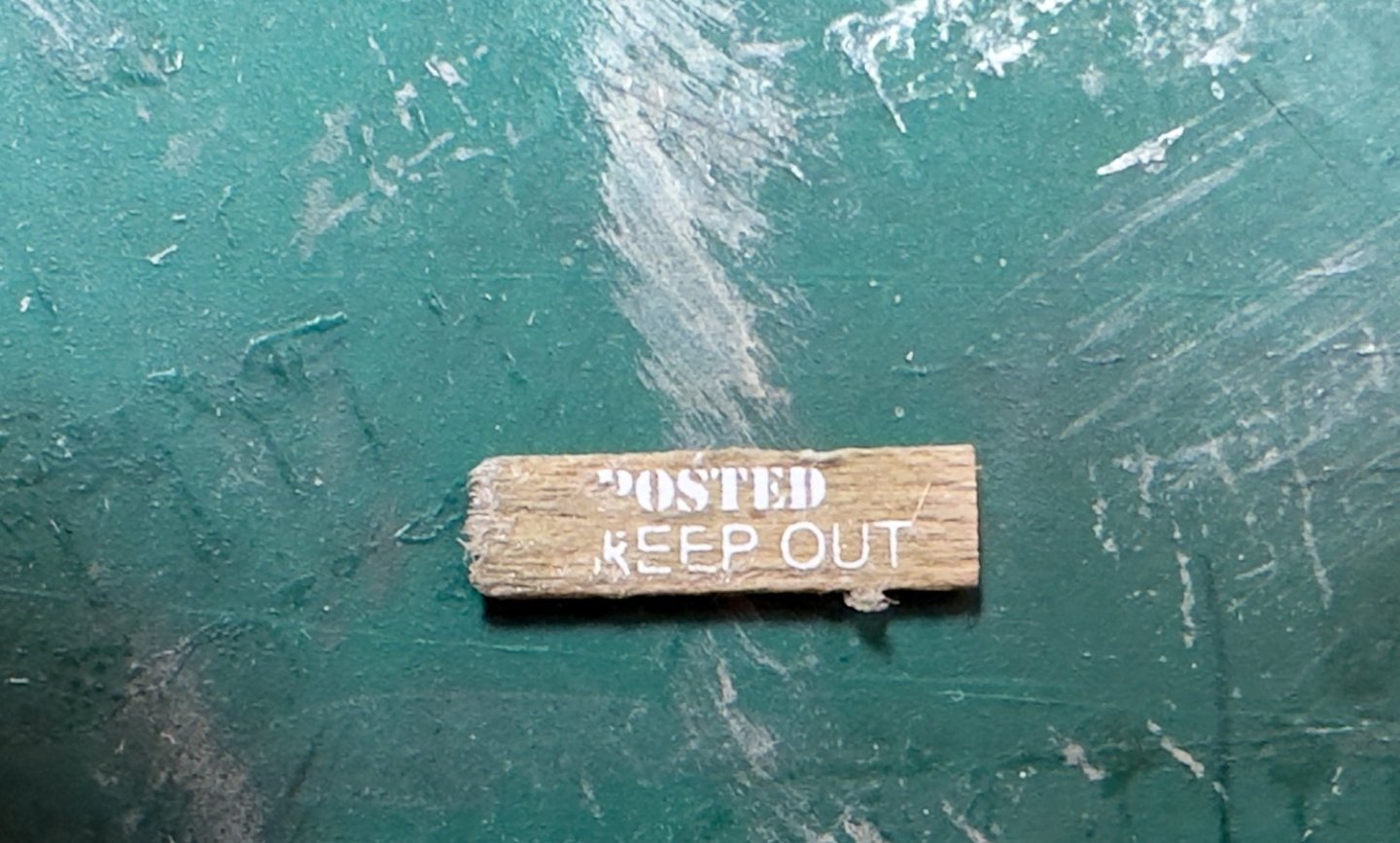
Pretty good so far. Time to try it on a bigger sign: The "Foss Launch Co" and the "Tugs & Barges" sign. Each required several pieces of strip wood to be glued together then some stippled white. The area where the spray adhesive was to be applied was taped off.
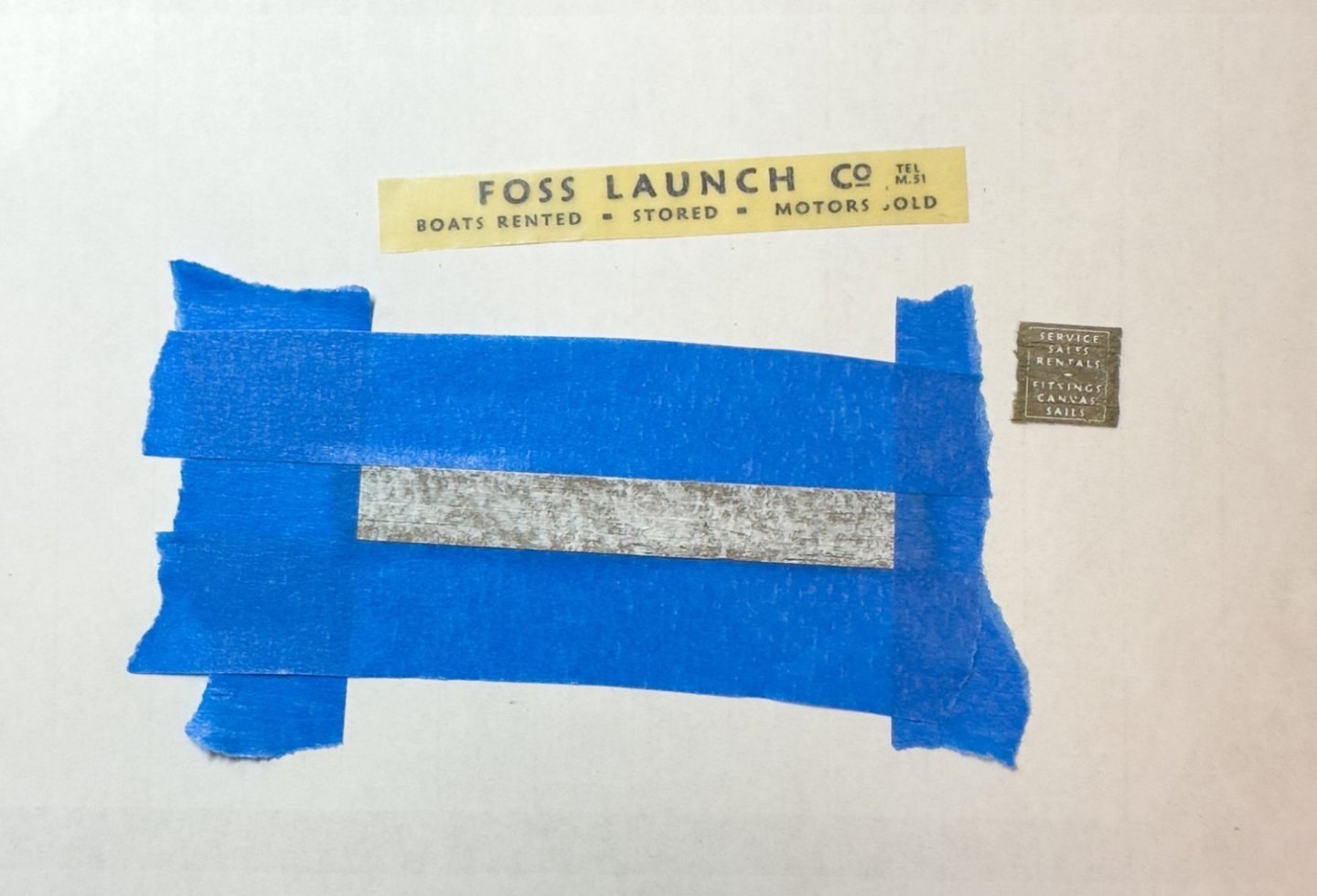
A light coat of the adhesive is all that is needed. The decal was then burnished onto the wood and ...
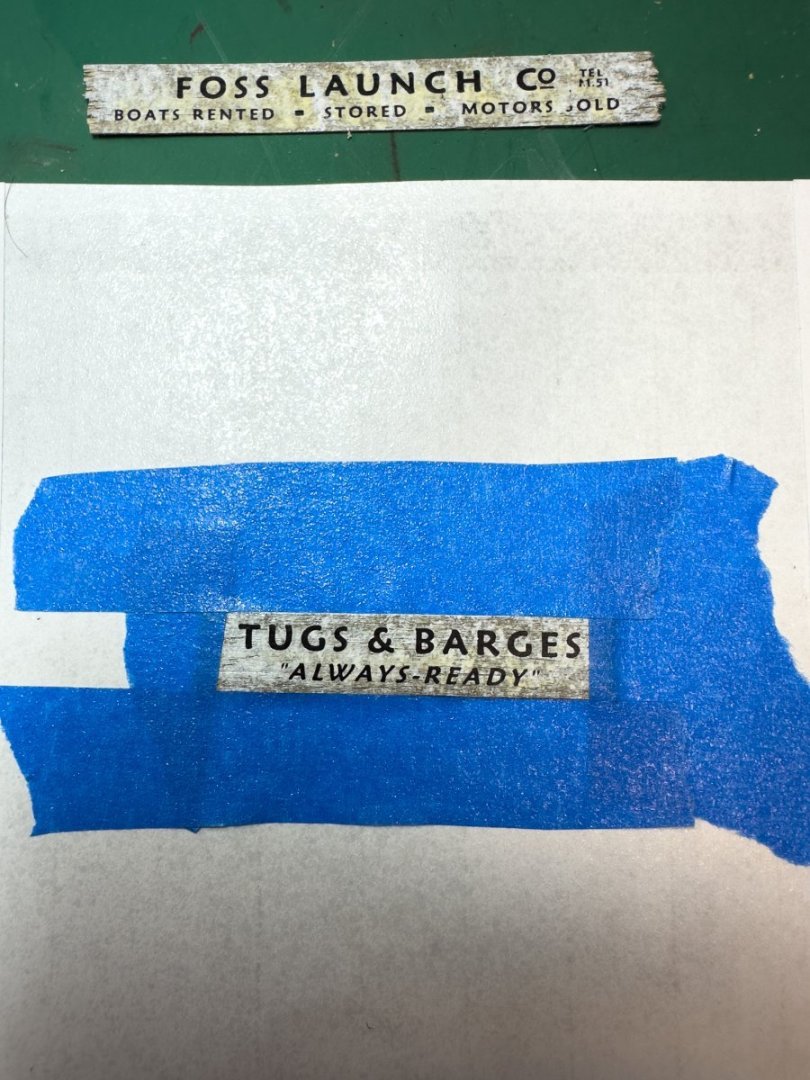
A slight amount of yellowing on the Launch Co sign, I believe, is from the decal paper. I was able to tone it down with a light brushing and some chalk. So how does this method work if the signs are placed directly on the building? The "fast boats for hire" sign goes to the left of the freight door. the entire wall was taped off except for the amount needed for the sign.
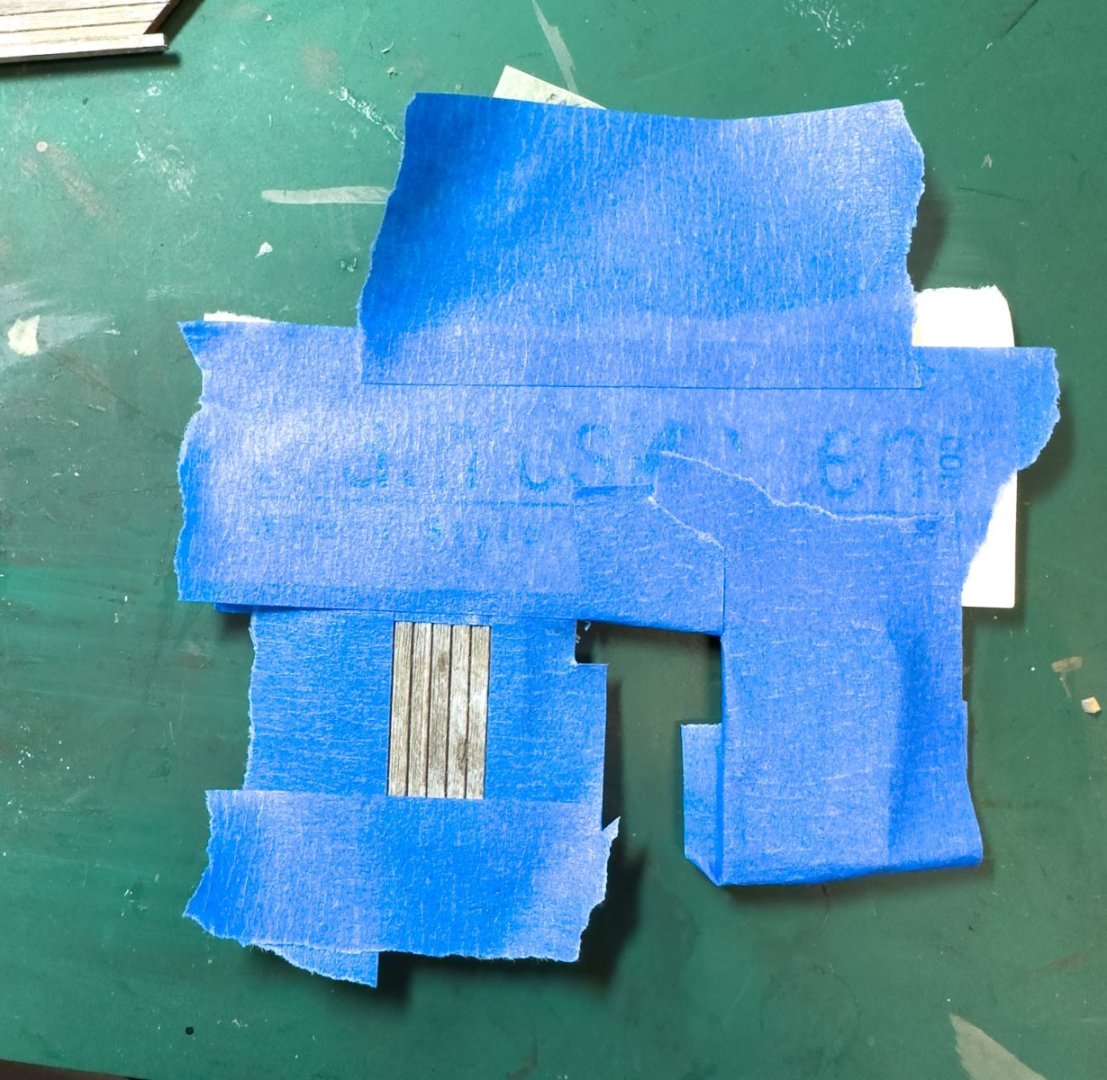
And the result:
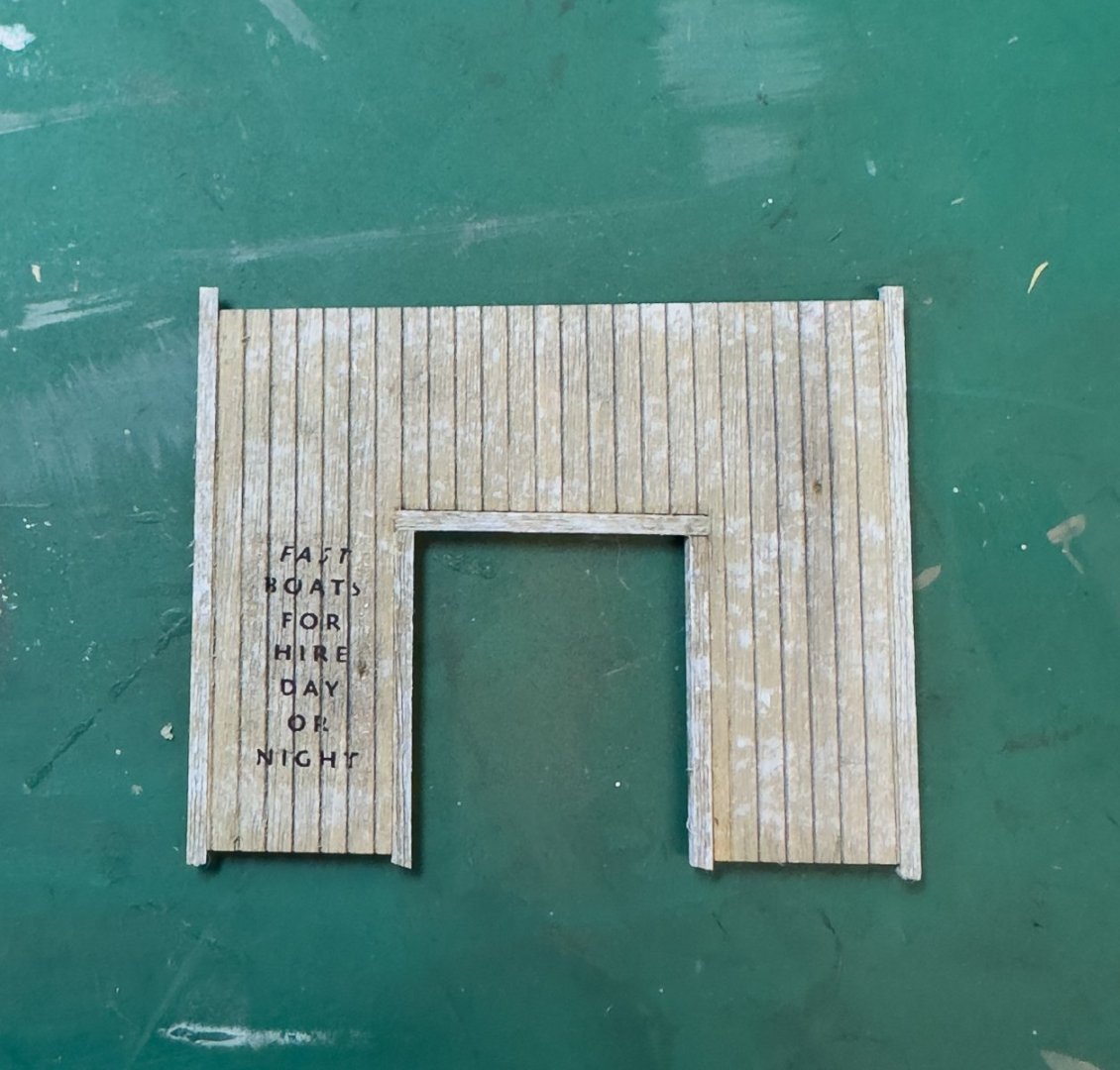
Wish I had this figured out before I ruined the Coke and Pepsi signs (sigh). One other sign goes on this wall, placed onto several boards glued together. Here is the completed left wall of the Launch Co:
Two more decal are placed directly on the walls. These can be seen on the photos below. The windows have also been placed. Construction is similar to the Oyster Co building. Some holes and cracks were placed and the windows dirtied up a bit.
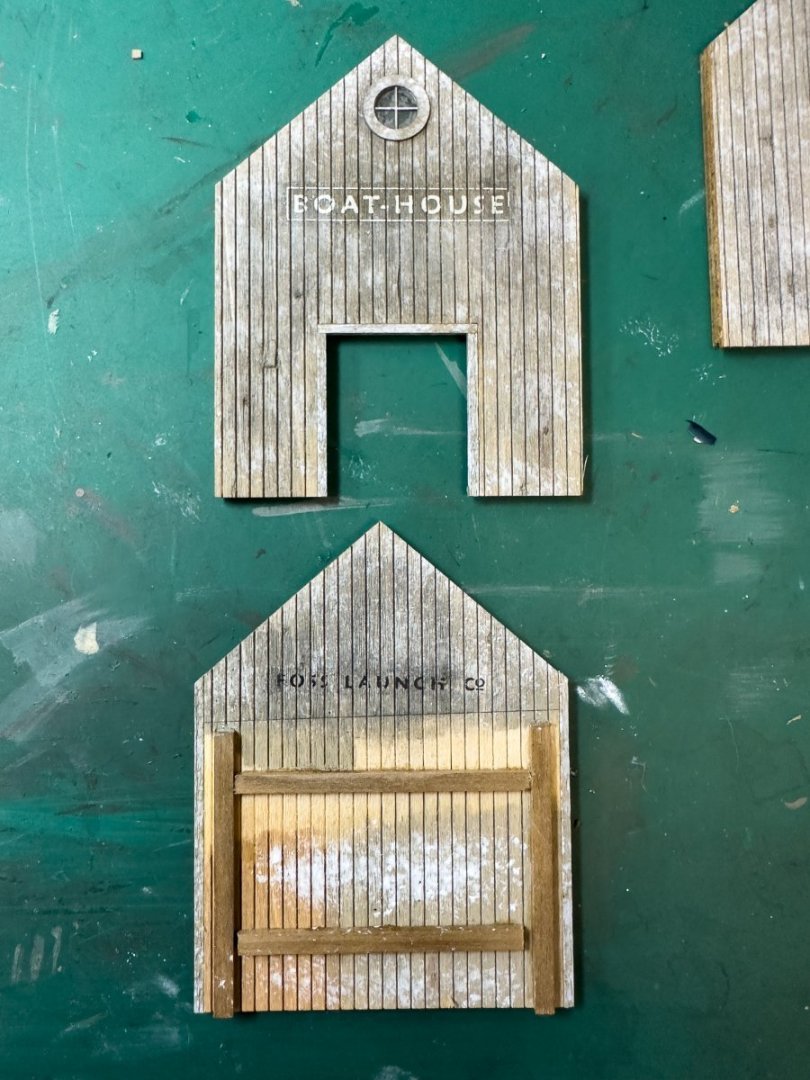
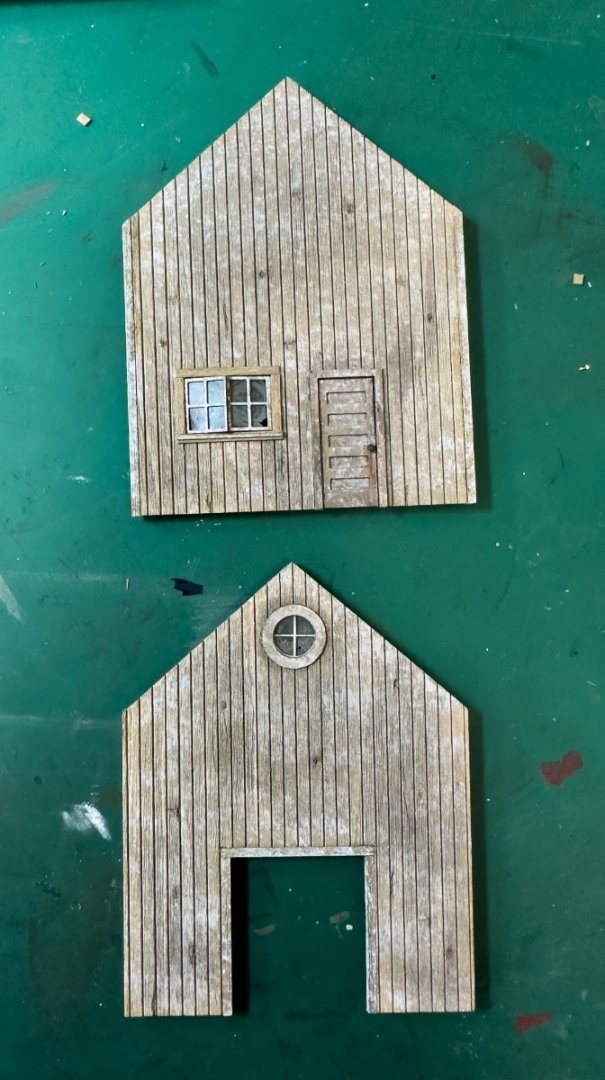
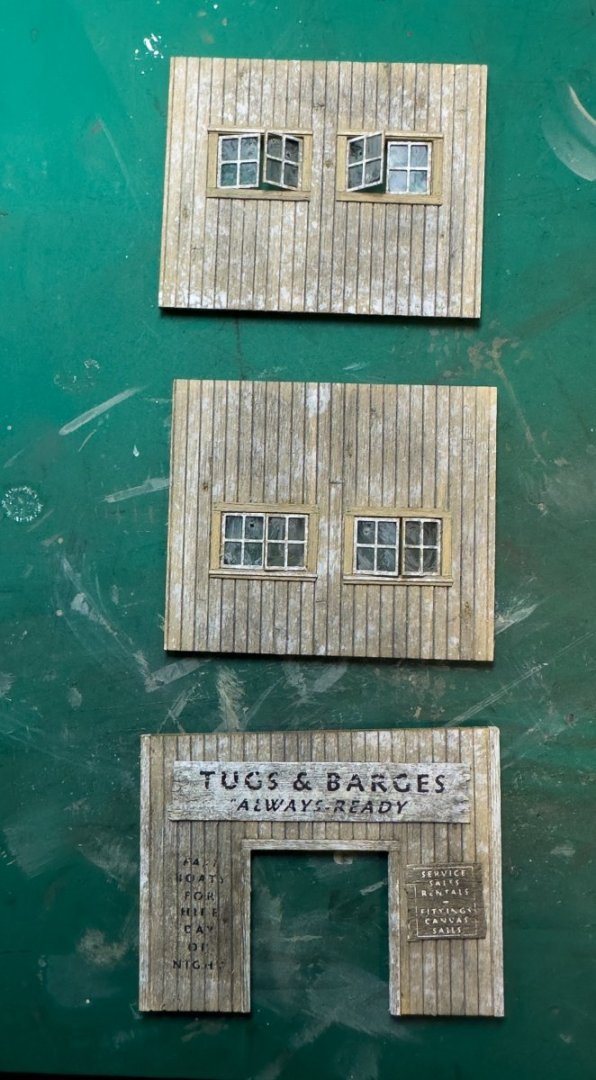
Next up were the doors - one regular door and six freight doors. The regular door has 2 pieces that come on the same sheet as the window. After prep, they are stuck together. I drilled a small hole and used a tiny nail to simulate a doorknob. It’s still a bit bright so I need to weather it a bit. The freight doors had a base tan color and then finished with a variety of chalks - raw umber, grey, black, brown, rust. Curiously, all the right doors were missing the lower hinge. This was easily rectified with a small bit of wire.
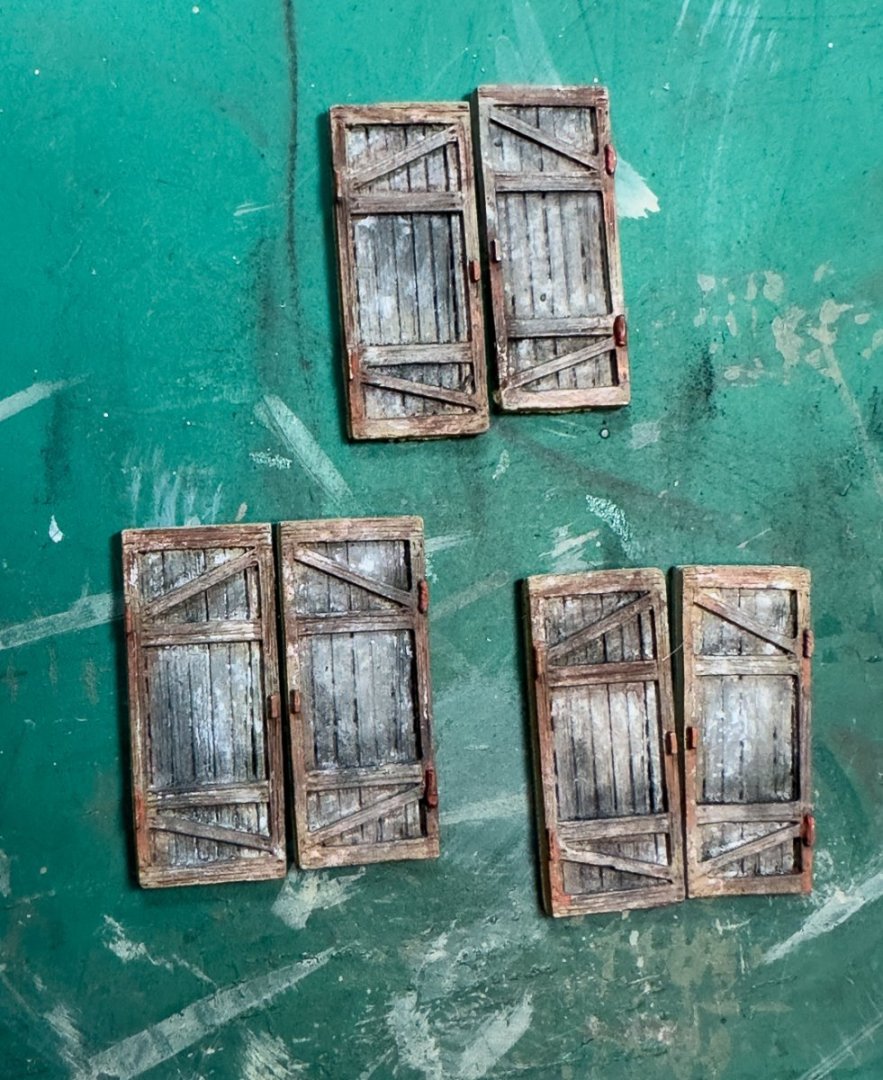
The doors were glued in place with 2 life preservers and the walls were then glued together, squaring them up as described before. Although not called for in the instructions, I decided to add some blinds to the windows. Rather than black I decided to go with a lighter color - the end result was a slightly dirty, streaky tan. Here are all 4 sides of the Foss launch Co. One issue is the subtle shading on the white Boat-House sign that is a remnant of the spray adhesive. More noticeable in the photos than real life. I am not quite sure how to tone that down without causing damage to the sign or even it it needs it. I think it turned out OK. Any comments / suggestions are, as always, appreciated.
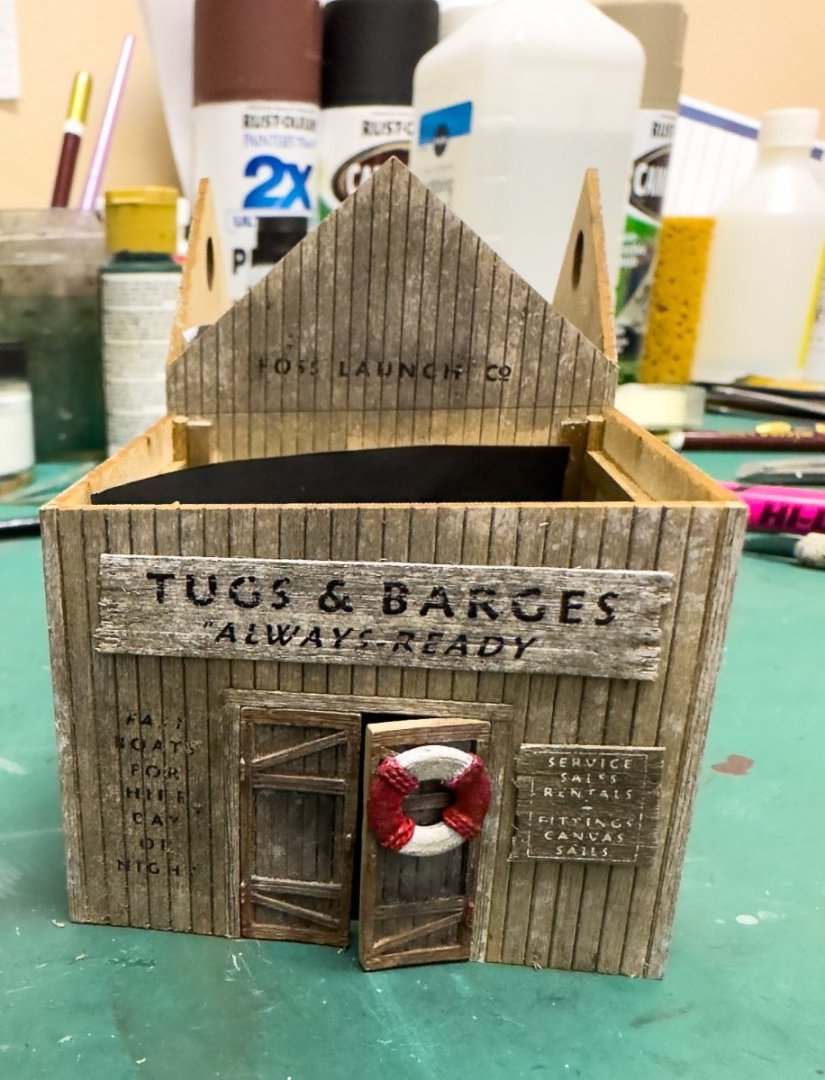
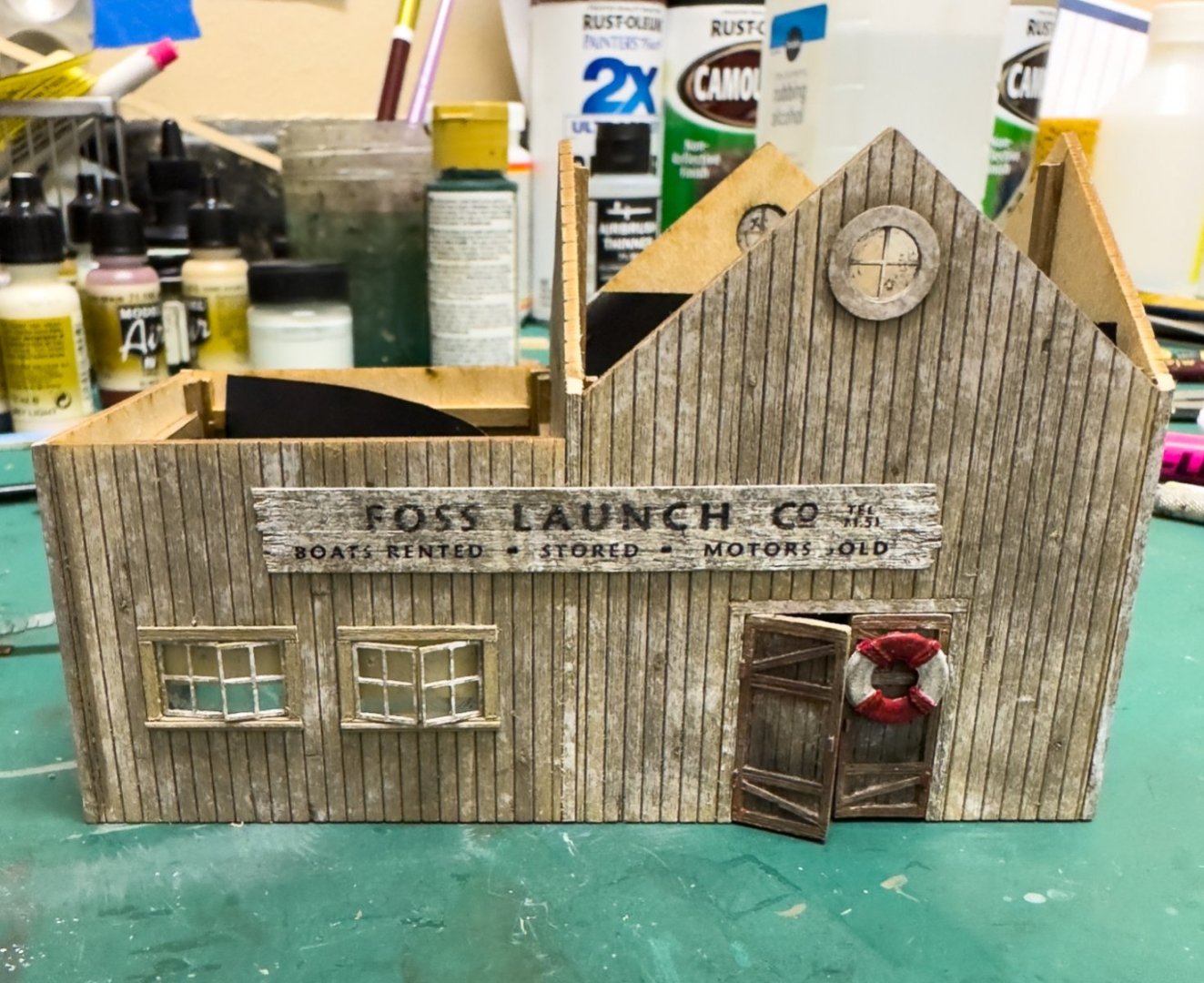
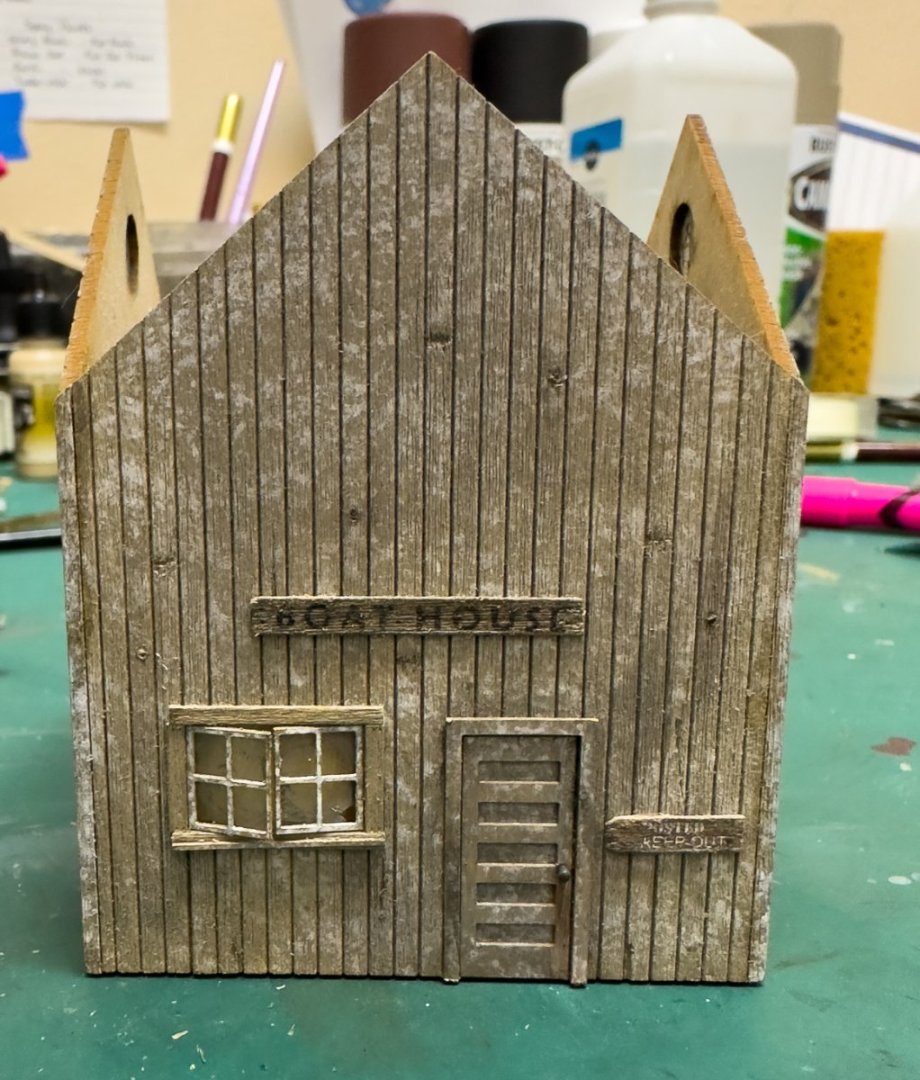
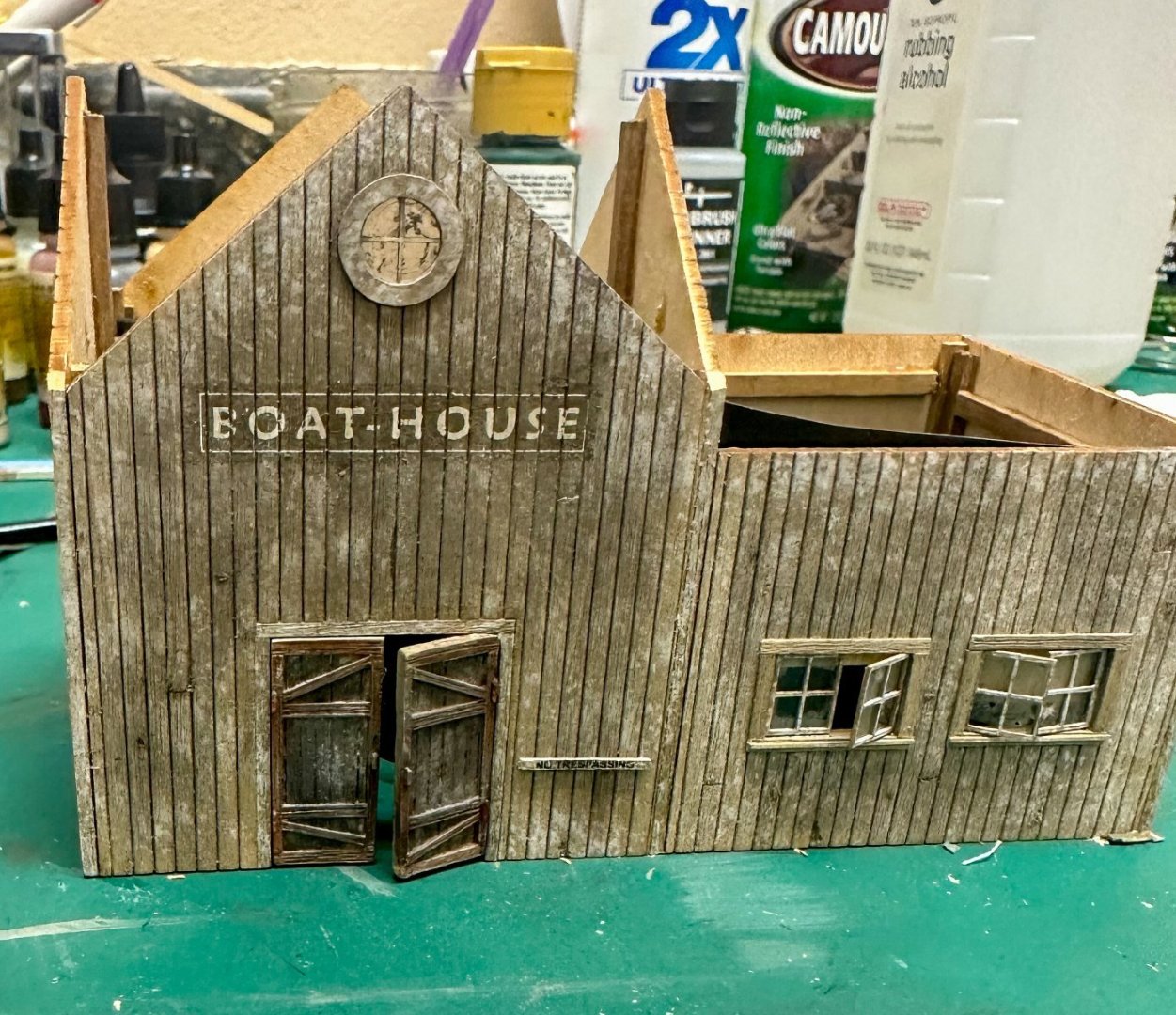
Next up, the roof.Jeff
-
Onto the roof. The simulated tiles / shingles were painted earlier and now are repainted with black and grey to produce a variety of shades. Here is one example:
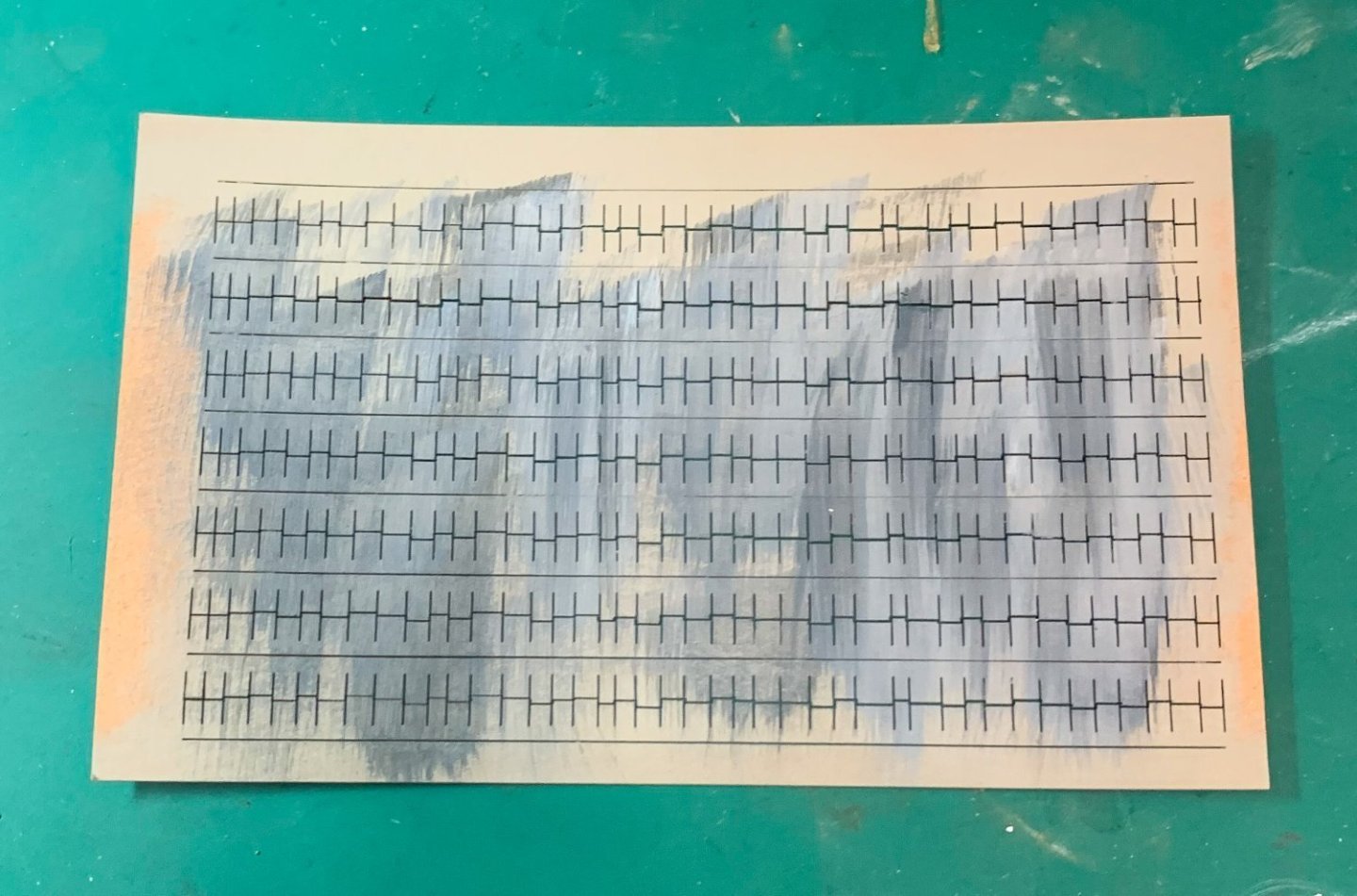
Next, the edges of the template and some of the bottom was painted green. The individual rows of shingles are cut from the sheet and applied to the thick cardboard template. Lines are drawn on the template to keep the rows lines up. Here are a few rows already glued...
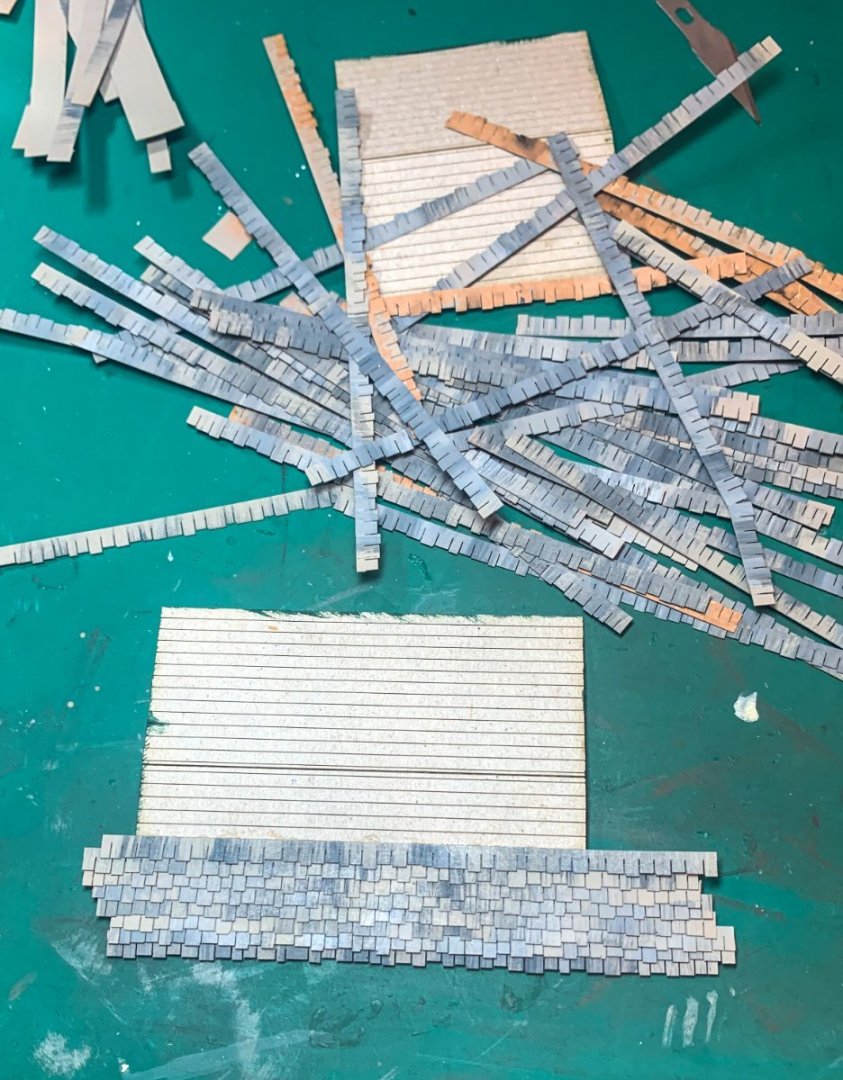
And here is one roof complete except for the cap shingles:
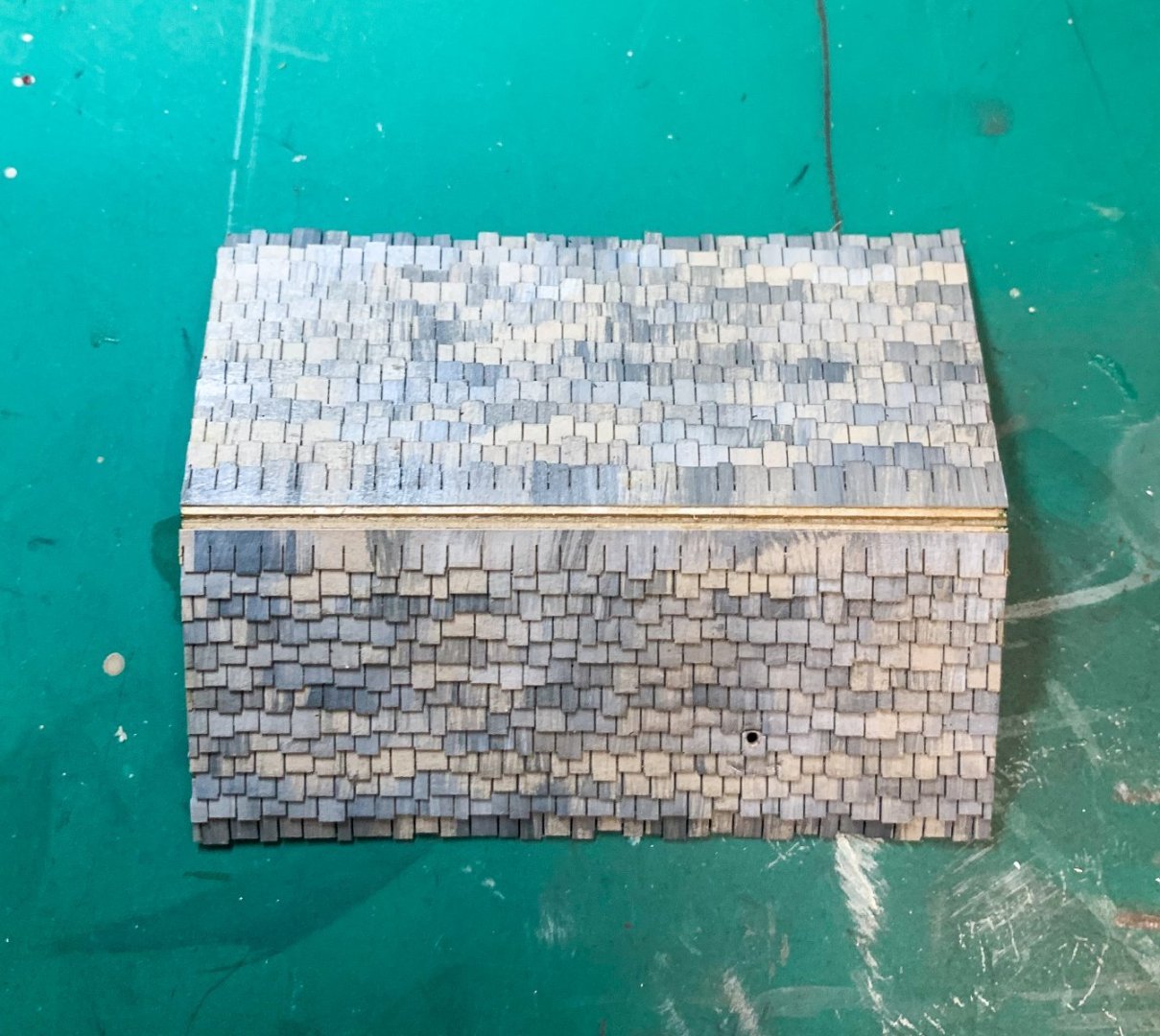
The hole is for the chimney. Rather than just glue the chimney to the angled rood, I drilled a 1 mm hole in the chimney (metal was fairly soft) and stuck a 1 mm brass wire in it. on the opposite site of the roof, I glued a small 1.5 mm plank to give more purchase for the brass wire...
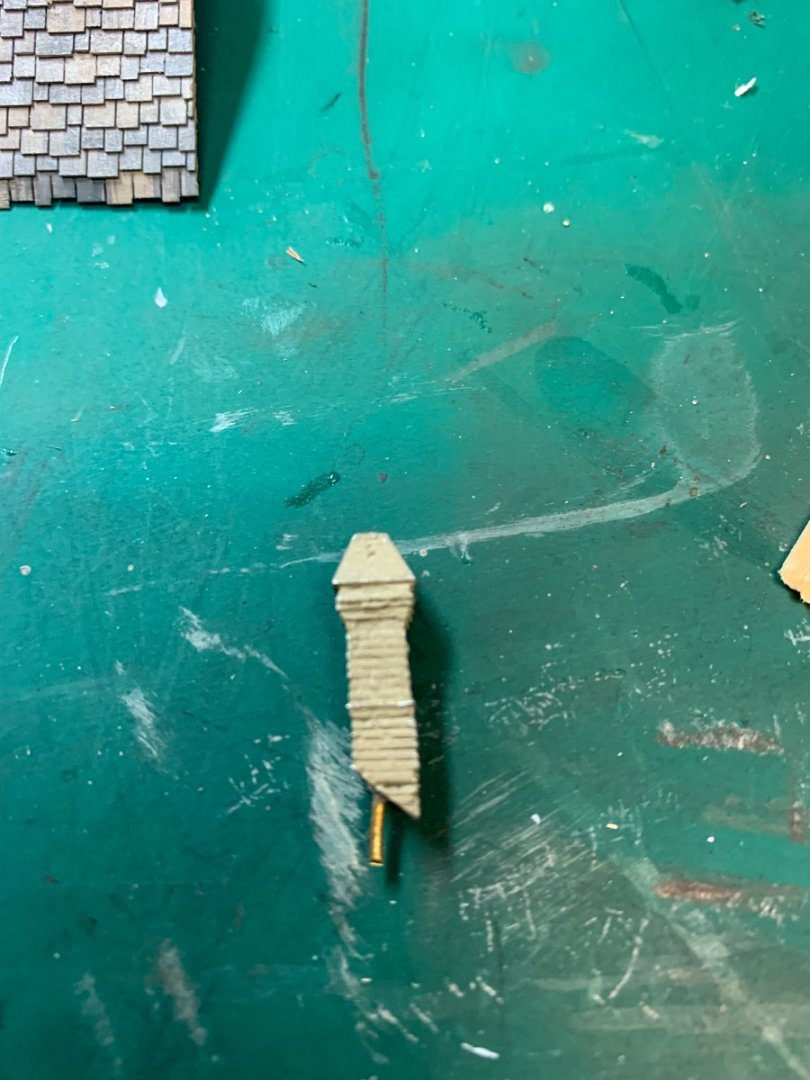
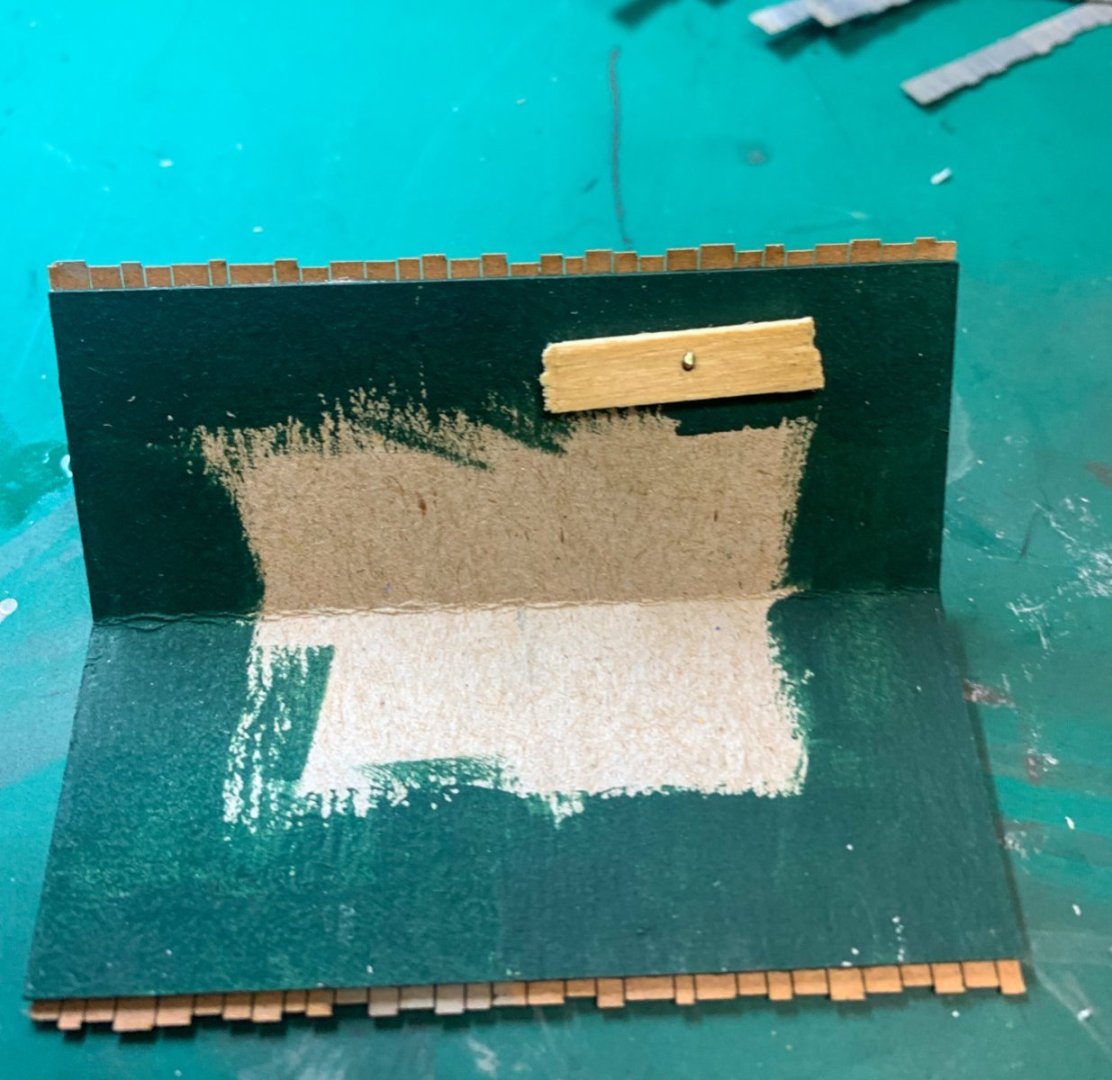
The capping shingles are made from the unused perimeter of the shingle sheet. Instructions said to use one large sheet but I cut them down to size and applied them in an overlapping fashion. Here are a few pics of the 2 finished roofs. Also added are the stove pipe coming out of the window and the chimney. The chimney was first painted with VMA aged white ( 71.132)and then dry brushed in several layers to paint the bricks using VMA 71.105 (this is listed as brown but look more like brick red) . Support wires were added to both.
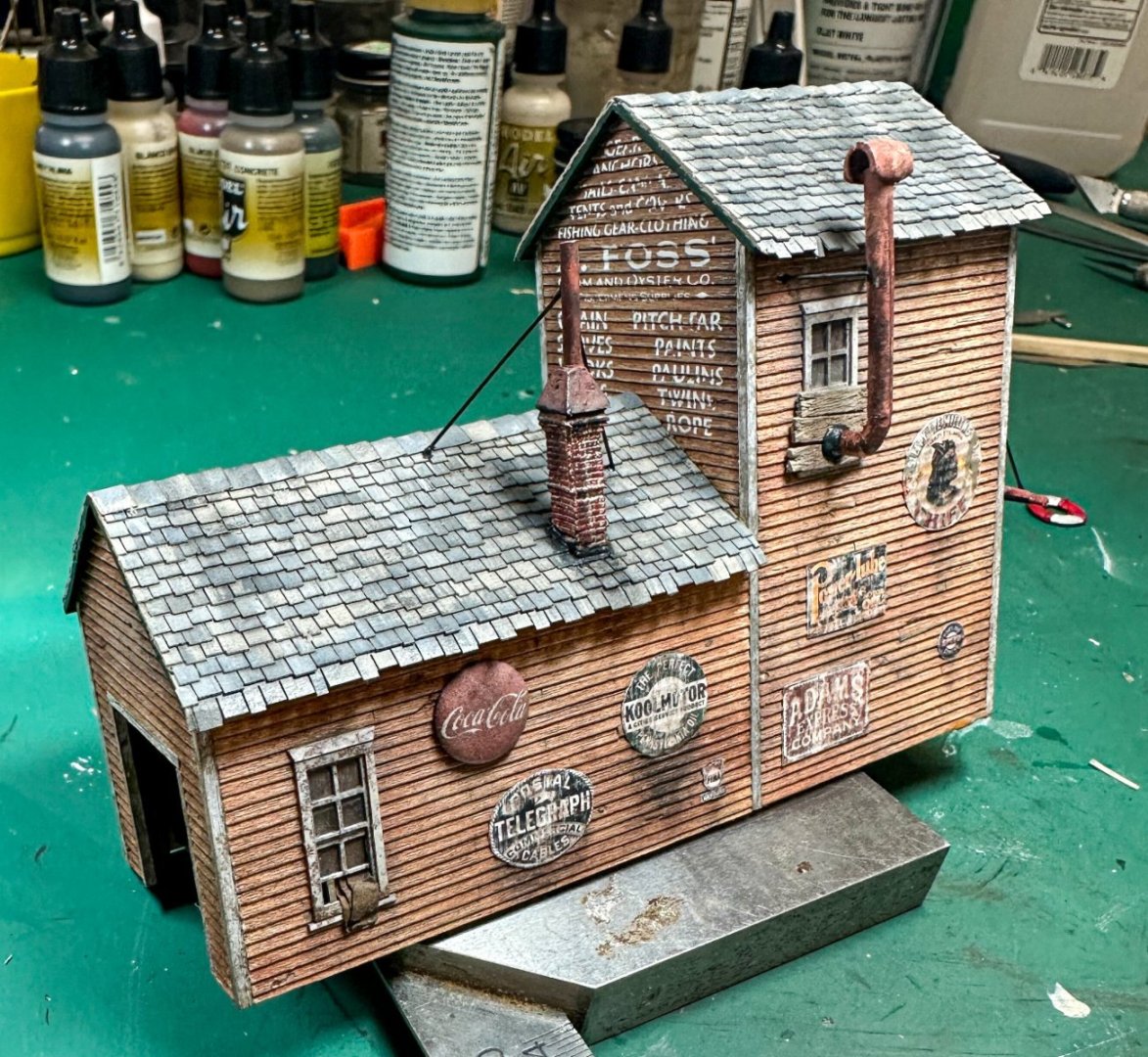
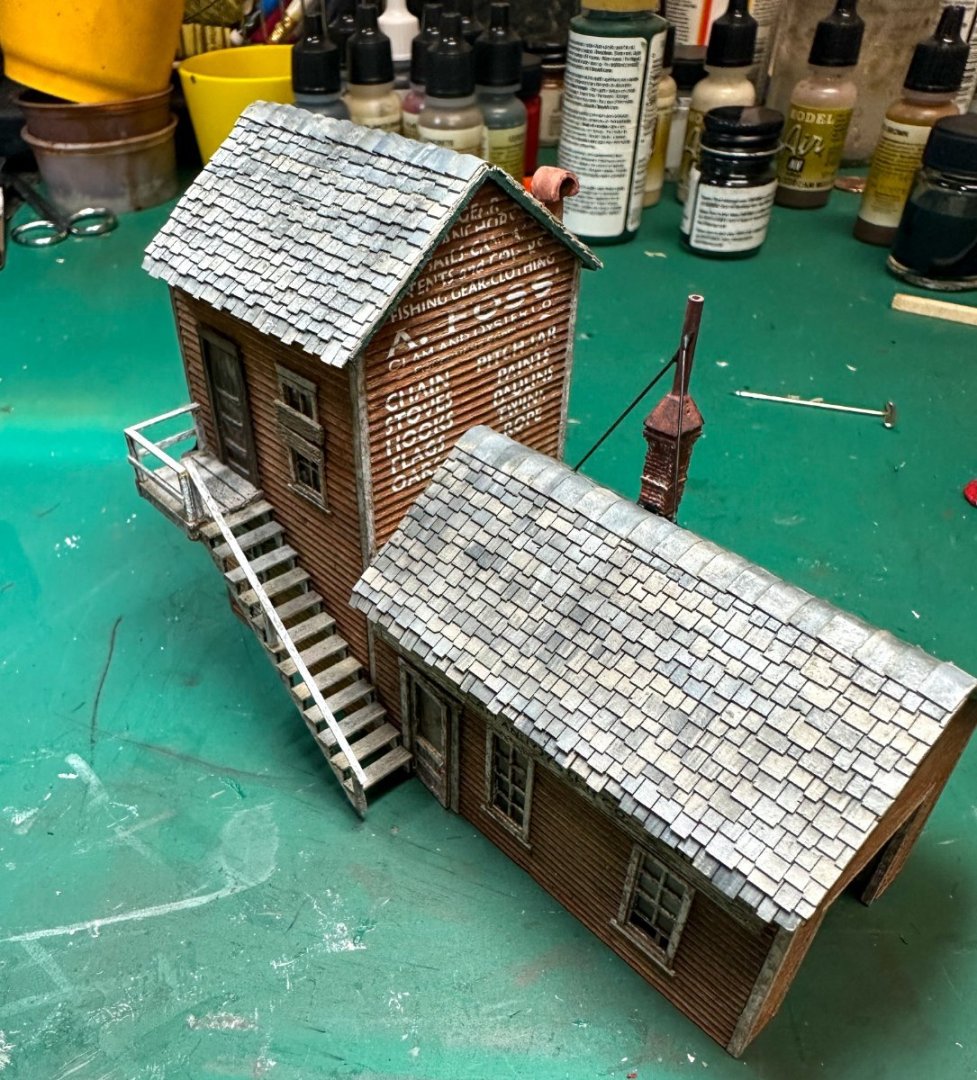
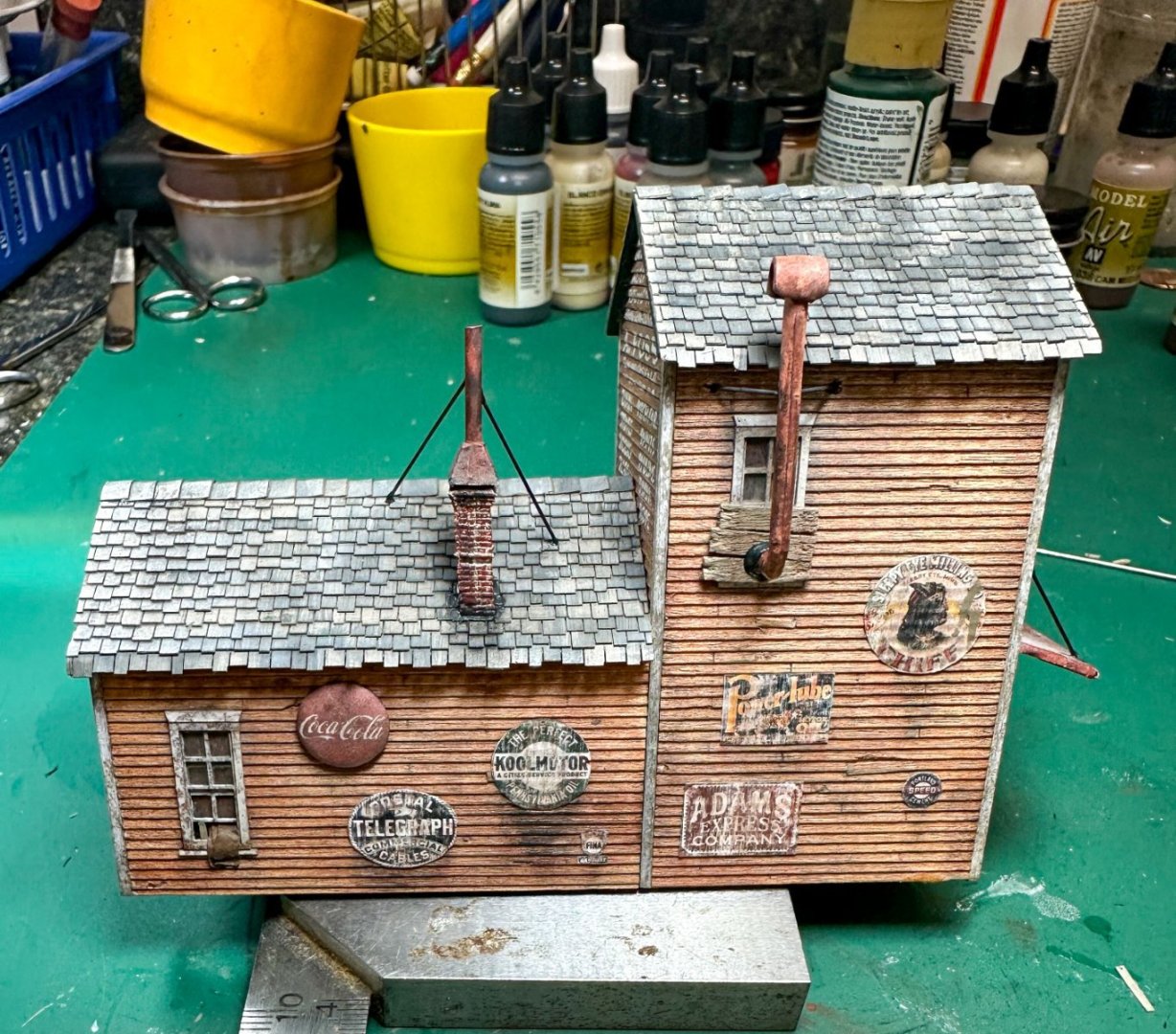
Some soot was added around the chimney and streaks added to roof. The "tar" around the base of the chimney is glue mixed with some VMA black green (71.021) and black. I also used some aged white to add some bird dropping to the roof. hard to see in the photos however. After hanging the 4 freight doors this structure will be done.Jeff
-

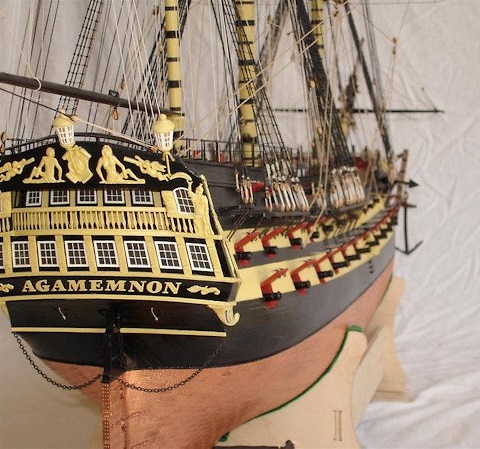
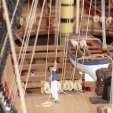

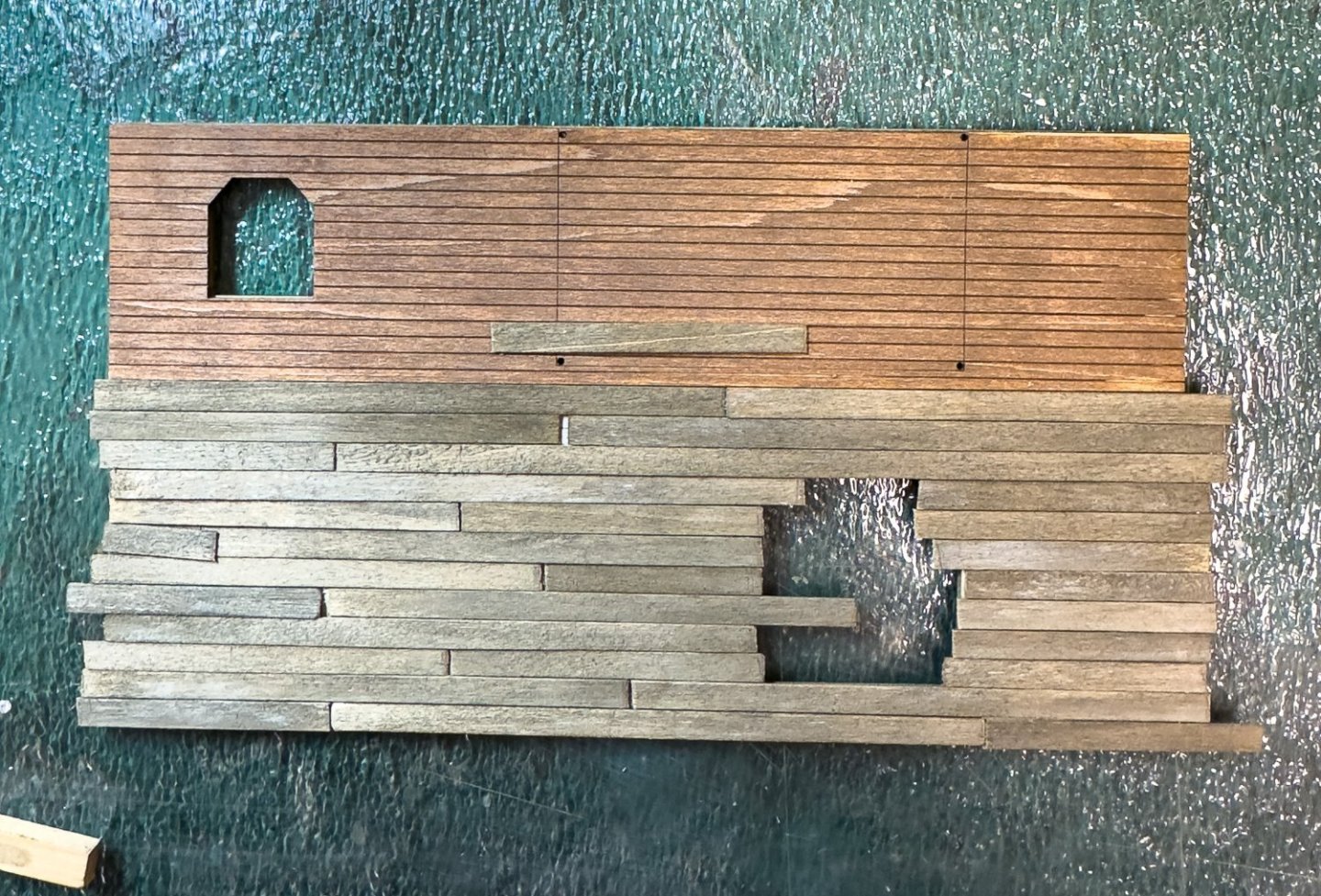
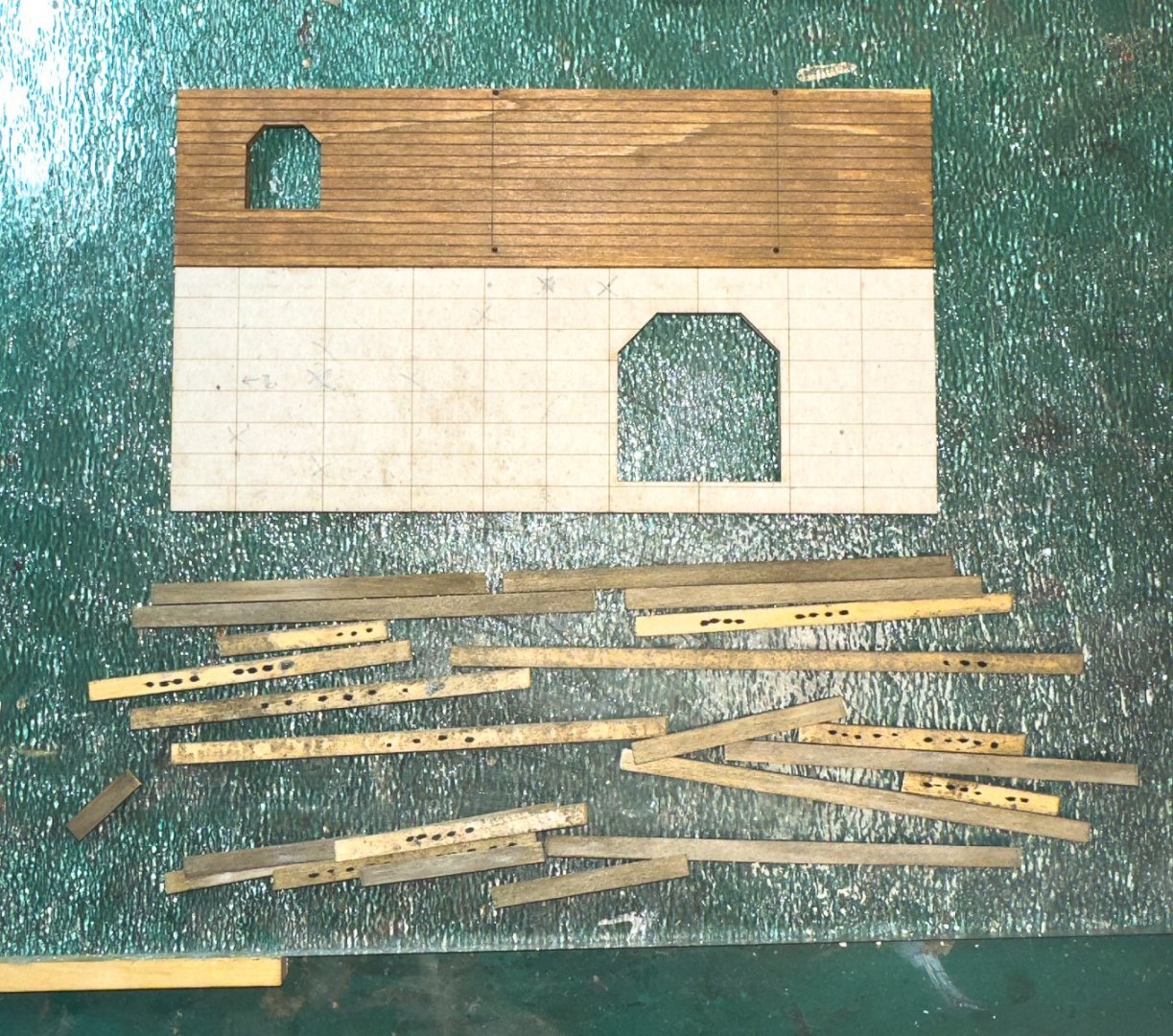
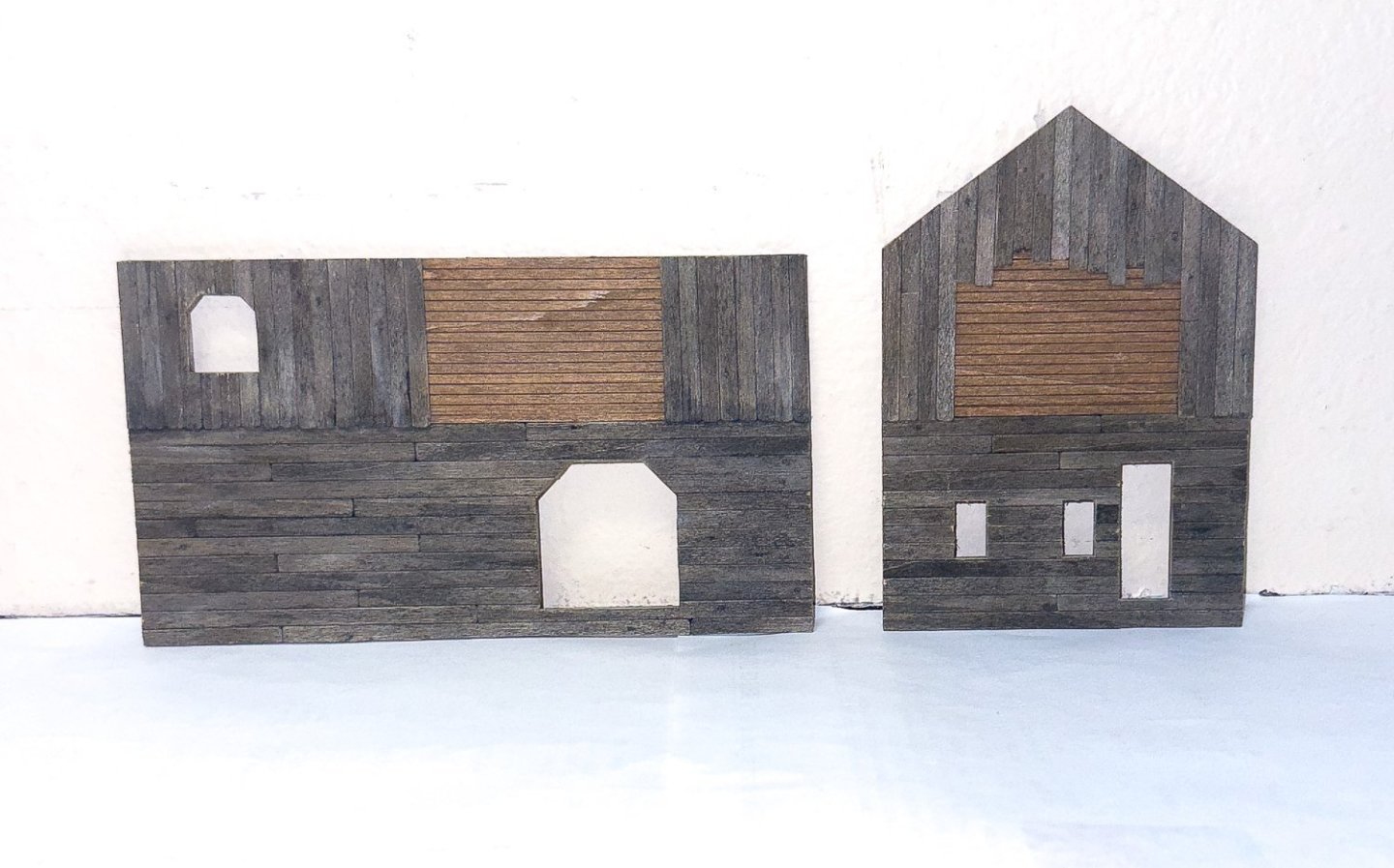

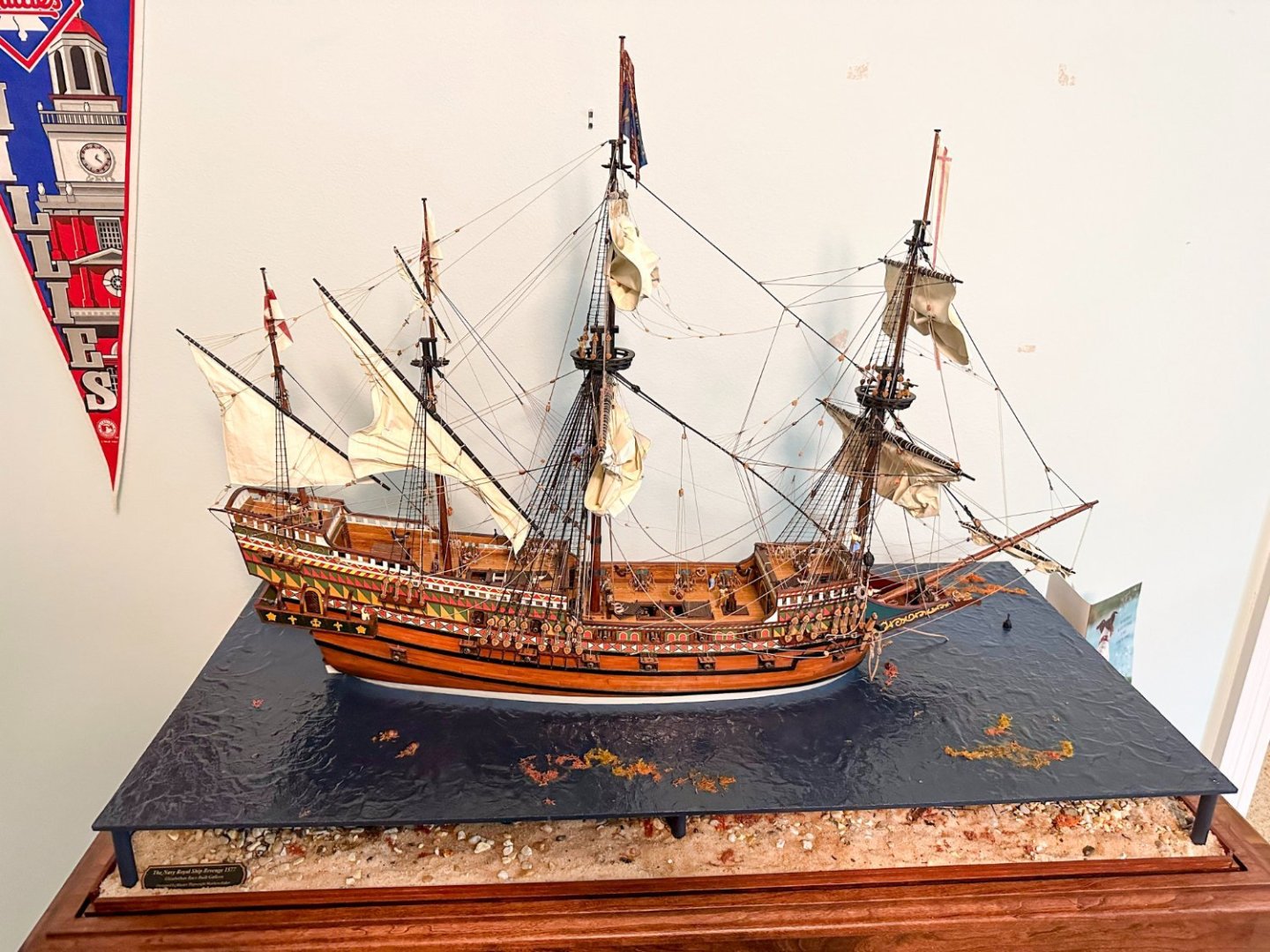
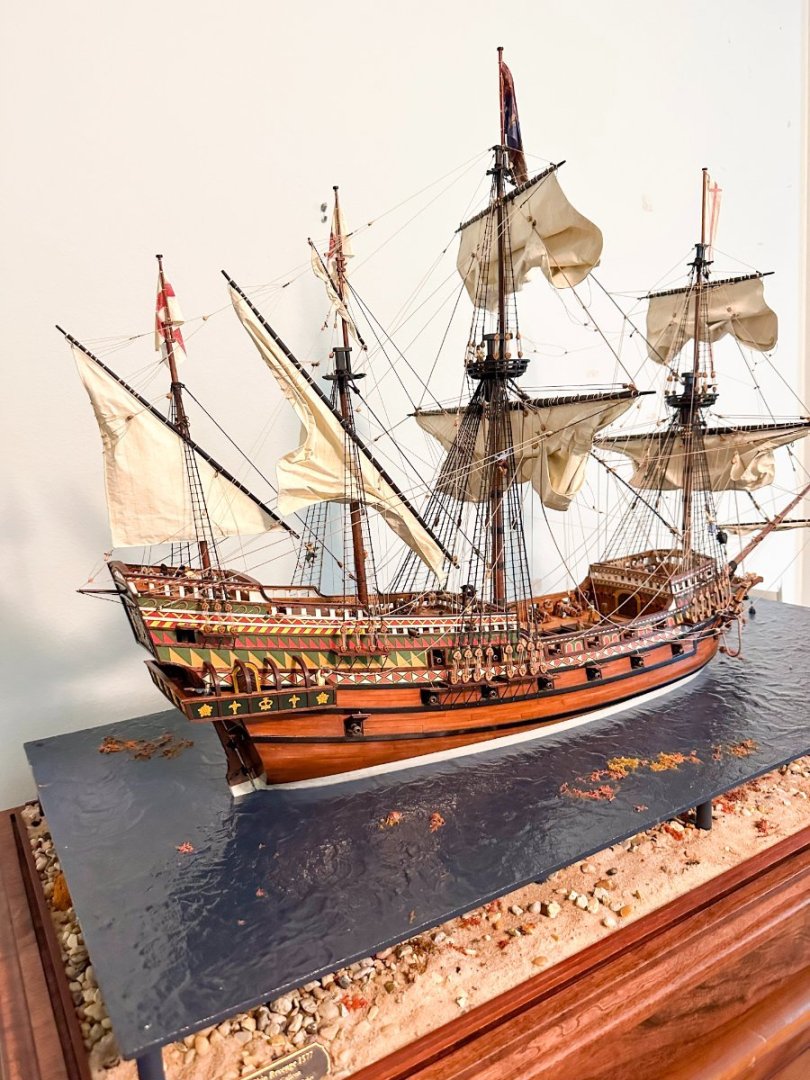
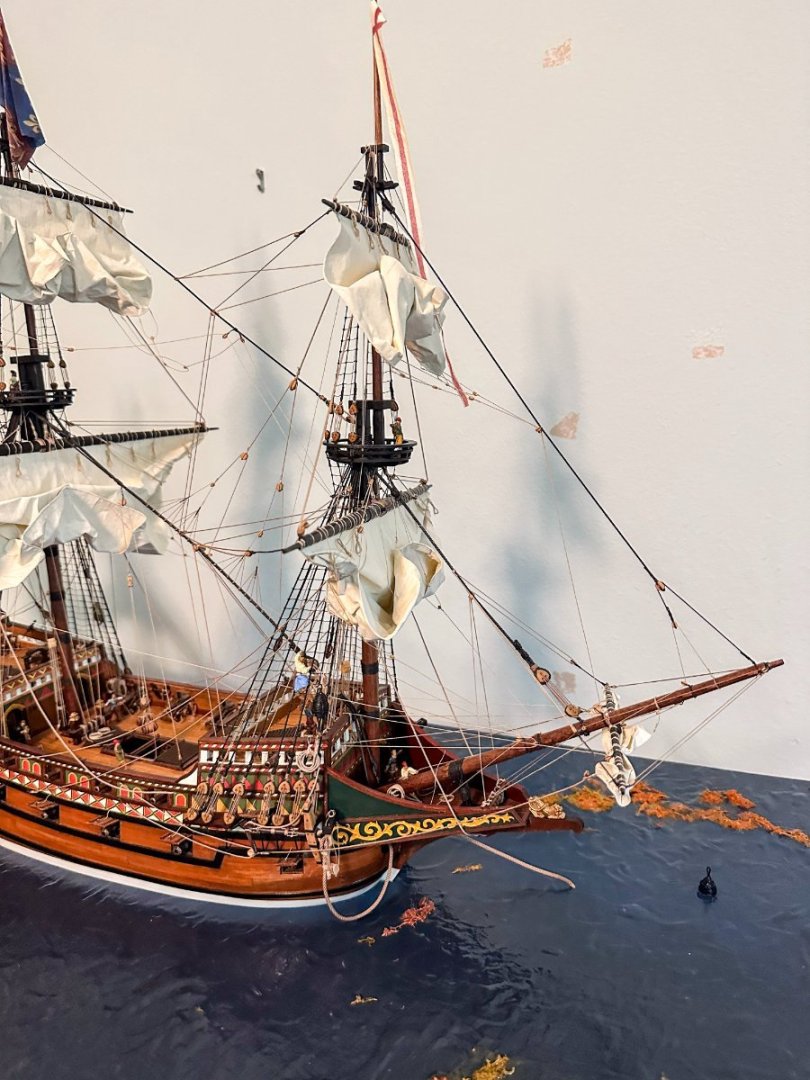
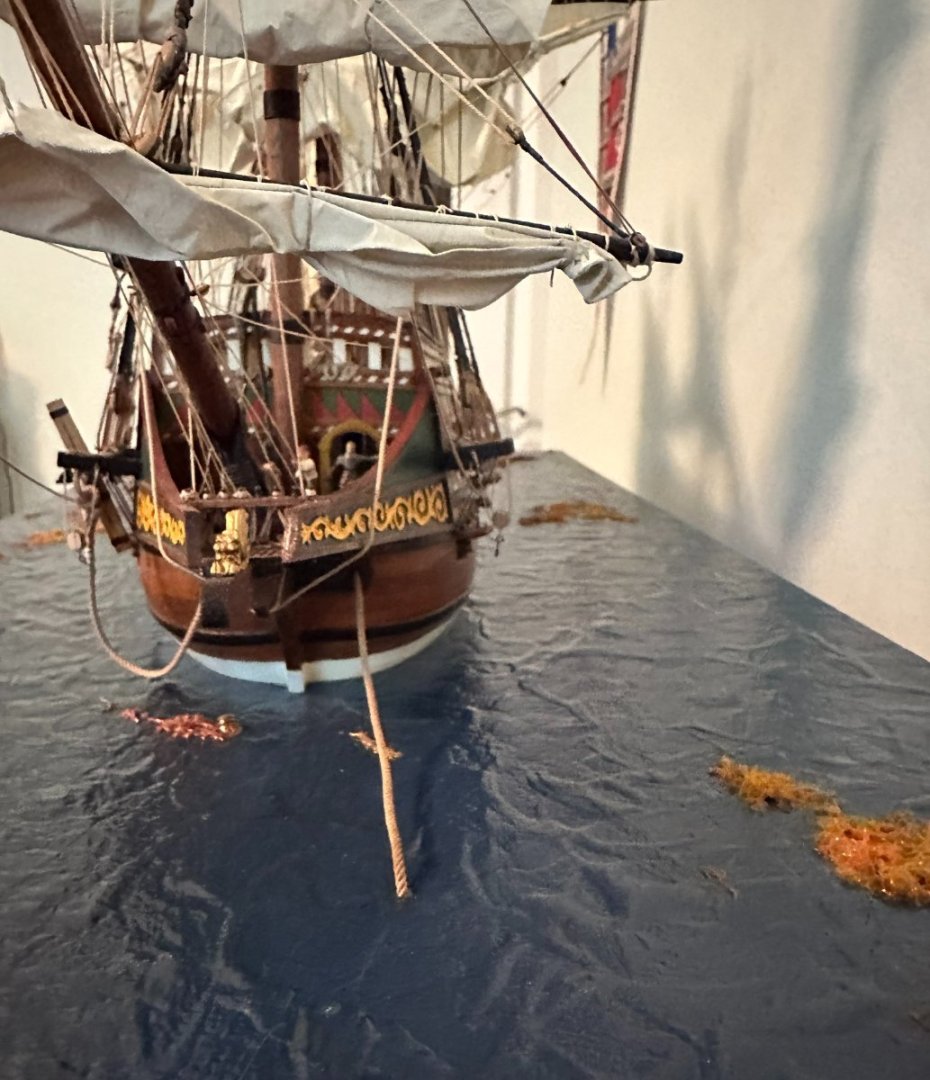
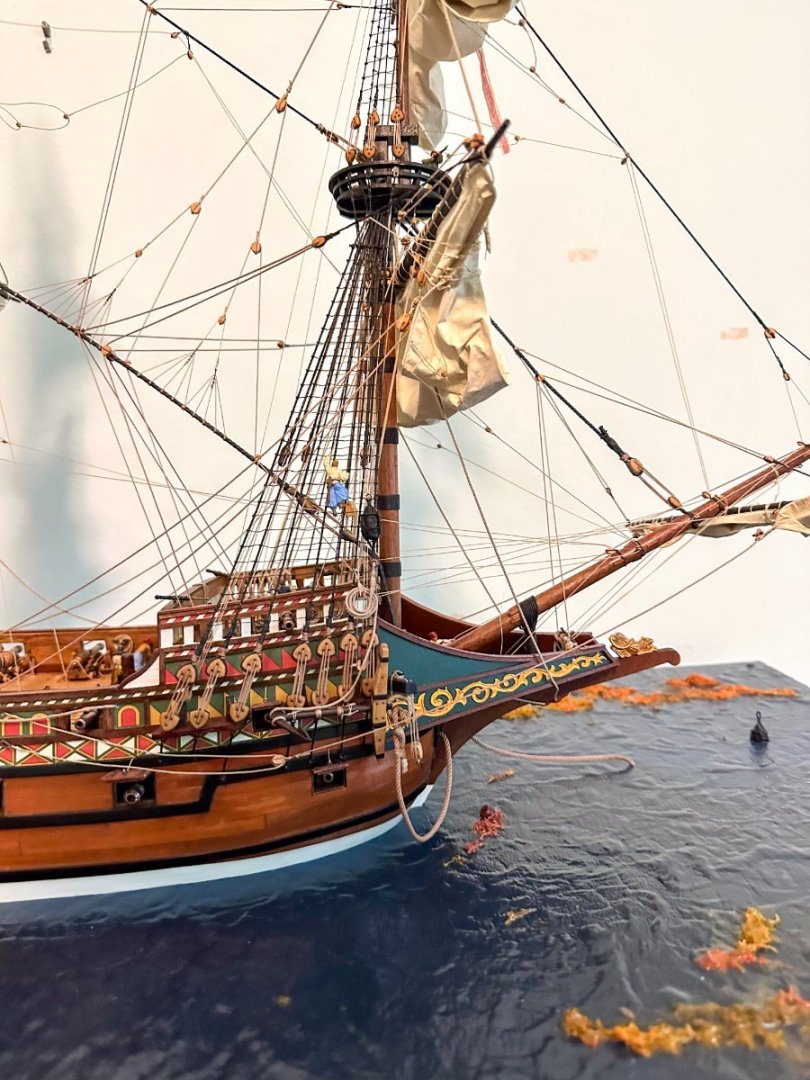
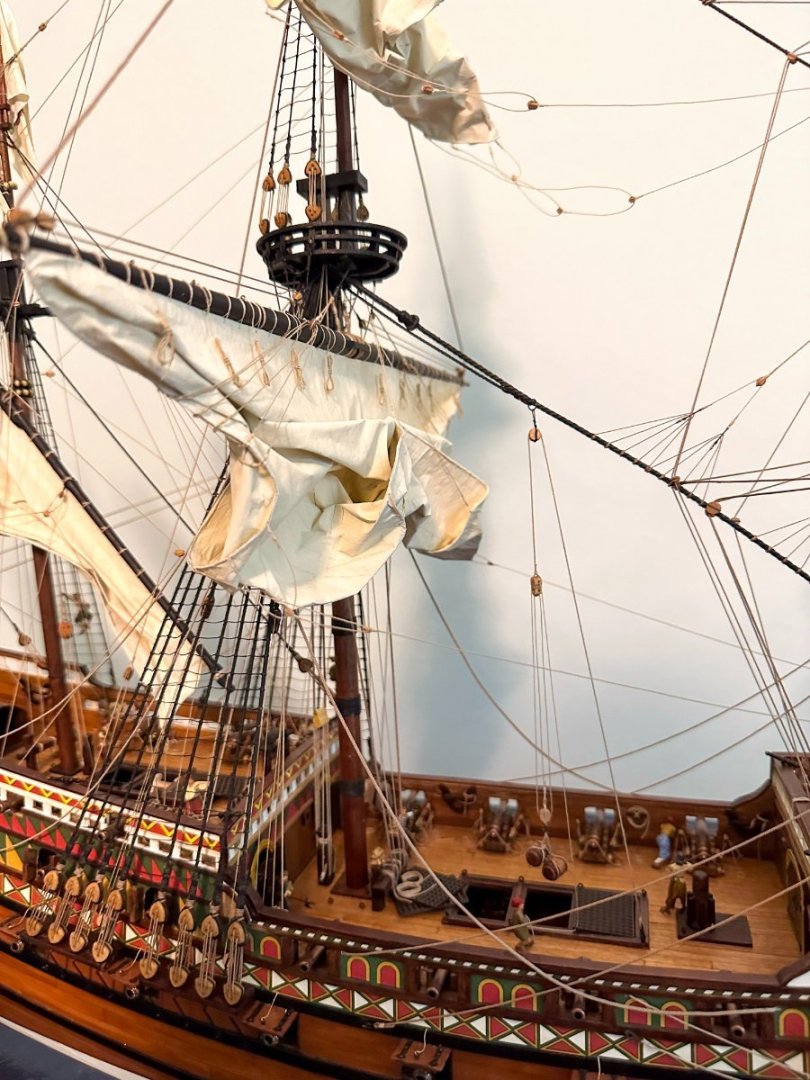
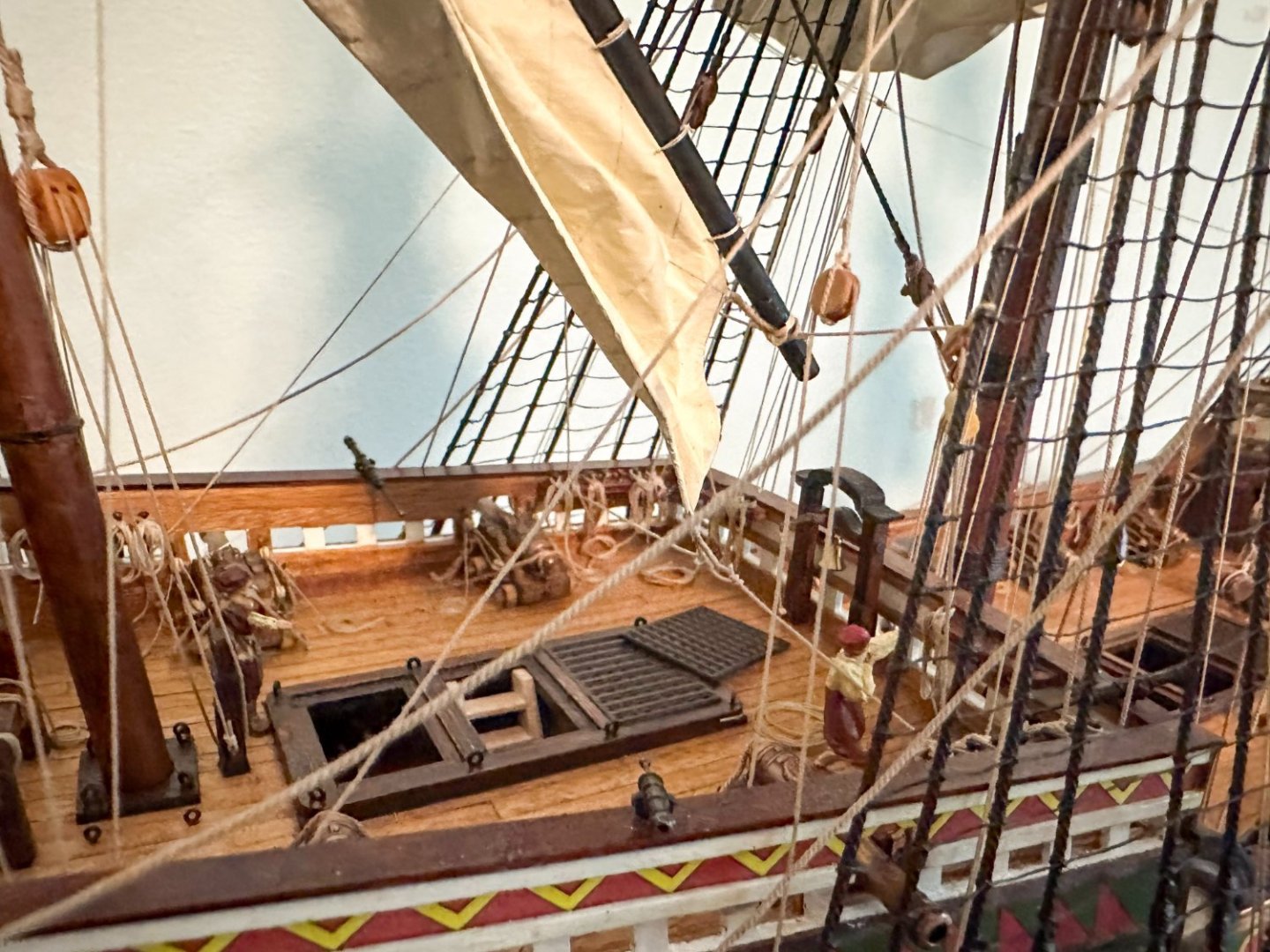
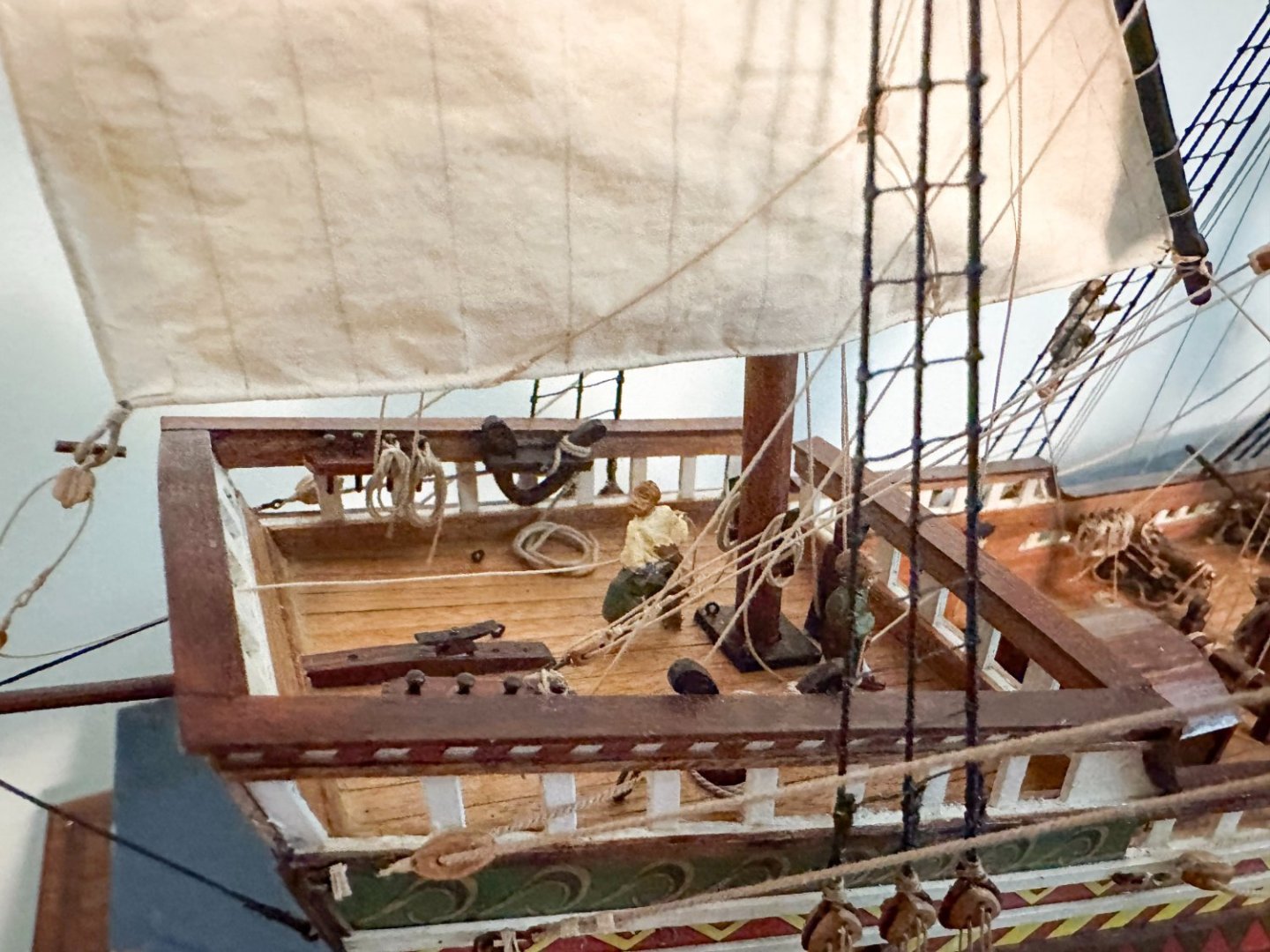
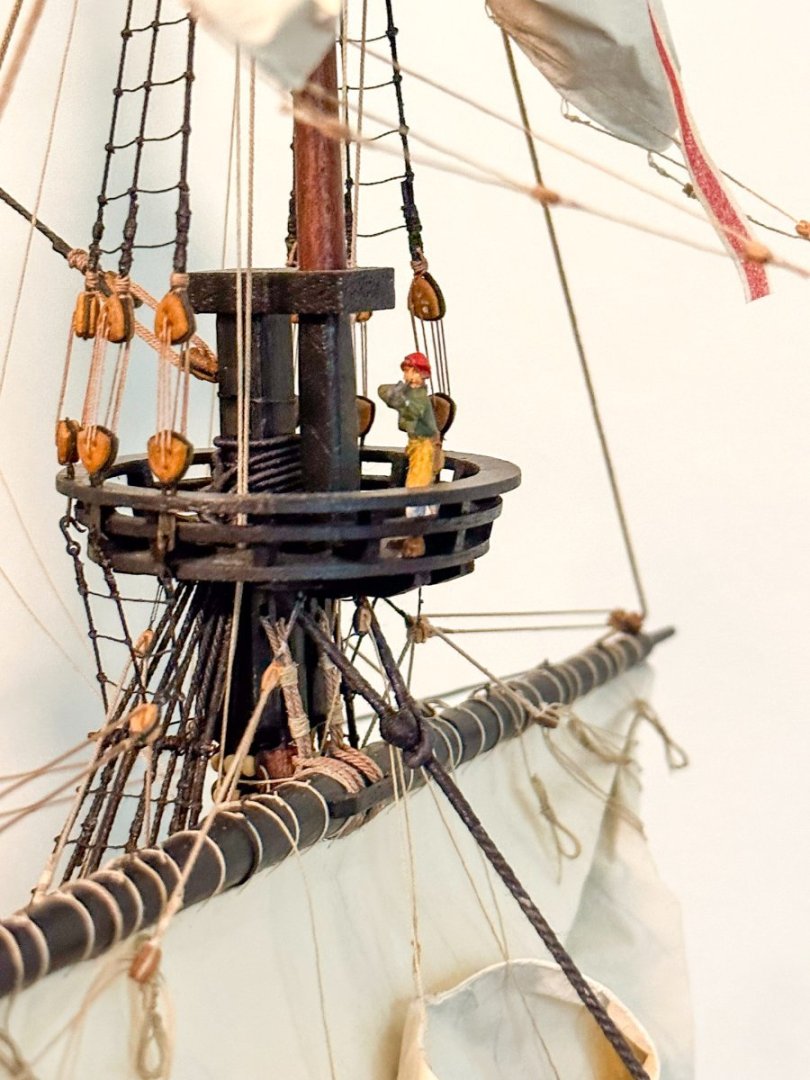
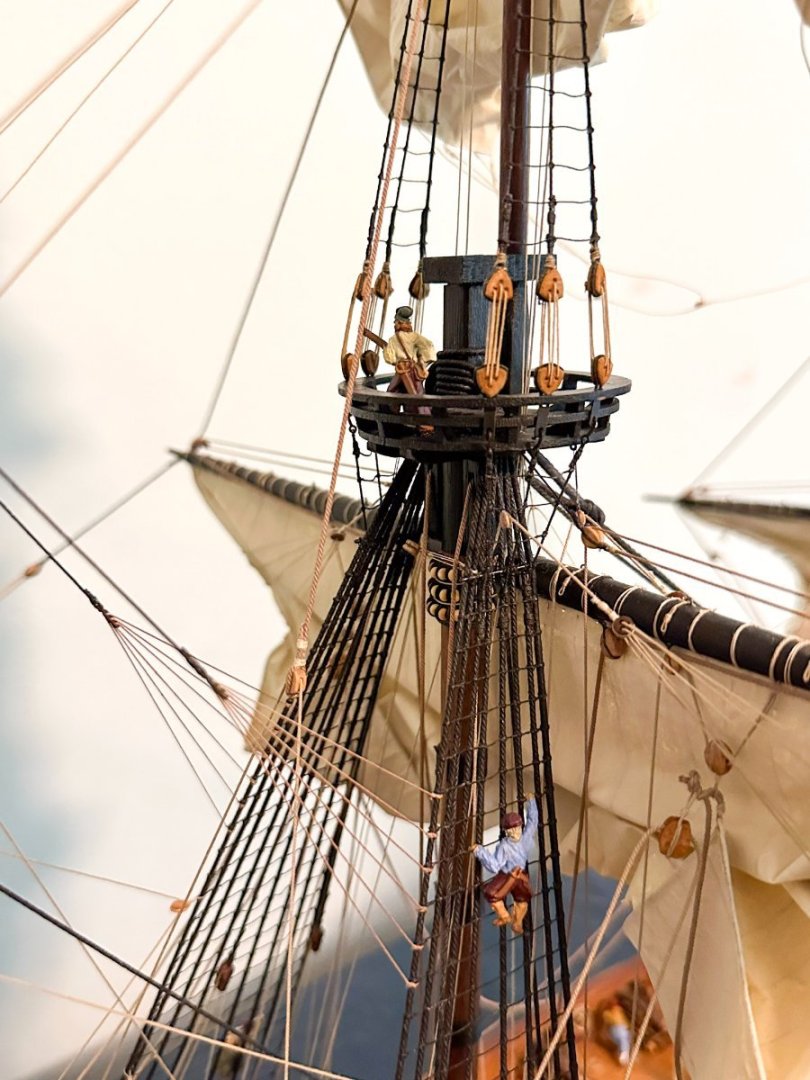
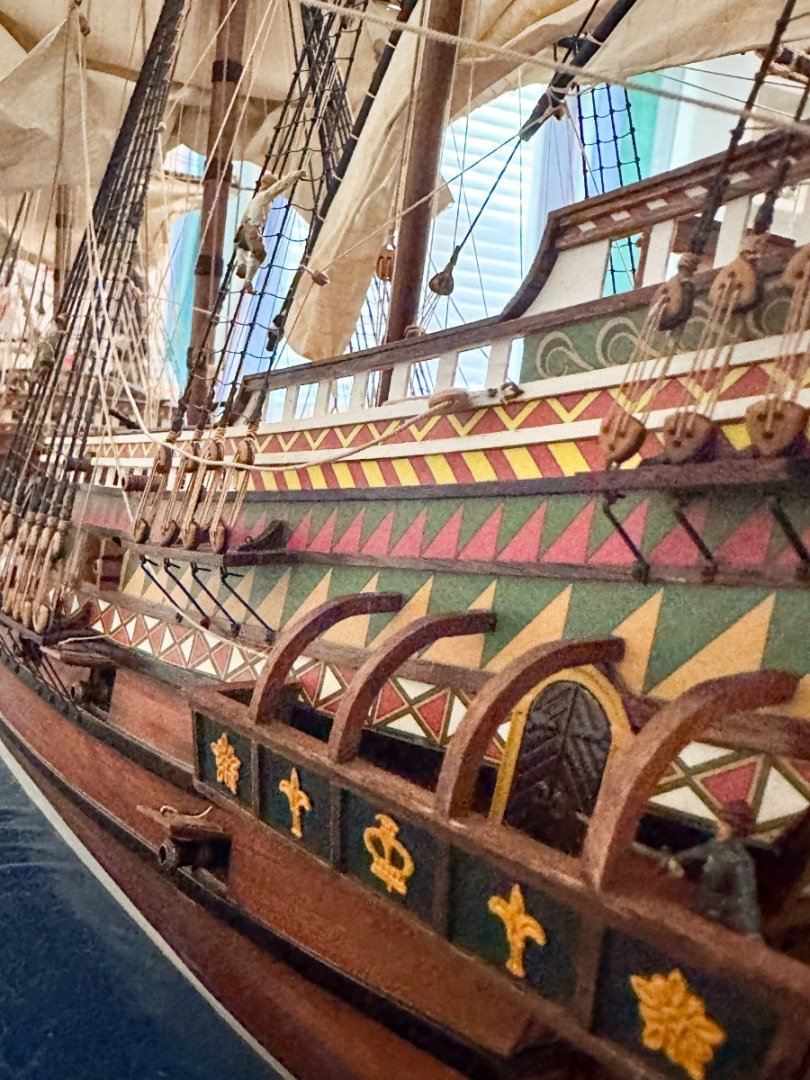
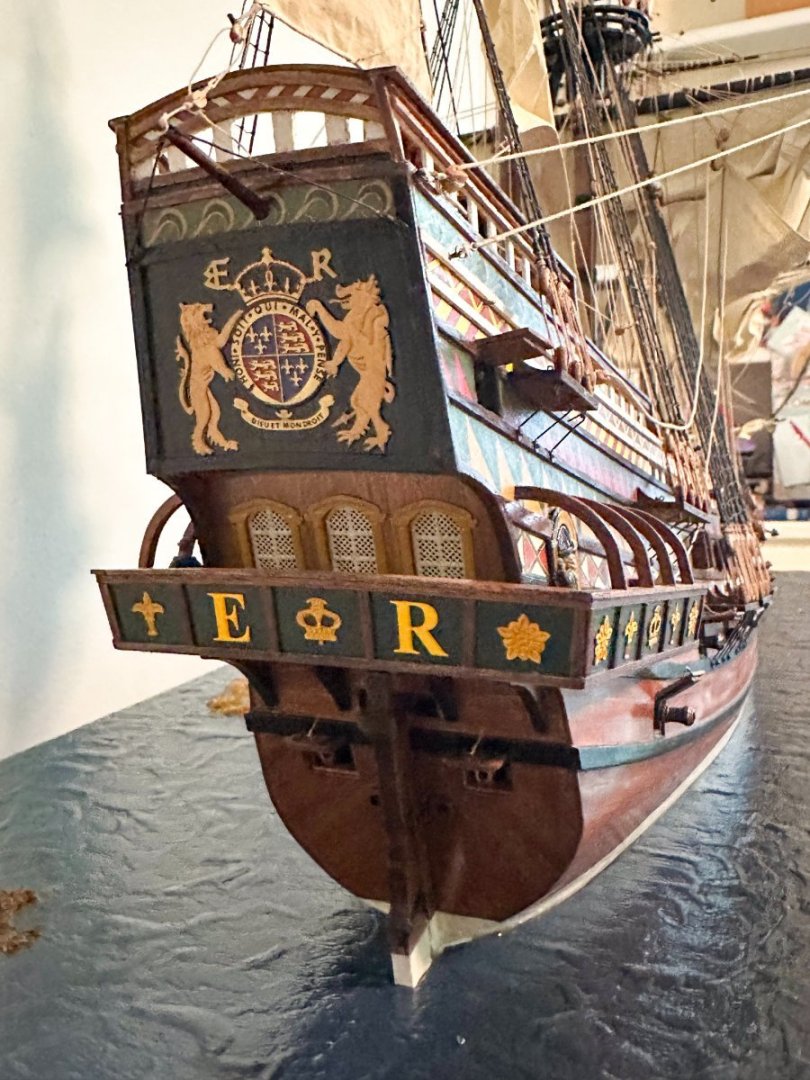
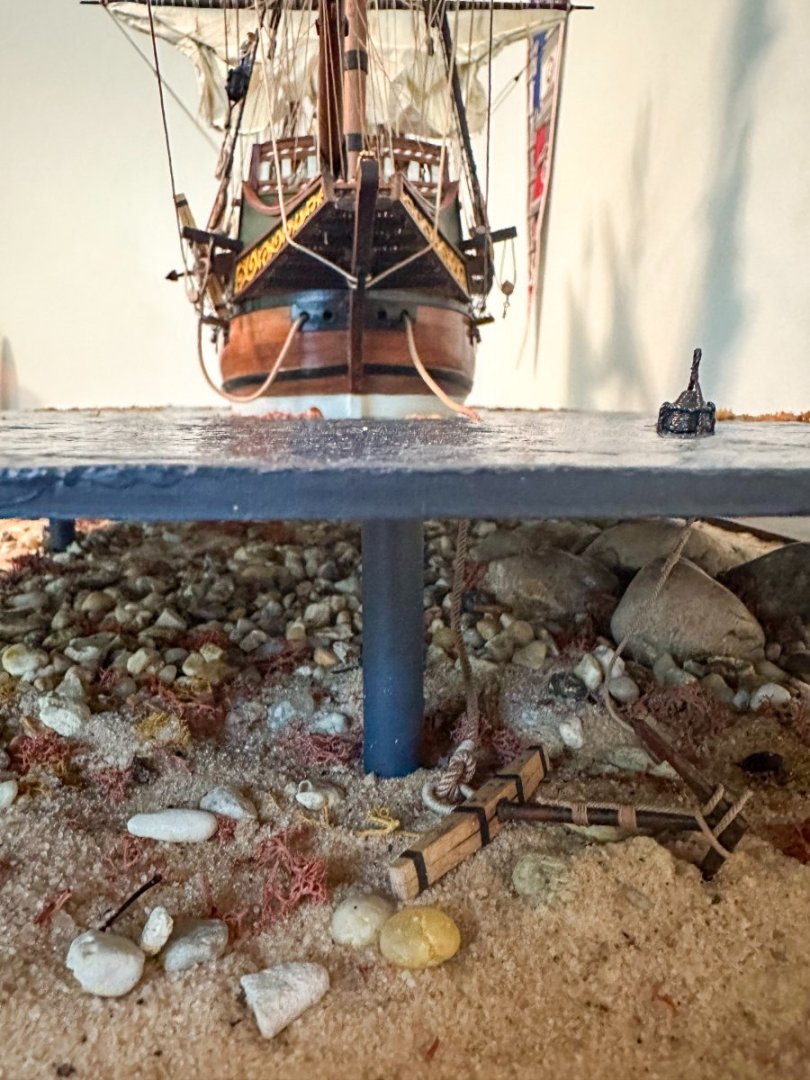
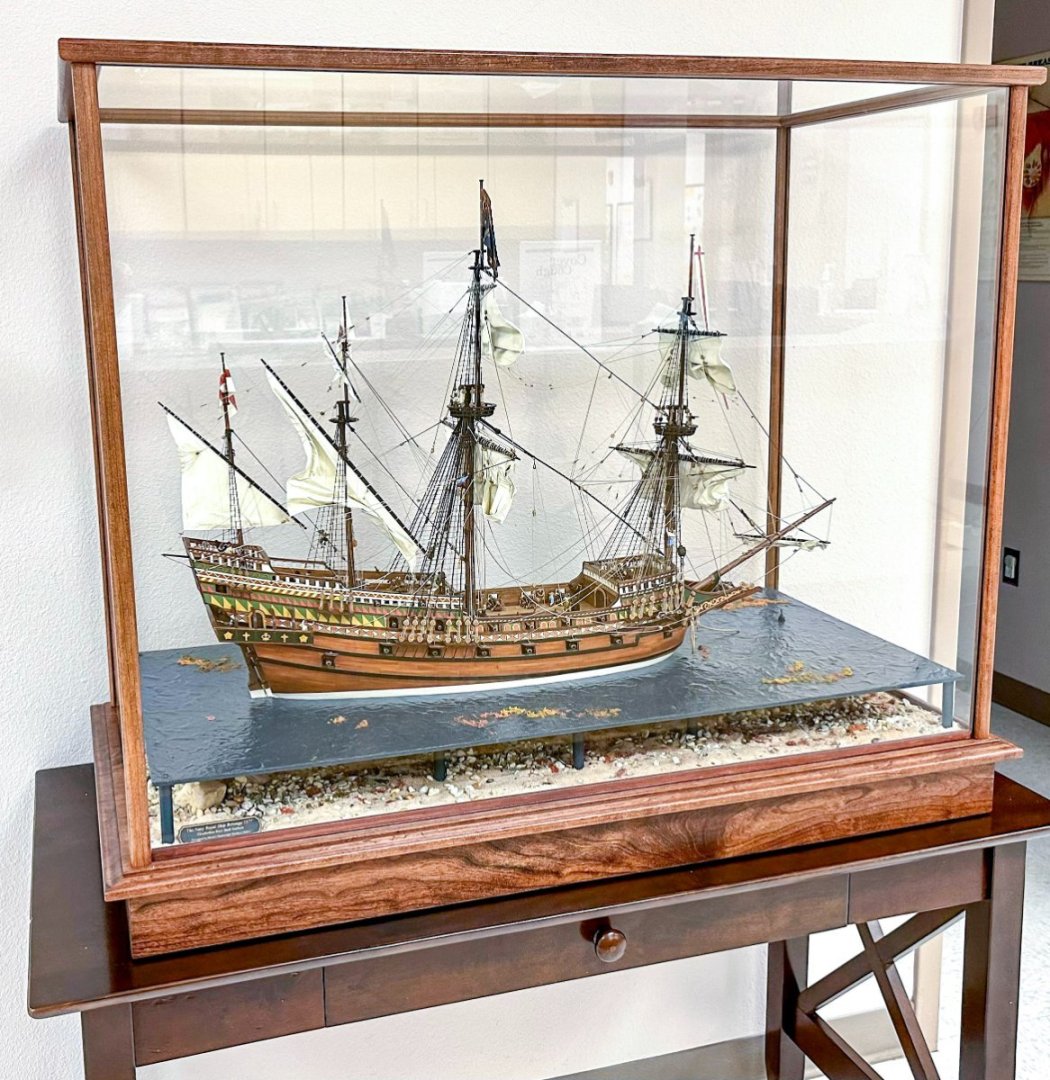
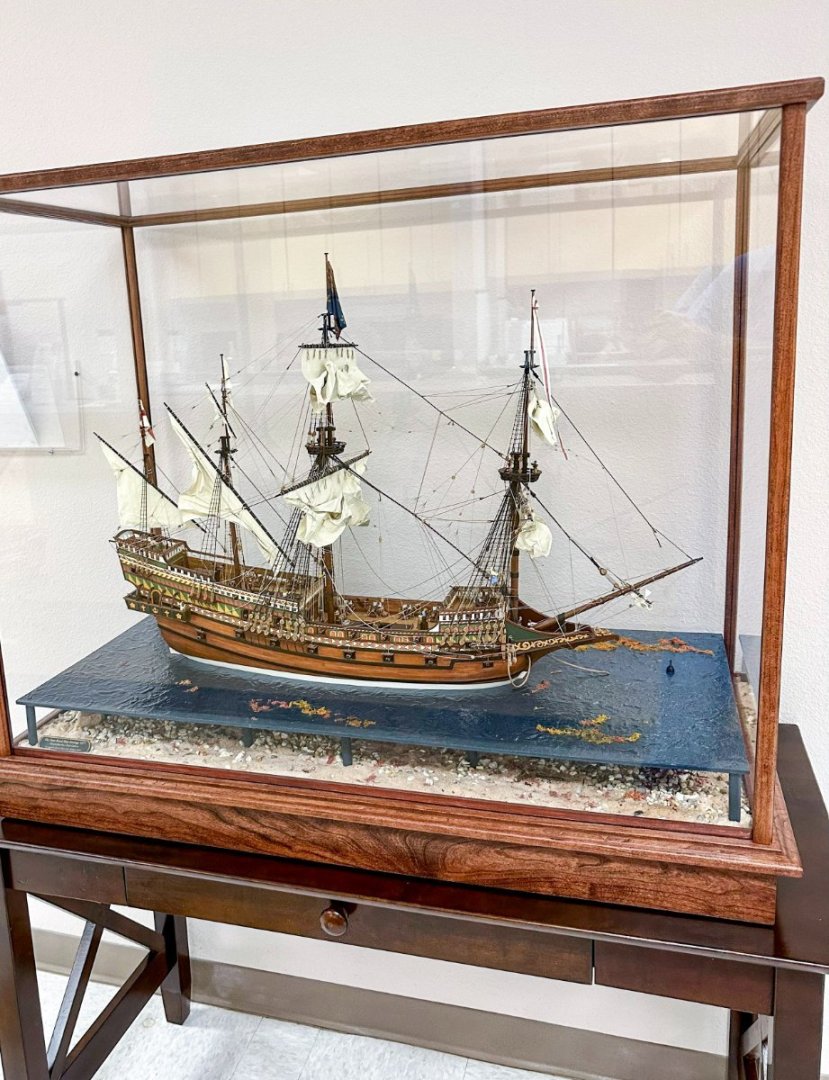
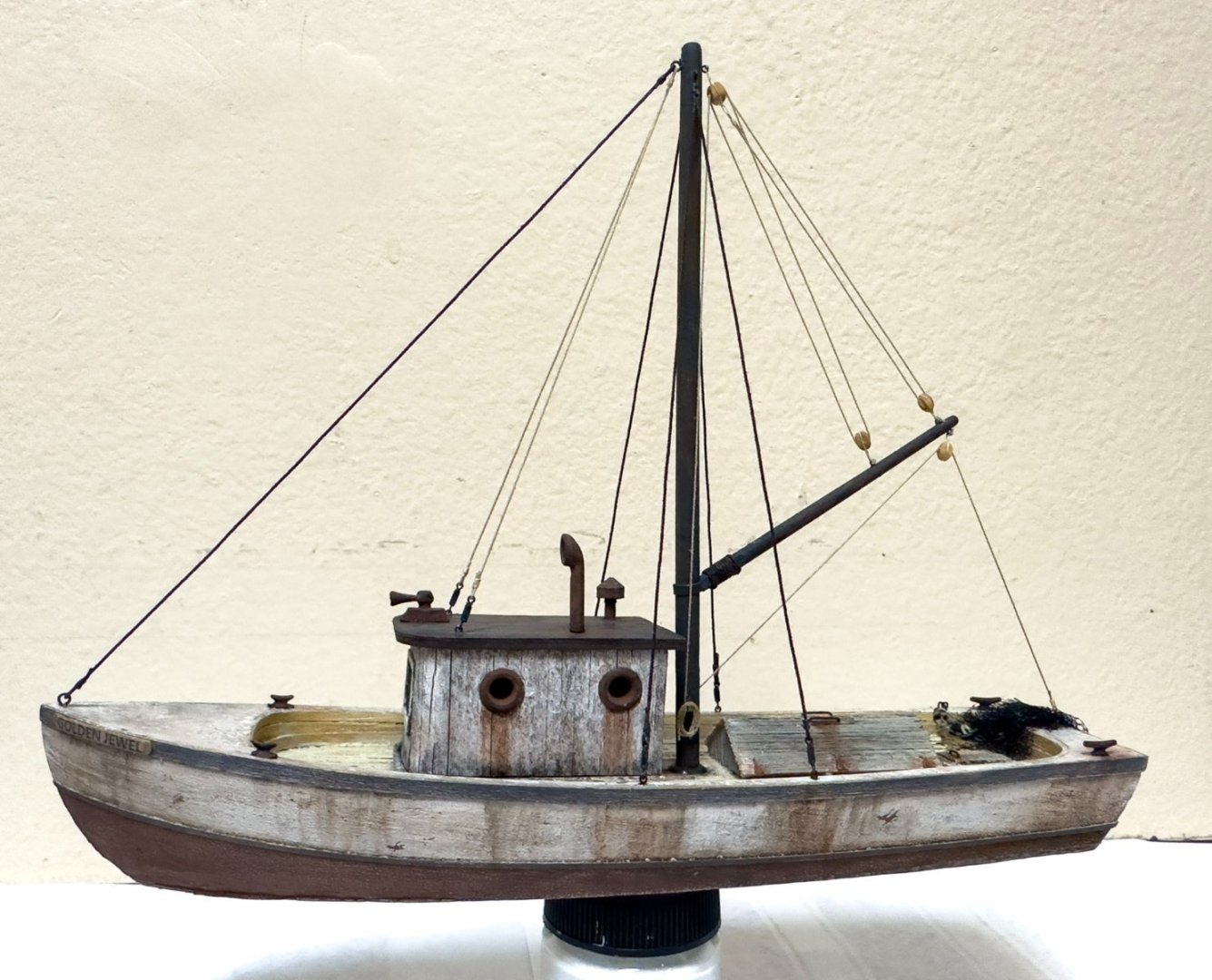
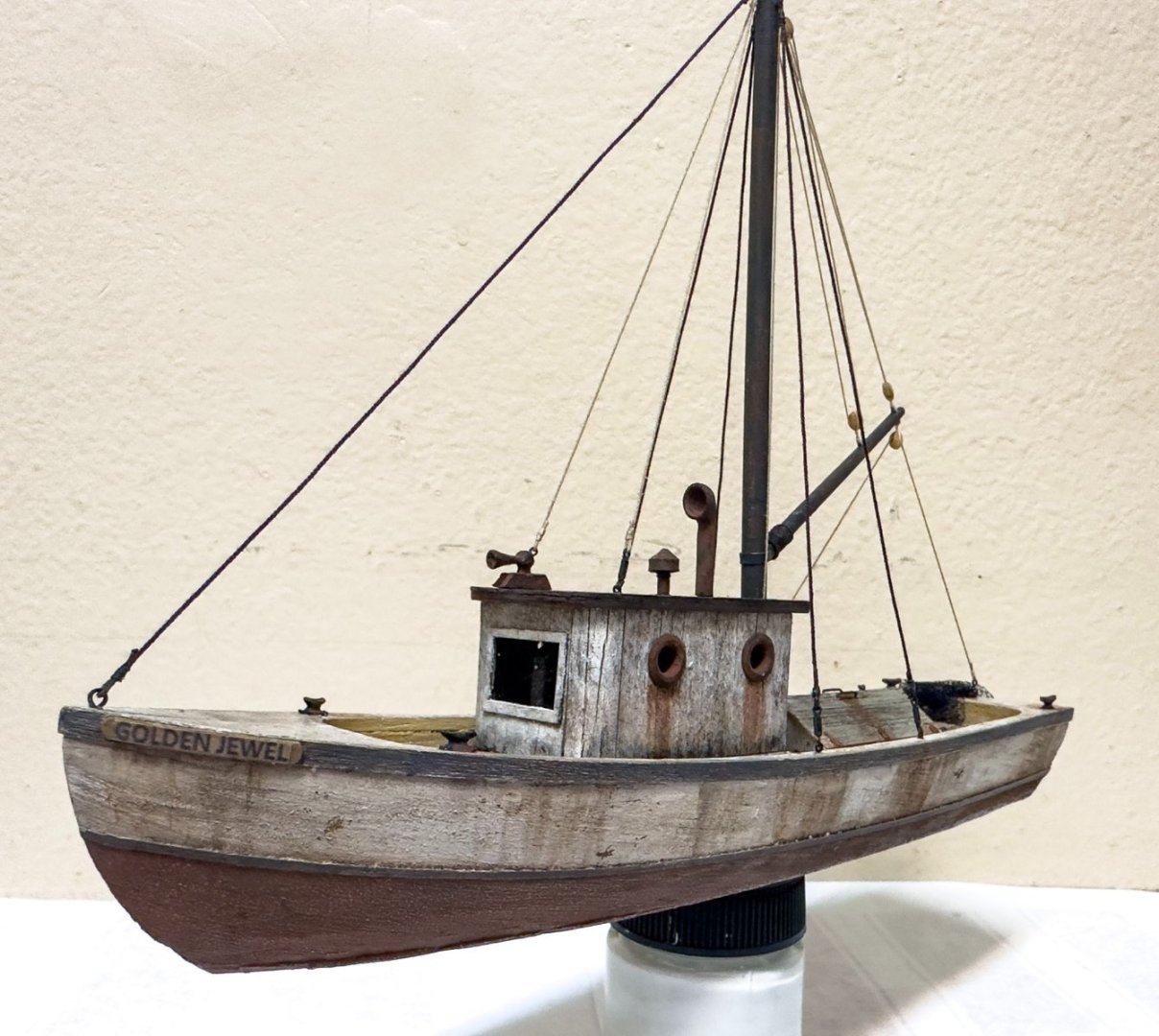
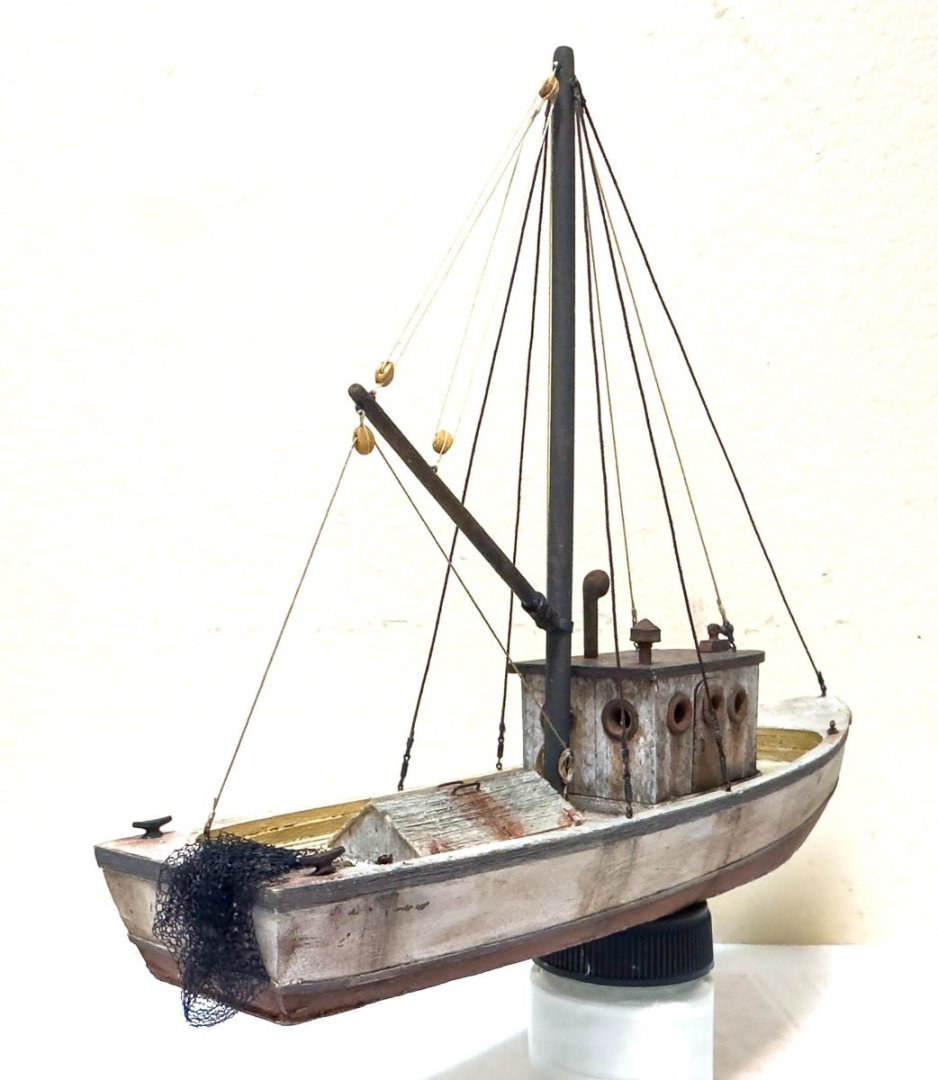
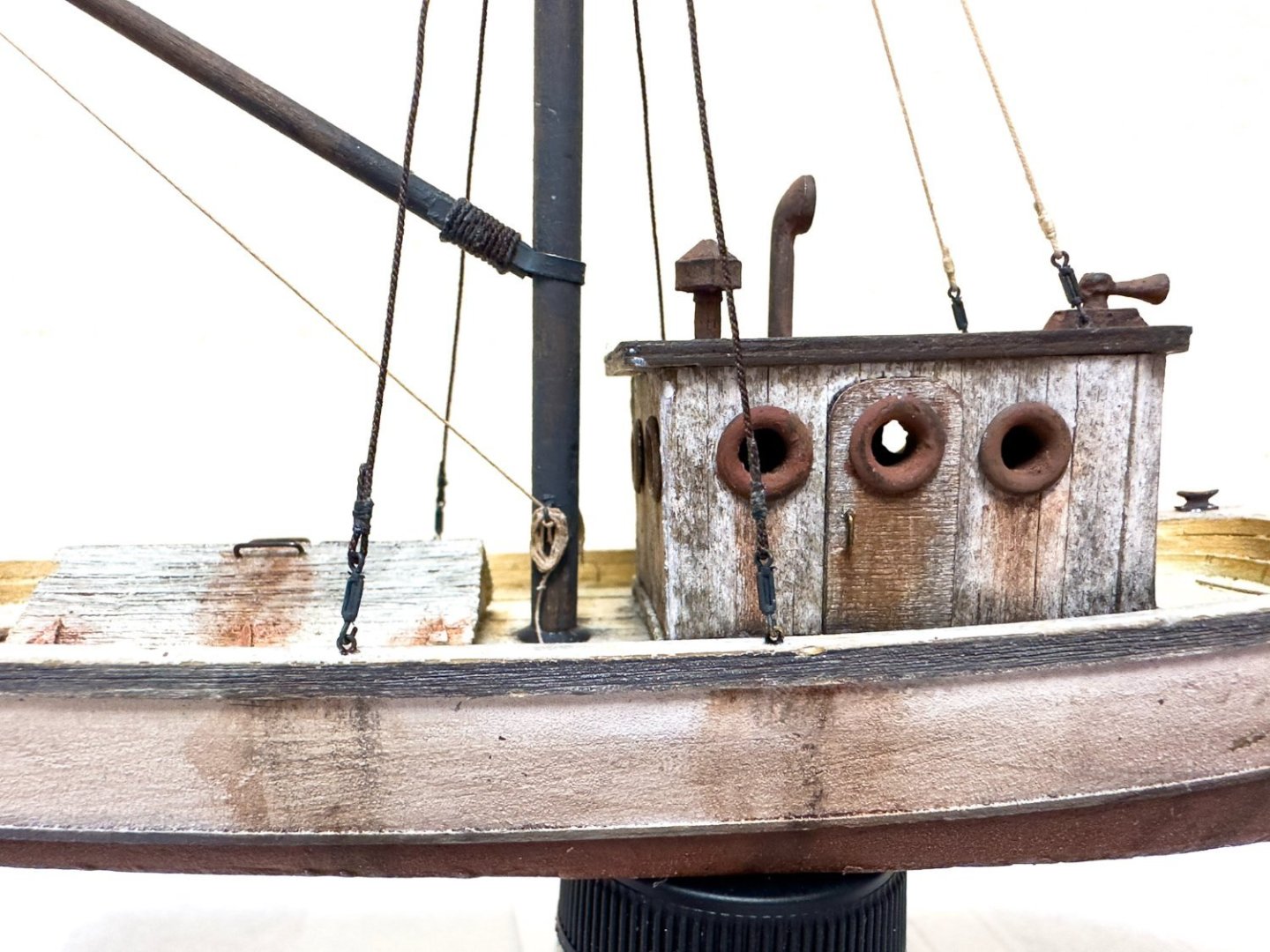
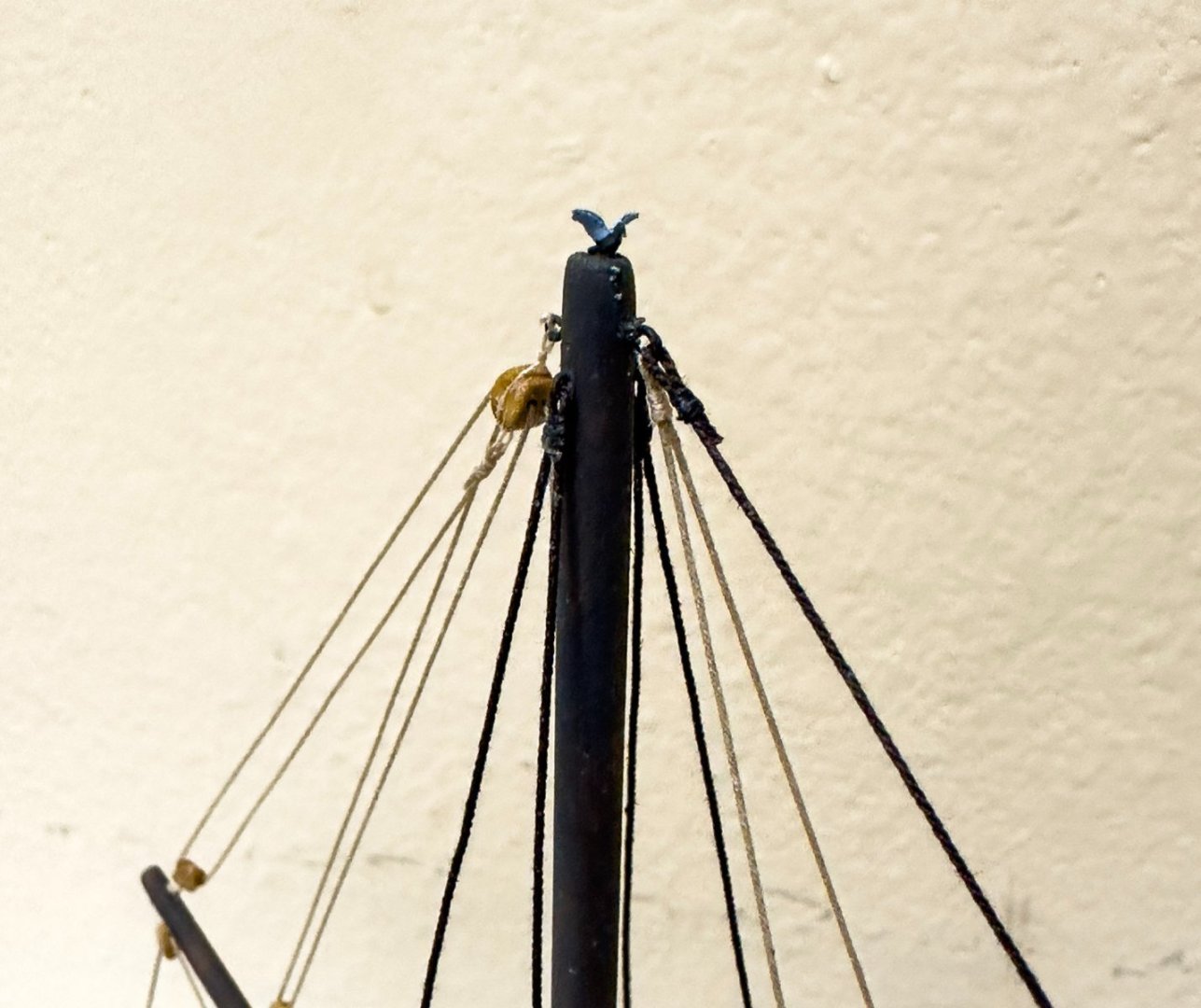
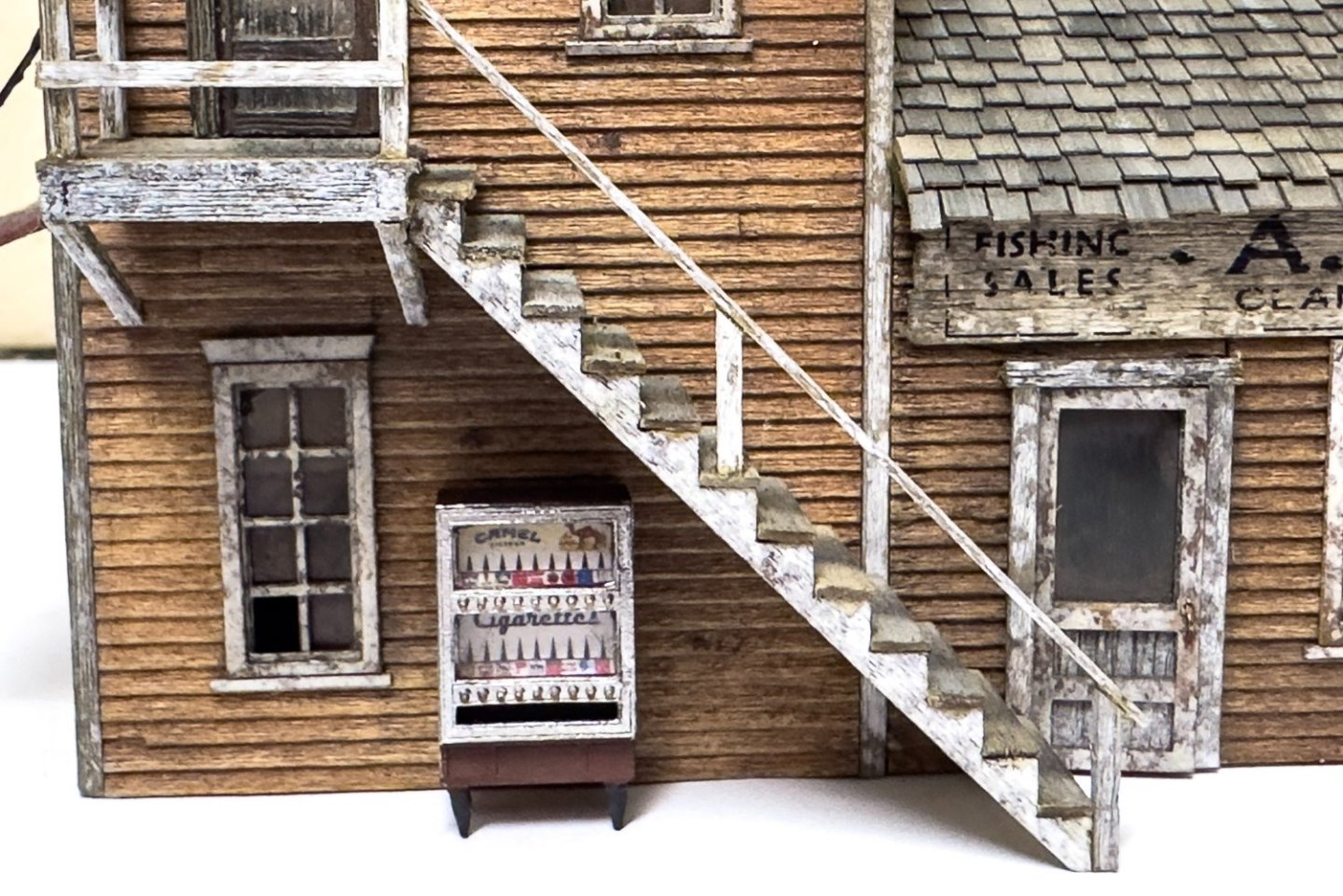
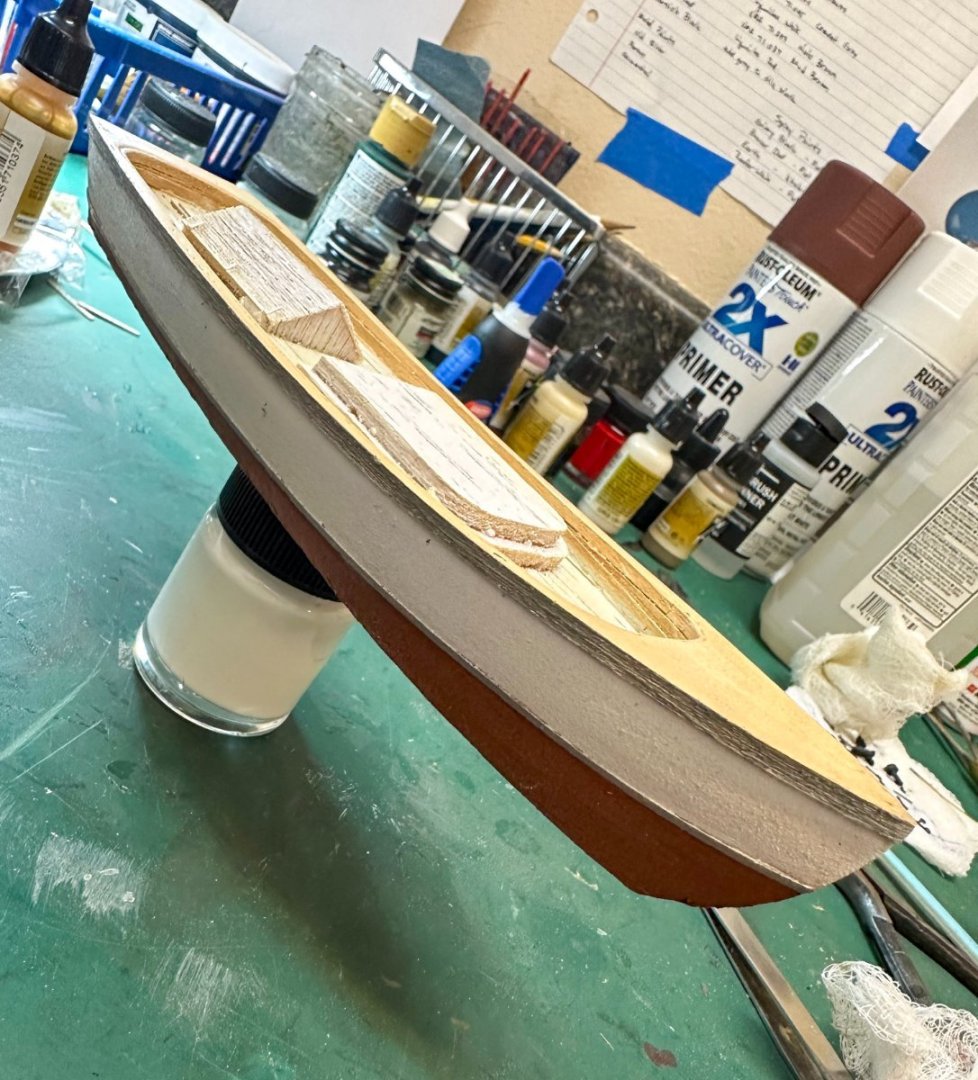
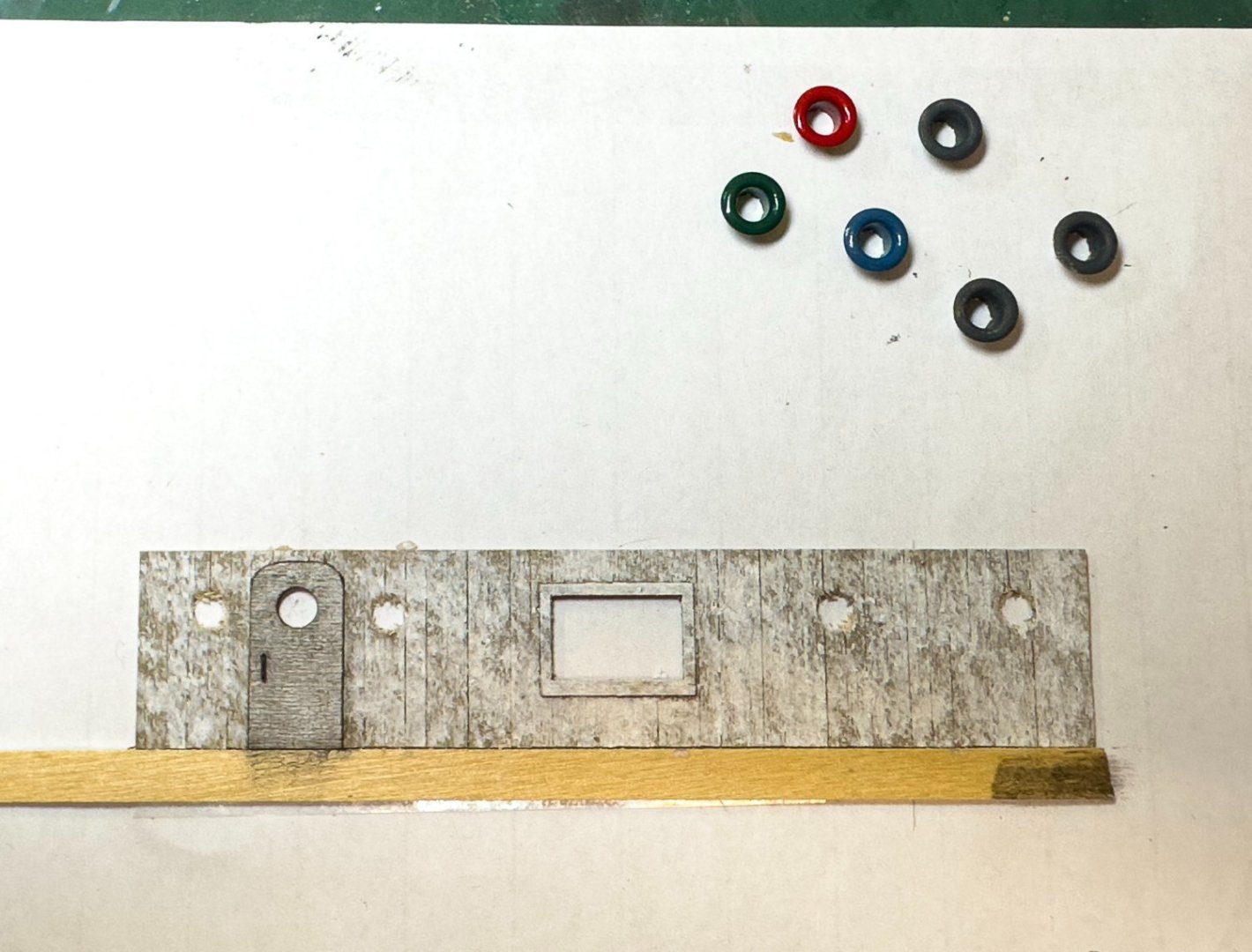
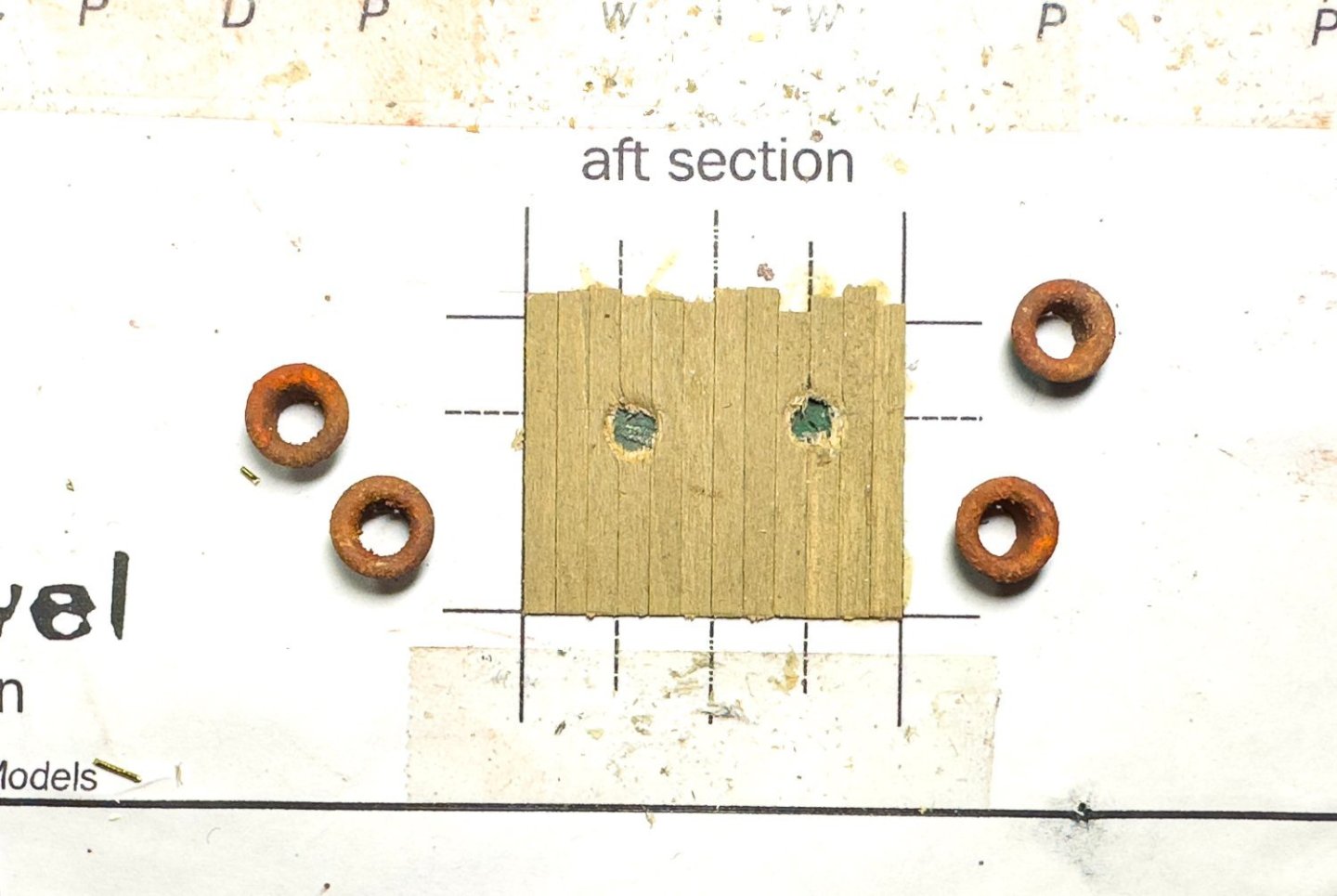
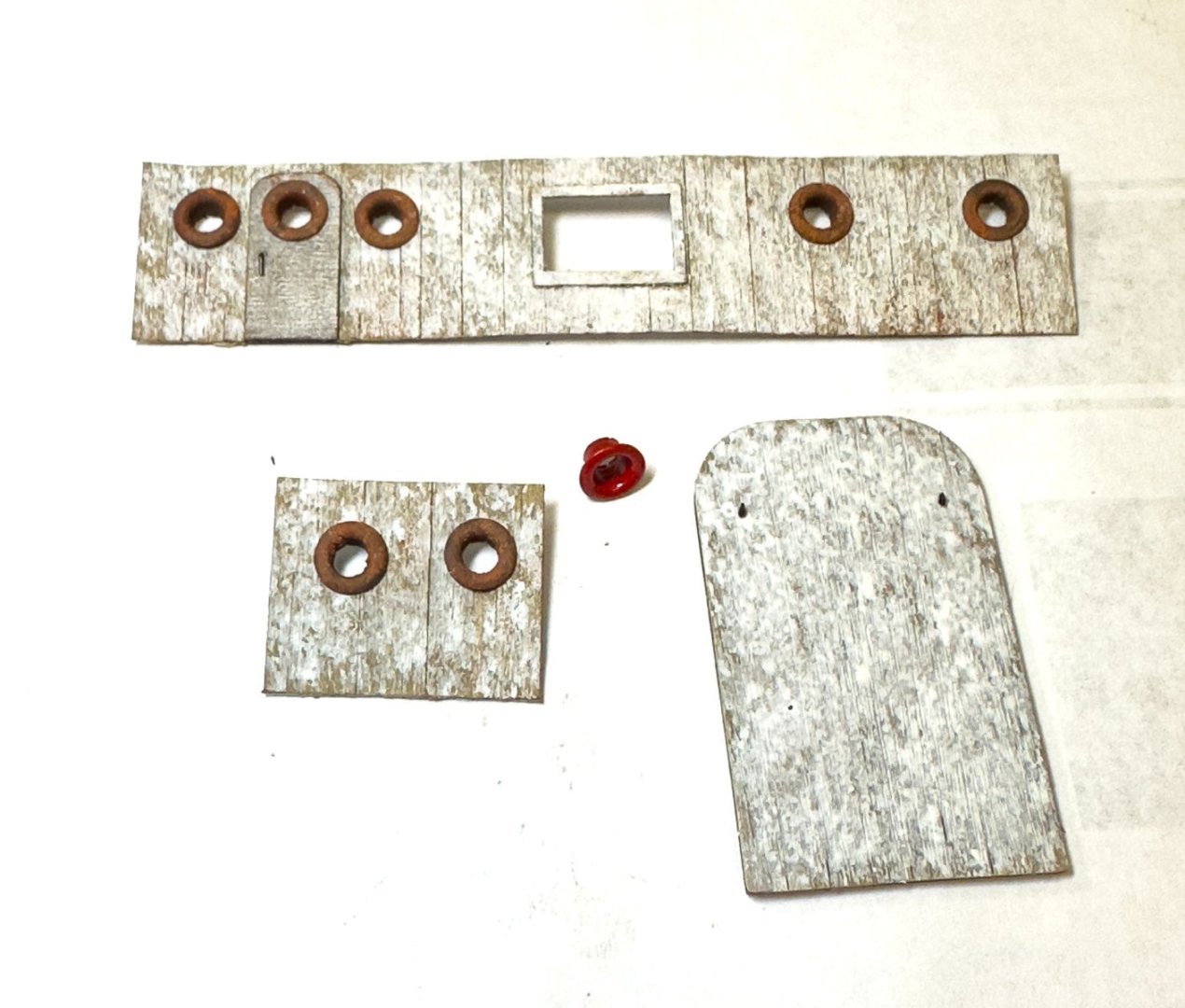
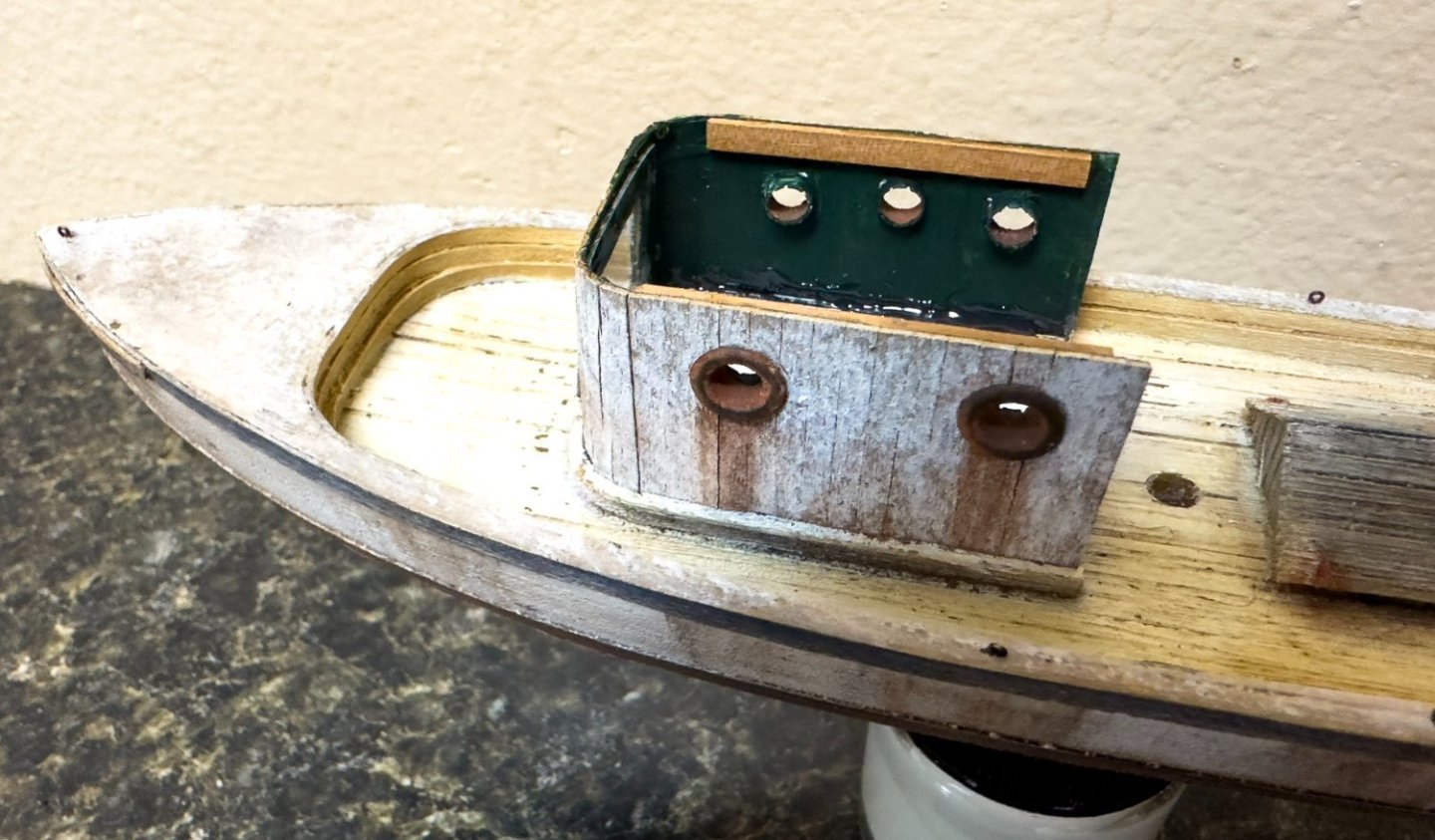
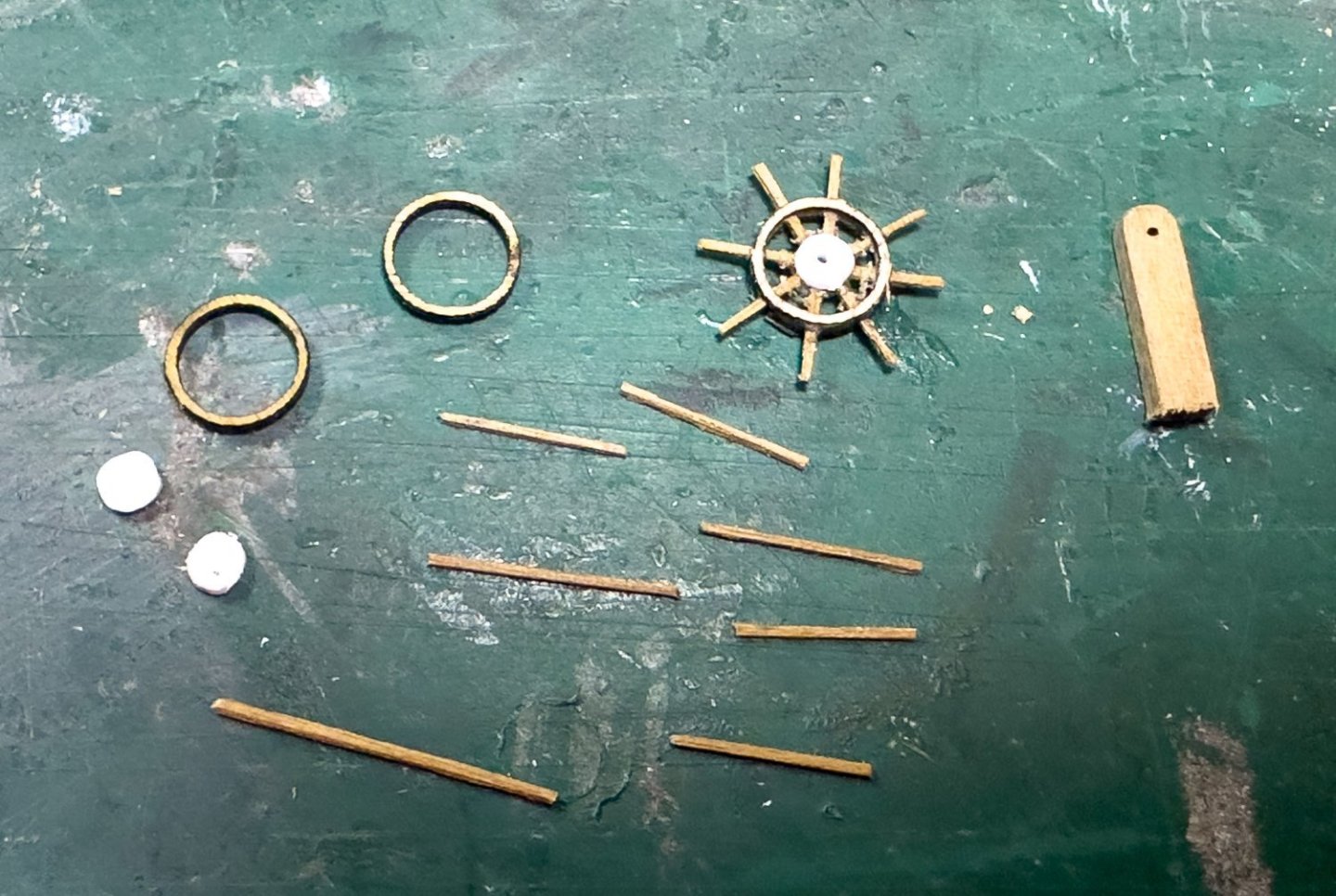
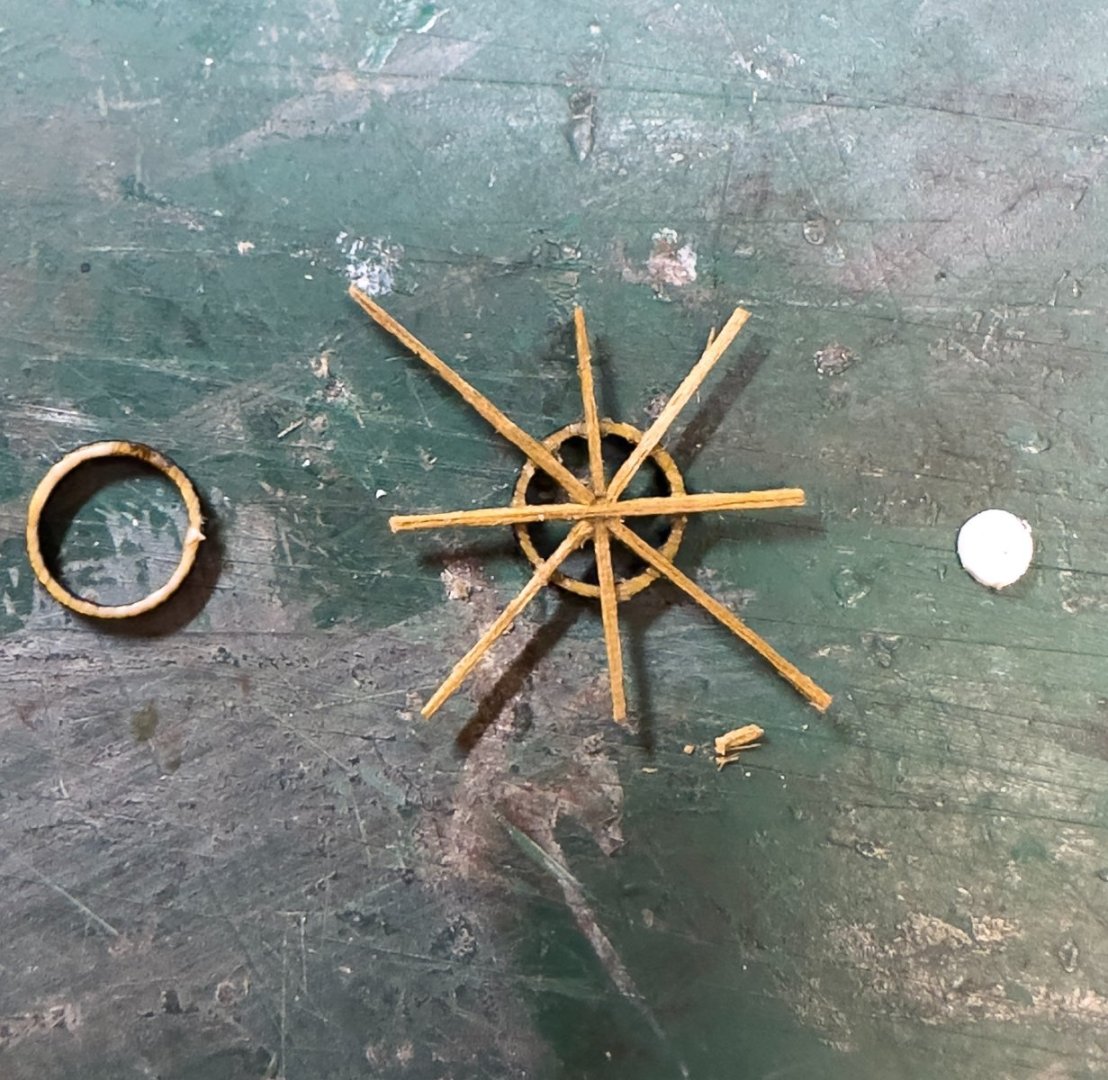
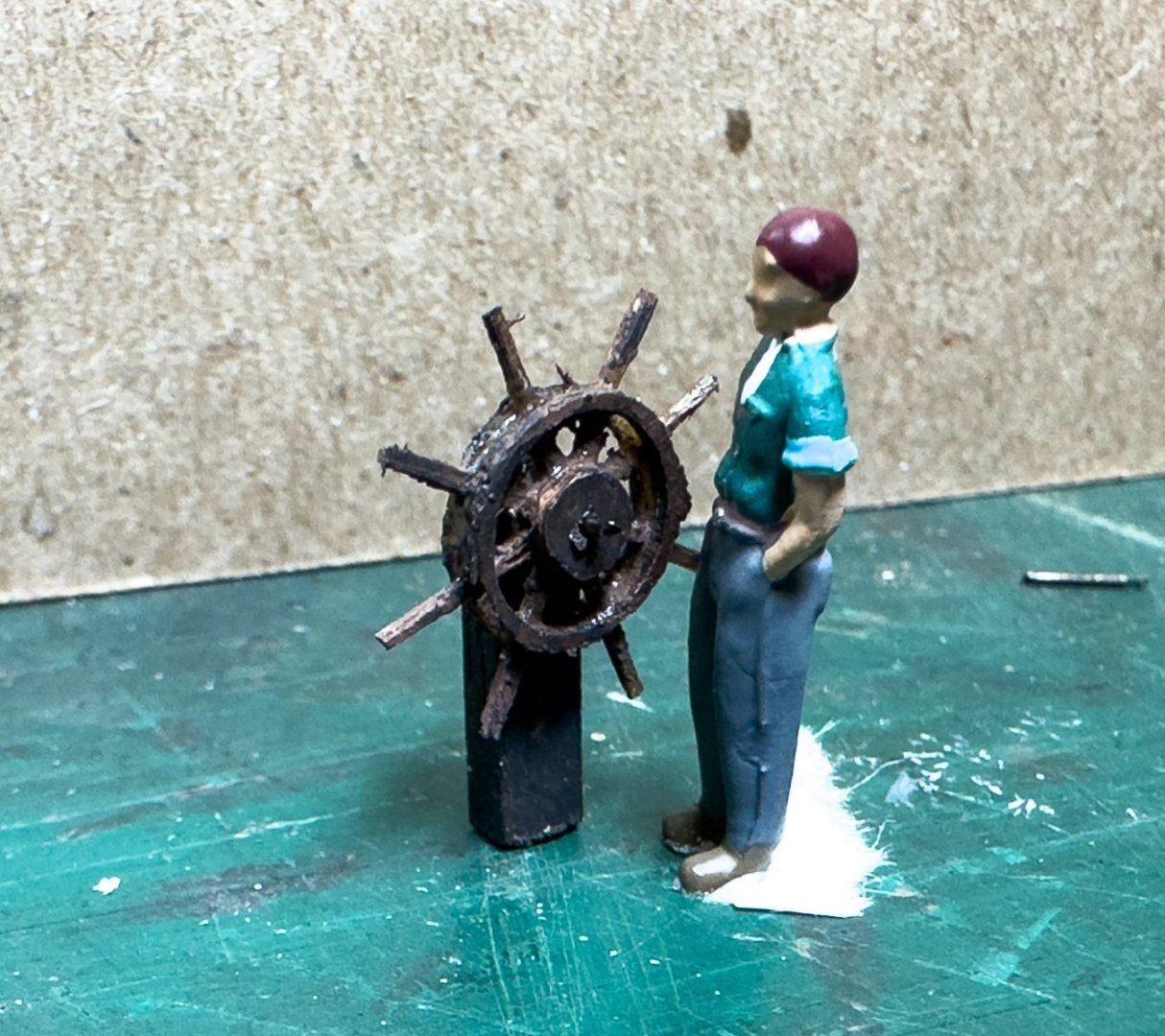
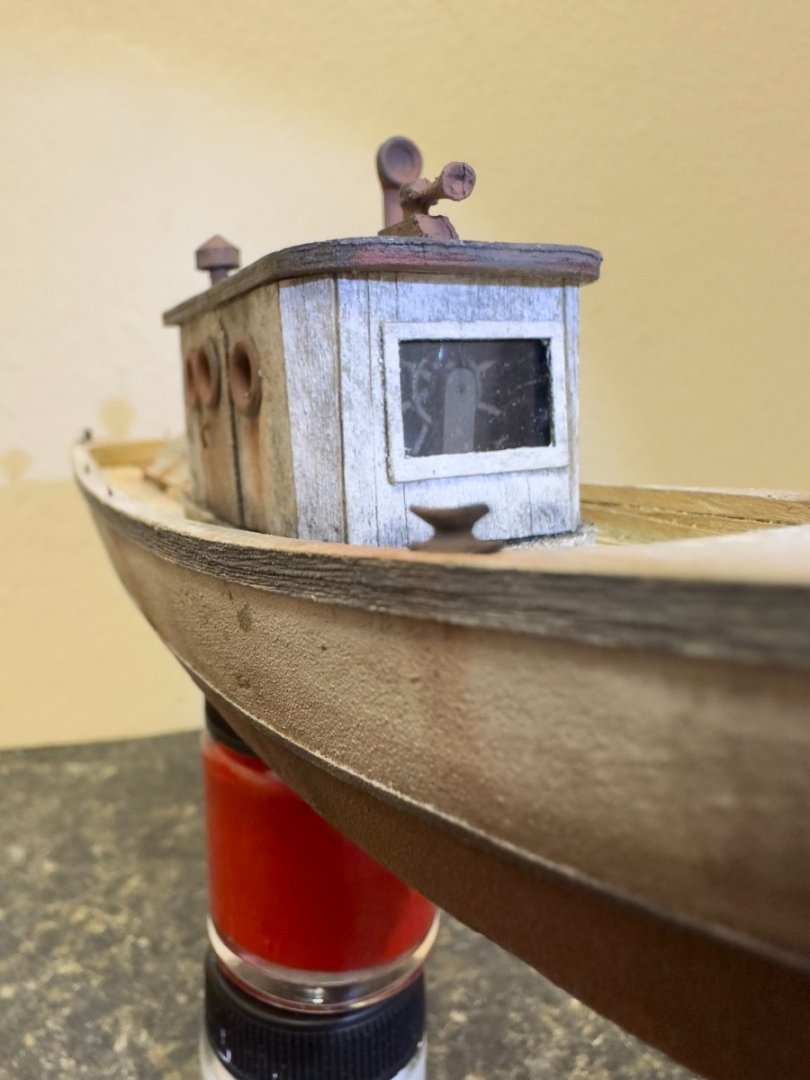
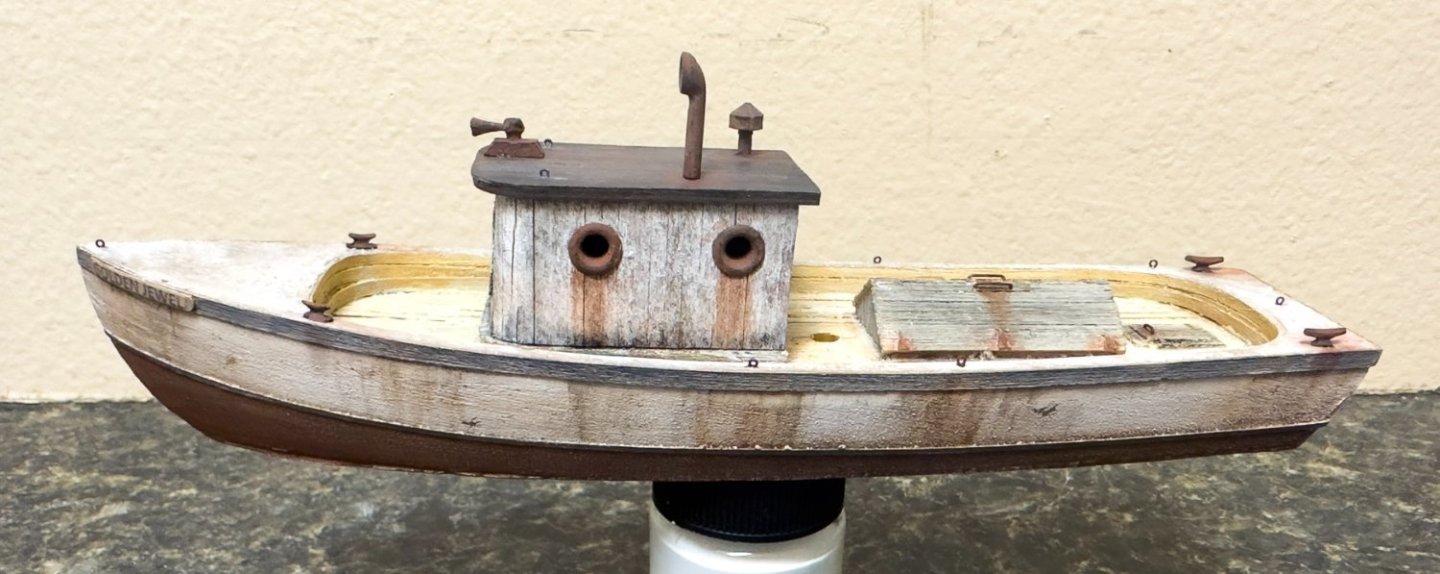
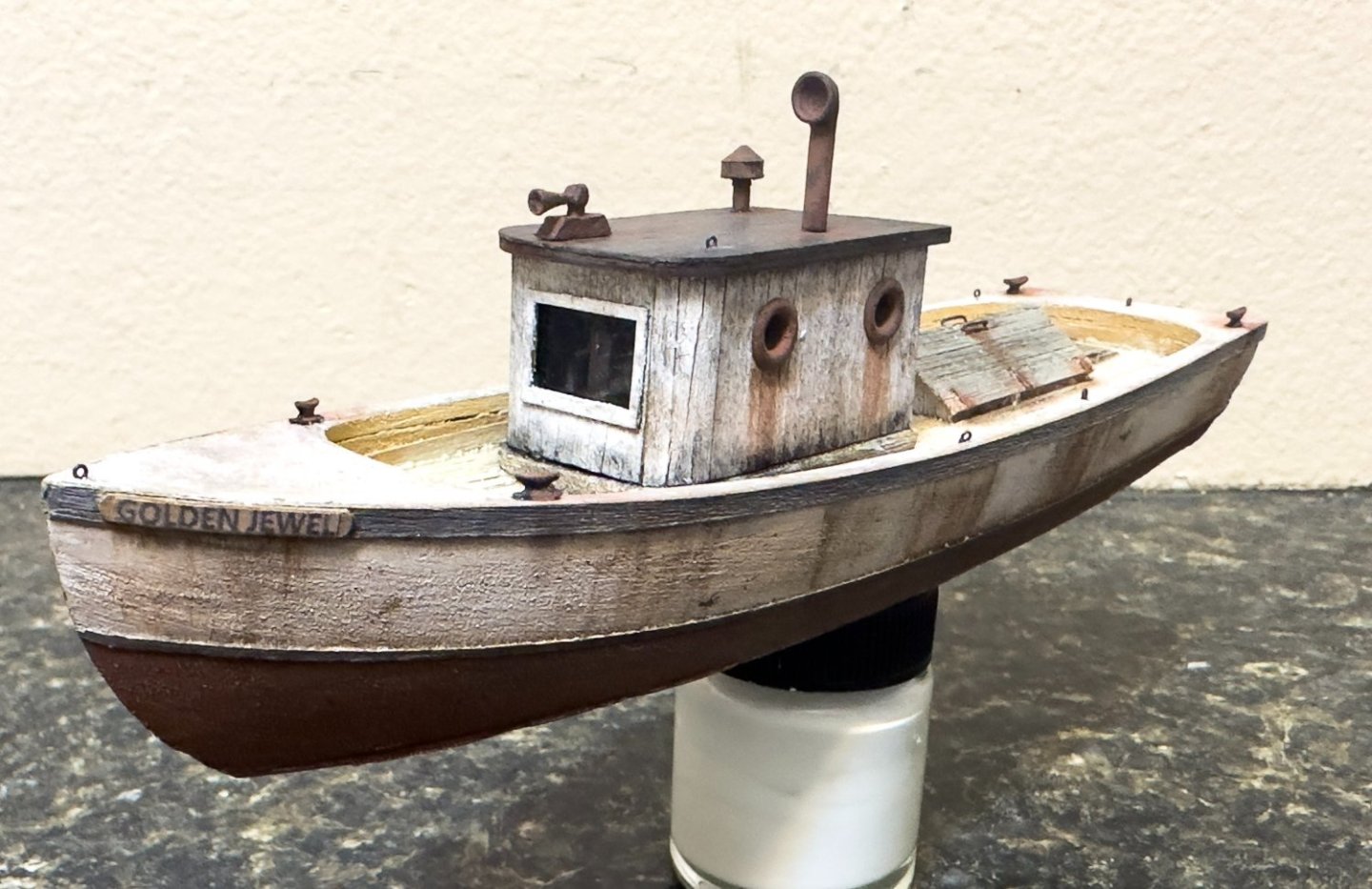

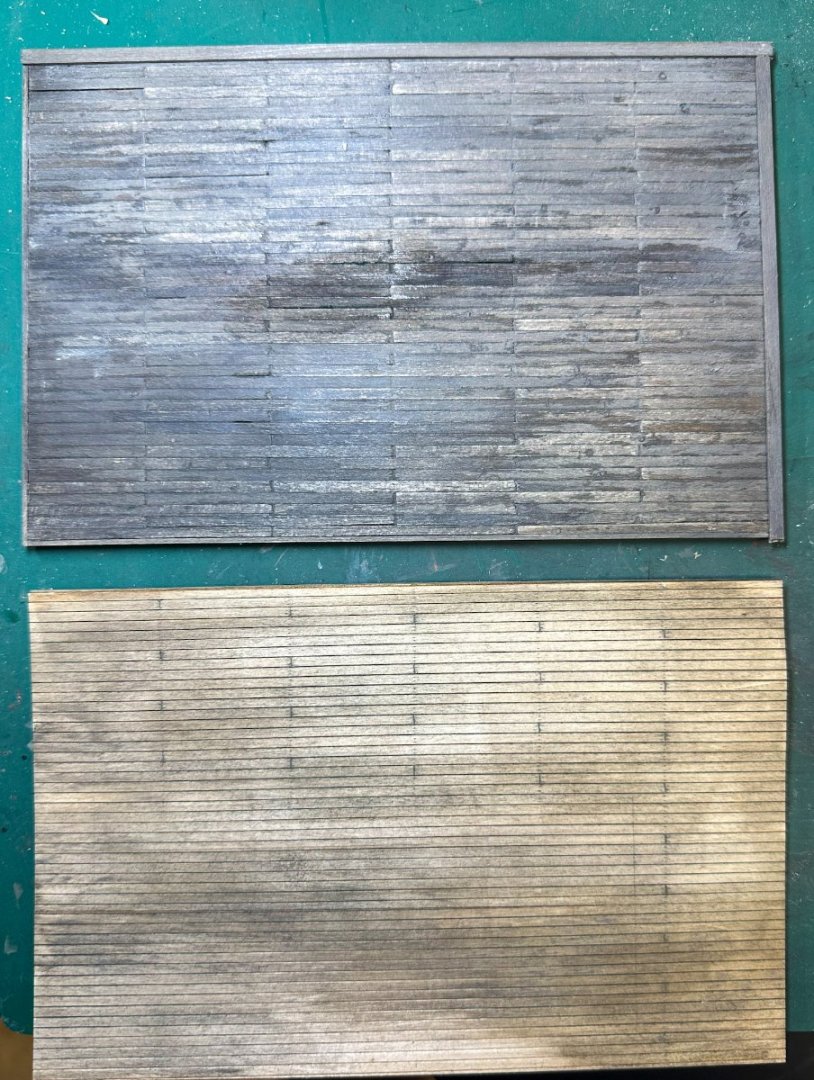
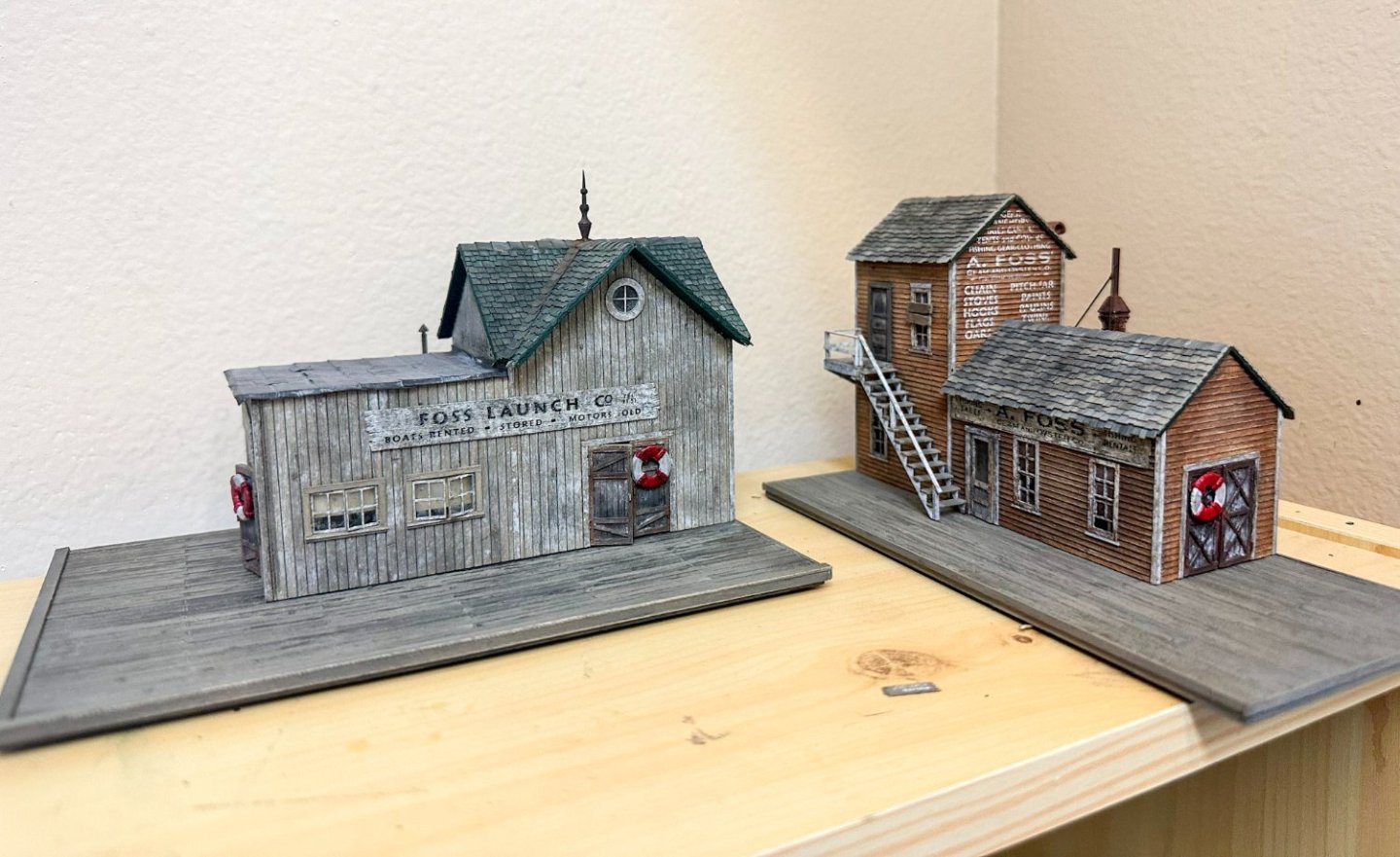
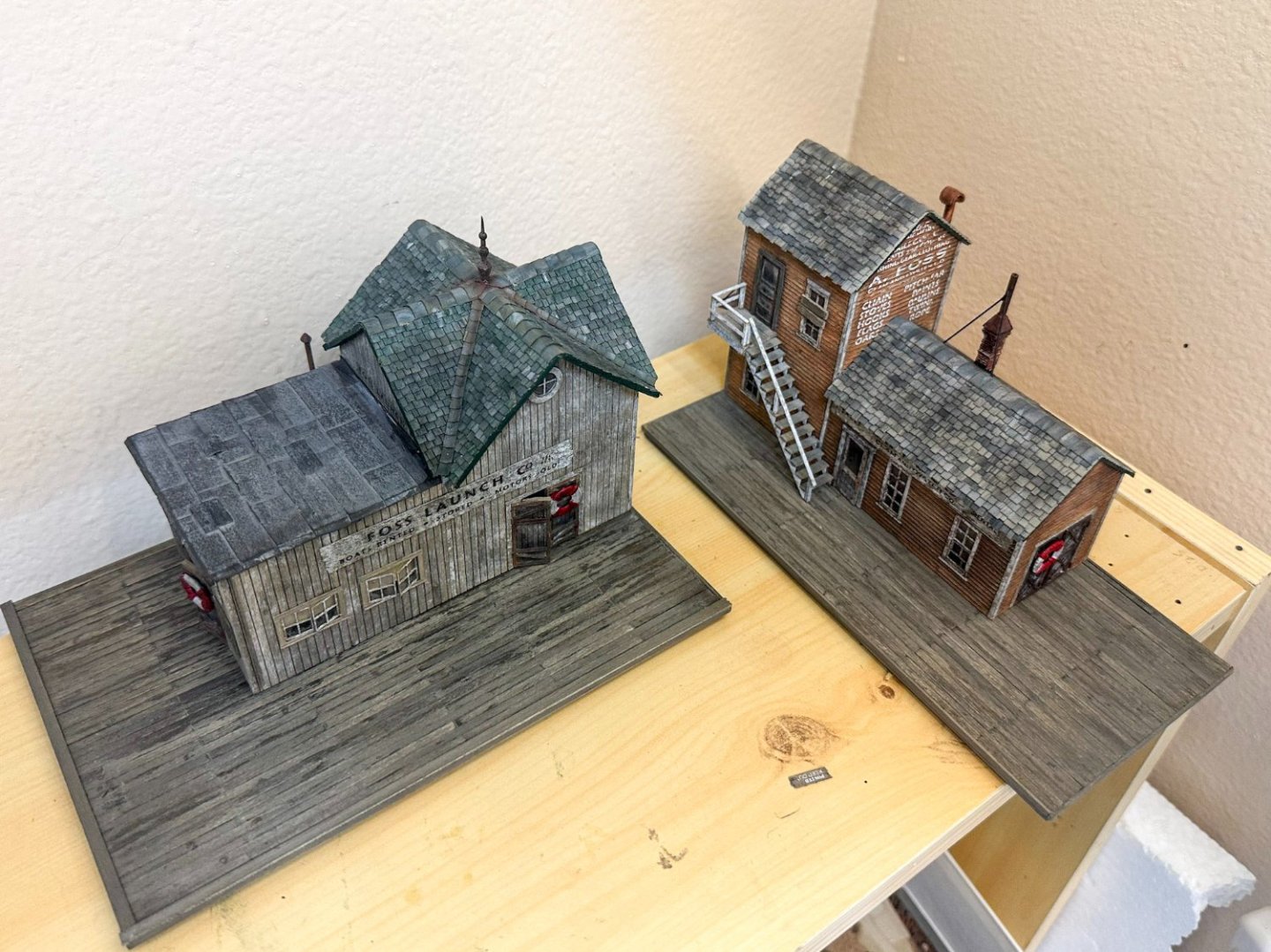
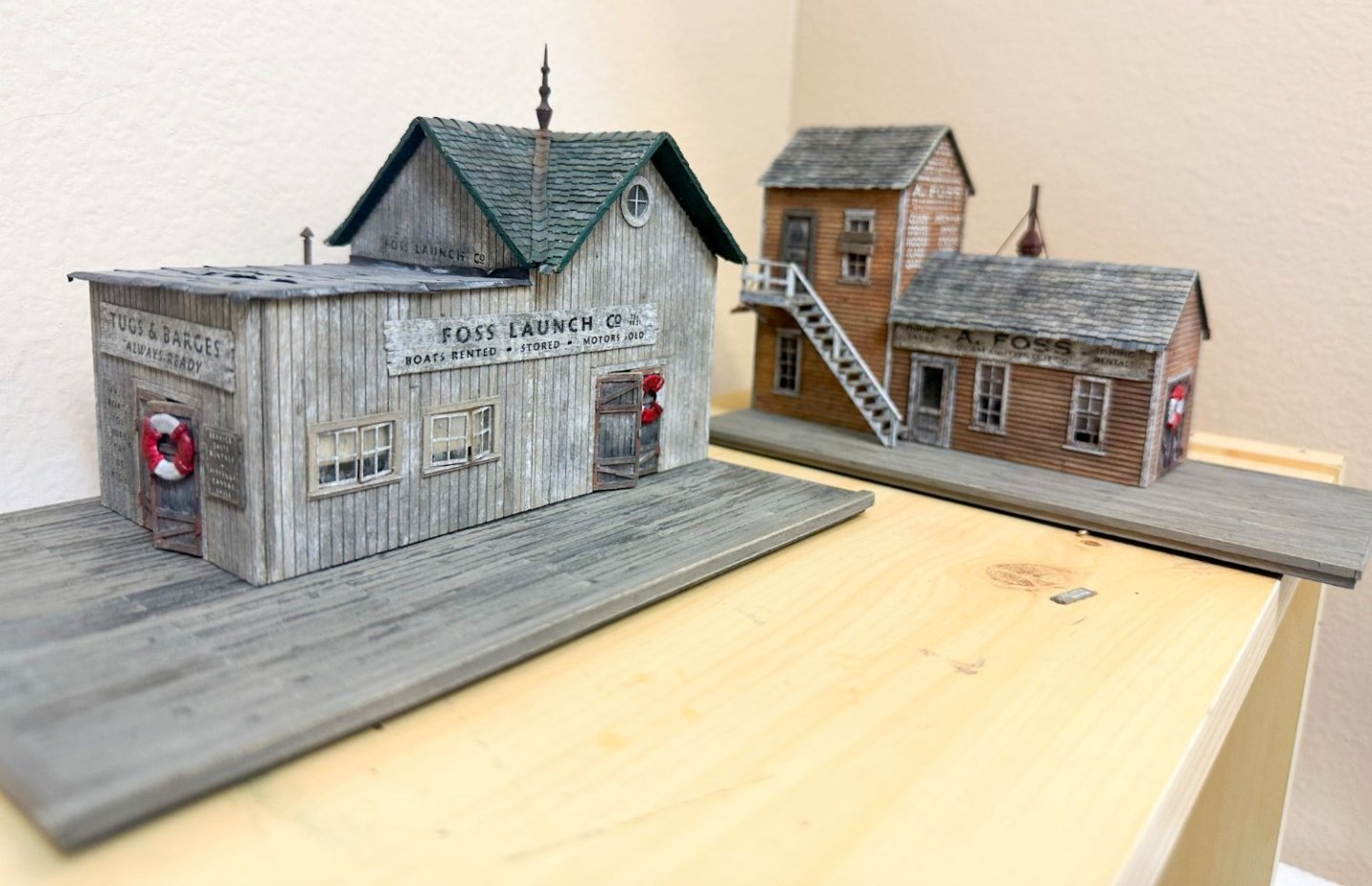
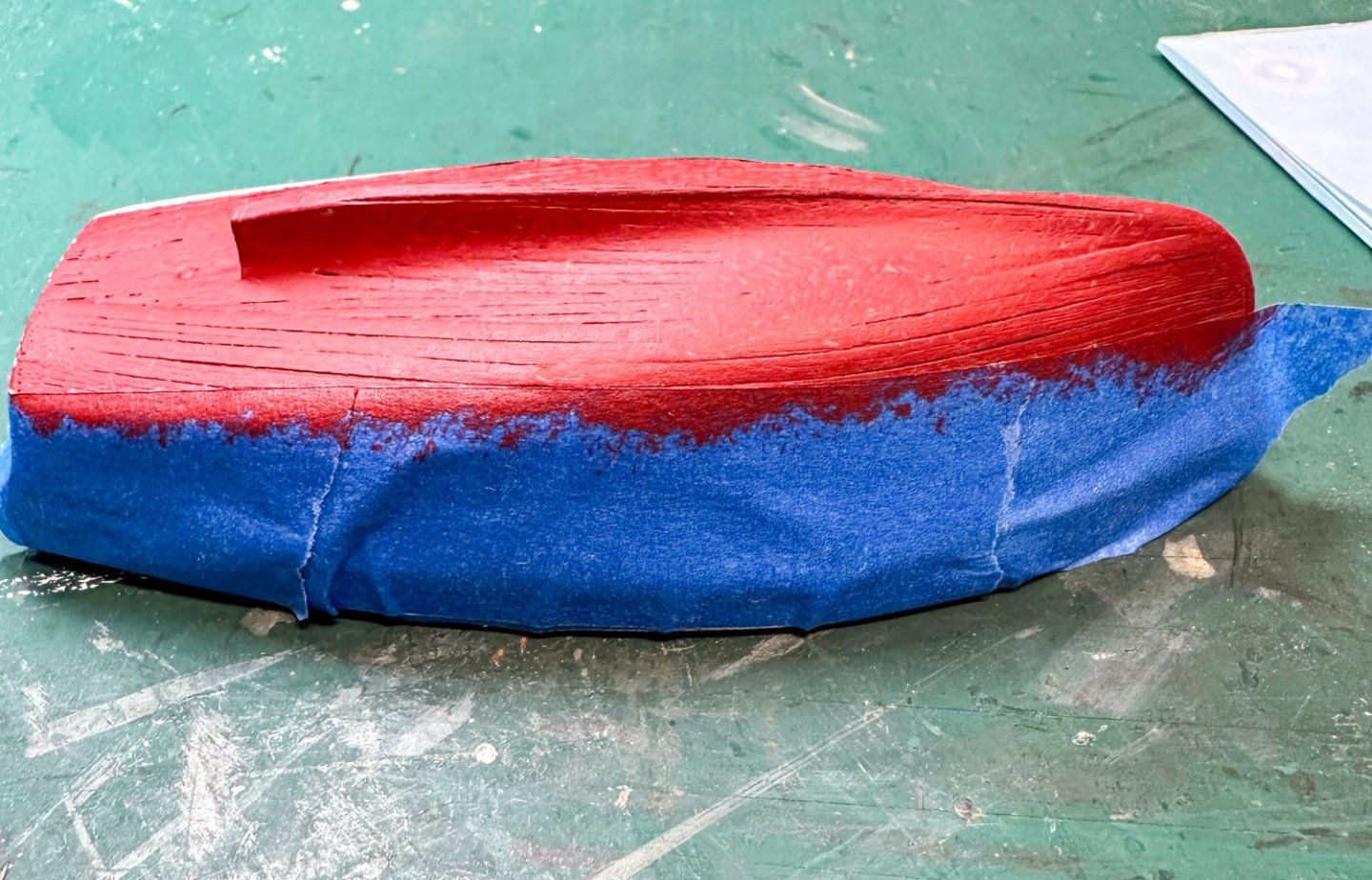
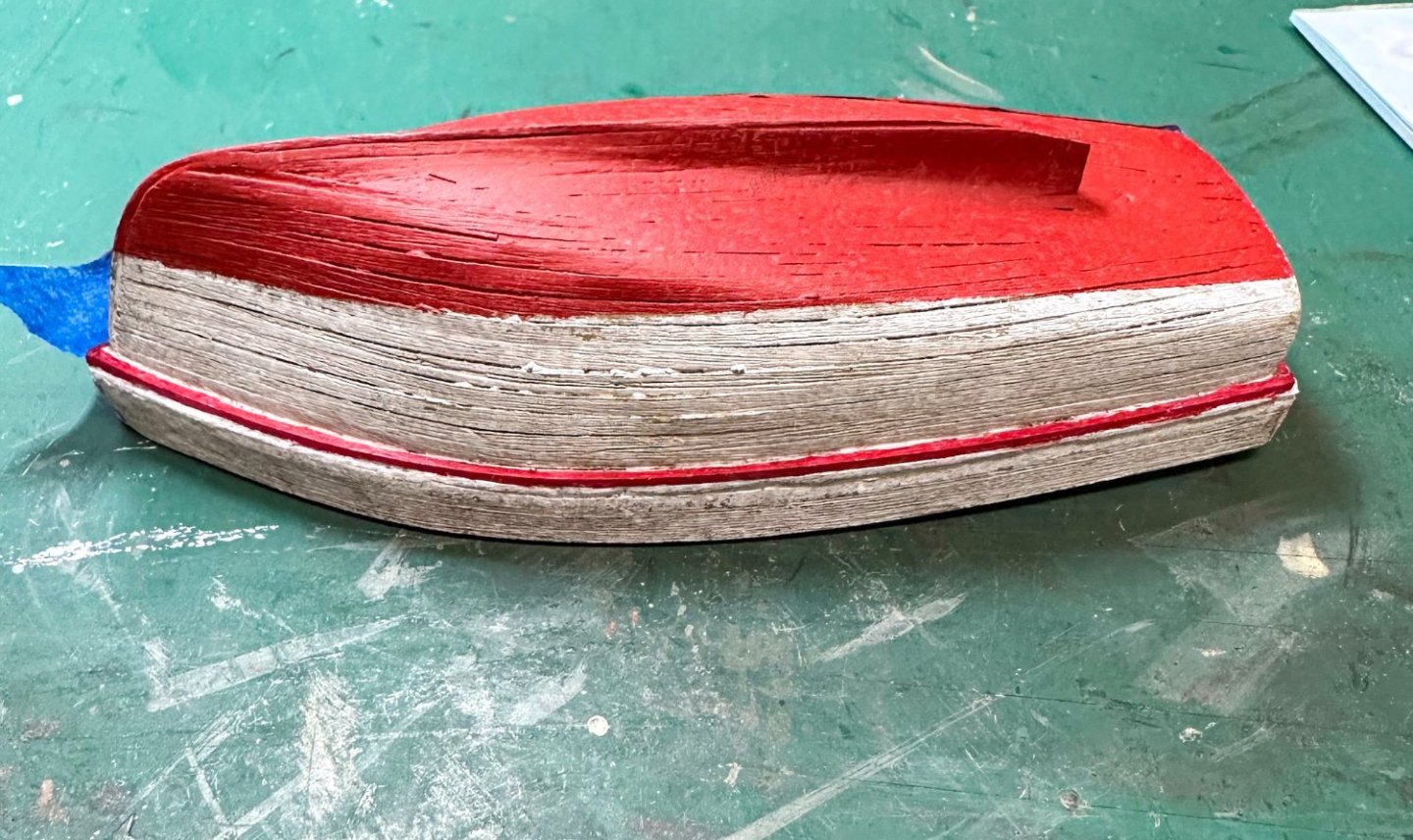
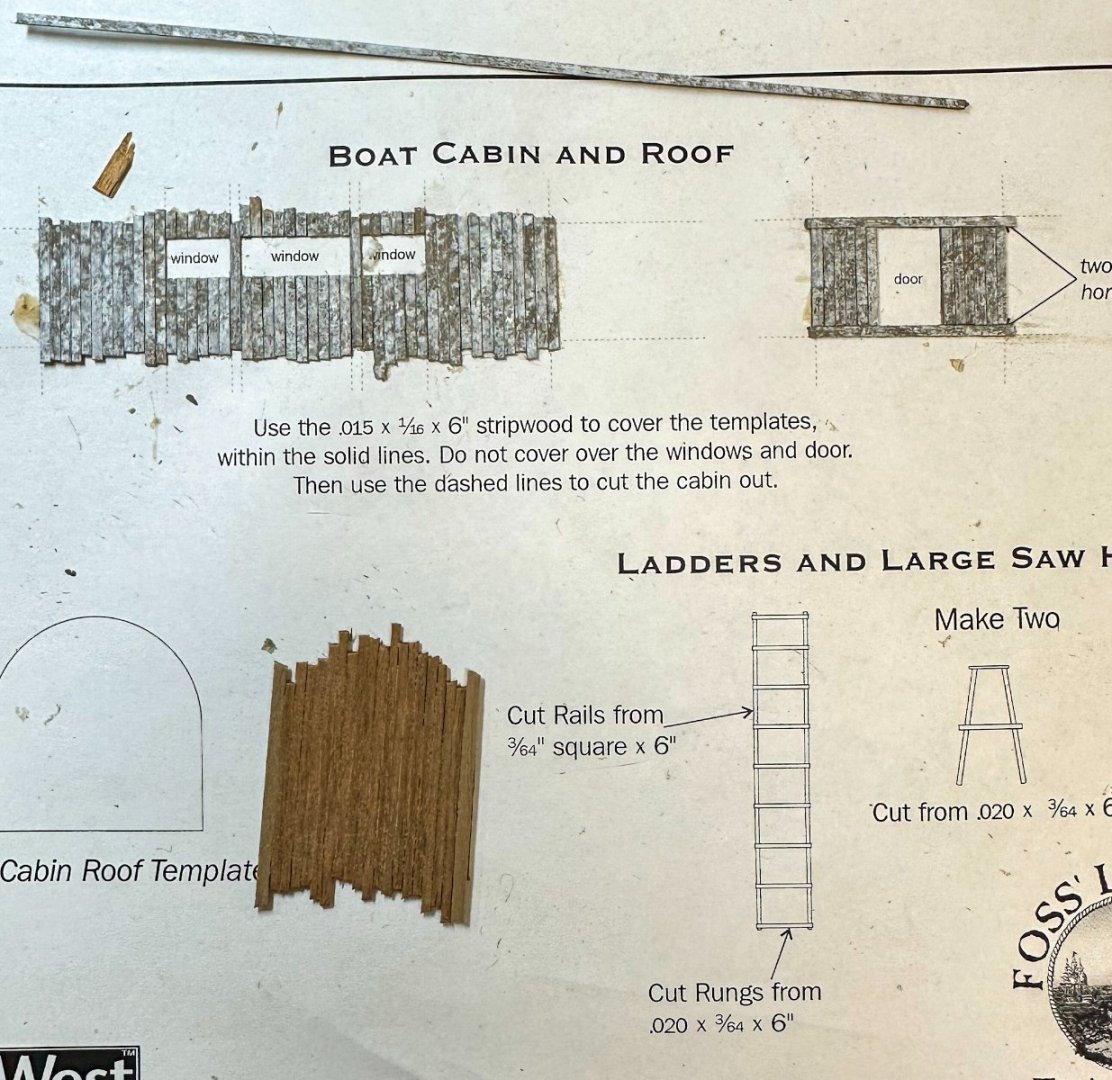
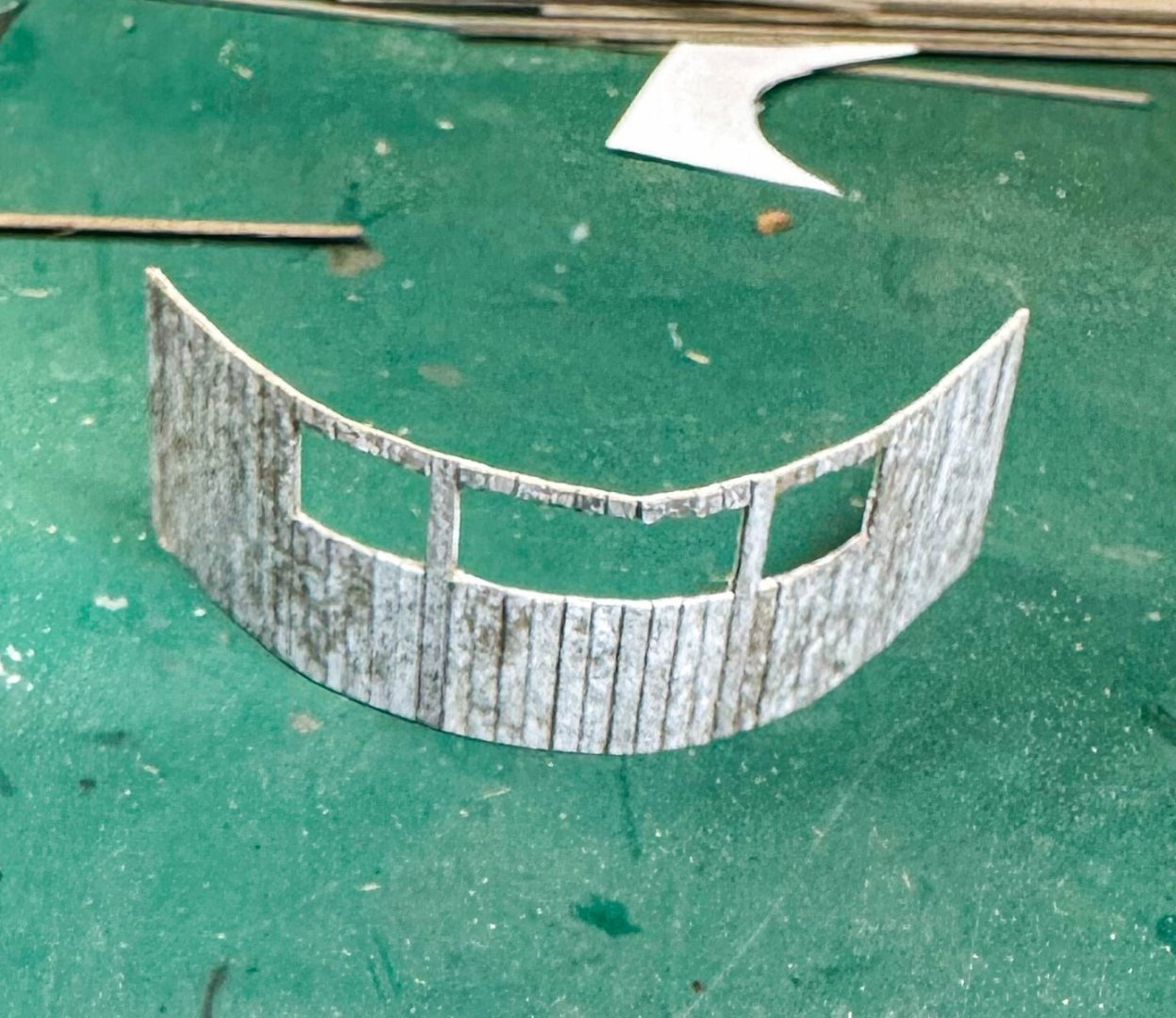
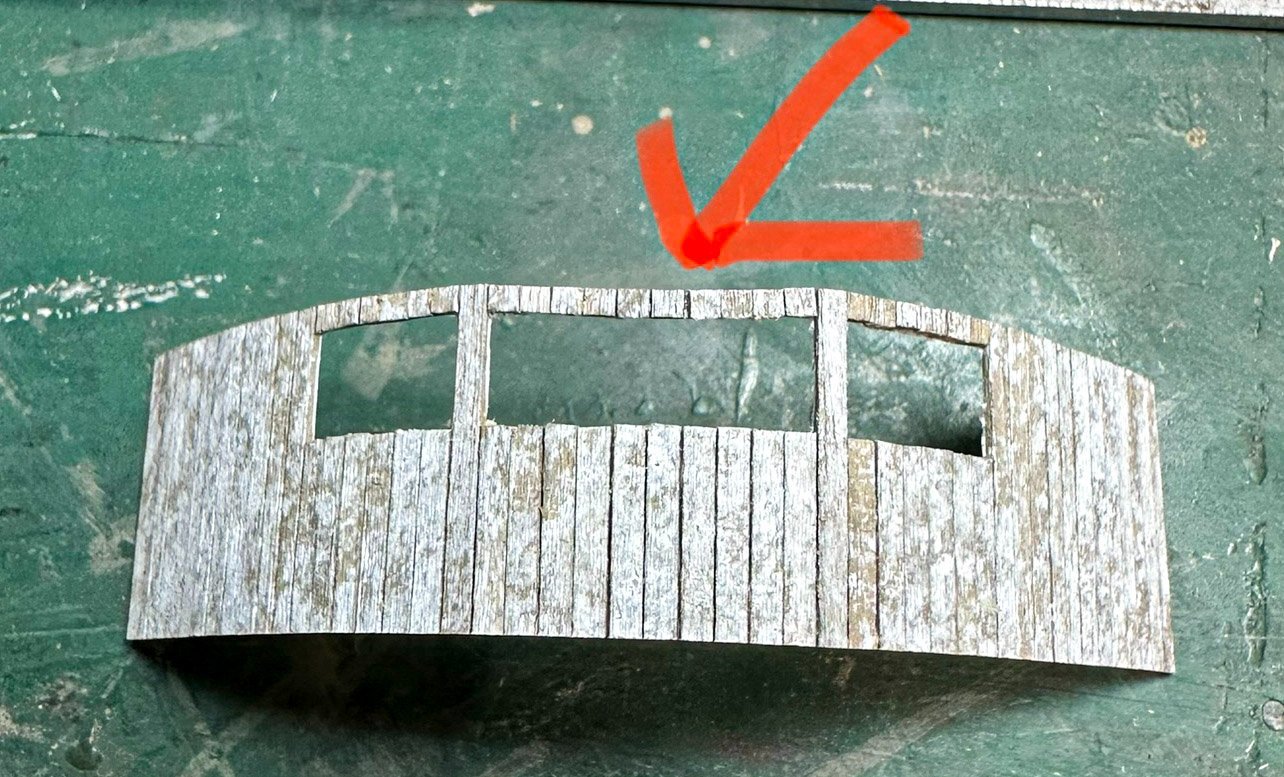
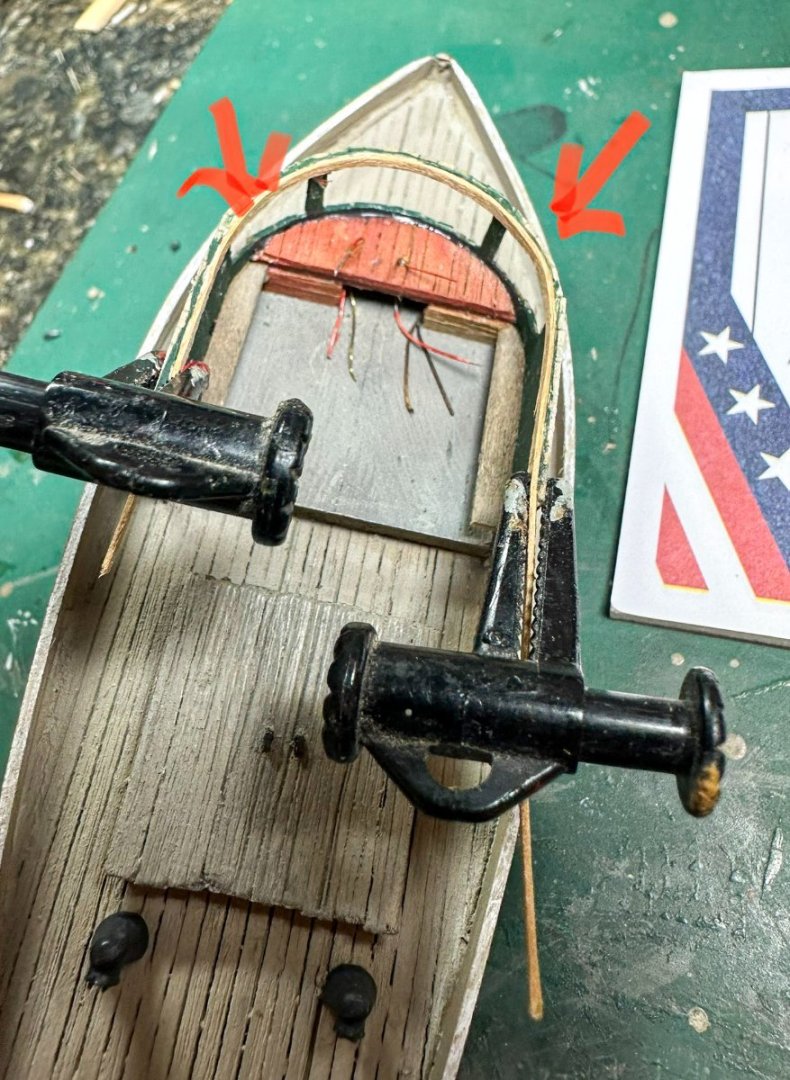
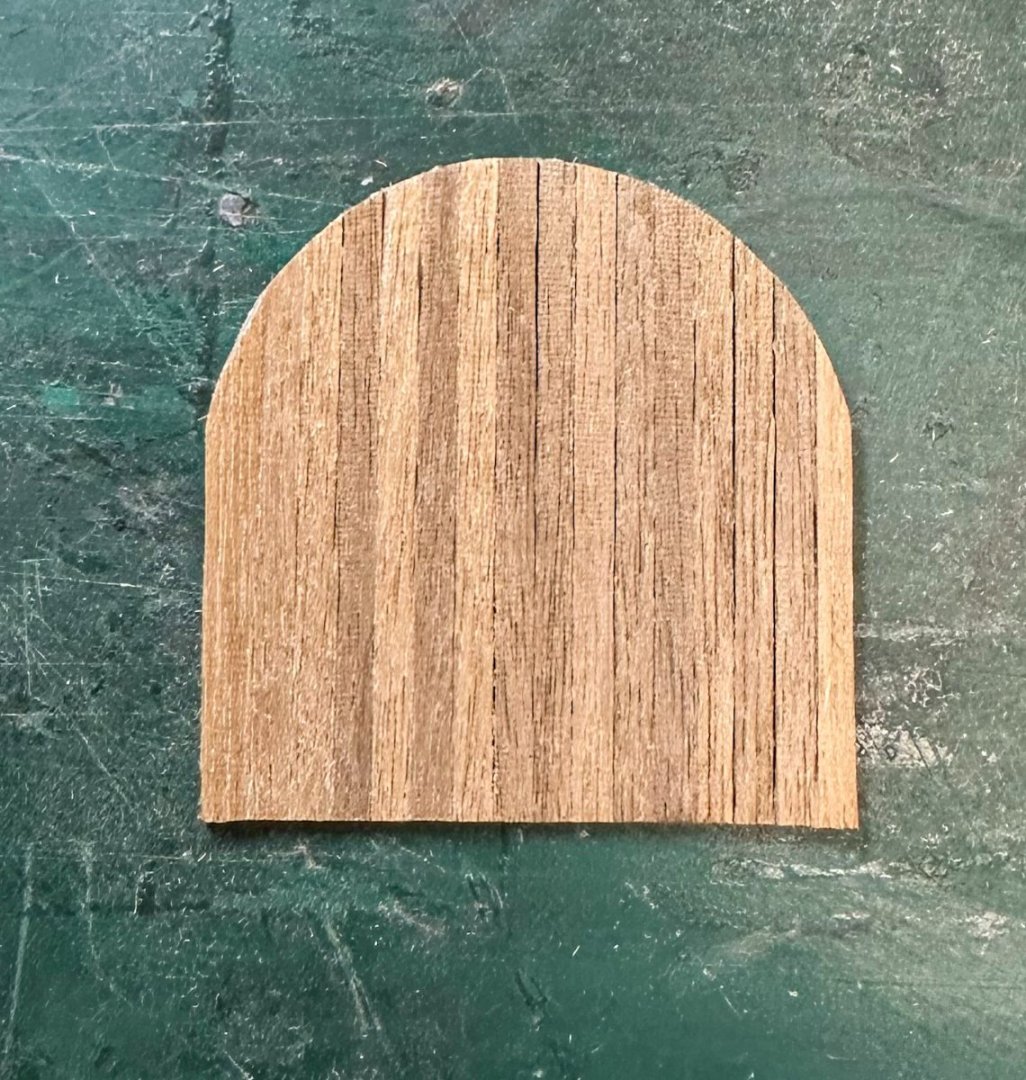
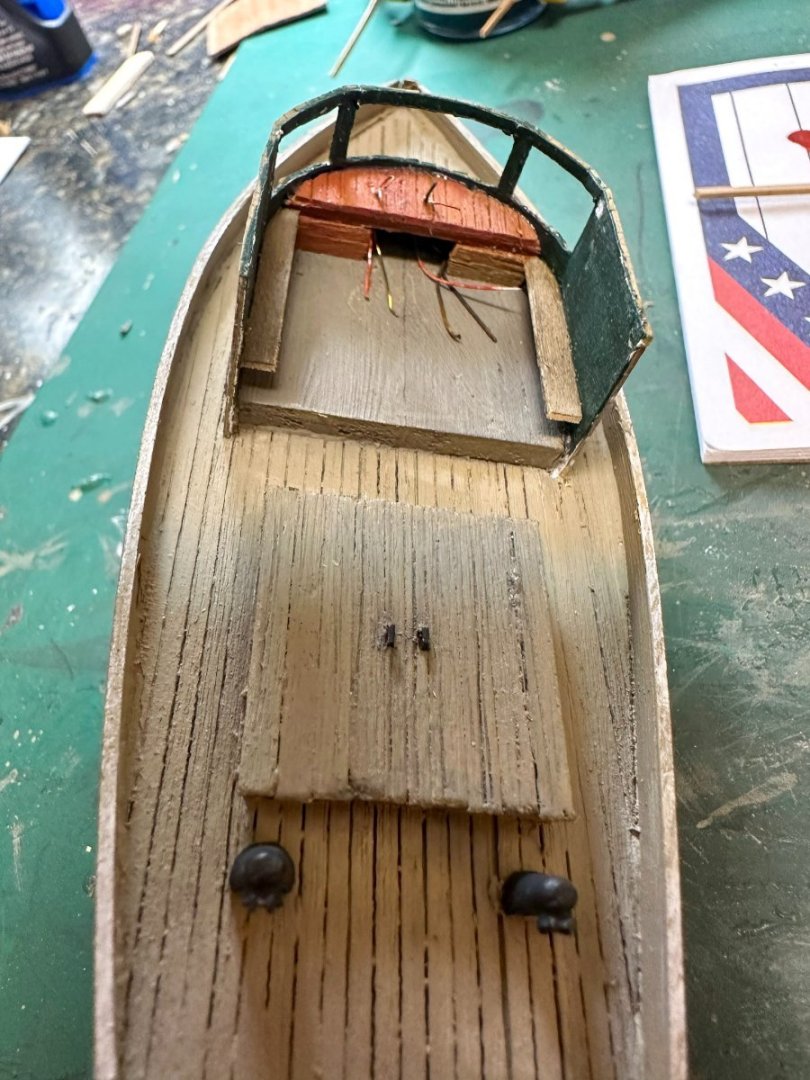
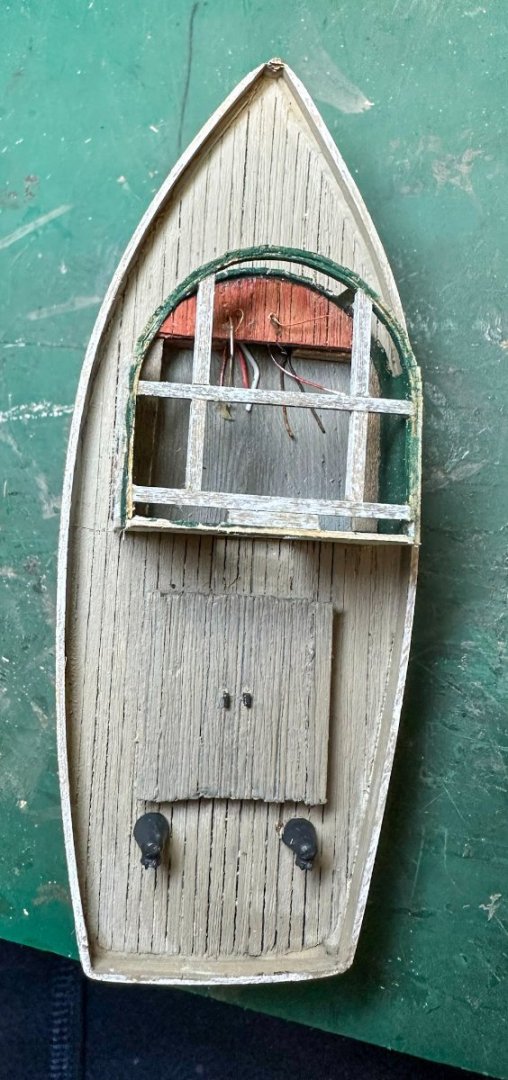
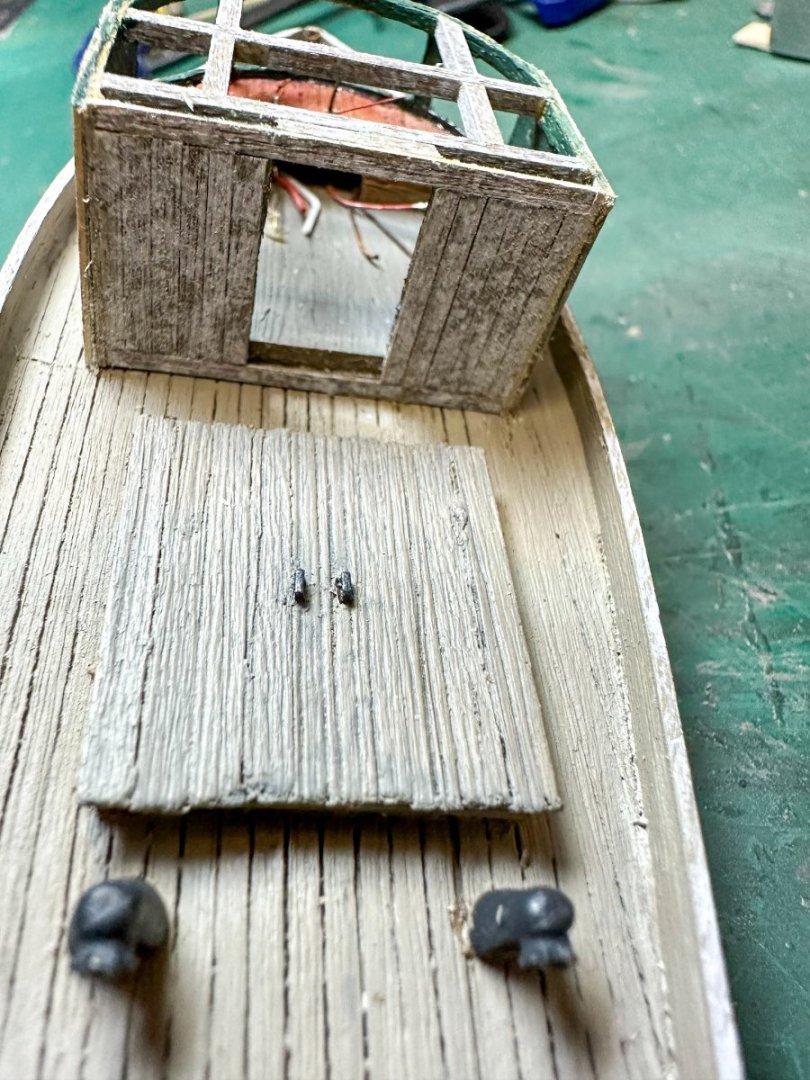
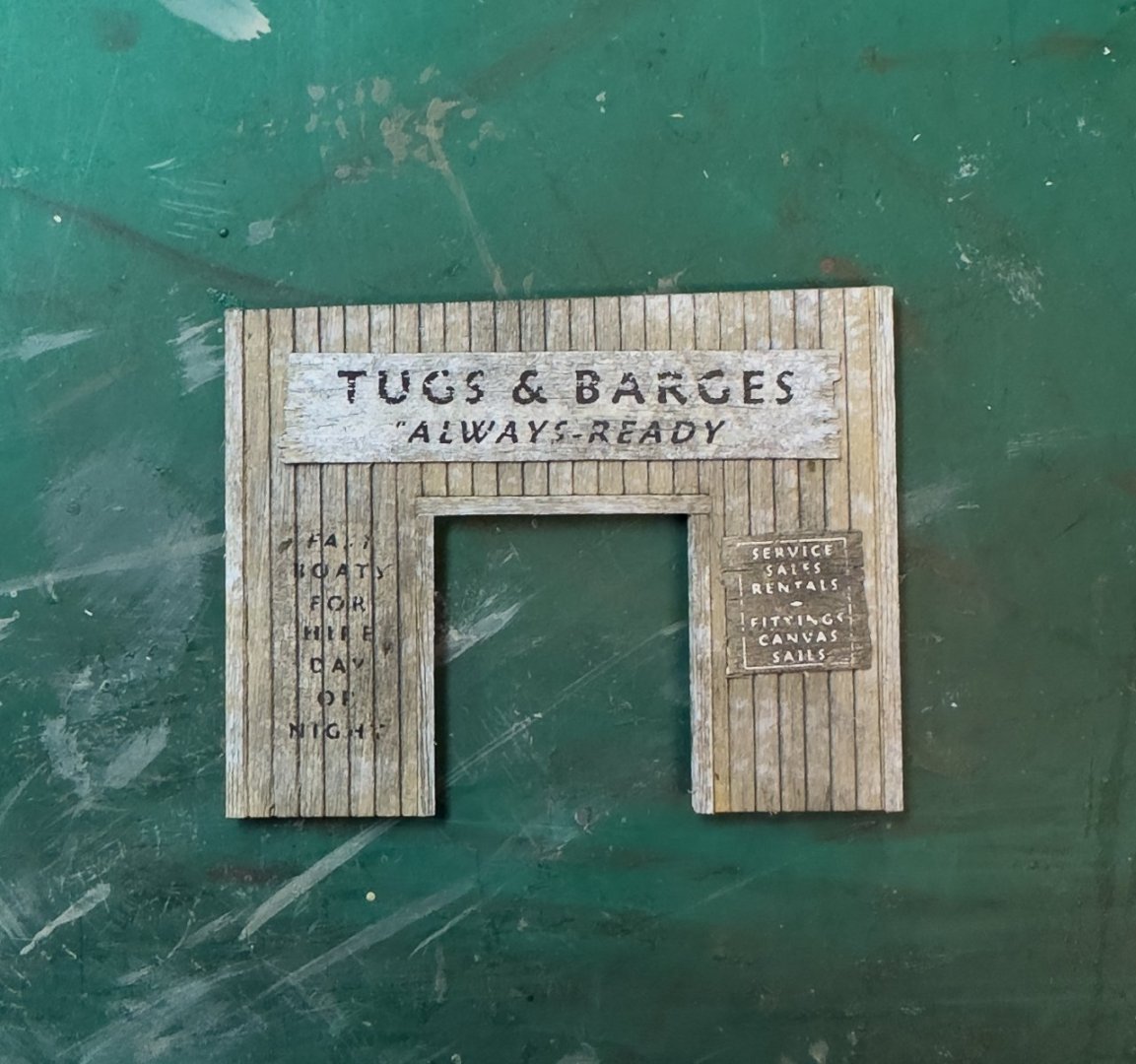
Foss Landing and The shipyard at Foss Landing by xodar461 - Sierra West Scale Models - 1/87
in Non-ship/categorised builds
Posted
Greetings!
Work continues on the main dock.

The knots in the boards were randomly placed after the boards were glued to the beams. When all the boards are down, they will be given a wash with A/E to darken the knots. I decided to lay the planks to the red line (see photo, last post). I put together a scale 40-foot flat car and the trucks run quite smoothly over the tacks with the wood placed so. I also like the look of the track "buried" in the deck. Here are a few photos.
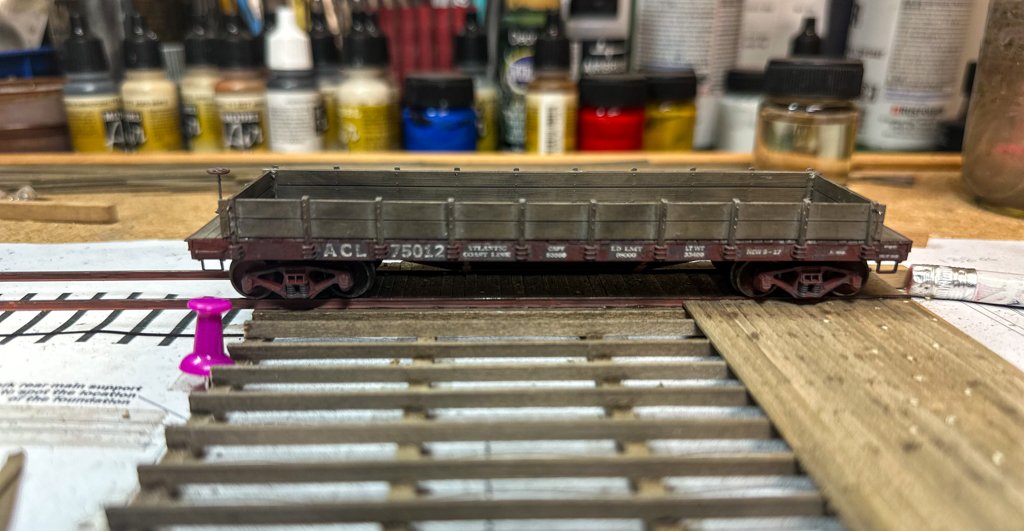
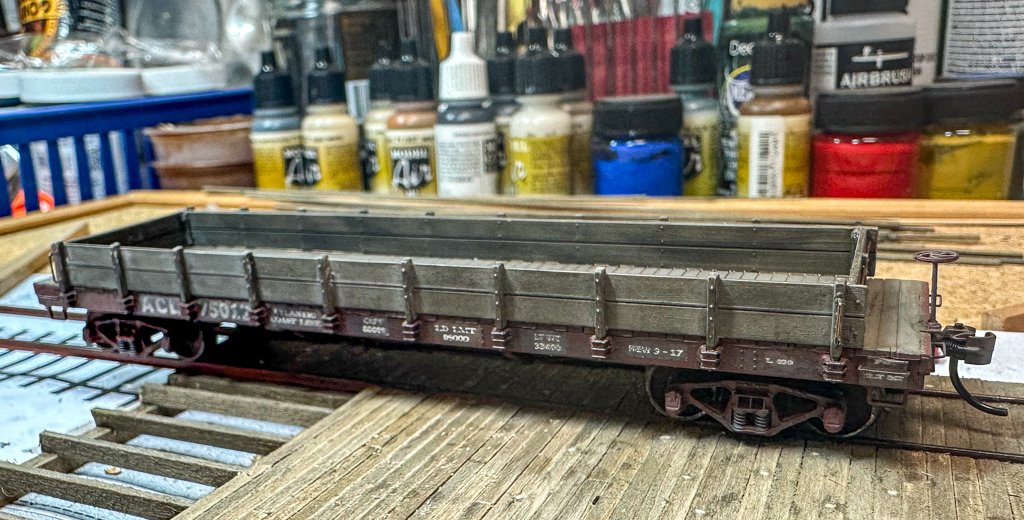
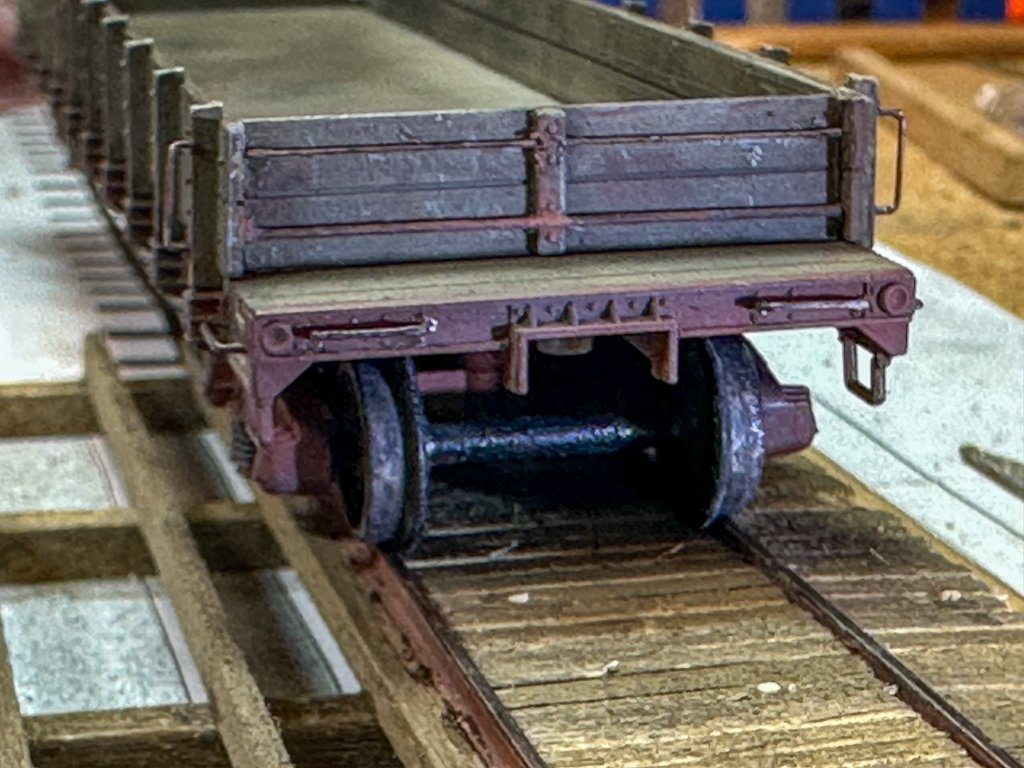
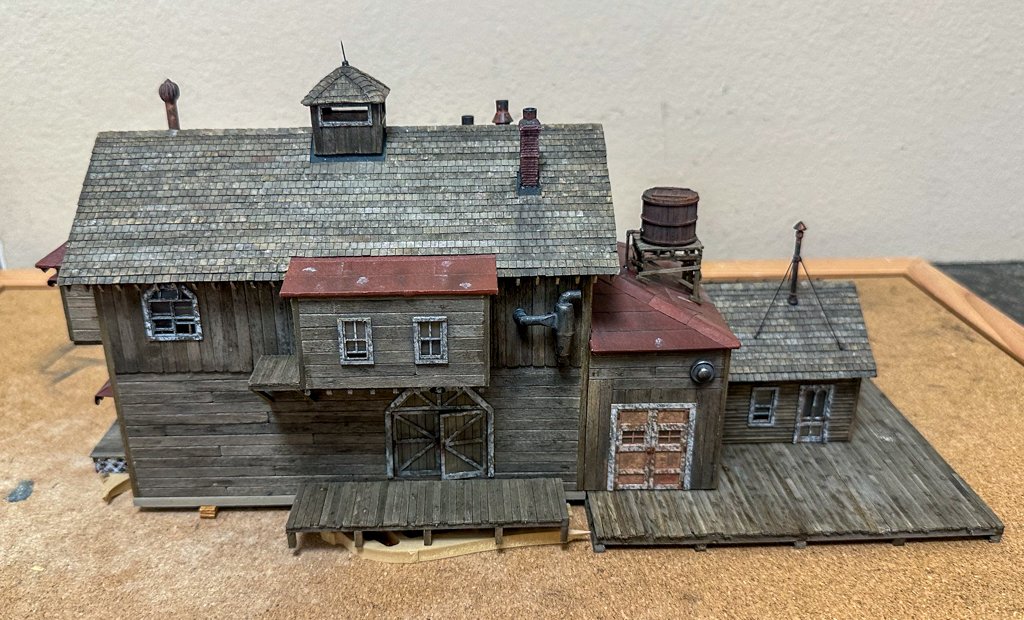


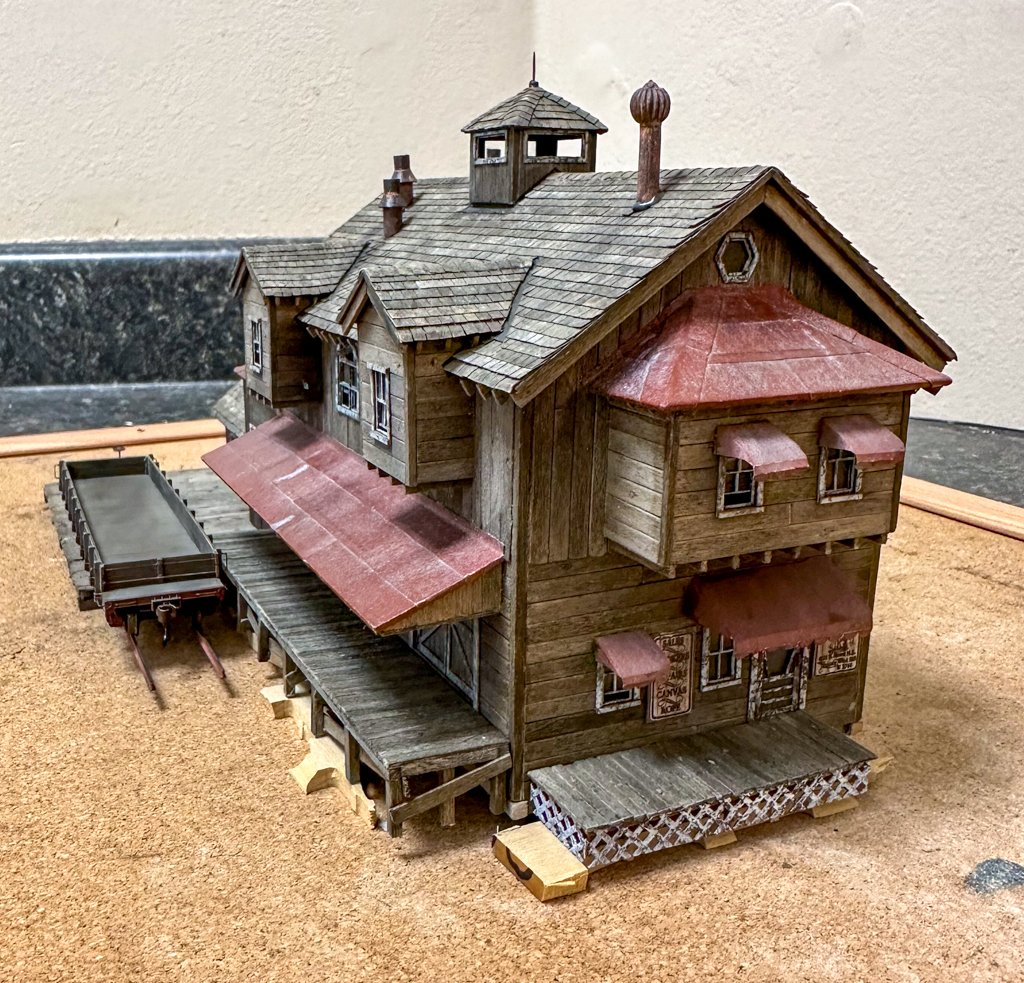
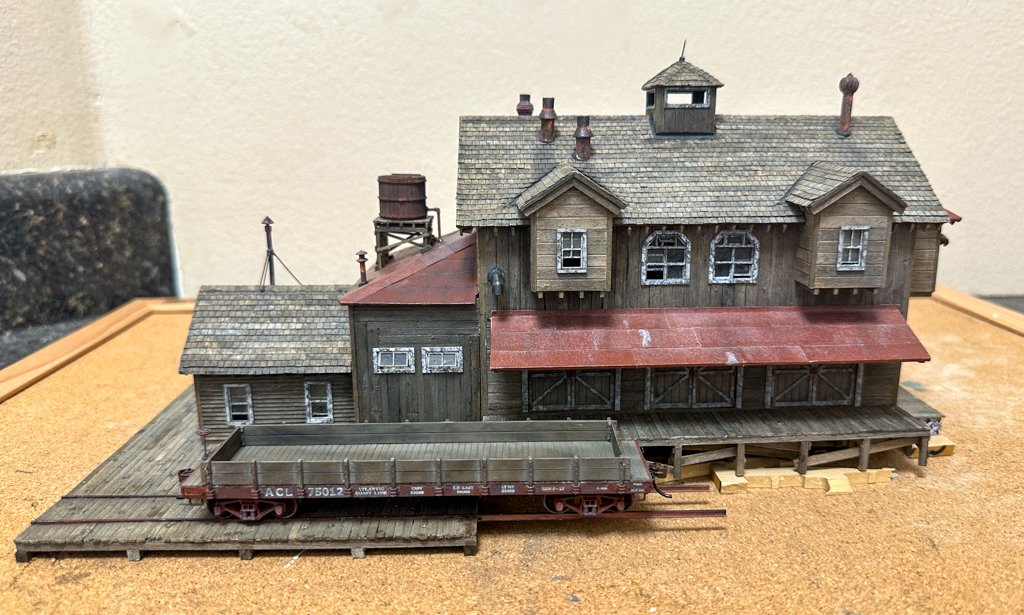
And finally, the main building on the foundation beams and the deck. Some wood scraps were used beneath the foundation and the various platforms to get them all at the correct height.
I need to straighten the rod at the top of the cupola as it seems to be off in one axis.
Next up, 2 small sheds and the saw shed.
jeff